
Savvy Travel Advice

Nairobi Travel Guide: 24 Top Things to do in Nairobi Kenya
Last updated: August 30, 2023 - Written by Jessica Norah 34 Comments
We want to share a guide to the top things to do in Nairobi, Kenya. Nairobi is the capital and largest city in Kenya. The city has grown from a rail depot in 1899 to a city of millions. It is the business, finance, and cultural hub of Kenya.
Most safari-bound visitors in Kenya spend at least one night in Nairobi, which is known as the “Safari Capital of the World”. However, many travelers spend little if any time actually exploring the city itself. The city is often used just as a place to stay before or after a flight rather than as a destination to explore.
We think there are two main reasons that people don’t explore Nairobi. One is lack of time. Many plan a packed safari schedule focused on wildlife viewing with no time set aside to explore Nairobi. The second is fears related to safety and crime. Nairobi isn’t the safest city in the world, but you can safely explore the city if you take precautions.
Nairobi has a lot of visitor attractions, including museums, wildlife attractions, markets, cultural performances, parks, hiking trails, and great dining options. If you are interested in history, African art, wildlife, music, hiking, food, crafts, trains, gardens, or shopping, you are sure to find something of interest to do and see in the city.
It is also a city where you can really learn about Kenya, whether you are interested in colonial history, Kenyan independence, or modern life in Kenya’s capital city. From the ritzy suburbs to the busy Central Business District to Africa’s largest slum area, Nairobi is a multi-faceted city worth exploring.
We’ve been lucky to have visited the city a few times now and have had the chance to visit a lot of the attractions in Nairobi. We have really enjoyed exploring the city and find it provides a nice change from spending time on safari. So we are excited to share our experiences and tips with you to help you plan your own visit to Nairobi.
In this post, we’ll cover the top things to do in Nairobi and tips for visiting each. We’ll include the most popular tourist spots as well as some lesser known places. We’ll also give you information and tips on getting to Nairobi, how to get around the city, where to stay in Nairobi, where to eat in Nairobi, how to book tours, and how to stay safe in Nairobi.
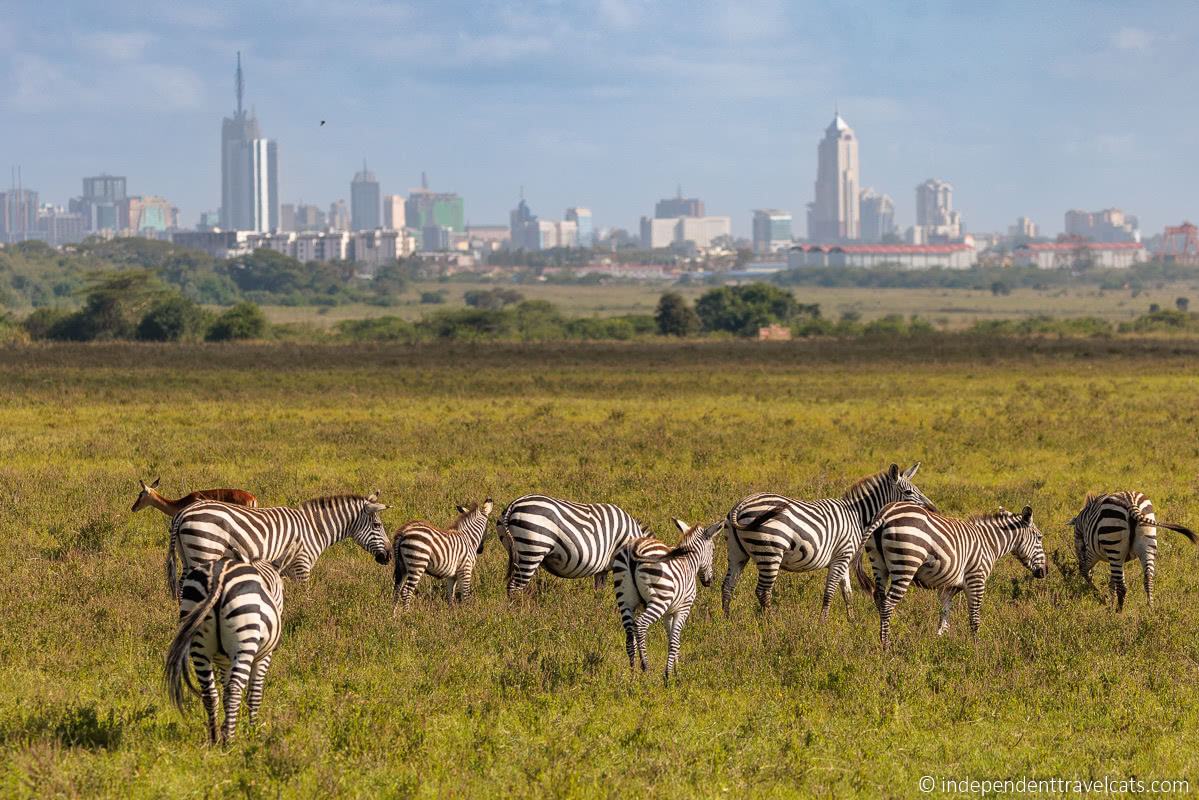
Table of Contents:
Getting to Nairobi
The main way that most international visitors get to Nairobi is by flying into the Jomo Kenyatta International Airport (NBO), Kenya’s main international airport. But you can also reach Nairobi by train, car, or bus.
The main airport in Nairobi is Jomo Kenyatta International Airport (NBO). It is likely that this is where you’ll be arriving into Kenya.
But if you are arriving from elsewhere in Kenya or East Africa, your flight may arrive at the smaller Wilson Airport in Nairobi.
To get from the airport to your hotel or downtown, you can take a taxi, a shared shuttle bus, an Uber, or book a private transfer. Your hotel may offer a free or paid airport shuttle, or you may already have a driver arranged with your safari company. If not, we recommend booking your airport transfer in advance as it tends to be the most hassle-free way.
If you decide to take a taxi, be sure to set a clear price with the driver before agreeing to the trip. Or consider booking an Uber in advance.
Currently, the railway system in Kenya only connects a small area of Kenya, mainly the cities of Nairobi and Mombasa. So the main travelers arriving by train into Nairobi are those who are arriving into Mombasa by plane or ship.
Historically, Uganda, Tanzania, and Kenya were connected by train but the rail connections have been closed for many years.
You can find out information about routes and stations and book train tickets on the Kenya Railways website .
Buses are by far the cheapest way to travel around East Africa. There are long-distance buses that arrive into Nairobi from throughout Kenya as well as from Tanzania, Uganda, and Rwanda. So I’d check online for options depending on where you are wanting to travel from or two.
For example, MASH bus , Modern , and Tahmeed Express are a few of the main bus companies that operate international routes around East Africa.
The Port of Mombasa is the main international seaport in Kenya and the biggest port in east Africa. Most international passenger and cruise ships arrive into this port.
From Mombasa, you can then take the train, a bus, hire a private driver, or drive to Nairobi.
If you have a driver and are arriving on a safari that begins in another country or you are driving yourself, then you may be arriving into Kenya via one of its land borders.
Kenya borders Ethiopia, Somalia, South Sudan, Tanzania, and Uganda. However, the only countries you can currently enter Kenya from by land are Tanzania and Uganda. The open land borders change fairly regularly and if driving yourself, we recommend keeping updated on which land borders are open and the current requirements.
You’ll also want to check the legal driving requirements for Kenya to ensure you have the proper documentation to drive in the country.

Getting Around Nairobi
You have a lot of options for getting around Nairobi including taxis, public transportation, hiring private drivers, joining a tour, renting a car, and walking. We talk about each option below.
Taxis and Ride Sharing Apps
Taxis and ride shares are very popular ways for visitors to get around Nairobi. Although more expensive than public transit, these tend to be easier, safer, and more comfortable.
Taxis can usually be found waiting at the airports, train stations, street corners in the city center, and also around popular hotels, tourist sites, and shopping centers. Licensed taxis in Nairobi are either yellow or marked with a yellow stripe. Just note that many don’t use meters so you will want to agree on a price before you get in the taxi.
You can also use a ride-hailing app like Uber or Bolt to get a taxi. This makes the paying process much more secure as you can pay through the app without needing to exchange any cash. Options in an app may include private car rides, shared rides, and boda boda (motorbike) rides, so just make sure you choose the option you want.
We personally have used Uber multiple times in Nairobi without incident. We find this is often the best option for us, especially at night.
Walking is a particularly attractive option in the central parts of Nairobi, particularly the Central Business District. Many attractions are within walking distance and there are good sidewalks in most areas. If traffic is bad, it is often faster to walk than take a taxi or bus.
However, it is harder to walk in other areas of Nairobi where attractions are much more spread out and there is often a lack of good sidewalks. For those areas you are likely going to need to take a taxi, bus, or hire a driver. This is particularly the case when trying to visit the popular sites in Langata and Karen.
However, you want to be sure to take safety precautions if walking around the city as pickpocketing and robberies do occur (see Safety section). You should also be prepared for people, including children, coming up to you to try to sell you things, ask you for money, etc. These people are normally harmless but they can be annoying.
We don’t recommend walking around the city at night or walking in the higher crime neighborhoods. If unsure if walking is a good idea in a particular area, ask hotel staff, a driver, or your tour operator for advice.
For instance, on our last visit we stayed in the Kilimani neighborhood for several days and walked around Kilimani and the Central Business District a lot during the daytime. But we avoided walking around at night and chose to take taxis after dark.
Public Transportation
There are several forms of public transportation available in Nairobi, including buses, matatus , tuk tuks, and boda bodas . Most tourists don’t take public transit in Nairobi but it can be an inexpensive option for budget travelers and those wanting to experience more local transit options. Public transit can sometimes be the quickest option (e.g., boda bodas) but is not always the safest option.
Prices are often not regulated so prices can vary. Most of these options require cash to board and you’ll want to carry small bills as some may not offer change. Boda bodas can be paid for digitally if you use a ride hailing app. Some services, such as the public buses, may also accept local payment apps such as M-Pesa.
Public Buses
There are a few bus companies operating the city routes with the main one being the Kenya Bus Service (KBS), but newer operators like Citi Hoppa also offer bus services in the city. This is probably the safest of the public transit options for tourists.
Routes are generally noted on the side of the bus and the buses run many of the same routes as the matatus . You can check out routes and how to get from one place to another using apps and websites like Moovit . Google Maps is another option but seems to show fewer options compared to Moovit.
Matatus are privately-owned shared minibuses that operate along set routes and can legally hold up to 14 passengers. They are the most common form of public transit taken by locals in Kenya.
They are also probably the most noticeable of the forms of public transportation in Nairobi as they are often colorfully painted and decorated around a theme (e.g., sports teams, cartoon characters, famous rappers, Biblical scenes) and playing loud music.
These shared minibuses make a number of stops along set routes and the route is noted on the side of the buses. You can find out about the routes on this website . You pay the driver or conductor upon boarding in cash or by Mpesa.
The city is trying to phase out matatus due to poor safety records and so many of them are old and not in the best shape. The one we took in 2022 was rusting and seemed like it was on its last legs.
Generally, this is not a form of public transit that tourists take but it is an inexpensive option. You might also travel by matatus as part of a walking tour with a guide.
The boda boda, or motorbike taxi, is a common form of transportation throughout Kenya as the motorbikes are inexpensive and can move through traffic faster than cars or buses. We’ve seen everyone from students to businesspeople using them.
Motorbikes are a very important form of transportation in Kenya; however, they are not the safest form of transit. The government has been trying to better regulate them in recent years.
Personally, I can’t really recommend boda bodas as I have seen too many horrible motorcycle accident injuries working in hospitals to recommend them. However, if you do want to give them a go, I’d recommend using an app like SafeBoda or Uber to hail rides to better guarantee a licensed and safe driver. A driver should offer you a helmet and vest to wear and I would not recommend jumping on without a helmet.
Some tours may include transport by boda boda but it is not common.
A tuk tuk or auto rickshaw is another public transit option in Nairobi. These 3-wheeled vehicles are perhaps a safer alternative to the boda boda. However, they are slower and seem to mainly operate for those going shorter distances outside the city center. We for instance took one in Kibera with our guide to get from one side of the neighborhood to the other.
Driving Own Car
Driving is of course another way to get around if you have your own car or plan to rent one in Nairobi. You’ll want to ensure you are knowledgeable about local driving rules and regulations and we recommend choosing a hotel that offers secure and monitored parking.
There is normally free parking at most major tourist attractions and shopping centers; however, you’ll likely need to pay for parking in more central areas. You can find out more about paying for parking in Nairobi here .
We generally don’t recommend driving in Nairobi if you can avoid it. Nairobi is a busy and congested city and traffic in the city is often bad. Most of the main roads are in good condition; however, there is almost always roadwork going on and some of the roads away from the city center are in fairly poor condition with lots of potholes.
Private Drivers & Tours
Joining a tour or hiring a private driver is another common way for visitors to get around Nairobi. If you are visiting as part of a tour or safari, you may have a driver/guide for your time in Nairobi who will handle all your transport.
There are a lot of tours which you can join and be part of either a group or have a private guide who will take you to see Nairobi’s attractions. These generally include pick-up/drop-off from your accommodation as well as all transport throughout the day. These are convenient options that are perfect for people who don’t want to deal with public transit or taxi services. You can see a lot of Nairobi tour options here and here .
Hiring a private driver can be a good idea if you need a driver to visit several places. For instance, we hired a private driver on Laurence’s birthday as we had a day’s itinerary planned out with several stops over an 8-hour period. This made our day really stress-free and easy and our driver was great.
If you have just one day in Nairobi, you can check out our 1 day Nairobi itinerary which details each of the places we visited on our first trip. It also includes a number of small group tour and private tour options if you want to do a similar trip.
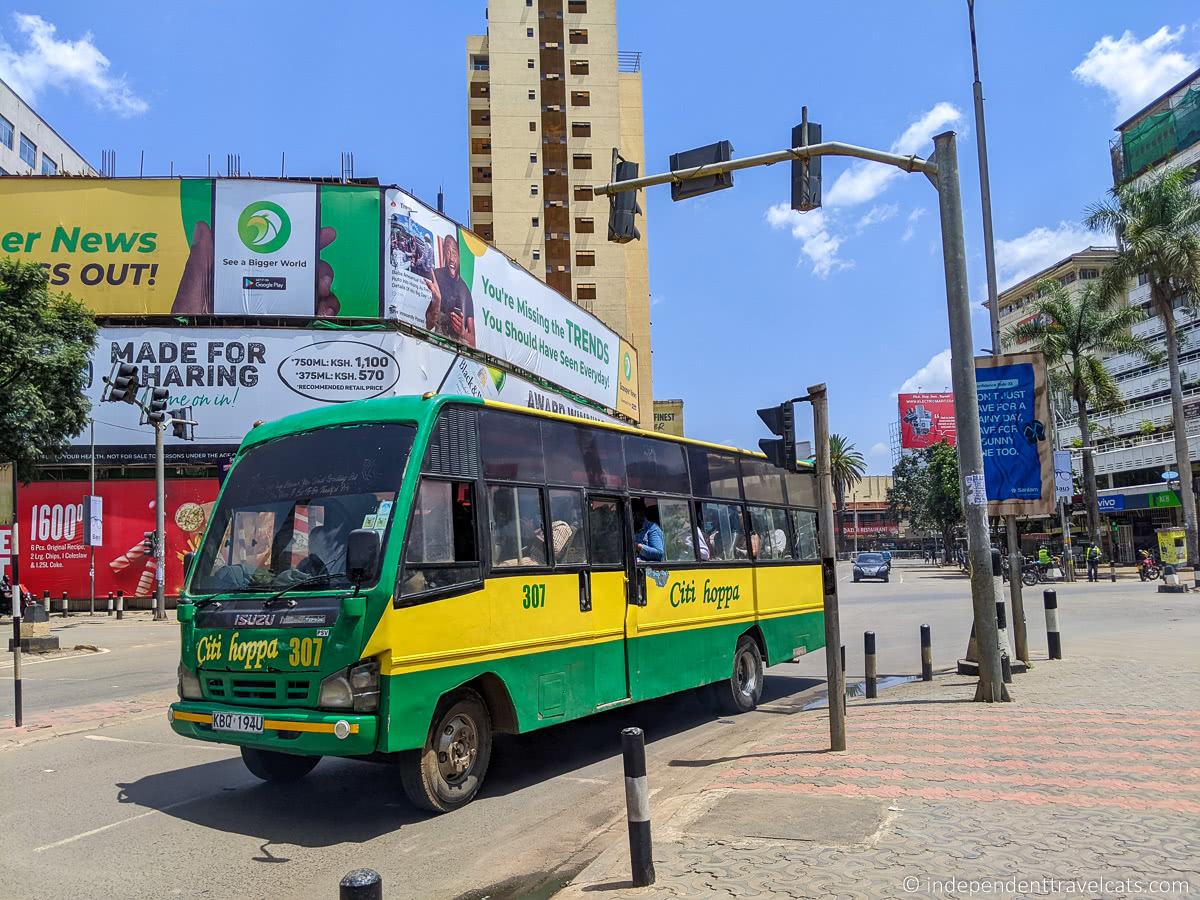
Kenya Travel Basics
In this section, we’ll cover all the basic travel info about planning your trip to Nairobi, including visas, electricity, money, language, weather, and clothing.
Most international visitors to Kenya will require a visa to enter the country. You should check your own government’s guidelines and those of Kenya for visa and entry requirements. You can apply online for an e-visa on Kenya’s government e-visa website here .
Note that if you are also visiting Uganda and/or Rwanda, you may want to apply for an East Africa visa instead. This visa covers Kenya, Uganda, and Rwanda. You can apply for this visa through the same website.
To enter Kenya, most travelers will need a valid e-visa, a passport valid for at least 6 months past their travel dates, a printout of their travel itinerary, a support letter (generally from your tour company or business hosting you), hotel booking details, and proof of planned departure (e.g., flight or booked safari itinerary). Many travelers may also be required to show proof of certain vaccinations against certain diseases such as yellow fever and COVID-19.
There are a lot of languages spoken in Kenya, but the main two are Swahili (Kiswahili) and English. Swahili is the most widely spoken language in Kenya, but English is also an official language and is widely spoken and understood. This is particularly true in Nairobi.
Tourists who don’t speak Swahili or English often hire a local guide who speaks their native language or hire a translator.
Communication
We just wanted to note that many drivers, guides, and small businesses in Kenya use Whatsapp messaging as the main way (and sometimes only way) to communicate. We recommend considering setting up a free Whatsapp account on your phone if you don’t already have one. This was the main way we communicated with our guides and drivers while in Kenya.
The currency of Kenya is the Kenyan shilling (Ksh). It is easy to find an ATM in Nairobi to take out local currency and we recommend using ones either at the airport or at a bank. Credit cards, as well as certain money transfer apps like M-Pesa , are widely accepted.
Foreign currencies, like the United States dollar, Euro, and British pound sterling are also regularly accepted in the tourism industry. The most accepted and most stable foreign currency in Kenya is the U.S. dollar. In fact, many tourist activities are priced in US dollars. So it is a good idea to have US dollars with you.
However, it costs money for locals to exchange foreign currency into local currency, so it is good to pay smaller businesses and to tip local guides in Kenyan shillings if possible.
In Kenya, we generally use USD to pay for things at hotels and tourist attractions and for large tips (e.g., main safari guide or driver). However, we generally used Ksh to tip local guides and staff, pay at markets and local restaurants, or to buy souvenirs. So it is good to have some of both currencies on you throughout your trip.
Some attractions, particularly after the COVID-19 pandemic hit, started only accepting non-cash payments. But a couple of places we visited only accepted cash. So it is a good idea to have both a credit card (or M-Pesa) and cash on you while in Nairobi.
Electricity
Kenya operates on a 240V supply voltage and 50Hz and uses a Type G plug. So you will want to avoid packing any electronics that don’t support 240V.
If you are coming from a country that does not use a Type G plug (three-prong one found in the UK), you will need a travel adapter to plug in your electronics. You can pick up a few simple travel adapter plugs like these ones , or you can take some universal travel adapters like this one which work in most countries around the world.
The average annual temperature is around 66° F (18.5° C). Daytime temperatures rarely go below 50° F (10° C) or above 85° F (29° C).
February and March are typically the hottest months in Nairobi with an average temperature of 69° F (20.5° C) and the coldest months are July and August with an average temperature of 62° F (16.5°C).
Kenya has two rainy seasons, from March to May and from October to December. The rainiest month is April with a lot of rain also typical in May and November. So you’ll definitely want to be prepared for rain if visiting during the rainy season, but we’d recommend being prepared for rain no matter when you visit.
Nairobi is a city you can visit any time of the year. The weather is pretty temperate throughout the year, being warm during the days and cool at night. Most attractions in the city are open year-round to visitors.
How to Dress in Nairobi
We recommend wearing comfortable clothing in Nairobi that are suitable for the weather. It is often sunny in Nairobi so be sure to protect yourself from the sun and check the weather forecast for rain.
It is important to respect the local culture and customs while in Kenya, which means wearing clothing that is more loose-fitting and conservative. This means avoiding really tight-fitting clothing or clothes that are short, show off your stomach, or expose a lot of skin. However, although Kenyans may wear more conservative styles, they love color and bold patterns!
Now, while safari clothing and hiking boots are great to wear when on safari or hiking, we don’t recommend wearing those clothes when visiting Nairobi (unless you are going to Nairobi National Park). We recommend wearing your regular travel clothes and leaving your safari clothing in your suitcase while exploring the city.
For shoes, you’ll likely be walking around a lot so you’ll want comfortable walking shoes. It is also good if you wear shoes that you don’t mind getting a little dirty. Laurence and I wore Allbirds Tree Runners shoes during our last visit to Nairobi and they worked very well.
For more packing suggestions, see our guide to what to pack for safari which should help with your general packing list.

Travel Health
We love traveling in Kenya, but there are precautions you need to take to stay safe and healthy during your travels. These include avoiding untreated water, avoiding being bitten by mosquitoes, and making sure you are up to date on recommended vaccines and medications.
We highly recommend that you talk to your doctor or go to a travel clinic before your trip to see what vaccines and medication are needed or recommended. You can also discuss water safety, preventing mosquito bites, managing any existing conditions you may have, and traveling with medications.
We also highly recommend reading the health advice given by your local government for travelers to Kenya. You can see the U.S. CDC travel health information and recommendations to travelers here , and from the UK government here .
Water Safety
The tap water in Nairobi is not considered safe to drink for travelers by most government travel organizations. In Kenya, it is recommended that you only drink bottled water or tap water that has been boiled, treated, and/or filtered.
Drinking untreated water or eating unclean food can cause travelers’ diarrhea and other water-borne diseases, such as cholera, hepatitis A, polio, and typhoid. So you will want to take the normal precautions as you would when traveling to any destination with unsafe water, such as avoiding ice, unwashed or unpeeled raw fruits and vegetables, unpasteurized dairy products, and cooked foods that are not served hot.
If you are wanting to avoid buying bottled water in Nairobi, you can read this article on safe drinking water when traveling for ways that you can treat water when traveling. We used a Grayl water filter bottle for filtering tap water for drinking, cooking (e.g, washing fruits), and brushing our teeth while in Nairobi on our last trip. This made it so that we didn’t need to buy any bottled water.
There are a number of vaccinations recommended for travelers to Kenya. You should talk to your doctor or go to a travel clinic before your trip to see what vaccines and medication are needed or recommended. These will depend on what parts of Kenya you are visiting, what you plan to do there, and your medical history.
I think before our last trip to Kenya, our doctor recommended 3 vaccine boosters for me and 2 for Laurence. We also got antimalarial medication to take throughout our trip.
You should make a travel health appointment at least 2 weeks prior to travel as some vaccines, such as the yellow fever vaccine, may take at least 10 days to be effective.
Proof of some vaccinations, such as yellow fever and COVID-19, may be required, depending on where you live, where you have traveled, and any recent disease outbreaks. Be sure to check the latest requirements.
There are mosquitoes in Nairobi although the risk of malaria and other mosquito-borne diseases if bitten is typically very low in the capital according to the WHO and other health organizations. The number of mosquitoes fluctuates based on rainfall, temperature, and time of year.
However, while the risk of getting malaria may be low in Nairobi, it is much higher in many other parts of Kenya. If you are visiting other parts of Kenya, you should talk to your doctor before your trip about antimalarial medications. Most visitors to Kenya take antimalarial medication during their trip and we have always done so.
But even if you are not worried about the risk of malaria in Nairobi, mosquito bites are annoying, itchy, and can transmit other diseases (e.g., yellow fever, dengue fever, Rift Valley fever, and chikungunya). We were bitten a few times on our 2022 trip in Nairobi because we forgot to use a mosquito net one night.
The best ways to prevent mosquito bites include using insect repellent with DEET , wearing long sleeved shirts and long pants, and using mosquito nets. Mosquitoes are most active between dusk and dawn.
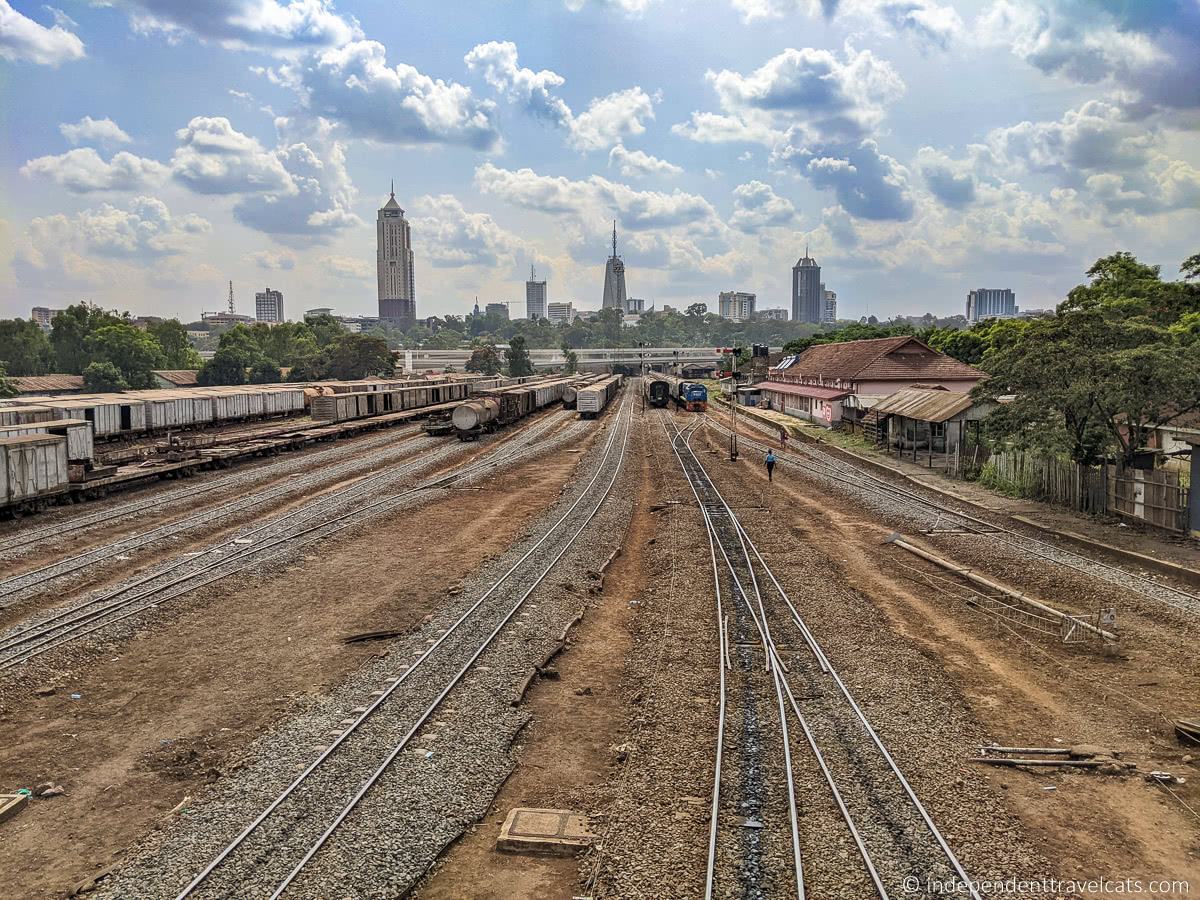
Is Nairobi Safe for Tourists?
Nairobi is not considered the safest city and its rate of crime is often rated as “high” compared to other cities in the world. But it has improved from the days when it was referred to as Nairobbery due to the high crime rates. While it is of course impossible to predict crime or terrorism, by taking precautions you can travel safely in Nairobi.
You particularly want to be careful with securing valuables and being aware of your surroundings. The most common crimes against tourists are pickpocketing, muggings, and carjackings. You also want to be skeptical of people approaching you asking to sell you something (e.g., cheap safaris or tours) or asking for donations for a good cause.
It is recommended that travelers avoid Nairobi neighborhoods where there is increased crime rates like Eastleigh and Kibera. We have visited Kibera but only during the day when accompanied by a guide.
Like in many major cities, we recommend taking extra precautions if out in the city at night. We always get a taxi or hire a driver if we need to get around at night.
It is best to carry around only the amount of money needed for your day so that if you are robbed, you won’t lose a great deal of money. If robbed, don’t resist, just give them what they want to avoid any physical escalation. It is also a good idea to have a money belt or similar separate place to hide your passport and a spare credit card.
If carrying a purse or bag, we recommend a cross-body one, a sling, or a fanny pack that is harder for someone to snatch and less likely for you to set down. If wearing a backpack, we recommend considering a small one with lockable zippers, such as the ones by PacSafe . We recommend carrying only what you need for the day.
Even if it may be fairly obvious that you are probably a tourist, you still want to avoid being too conspicuous by not carrying around big cameras, designer handbags, wearing expensive jewelry, etc. Best to leave your expensive gear and valuables at home or locked up at your hotel.
I’d also recommend avoiding holding out your smartphone while walking around, not only is it something that is easy to steal but it also distracts your attention. If you need to check your phone, do so before you set off or when in a safe spot. Also, it is always a good idea to have any important information and your photos backed up elsewhere so if your phone is lost, stolen, or damaged you still have all the data.
If walking around, especially in the city center, you will no doubt be approached by people trying to sell you cheap safaris and such. I’d recommend telling them politely but firmly that you are not interested and moving along. They will generally leave you alone but if you are feeling harassed or followed, I’d recommend going into a hotel, restaurant, or store to get rid of them or telling a nearby police officer or security guard.
Not all taxis and drivers in Nairobi are reputable. If you need a taxi, we recommend using a secure taxi-hailing app like Uber or Bolt. These make it so the prices are regulated and you can pay without needing to hand money to the driver. We have used Uber many times in Nairobi without incident.
Being stuck in traffic in Nairobi can attract street sellers, beggars, and thieves. When in a car, I’d recommend keeping your window rolled up and your door locked. If in a manatu , I’d keep hold of any bags or valuables to prevent thieves from snatching things.
Don’t be afraid to ask questions of your driver, hotel staff, local guides, tour operator, etc. about whether it is safe to do X or Y. If you are unsure if it is a good idea to walk or visit somewhere, it can be good to get a local opinion. Most people are very willing to give advice for visiting their city.
You want to be particularly cautious when traveling in Kenya around the time of elections or referendums as violence, rioting, and ethnic tensions in the country often escalate during these periods. If you are visiting at a more tense or politically unstable time, it is probably safer to stick to guided activities. However, thankfully, even though the 2022 presidential election was contested, it was a fairly peaceful transition of power.
It is a good idea to check with your local government’s advice on traveling to Kenya and take that into consideration. For example, at the time of writing, the U.S. Department of State recommends avoiding the Nairobi neighborhoods of Eastleigh and Kibera due to increased crime there. On many government agency websites, such as the U.S. travel alerts , you can also sign up for travel alerts by text or email to get updates while traveling.
We always recommend making sure you have travel and medical insurance coverage. If you experience a crime, you should report it to the local police. Even if they aren’t likely to be able to help (e.g., pickpocketing), you will likely still need a copy of a report for your insurance. For more serious issues, you may also want to contact your country’s embassy or consulate who can help direct you to further resources.
While the above may make Nairobi sound scary, we have visited Nairobi several times without any incidents. We have walked around a lot in the city on our own, especially around the Downtown area. We have hired local drivers, taken local transportation, and used Uber. We have done both guided and unguided visits to most of the city’s main attractions. We have also gone shopping on our own at both shopping centers and local markets.
Although we have traveled more independently in Nairobi than most foreign visitors, we still take the precautions we note above. The main thing we have experienced is people coming up to us to beg for money, try to convince us to follow them and visit their shop, or trying to sell us cheap safaris. Sometimes they are pretty persistent and annoying, but generally, they will leave you alone if you are firm and move away.
We recommend that those who are concerned about safety stick to guided tours or hire a private guide or driver. Guides can not only make travelers feel safer, but they can also help make everything run smoother and can provide invaluable background and context to the places you visit. But also remember that even a guide can’t always prevent things like purse snatching or pickpocketing, so you still need to use personal caution.
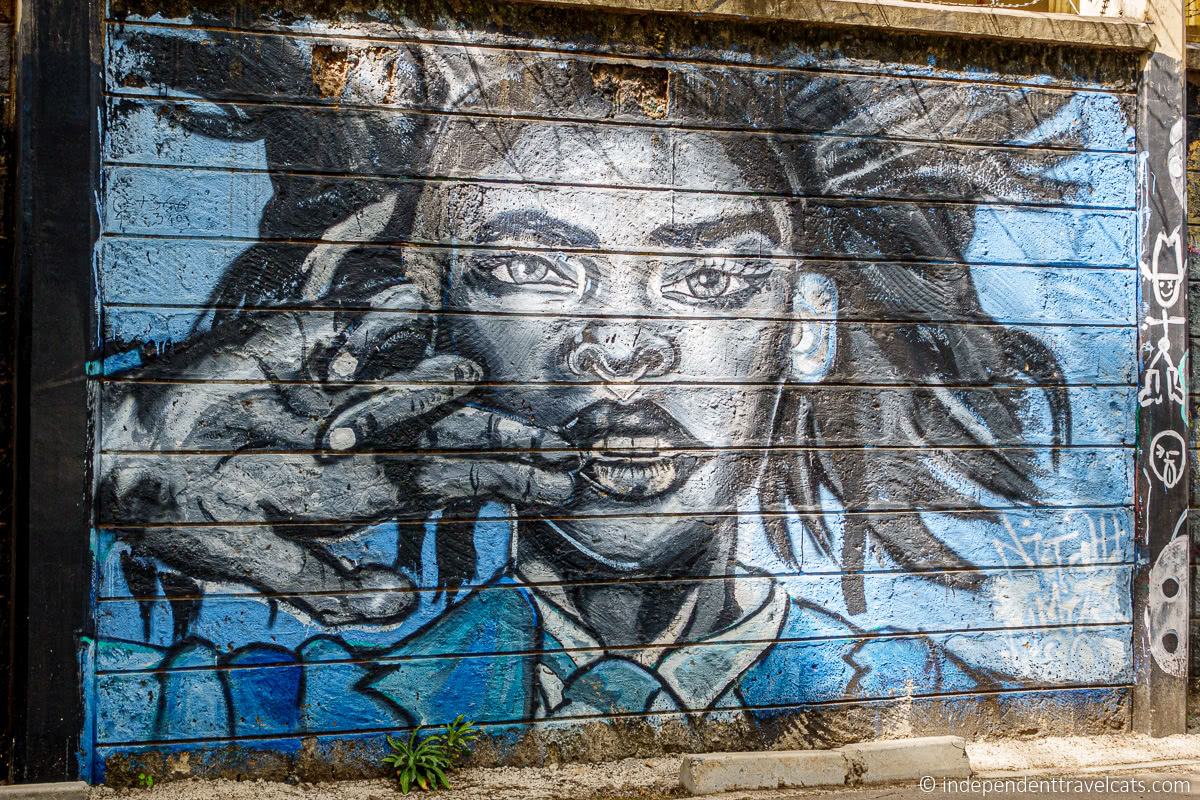
How Much Time Should I Spend in Nairobi?
How much time you want to spend in Nairobi will likely be determined by your interests and the length of your trip. There are lots of things to do and see in Nairobi and you can easily spend several days in the city as we have.
As the capital and largest city in Kenya, we definitely think that Nairobi deserves at least one full day of your trip. No matter your interests, whether it is history, culture, wildlife, shopping, art, or food, you are likely to find things that appeal in the city.
Personally, I’d recommend having at least 2 full days in Nairobi. That will give you time to see many of the highlights of the city. But you can still see quite a lot if you just have one full day. You can check out our earlier article to see our tips for how to spend one day in Nairobi which includes a detailed stop-by-stop suggested itinerary.
If you have a safari that begins or ends in Nairobi but your safari itinerary doesn’t include any sightseeing in Nairobi, you can easily book a guided day tour of the city such as these available online here or here . Or you can explore independently on your own. You may want to arrange to come into the city a day or two early or stay later to have time for sightseeing before or after your safari.
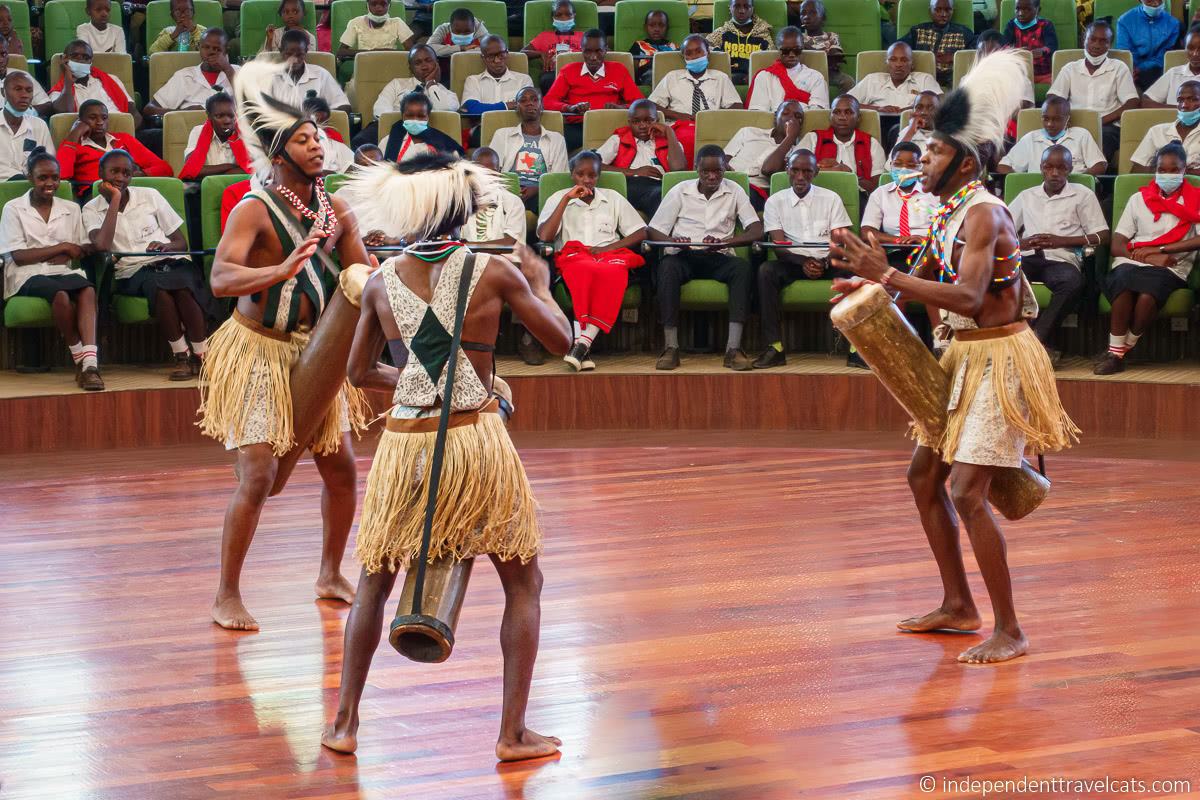
Where to Stay in Nairobi?
We recommend choosing your location based on the places you want to go in Nairobi, especially if you only have a short time in the city. Generally, we would recommend staying either in or near the Downtown area of Nairobi or in one of the western neighborhoods like Lang’ata or Karen.
Nairobi has a very wide range of accommodation options including hotels, guesthouses, hostels, apartments, and home rentals. Prices range from cheap $30 budget stays to $3,000 per night luxury stays. We have found it very easy to find mid-range accommodation during our stays in Nairobi.
If booking accommodation in the more budget range, just be sure to read recent reviews, check the details to see what is included, and make sure in an OK area of the city.
We generally recommend booking accommodation that includes an on-site restaurant (or cooking facilities if booking an apartment or hostel) as then you always have the option to eat your evening meal there. Even if you plan to eat out elsewhere, this gives you a very convenient backup option if you don’t feel like going out at night.
Downtown Nairobi and the Westlands
The Downtown area or Central Business District (CBD) is a great area for those planning to visit central attractions like the Kenyatta International Convention Centre, City Market, Jamia Mosque, Maasai markets, Central Park, Uhuru Park, Nairobi National Museum, Railways Museum, and downtown shopping. The Westlands area , located just north of the center, is also a good place to check and is a popular area for expats.
Here are some lodging options in both the CBD and Westlands areas:
- Stanley Hotel – The Stanley Hotel was Kenya’s first luxury hotel, dating back to 1902. This 5-star hotel offers 3 restaurants, a bar, a fitness center, a pool, and on-site private parking. It is located right in the heart of the Central Business District. If you are looking for a historical hotel in a central downtown location this is one to consider.
- The Norfolk – This 5-star Fairmont property is another one to consider if you enjoy historical hotels as the hotel is situated in a 19th century colonial building surrounded by gardens in the northern part of the CBD. It offers several restaurants, a fitness center, a pool, and 24-hour front desk.
- Hilton Nairoi – This 4-star hotel is a good option for business travelers and conference attendees who want to be super close to the KICC. The hotel offers on-site restaurants, bar, fitness center, business faciltiies, spa, pool, and 24-hour front desk. The hotel is located in the CBD and is just a short 5-minute walk from the KICC building.
- Best Western Plus – This hotel is a solid mid-range option located in the CBD. The hotel offers a restaurant, bar, a fitness center, and a swimming pool.
- YWCA – If you are traveling on a small budget, this YWCA is located just outside the CBD may be an option to check out. It offers private rooms and an on-site cafeteria.
- Nairobi Serena Hotel – This is another 5-star hotel that is located just outside the CBD, offering spacious rooms, on-site restaurants, bar, fitness center, pool, and 24-hour front desk. This hotel is part of the popular Serena hotel brand that has hotels throughout East Africa.
- Villa Rosa Kempinski – The Villa Rosa is a lovely 5-star option in the Westlands area, offering spacious rooms, on-site restaurants, spa, fitness center, 24-hour desk, and swimming pool.
- Lotos Inn & Suites – This mid-range hotel in the Westlands offers spacious suites, an on-site restaurant, rooftop lounge, and free private parking. Close to a number of restaurants and shopping centers.
Western Neighborhoods of Nairobi
Lang’ata and Karen are both good locations for popular tourist attractions such as the Giraffe Centre, Uhuru Gardens, Karen Blixen Museum, Bomas of Kenya, Carnivore Restaurant, Kazuri Beads factory, and Sheldrick Wildlife Trust Elephant Orphanage. It is also a good location for those visiting Nairobi National Park.
Another good area to consider is the areas just west of Downtown Nairobi which put you in between the Central Business District and the areas of Lang’ata and Karen. These include areas like Lavington and Kilimani . Good areas for those visiting attractions in both of these areas and where we often choose to stay.
Here are some accommodation options in the western suburbs of Nairobi:
- Hemingways Nairobi – This 5-star luxury boutique hotel located in Karen offers an on-site restaurant, bar, spa, swimming pool, and private butler service. All rooms are suites. This is one of the more luxurious properties in Nairobi.
- Karen Gables – This 4-star Karen lodging option offers a luxury B&B experience in a beautiful Dutch Cape style private home. Offers an on-site restaurant, lounge, and swimming pool.
- Tamarind Tree Hotel – This 4-star hotel in Langata offers an on-site restaurant, bar, swimming pool, fitness center, and garden. The famous Carnivore restaurant is on the grounds, a short walk away. Great location for lots of Langata and Karen attractions, Wilson airport, and Nairobi National Park.
- Palacina The Residence & Suites – This great mid-range option in Kilimani offers both suites and private apartments. The property offers an on-site restaurant, fitness center, and swimming pool.
- The Social House – This mid-range 4-star hotel is located near the Lavington area and offers an on-site restaurant, swimming pool, fitness center, and garden.
- Margarita House – This guest house located in Karen offers an on-site restaurant, swimming pool, and garden. A reasonably priced option in the pricey Karen area.
- Lavington Hill House – This 3-stars guesthouse in Lavington has an on-site restaurant and bar and is surrounded by leafy gardens. Before it became a boutique hotel, it was the official state residence of the President of Southern Sudan. This was the very first place I stayed in Nairobi years ago.
- Pori City Hotel – This budget-friendly 3-star hotel option in the Langata area offers an on-site restaurant, bar, business center, and a 24-hour front desk.
Near the Nairobi Airport
If you need to stay near the Jomo Kenyatta International Airport (NBO) you can look for a hotel in the Embakasi area . This area is mainly residential. The closest hotels are the Sheraton Four Points and Crowne Plaza airport hotels. A lower-priced option near the airport is Kozi Suite s .
If you need to stay near the regional Wilson Airport, you can see the closest lodging options here , many are in the Lang’ata area. The closest hotel to Wilson Airport is the Weston Hotel and another good nearby option is the Tamarind Tree Hotel . The Pinkroses Garden Hostel is a well-rated budget option in this area.
Nairobi National Park
There is currently only one accommodation option (other than basic camping) located inside Nairobi National Park and that is Nairobi Tented Camp . The tented camp is a great place to stay if you want to be inside the national park and feel like you are on safari. Just note that you will need to pay the park fees each day of your stay in addition to the lodging costs.
If you are looking for a place away from the city, there are also several other hotels located on the southside of the park. A couple of good options located on the edge of the park include Ololo Safari Lodge and Nyati Hill Cottages . They are situated overlooking the escarpment of the national park and you often see wildlife without leaving the property. Great places to relax and to stay for visiting Nairobi National Park, but not the best location for visiting downtown attractions.
Neighborhoods in Northern Nairobi
If you are just looking for the safest neighborhoods in Nairobi, then Gigiri and Muthaiga are two northern suburbs which are often rated as the safest places to live in Nairobi. They are close to Karura Forest as well as restaurants and shopping, but are further away from most tourist attractions.
There are a number of hotel and apartment options in this area including the 5-star Tribe Hotel and well-rated mid-range Trademark Hotel and Magna Hotel & Suites . All are located in Gigiri.
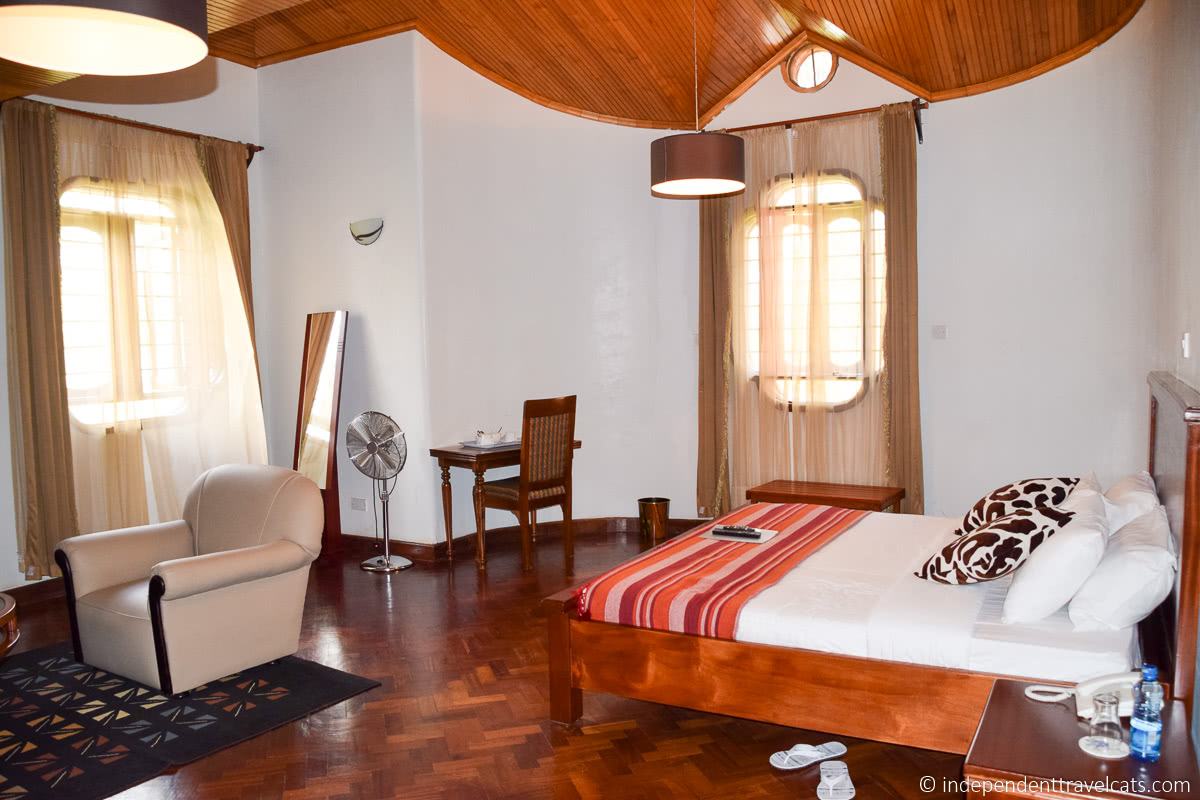
Booking Tours in Nairobi
Most visitors book some kind of tour or driver for sightseeing in Nairobi. You can visit just about any of the recommended attractions as part of a tour. There are a lot of tour options for both those wanting to join a small group tour and those looking for a private tour.
As always, when booking any type of tour, be sure to note what is included/excluded and any restrictions before booking. Entrance fees and meals may not be included so you will want to plan and budget accordingly. Some tours may also have minimum age requirements or health restrictions.
Also be sure to check the tour’s cancellation policies. We normally book tours with either GetYourGuide or Viator which both offer a 24-hour cancellation policy for most tickets and tours. This means you can cancel a tour up to 24 hours before it starts and receive a full refund. This helps give us peace of mind if our travel plans unexpectedly change.
If you are looking for a tour in Nairobi, here are a list of some popular Nairobi day tours (both small group and private tours) that may be of interest. These cover a wide range of Nairobi’s top attractions:
- This 6-hour guided tour includes a game drive at Nairobi National Park and visits to the Giraffe Centre and the Sheldrick Wildlife Trust Elephant Orphanage.
- This flexible private tour includes a downtown city tour, which can include stops to see the City Market, Kenya National Archives, and KICC rooftop, and lunch at Carnivore.
- This full-day tour includes visits to the Giraffe Centre, David Sheldrick Wildlife Trust Elephant Orphanage, Kazuri Beads factory, and the Karen Blixen Museum. This is very similar to the tour I took on my first visit to Nairobi.
- This full-day tour includes visits to the Giraffe Centre, David Sheldrick Elephant Orphanage, Kazuri Beads, and Bomas of Kenya.
- This 4-hour private downtown tour includes stops at the Nairobi National Museum, Railway Museum, City Market, and KICC rooftop. Tour is flexible.
- This downtown walking tour of the Central Business District is led by former street children who guide you through the downtown while telling their stories. Also includes a local lunch stop.
- This half day tour includes a visit to the Sheldrick Elephant Orphanage, Giraffe Centre, and Kazuri Beads.
- This half day private tour of Nairobi National Park includes a guided game drive, safari vehicle, and hotel pick up and drop off. Or save money by joining a similar small group tour of the park.
- This private tour includes transport, a guide, and entrance fees to visit the Bomas of Kenya.
- This guided tour of Kibera allows you to learn about and tour Africa’s largest slum area with a local guide who runs a non-profit organization.
- This guided full day shopping tour of Nairobi allows you to visit a number of shops, markets, and craft centers in Nairobi.
Now, if you are planning on doing a multi-day safari in Kenya, you should definitely research and book one before you leave home. It is possible to visit some of Kenya’s national parks (other than Nairobi National Park) as part of a day trip from Nairobi, but I’d recommend tours that stay overnight or longer so you are not rushed.
Popular places you can go on a safari within a relatively short drive of Nairobi are Lake Naivasha National Park (~2.5 hours drive), Lake Nakuru National Park (~3.5 hours), Amboseli National Park (~4 hours), and the Maasai Mara (~4.5 hours).
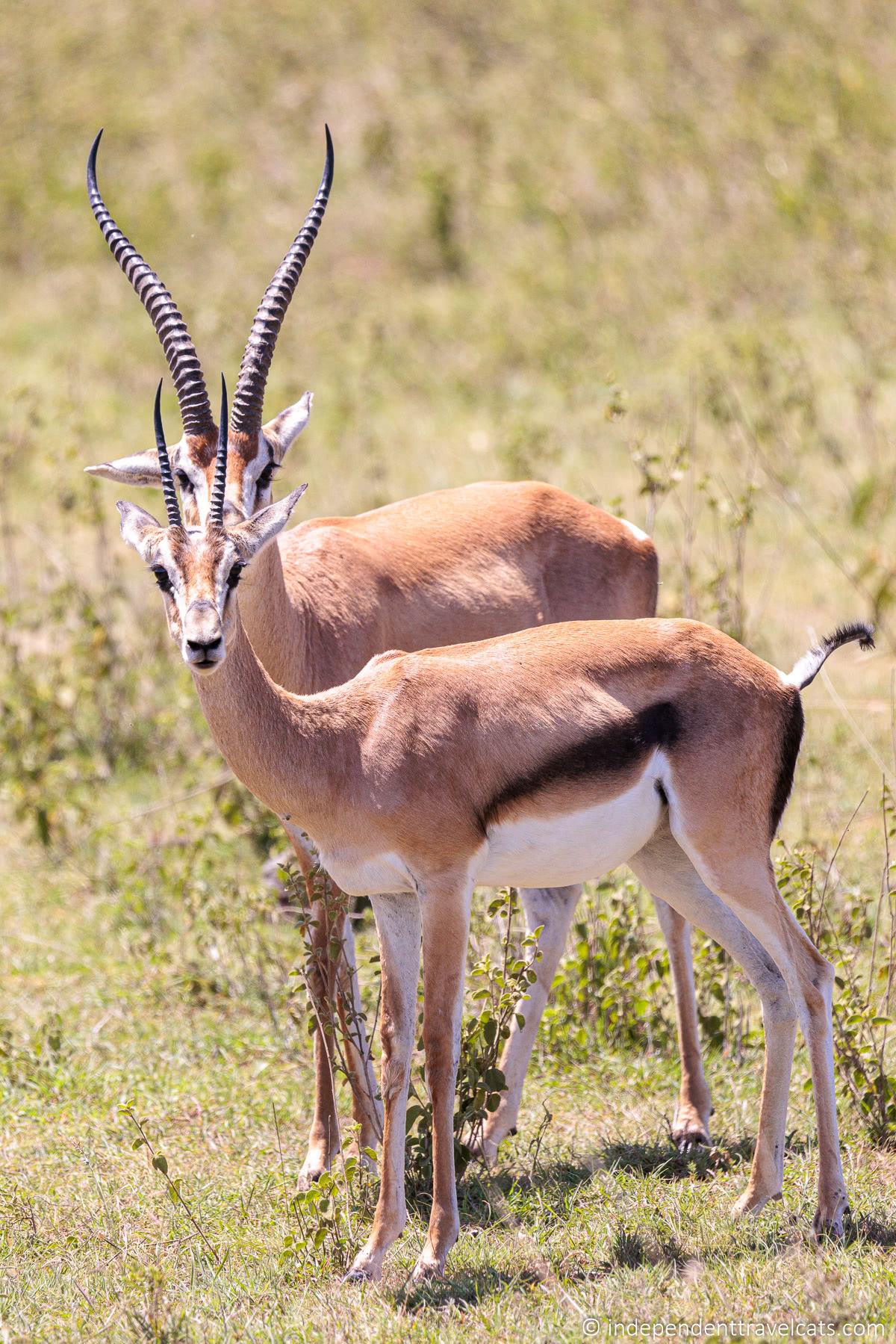
Top 24 Things to Do in Nairobi
Nairobi has a lot of attractions, including wildlife centers, museums, parks, gardens, and markets. We recommend using this list to choose the places you most want to visit so you can put together your own Nairobi itinerary.
Here is our list of top things to do in Nairobi:
Nairobi City Tour
A city tour with a local guide is a great way to see Nairobi if you are a first-time visitor. It is especially nice to explore the downtown area with a local guide to learn more about the city.
There are both walking tours and driving tours that you can join, depending on how you want to get around. You can hire a private guide or join a small group tour. The private tours are often flexible in terms of where they visit so you can choose from a list of attractions that best suit your interests. But you can save money by joining a group tour if it goes to the places you want to visit.
These tours are usually focused on the downtown Central Business District and often include visits to local landmarks, public parks and gardens, markets, the KICC building, museums, and other city attractions. They may or may not also include lunch.
You can check for available city tours in Nairobi here , as they vary in time, where they visit, what they include, and the forms of transportation. For example, this half day city orientation tour includes both private transport and walking (if you want). This tour also includes lunch at Carnivore.
For those interested in walking and getting closer to the city’s landmarks and people, you might consider this popular downtown walking tour , this storytelling tour , or this walking food tour .
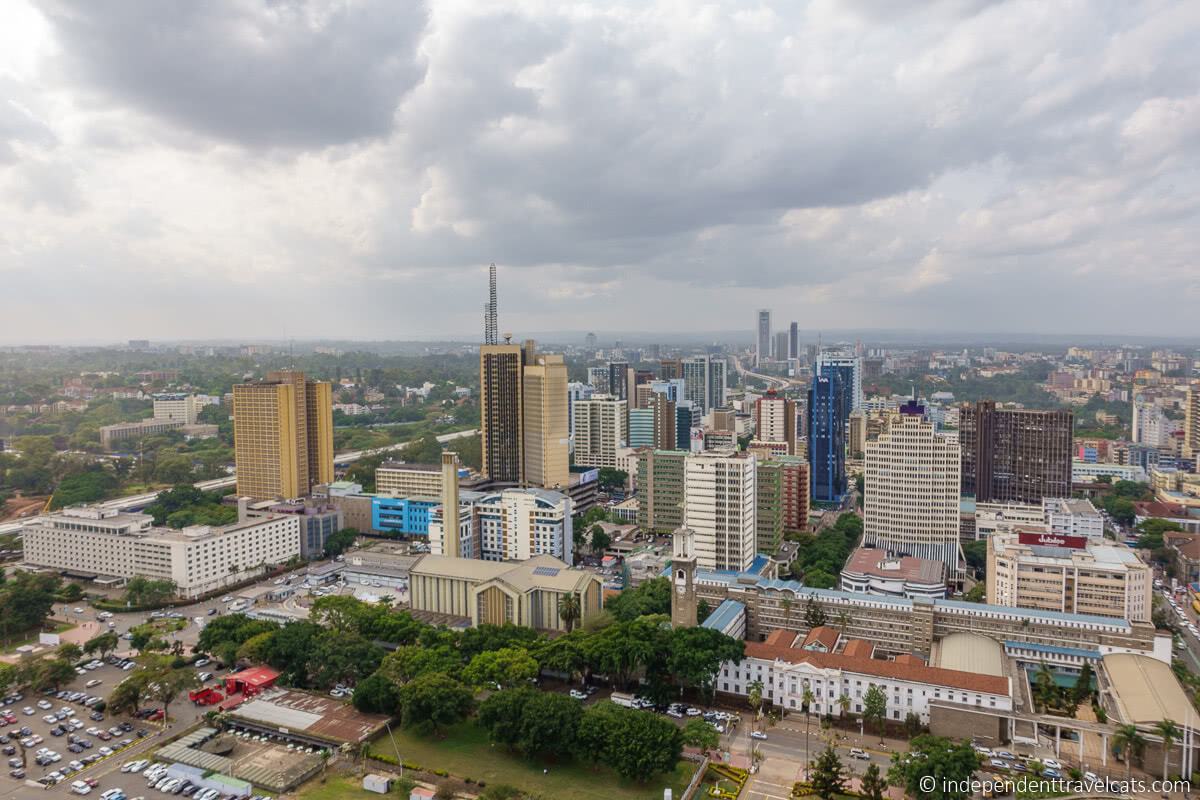
Nairobi National Museum
Nairobi National Museum is a great general museum to visit while in the city. The museum has been around in some form for over 100 years, first set up in colonial Kenya by the British. It carried on after independence and has been expanded and updated over the years. It is the flagship museum of the National Museums of Kenya.
The museum has a number of different galleries that each focus on a theme such as Kenyan history, mammals, birds of East Africa, cultural anthropology, human evolution, money, art, and musical instruments. There are also changing temporary exhibitions.
A couple of displays that international visitors often know about are the skeleton of Ahmed the elephant (one of the most famous elephants in the world) and the Joy Adamson Gallery (known for her book Born Free and the movie of the same name).
There is a fee to visit the museum. You can do a self-guided visit on your own or hire a guide. The museum is located in central Nairobi, just north of the Central Business District and just south of the Westlands.
In addition to the museum, you’ll also find the Museum Botanical Gardens, a nature trail, and the Snake Park at the same location. Visiting the Botanical Gardens and walking along the nature trail are free to do and worth doing if the weather is nice. But there is an extra fee to visit the Snake Park (you can buy a combo ticket), which includes a number of snakes and other reptiles on display. You can check rates online here .
Also here at Museum Hill you’ll find places to eat, gift shops, and the Louis Leakey Memorial Institute auditorium. You can easily spend half a day here.
Nairobi National Museum would be our top pick if you are looking for just one museum to visit in Nairobi. It is a good general museum and a great place to learn more about the country with a wide variety of displays.
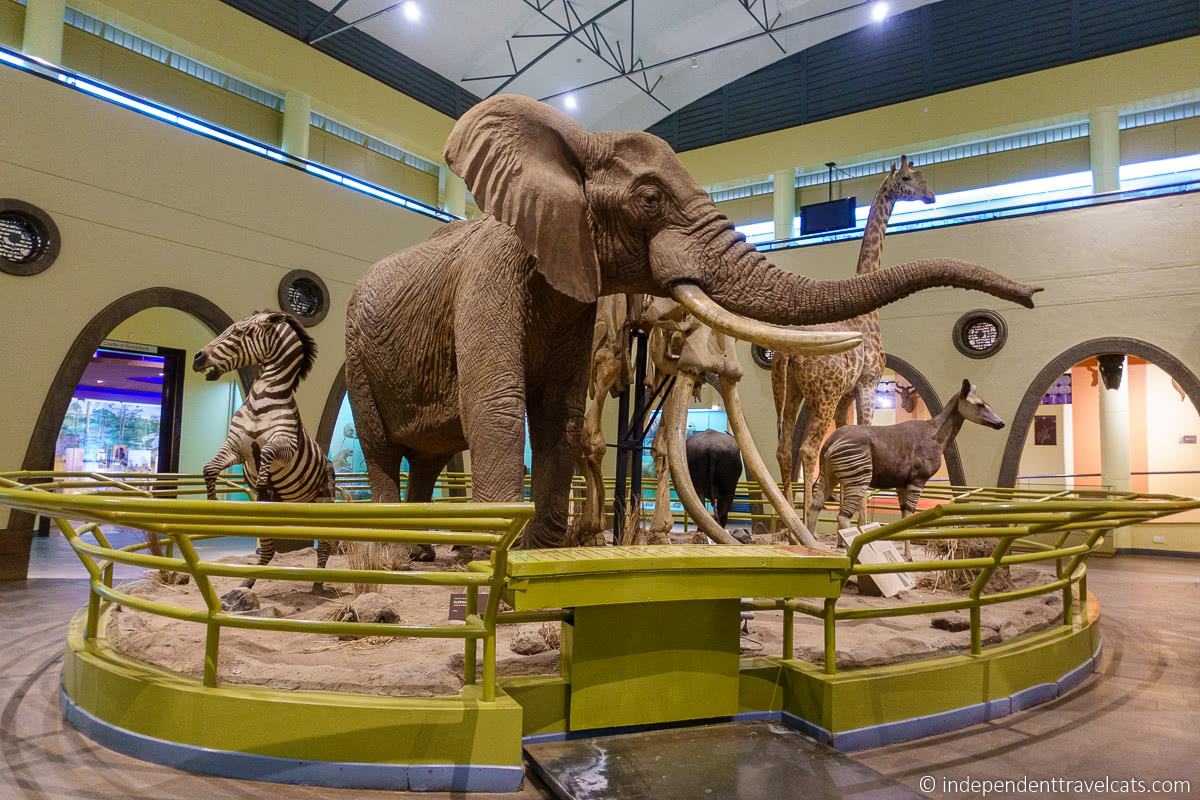
Nairobi National Park is unique as it is the only wildlife park located within a capital city. It is located just 10 km south of the downtown area of Nairobi. It is one of the few places in the world where you can spot animals with a city landscape in the background.
Although a somewhat compact park, it has over 100 species of mammals. It has 4 of the Big Five animals; the park does not have any elephants. It has many of the animals that people come to Kenya to see, including lions, leopards, giraffes, zebra, cheetah, hyenas, rhinos, hippos, impala, baboons, and crocodiles. Over 400 bird species have been recorded here.
If you plan to visit the park, we recommend going early and visiting in the morning. Many of the animals and birds are more active in the cooler morning hours. You can obviously see more if you have a full day. But if you just have half a day for visiting, we recommend choosing the morning rather than the afternoon to visit.
You can drive your own vehicle or hire a guide. We highly recommend going with a driver guide who knows the park and in a proper safari vehicle with a pop-up roof. A good guide can really help you see more and better identify the animals and birds you do see.
If you are looking for a half day morning game drive with a driver in Nairobi National Park, you might check out this popular small group tour or this private tour . These tours normally include pick-up from your hotel or the airport. Just note that the tour fees often do not include the national park entrance fees.
Lots of full-day Nairobi tours include a morning game drive of 3 to 4 hours in Nairobi National Park followed by visits to other attractions in the area such as the Giraffe Centre, Sheldrick Wildlife Trust Elephant Orphanage, Karen Blixen Museum, and/or Bomas of Kenya. You can see a list of available tours here .
We spent a full day at the park and were very happy with the variety of animals and birds that we saw, and were particularly happy to have seen a number of rhinos. According to my journal, we saw 5 lions, black rhinos, white rhinos, giraffe, hippos, zebra, warthogs, crocodiles, buffalo, wildebeest, dik dik, impala, Thomson’s gazelle, Grant’s gazelle, hartebeest, eland, baboons, vervet monkeys, ostrich, guinea fowl, secretary birds, African fish eagles, kingfishers, kestrels, storks, egrets, and lots of other birds.
I think Nairobi National Park is an underrated park and we really enjoyed our time here. However, if you are coming back to Nairobi after a long safari trip, it may seem a little underwhelming compared to places like the Maasai Mara. But this is a great national park, especially if you are at the beginning of your time in Kenya.
There are a couple of areas within the park where you can stop and leave the vehicle on foot. One site we recommend stopping is the ivory burning site which contains information placards telling about the ivory burning that has taken place by the government here. Another area where you can stop is at a walking trail that takes you around the hippo pools.
The park has several picnic areas with toilet facilities, and we stopped at one to have a picnic lunch. Just be careful to watch for monkeys if you plan to eat outside your vehicle. For those not planning to bring food, there was a cafe that served food located just inside the main gate park entrance.
It is possible to stay overnight at Nairobi National Park. There are public campsites with basic facilities or you can stay at Nairobi Tented Camp .
The park fees can NOT be paid with cash, so be sure to bring an acceptable credit card or you can also use M-Pesa to pay for your entrance fees. Day fees allow for 12 hours within the park. You can check opening hours, park rules, and the latest park fees here .
Also located within the wider park area is the Nairobi Safari Walk. This is located near the main park gate and is geared to families with children. There is a raised platform viewing area where you can walk around and see a variety of mammals, reptiles, insects, and birds. The animals here are part of the park’s animal orphanage. The Safari Walk Children’s Museum is also located here. There are separate fees for visiting the Nairobi Safari Walk. You can find out more here .
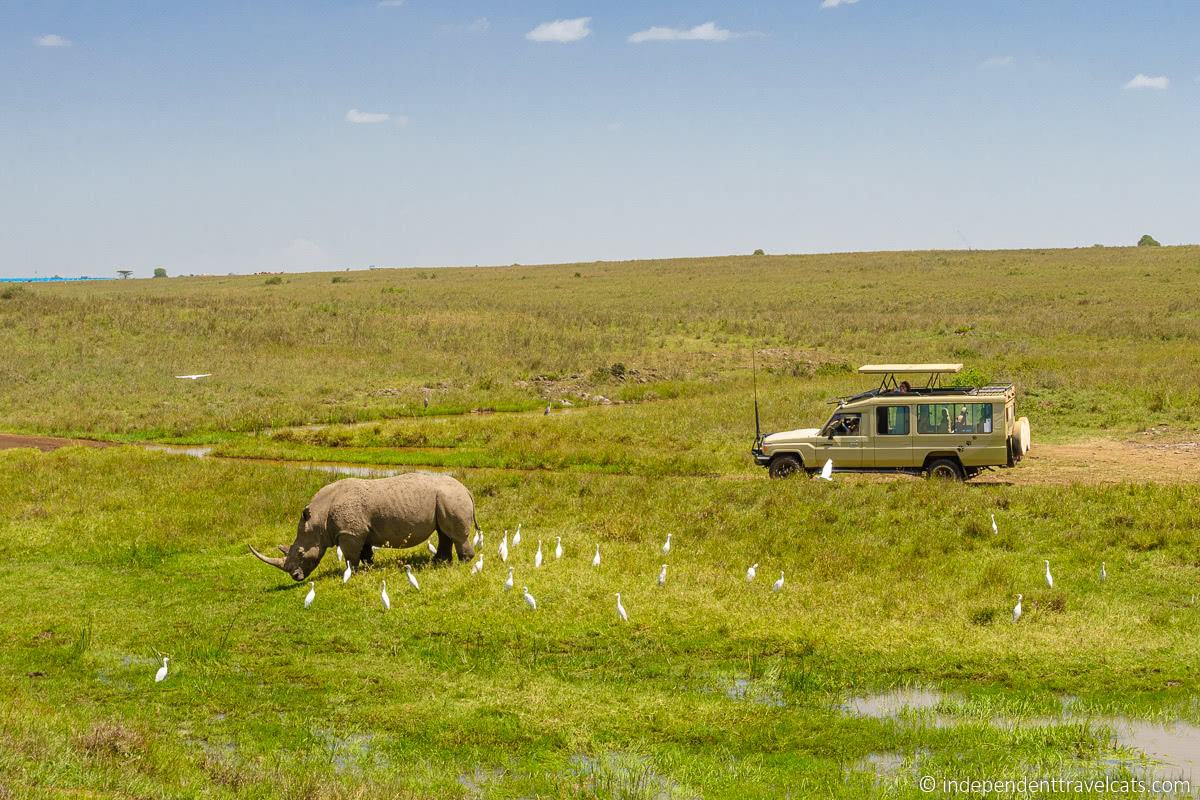
Giraffe Centre
The Giraffe Centre is an educational center run by the non-profit organization African Fund for Endangered Wildlife (AFEW). The AFEW was founded in 1979 by Jock and Betty Leslie-Melville to try to save the Rothschild’s giraffe through breeding, research, conservation, and education.
The Rothschild’s giraffe was the most endangered of the giraffe subspecies. At the time, there were only 130 of them left in Kenya and today there are over 300.
They started the program with a pair of young giraffes, Daisy and Marlon, who they brought to their home in the Lang’ata suburb of Nairobi. The center expanded and opened as an education center to the public in 1983.
As a visitor, you have an opportunity to get up close and feed the resident giraffes. I think there are currently about 10 giraffes here. They also have a family of warthogs you can see and feed as well that live with the giraffes.
After paying entry, you’ll be given a handful of pellets that you can feed to the giraffes while walking along a large viewing platform. The platforms are raised so that you are standing face-to-face with the adult giraffes and you can offer your pellets to the giraffes. They’ll eat them out of your hand. You’ll find that their tongues are wet and rough!
In addition to watching and feeding the giraffes and warthogs, we also recommend learning more about the giraffes by taking a look at the small exhibition and going to one of the free educational talks or lectures. These short talks about giraffes take place regularly in the small auditorium. If one is not happening, you can normally ask a staff member on the platform and say you are interested in one.
There is also a nature trail here that you can follow to see local plants, birds, and animals. It is located across the road from the Centre entrance and you can ask staff to point you in the right direction if you have any issues finding the starting point.
There is also a small tea room and a gift shop located on site. The center is normally open daily for public tours and visits from 9:00am – 5.00pm. You can check the latest opening hours and visitor fees here .
The Giraffe Centre is a popular stop to include on many group and private tours of Nairobi. it is easy to combine a visit here with a number of other attractions, including the Sheldrick Wildlife Trust Elephant Orphanage, Nairobi National Park, Bomas of Kenya, Utamaduni Shops, Kazuri Beads, and/or Karen Blixen Museum. If you are looking to join a tour, you can see a number of options here .
I’ve visited the Giraffe Centre twice and enjoyed my time here. Just be aware that this is a very popular stop for school groups (as is the Elephant Orphanage and Mamba Village) so it can get very busy here. I’d allow at least 30 minutes here if you just want to see and feed the giraffes, but I’d allow 1 hour to 1.5 hours if you also want to do the lecture and explore the nature trails.
If you really love giraffes and have a healthy lodging budget, you can also spend the night at the nearby Giraffe Manor and enjoy seeing giraffes on the front lawn. This is the former home of Jock and Betty Leslie-Melville that has been turned into a boutique hotel by the new owners.
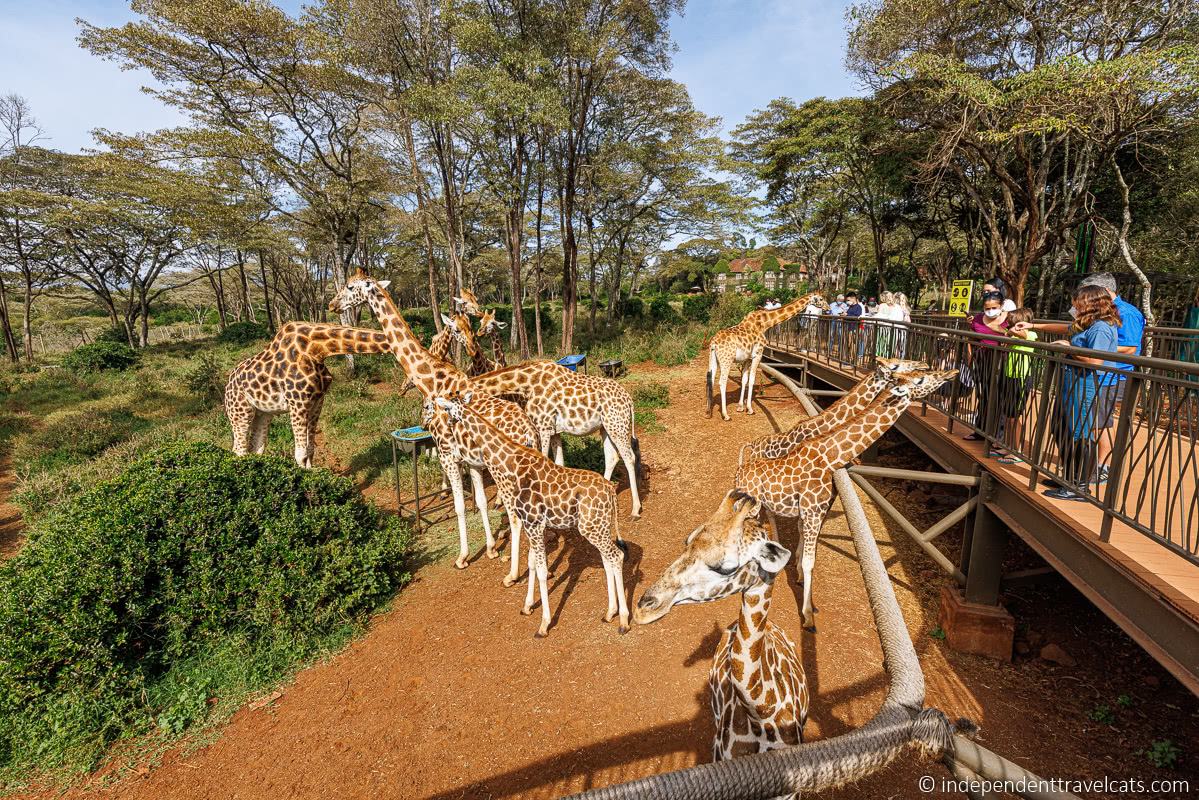
Sheldrick Wildlife Trust Elephant Orphanage
If you love baby elephants, then you definitely should plan a visit to the David Sheldrick Wildlife Trust Elephant Orphanage where you can see a number of baby elephants and learn about their care and the plight of elephants in Kenya.
Daphne and David Sheldrick were pioneer conservationists in Kenya and this wonderful elephant and rhino nursery and sanctuary was established in the 1970s. Located within a section of Nairobi National Park, the David Sheldrick Wildlife Trust provides care and a home to dozens of orphaned baby elephants and rhinos from all over the country with the goal of being able to release them back into the wild. Once the orphans reach a certain age and independence, they are moved to one of the three reintegration units to start the process of being released back into the wild.
Of course, the David Sheldrick Wildlife Trust does a lot more than run the Orphans’ Project. They are also involved in anti-poaching, aerial surveillance, providing veterinary care, community projects, education, and much more. While there is a focus on elephants and rhinos, the trust has projects that help wildlife of all kinds. Their goal is to “work to ensure a sustainable future for all wildlife, habitats, and communities.”
If you haven’t read Daphne Sheldrick’s memoir Love, Life and Elephants , I highly recommend reading it before your visit here. It is a great read and it will better help you understand the elephant orphanage, the Sheldricks, and the history of wildlife conservation in Kenya.
Visitors can visit the Elephant Orphanage daily at 11:00am to watch the public feedings of the young elephants and learn more about the mission of the trust. After parking, checking in, and paying, you follow a path to a large fenced dirt area. There are typically hundreds of visitors each day but the space is pretty large so you can still stake out a good view-point.
After a brief introduction, the first group of baby elephants are led in, these are the youngest of the elephants. You get to watch as they are fed bottles by the handlers, play in the water and dirt, and roam around the area. After the first group are led back to the stables, another group of older young elephants are led in and the feeding process is repeated.
During the feeding, a staff member with a microphone explains the goals of the trust and gives you some information about the individual resident baby elephants and rhinos. The baby black rhinos are not typically part of the visits.
We’d recommend wearing practical closed-toed shoes, sun protection (there is little shade here), and clothes that you would be OK with getting a little dirty. The elephants will sometimes come up and push against the ropes. You are allowed to touch them if they come close but you need to be careful as they weigh a ton. The elephants also love to splash around in the water and mud, especially the older ones. They also sometimes decide to spray mud all over visitors. One lady standing near us got covered in mud on our last visit. We experienced several small splashes.
The main reasons that elephants and rhinos become orphaned are poaching, habitat loss, natural causes, human conflicts, and drought. It is sad to hear about how elephant and rhino poaching is still a problem in Kenya (and many other African nations), mainly driven by Chinese demand for ivory and horn. Drought seems to be an ever-increasing reason as Kenya experiences prolonged periods of drought, which is causing both human and wildlife suffering across the country.
The cost of raising just one orphan elephant is ridiculously expensive. For those who want to contribute more to protecting the elephants, anyone can make a donation to adopt an orphan for a minimum annual donation of $50.00, which entitles donors to receive detailed information and monthly updates about their orphan. We adopted a little elephant named Roho on our last visit.
Our visit here was not only an amazing chance to get very close to a bunch of cute baby elephants, but also a good way to learn about and support a truly wonderful organization.
I’ve gone to the 11am morning visitor hour twice now, once in 2014 and once in 2022. I enjoyed both visits a lot. Both visits were similar in terms of the actual presentation and experience; however, there were a couple of clear differences. In 2014, no booking was required and there were hundreds of visitors. But in 2022, we needed to pre-book our visit, there were health protocols in place, and there were under 100 people in attendance because of number restrictions.
The morning public entry visits take place daily at 11:00am and last for 1 hour. You are asked to arrive by around 10:30am to pay the entry fee and be assured entry. You must also be sure to follow the protocols set for ensuring a safe visit.
Note that the 5pm visits for donors/adopters/foster parents were stopped due to the COVID-19 pandemic starting in March 2020. No date has been announced for when or if these visiting times will resume.
Visitors must make advanced bookings (at least 48 hours in advance is advised) and pay a donation on the day of the visit. The minimum donation for entry is currently 1,500 Ksh or $15 USD per person 12 years and above (this will change to $20 in June 2023), and Ksh 500 Ksh or $5 for children under 12 years of age. This is collected upon entry in either cash or via Mpesa (bring CASH, credit or debit cards will not be accepted!). You can see guidelines and make online bookings here .
During our last visit in 2022, several people were turned away for not booking in advance, not having cash to make payment, not having face masks (as required during our visit at that time), or showing up late. Please be sure to book in advance of your visit, read the guidelines, bring the correct cash, and arrive early.
Many people visit the Elephant Orphanage in Nairobi as part of a tour or with a driver. There are a lot of half day and full day tours that include a visit here, and you can check out tour options here . It is easy to combine a visit to the Elephant Orphanage with other places in western Nairobi including the Giraffe Centre, Bomas of Kenya, Nairobi National Park, or the Karen Blixen Museum.
Note that if you are booking a tour, the tour may or may not include pre-booked spaces and may or may not include the entry fee which is payable on the day of your visit. So be sure to check to ensure you are prepared.
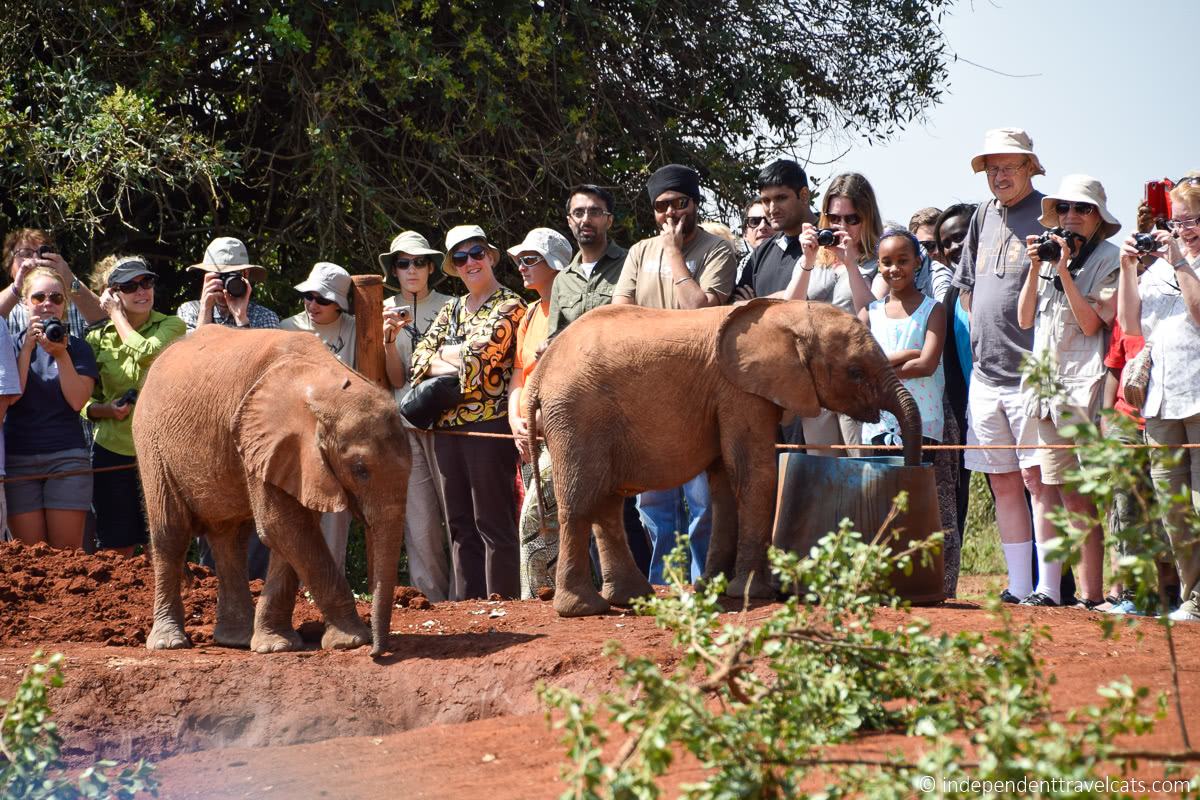
Utamaduni Shops
If you are only going to stop at one place to buy souvenirs and local goods, I’d probably recommend stopping at Utamaduni Shops , also known as Utamaduni Craft Centre. This place has a huge selection of crafts, jewelry, linens, soaps, masks, art, clothing, woodwork, accessories, children’s toys, games, beauty products, and much more.
The first time I visited this place it just had a few small craft and curio shops but it has grown a lot and now offers a bit of everything. There are a few shops located outside, but most of the items are inside now. I was pretty surprised at how big the indoor part of the shop has become.
They also offer a lot of items from other popular shops in Kenya, including a good selection of jewelry from Kazuri Beads. This makes Utamaduni a good one-stop place to get local goods and souvenirs if you have limited time. Prices are set and marked so you don’t need to bargain like at the markets and many of the souvenir shops.
There is also a nice cafe and restaurant here with an outdoor seating area where you can enjoy a meal or just a coffee. There is also a little play area for kids in the garden.
Utamaduni Shops is located in the Langata area of Nairobi and is a convenient place to stop if you are in this area visiting places like the Giraffe Centre, Sheldrick Wildlife Trust Elephant Orphanage, and the Karen Blixen Museum.
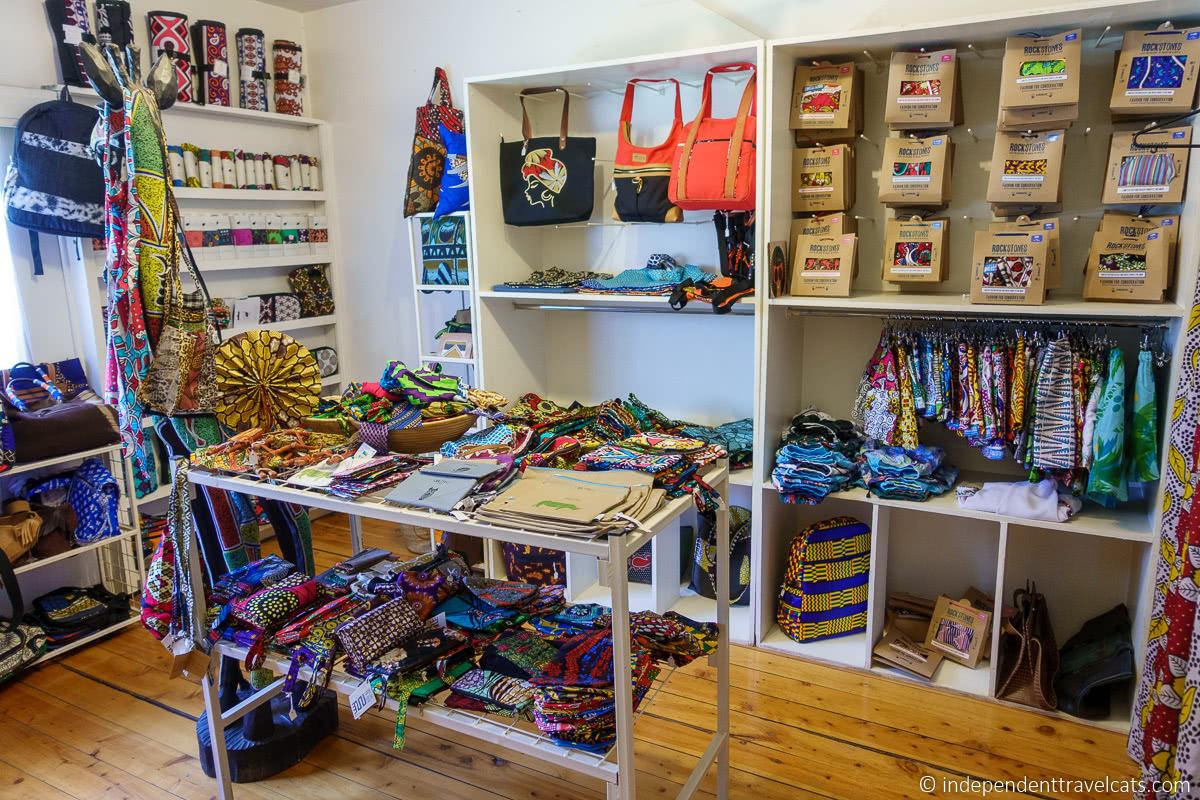
Carnivore Restaurant
Carnivore is by far the most well-known restaurant in Nairobi and has become a popular tourist destination. It was opened in Nairobi in 1980 and offers an all-you-can-eat menu that is focused on roasted meats.
The restaurant became famous for serving some pretty unusual and exotic wild game meats, but because wild game meat has since been outlawed in Kenya, all meat served here is now farmed. So you’ll be offered typical meats like steak, leg of lamb, pork, and chicken, but there are also more unusual meats on offer like ostrich, crocodile, and bull testicles.
Carnivore has an unusual open-air setting with a large charcoal fire pit at one end of the restaurant. After you are seated, you are first served soup and bread. Then comes a tiered platter with a number of different salads and sauces. They also bring you a baked potato each. Then carvers bring around different meats skewed on Maasai swords on a rotating basis to your table. You can continue to eat for as long as you want.
Once you are finished eating, you are asked to admit defeat by lowering a white paper flag at your table. If you are capable of still eating more, you are then served dessert. I believe we had a choice from three different dessert options.
Everything is included in your meal price except your drinks. They offer a variety of soft drinks and alcoholic drinks. The specialty drink at the restaurant is the Dawa, a vodka cocktail invented here and popular across Kenya.
We enjoyed having dinner here and all the food was good except the bull testicles, neither of us could eat those. The ostrich meatballs were a favorite. Just keep in mind that this is a very popular tourist restaurant, with local travelers, international travelers, and tour groups so it is a busy place. We were surprised to see a lot of Kenyans eating here as well. Don’t come here for an intimate meal.
This is a place I’d recommend to meat eaters but not vegetarians. Apparently, there is a vegetarian menu option; however, given the focus on meats here I doubt many vegetarians or vegans are likely to have this restaurant on their itinerary.
The restaurant is located in the Langata area on the same grounds as the Tamarind Tree Hotel . It is open for both lunch and dinner. You can make reservations and we did so. However, it is a big place and normally reservations are not required unless you are part of a large group.
Also located here is the Simba Saloon nightclub and bar which operates on certain nights of the week offering live music. There are often themed musical nights at the nightclub.
A meal at the Carnivore is included in a number of popular tours of Nairobi such as this one which includes lunch at Carnivore and visits the Giraffe Centre and David Sheldrick Wildlife Trust Elephant Orphanage. If you don’t have transportation, there are also a number of options you can book that include pick up at your hotel, your meal, and drop-off back at your hotel.
If you are looking for an alternative to Carnivore, this evening tour might be an option. It includes a dinner buffet at a local hotel focused on nyama choma and a 1 hour dance and acrobatics performance. This place attracts more Kenyans than Carnivore.
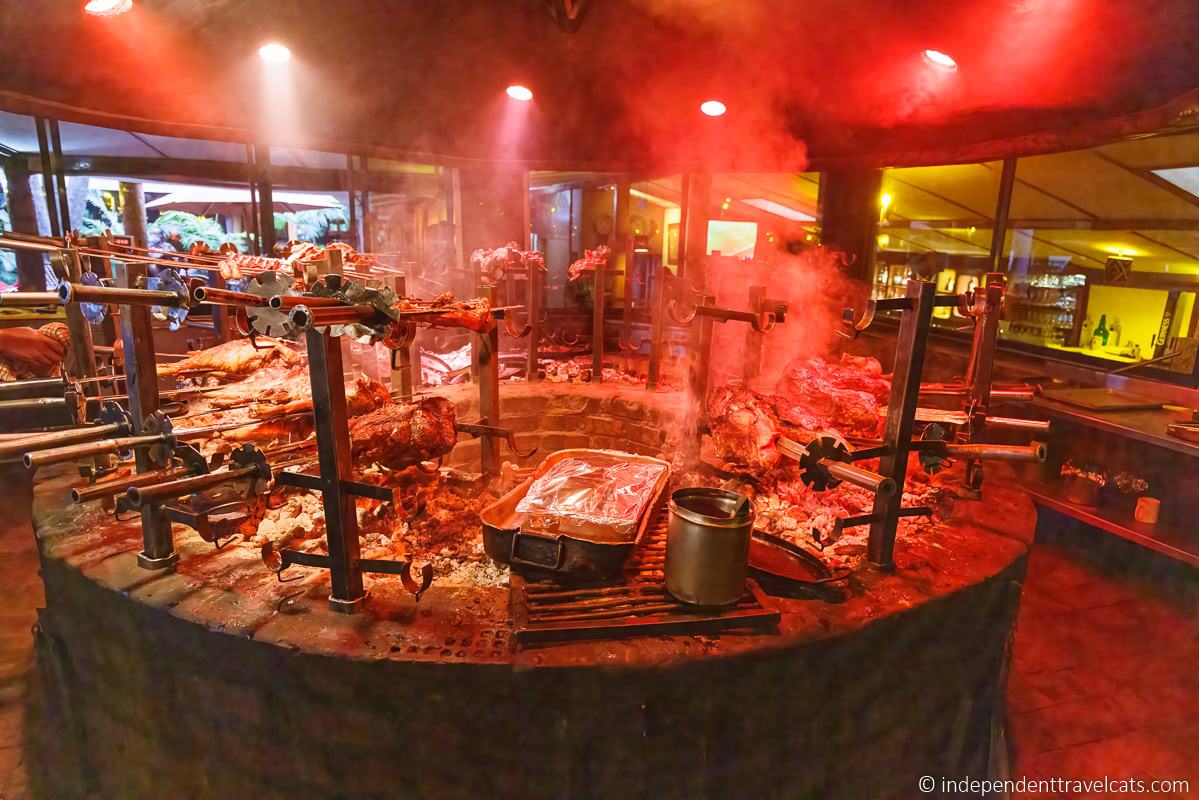
Go Shopping in Nairobi
If you want to shop in Kenya, there is no place better to go shopping than Kenya’s capital city. You have a wide range of shopping options in Nairobi from local craft markets to luxury boutiques. There are shopping malls, local markets, and souvenir and craft shops.
You can easily shop on your own, but if you need transport or feel intimidated by the markets you can also join a guided shopping tour of Nairobi that visits several shops and markets.
Nairobi Markets
There are lots of open-air and indoor markets in Nairobi. Some are formal markets and some are more informal roadside ones. Some markets have a bit of everything but others are focused on something such as fresh fruits and vegetables, secondhand clothing, or curios.
Some of the larger markets in Nairobi are Kariokor Market, City Market (mostly indoor), Gikomba Market (mostly secondhand clothing and accessories), Muthurwa Market, Toi Market, and Kenyatta Market. Some of the markets have Facebook pages or websites, but if not, you can ask a local about where and when to go.
You also have the popular Maasai Markets which are more geared to tourists and mostly carry things like art, crafts, and souvenirs. You can visit a Maasai Market on most days of the week but it moves to different locations. The biggest one in the city center happens each Saturday. See section on the Maasai Markets for more information.
At the markets, streetside vendors, and Maasai markets, haggling or bargaining is common and prices are often not set or marked. So be prepared to haggle on the prices for most goods.
Nairobi Shopping Centers
If you are looking for general shopping, there are a lot of shopping malls and shopping centers in Nairobi, including Yaya Centre, Westgate Shopping Centre, Sarit Centre, Village Market, Prestige Plaza, and The Junction Mall. Most are located in the wealthier suburban areas. Not only do these have a lot of stores and restaurants, but they also usually have supermarkets, banks, salons, pharmacies, movie theaters, and phone services as well.
If you spend any longer amount of time in Nairobi, you will almost inevitably end up at one of the city’s shopping malls whether you need clothes, a SIM card, a haircut, groceries, or money.
We’ve been to three or four shopping malls in Nairobi. These are easy places to shop and are very much like Western shopping malls with lots of stores under one roof, set prices, and security. So a great place for hassle-free shopping if you can’t handle the markets.
But I wouldn’t head to the Nairobi shopping centers expecting bargains. We were surprised by some of the prices in these stores, especially those selling imported clothing and goods. These malls mostly cater to wealthy locals and expats and prices were often similar or higher than what you’d pay in the USA or Europe.
Nairobi Craft & Souvenir Shops
If you are looking for local crafts and souvenir shopping, our top recommendation for a one-stop shopping destination is Utamaduni Shops located in western Nairobi. This place sells lots of crafts and souvenirs and has an onsite cafe. See our section on Utamaduni Shops for more info on visiting here.
Another great option is Spinner’s Web located in northern Nairobi. Spinner’s Web is a great place to go if looking for higher-end crafts and souvenirs from local vendors. They sell handicrafts, pottery, home decor, jewelry, art, fashion accessories, and more. They also have a cafe.
All prices are set at both Utamaduni and Spinner’s Web so no haggling is necessary. We have experienced good customer service at these shops. While you can of course find some of these items for sale at the city markets or other shops, these are convenient places to find them all together and not worry about haggling on prices.
Utamaduni is well-located for those visiting attractions around Lang’ata and Karen. Spinner’s Web is well-located for those staying in the Westlands or northern Nairobi suburbs.

Visit the KICC Rooftop
If you are looking for a view over Nairobi, then we recommend heading to the rooftop of the Kenyatta International Conference Centre (KICC). The KICC is a 28-storey conference center located in the CBD.
The center was officially opened in 1973 and was designed by Norwegian architect Karl Henrik Nøstvik and Kenyan David Mutiso. The building was significant for its design, size, and its use of eco-friendly and locally available materials. At the time, it was the tallest building in Nairobi and one of the largest venues in eastern Africa.
The KICC is no longer the tallest building in Nairobi. The UAP Old Mutual Tower is currently the tallest building in Nairobi and while it does have an observation deck, we don’t think that it is currently open to public visitation.
The KICC is still a leading conference and meeting venue in Kenya. But it also attracts a number of tourists looking for great views from its rooftop. The rooftop is normally open to the public during the opening hours of the KICC, but can sometimes be closed for security reasons and private functions. There is a fee to visit the rooftop which was 500 Ksh when we visited in 2022. You can find out more about current fees and rules here .
To visit the KICC building you need to go through an airport-like security check at the gate entrance. Be sure to bring your passport or photo identification. You can then walk into the building itself.
Once inside the KICC building, you will want to buy a ticket at the Reception Desk for visiting the rooftop. A staff member will then take you to the correct elevator and push in the appropriate floor (or in some cases accompany you to the top). The elevator will take you up most of the way, but you will then need to climb several more flights of stairs to reach the very top.
Be sure to buy your ticket before entering the elevator and to keep your ticket as you will likely be asked for proof of a ticket by security in the stairway or on the roof.
On the rooftop, you will have a great 360-degree view of the Nairobi skyline. There is also a helipad located here on the rooftop. On the clearest days, you may be able to see Mount Kenya and even Mt. Kilimanjaro in the distance!
I’d allow at least 1 hour to visit the KICC rooftop. Although the rooftop is fairly small and can be visited rather quickly, security and getting to and from the rooftop can take longer than expected.
A number of tours of Nairobi that include the CBD area of Nairobi visit the KICC rooftop. You can see a list of guided tour options here .

Nairobi Railway Museum
The Nairobi Railway Museum is a museum run by Kenya Railways that focuses on the history of the railway in Kenya and how the railway shaped the development of Kenya. This museum was opened in 1971 and is a great place to visit for anyone interested in trains or the early history of Nairobi.
The railway played a significant role in the founding and early history of Nairobi. The city was originally just a rail depot set up for the Uganda Railway by the British in 1899. The area around the city was mostly uninhabited swampland but the city quickly grew and it became a major administrative hub. By 1907, Nairobi would replace Mombasa as the capital of Kenya.
In the museum, there is a posted quote by a senior British administrator, Sir Charles Elliot, in 1903: “It is not uncommon for a country to create a railway, but is uncommon for a railway to create a country.”
The museum has both an indoor part and outdoor exhibit area you can visit. The main indoor area details the history of the railway in Kenya from the 19th century to the present and showcases a number of railway and train artifacts, from maps to early push trolleys to claws from the man-eating lions of Tsavo to furniture and objects used by Queen Elizabeth II.
There is also one room that focuses on ships and water transport with a number of ship models. There is a focus on the World War I German cruiser Konigsberg as the museum has several artifacts from the shipwreck.
Outside, you can walk around and see a number of outdoor exhibits that includes various historic train locomotives, coaches, and other rolling stock. This includes the train carriage where the Railway Police Superintendent Charles Ryall was attacked and killed by the man-eating lions of Tsavo during the building of the Uganda Railway (“Lunatic Line”) and a steam locomotive used in the film Out of Africa . Some of the train exhibits are open and you can climb inside for a closer look.
There is also a small art gallery that you could visit and buy local art and souvenirs. There is also a children’s playground area and a mini-train that is sometimes operated for children; however, this area was closed during our last visit.
The Nairobi Railway Museum was probably our favorite museum in Nairobi as it is a nice compact size and we both like trains. The interior galleries are well-labeled in English and the staff were helpful when we had questions; however, many of the outdoor exhibits had minimal signs and information.
The museum is located on Workshop Road off Haile Selassie Avenue near the Kenya Railways headquarters. It is in central Nairobi just south of the CBD area. We did have some issues finding and getting to the museum entrance as our taxi driver dropped us off in the wrong place. We also had to walk through a fenced security area when on foot to reach the museum and sign in and out with passes. But we were guided in the right direction by asking railway staff and guards.
The museum is normally open daily from 8:00am to 5:00pm. There is an entrance fee to visit. You can find out more information by visiting the museum’s Facebook page .
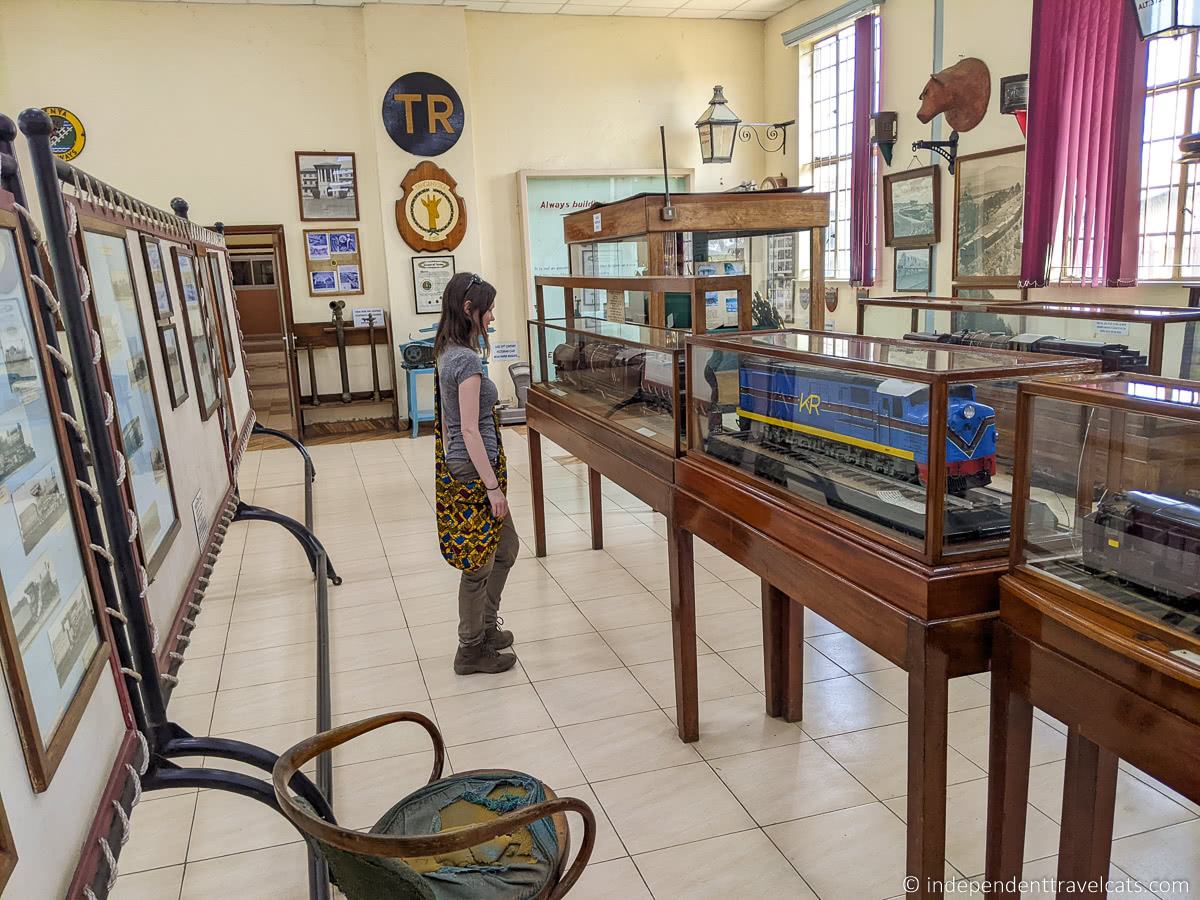
Nairobi Gallery
The Nairobi Gallery is the main art gallery in Nairobi and it focuses on showcasing African art. It is located in central Nairobi near both Uhuru Park and Central Park. In fact, the gallery is located in the exact center as the atrium of the building was used as Point Zero from which the colonial government measured all distances in Kenya.
The building itself is interesting. It was originally built as the Ministry of Native Affairs in 1913. After independence, it became the Provisional Commissioner’s Office. The building was declared a national monument in 1995 and then given to the National Museums of Kenya. After a long renovation period, it was opened to the public as the Nairobi Gallery.
The main collection on display is made up of objects collected by the late Joeseph Murumbi and his British wife Sheila. Joseph Murumbi was a Kenyan politician and the second Vice-President of Kenya, and Sheila was a librarian and passionate collector. The couple amassed a large collection of art, postage stamps, jewelry, African artifacts, books, and other objects. They were co-founders along with Alan Donovan of Africa Heritage Gallery, Africa’s first Pan African gallery which operated globally from 1973 to 2003.
There are 6 main rooms within the gallery. The museum displays an eclectic mix of art and artifacts which includes sculptures, paintings, masks, currency, stamps, weapons, books, textiles, jewelry, photos, furniture, household objects, and more. Also on display are personal items, furniture, and photos of Joseph and Sheila Murumbi.
Parts of the Nairobi Gallery are used to display rotating temporary exhibits of contemporary African art. Some local art and children’s art was also available for purchase. When we visited, there was also a temporary exhibition dedicated to tribal related issues and violence during past elections. The exhibit shared stories from people across Kenya with the goal of promoting peace and fostering cooperation to solve future problems.
We really enjoyed our visit here and would recommend it to anyone interested in both art and African history and culture. Although full of objects, the museum isn’t too big so it’s easy to explore if you just have one or two hours. There is also a tea room on site where you can get coffee, tea, and snacks.
The museum is generally open daily from 8:30am to 5:30pm. There is a fee to visit.
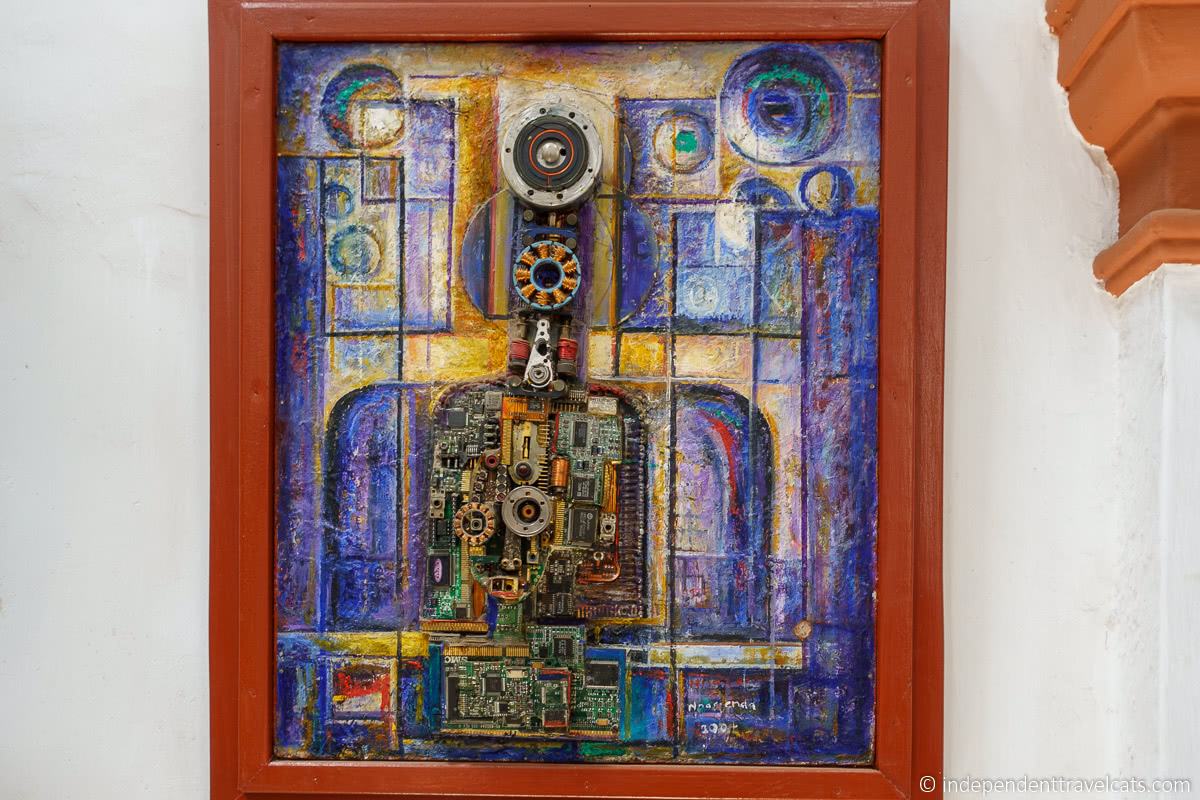
Nairobi City Parks & Gardens
One of Nairobi’s nicknames is “The Green City in the Sun”. Nairobi offers a national park, forests, and a number of city parks and gardens. In this section, we’ll focus on the city’s public parks and gardens.
Nairobi has a number of public green spaces that you can visit, including several within the city center. They are popular places for locals to meet, play, picnic, commune with nature, and enjoy some downtime. They can also be a great place for you to enjoy when you need a break.
Just be vigilant and careful when visiting any of the public parks as they can be an area where pickpockets and thieves are operating. You may want to read recent reviews. We haven’t personally had any issues during the day, but I would recommend avoiding them at night.
The majority of Nairobi’s parks are open to the public and free to visit. However, there may be charges for parking or using specific facilities (toilets, picnic facilities, sports areas) within the park. The parks are normally open to visitors daily during daylight hours.
Note: When we last visited Nairobi in early 2022, parts of Uhuru Park, Central Park, and Uhuru Gardens were all closed for major renovations. So be sure to check before setting out to visit.
Here are some of the major parks and gardens located within Nairobi that you may want to visit:
Uhuru Park is a 32-acre green space in Nairobi’s center and the most popular park in the city. The park has been the site of a number of celebrations and protests. It contains gardens, lawns, trees, a fountain, a Mau Mau memorial monument, and an artificial lake. There are places to get food here as well as take boat rides on the lake.
Central Park
Central Park is located adjacent to Uhuru Park (the two are just separated by a road) in the CBD and is another large green space composed of lawns, gardens, shade trees, and a children’s playground. One of the main landmarks in the park is the Nyayo Monument, a large monument to celebrate former President Moi that was built in 1988.
Jeevanjee Gardens
Jeevanjee Gardens is another smaller green space located in the city center. It was gifted to the citizens of Nairobi by Indian-born Kenyan merchant Alibhai Mulla Jeevanjee in 1903. There is a statue of Jeevanjee in the park.
August 7th Memorial Garden
The August 7th Memorial Garden, also known as the American Embassy Memorial Garden, is a memorial garden located on the former site of the United States Embassy that was destroyed by terrorist bombings on August 7, 1998. The blast killed 218 people (I believe 206 Kenyans and 12 Americans) and injured thousands of others. It is a lovely walled garden with a memorial wall and a small museum.
Unlike the others on this list, there is a small entrance fee to visit the gardens and Peace Memorial Museum. You can find out more about visiting the memorial park here .
City Park is a large 60-hectare public park located in the Parklands area of Nairobi, north of the CBD. The park was first established in 1921 and became a protected area in 2009. It offers nature trails, lawns, picnic areas, a plant nursery, a sculpture garden, and a memorial garden. There is also a restaurant located within the park.
The park has a diverse collection of trees, plants, and wildlife, including portions of intact indigenous forest and a large population of Sykes’ monkeys. There is also a cemetery here where notable people such as Joseph Murumbi (Kenya’s second vice president) and Pio Gama Pinto (Kenyan journalist and politician) are buried.
Museum Botanical Gardens
These lovely botanical gardens are located within the grounds of the National Museum of Kenya. They showcase a number of plants found throughout Kenya and there are different themed areas throughout the garden.
There is also a nature trail here that goes along the Nairobi River. These gardens are free to visit. This is a great garden to visit before or after visiting the National Museum of Kenya.
Uhuru Gardens
Uhuru Gardens is a large memorial park located in western Nairobi in the Langata area. The grounds have historical significance as it is where the first Kenyan flag was raised on December 12, 1963 (Kenya’s Independence Day) and is considered the birthplace of modern Kenya. The gardens were officially declared a National Monument in 1966.
Within the park are a number of memorials and monuments related to Kenyan independence and freedom fighters. A fig tree ( mugumo tree) was planted by President Jomo Kenyatta on the spot where the British flag was brought down and Kenya’s national flag was first hoisted. In recent years, it has become the site of national Jamhuri Day and Madaraka Day celebrations.
This park is currently undergoing major renovations and there are plans by the current government to set up a museum, shopping complex, convention center, hotel, and other attractions within Uhuru Gardens.
Although then President Kenyatta “officially opened” the Uhuru Gardens National Monument & Museum on July 25, 2022, as far as I am aware this museum is still not finished or open to the public yet. So do check before planning a visit (and do leave us a comment to let me know if it has finally opened!).
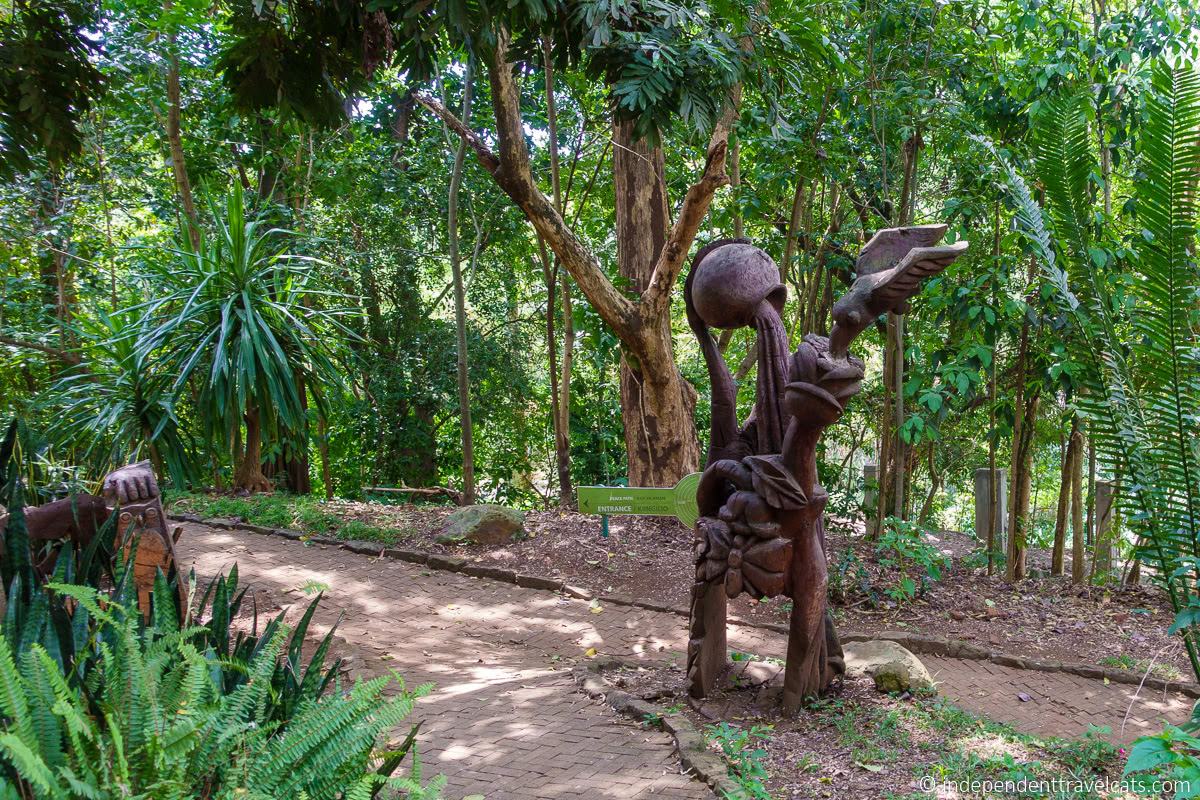
Maasai Markets
The Maasai Markets are probably the most popular markets for tourists to Nairobi to visit. The markets are made up of a number of individual vendors selling their wares. At the markets you will find crafts, art, carvings, clothing, jewelry, fashion accessories, woven baskets, souvenirs, and more.
The Maasai Markets are normally held every day of the week except on Mondays. But they are held in different locations, depending on the day. They are normally held from 9:00am to 6:00pm. You can check the Maasai Market Facebook page which has a lists of the market locations by day.
The last updated schedule of Maasai Market locations and days provided says:
- Monday – no regular markets
- Tuesday – Kijabe Street Park next to Nairobi River & Prestige Plaza along Ngong Road
- Wednesday – Capital Centre along Mombasa Road
- Thursday – The Junction Mall & along Ngong Road
- Friday – The Village Market in Gigiri & Lavington Mall
- Saturday -The High Court parking in the city center & Prestige Plaza
- Sunday -Yaya Centre
However, I would recommend confirming the market location and day before planning a special trip as they do sometimes change locations or are closed for one reason or another. For instance, the COVID-19 pandemic caused a lot of disruption in the markets.
Probably the most popular is the Saturday market in the Nairobi city center located at the High Court parking area opposite Re-Insurance Plaza. This is a great location for those staying in or near the CBD. There is also a second Maasai Market held on Saturdays at Prestige Plaza located in the Kilimani area.
For the Maasai Markets at the Prestige Plaza in the Kilimani area, you can find out more on their website . They are normally held on both Tuesdays and Saturdays.
At the Maasai Markets you are expected to bargain and haggle on the prices. So it is generally not a good idea to accept the first offer. How far to go down and what to offer really depends on the offer, what it is, and how much you are willing to pay. Sometimes the first price we’ve been given is really ridiculous and other times it may be just a little high.
If you have time and are looking for a fairly common item like a beaded bracelet, scarf, or carved wooden elephant, I would go around to various stalls and ask for best prices. You’ll likely get a range of prices and it will help you come up with what is probably a fair price for the item. Then you can have a price in mind of what you are willing to spend.
Laurence hates the process of haggling and leaves it all to me in these situations. If you hate haggling and are unsure of what to offer in these types of situations, consider shopping with a local guide who can help do it for you. Or you can just avoid the markets and head to the fixed price shops instead (see our section on Utamaduni Shops).
If you need transport or want a guide you can consider this guided shopping tour (includes a number of shops and markets), this city tour which includes a visit to the Maasai Markets, or hiring a private driver guide. Just be sure to book the tour on a day when a Maasai Market is scheduled to take place!

Kibera Tour
Kibera is believed to be the largest urban slum in Africa, with an estimated population ranging from 200,000 to 1 million people, depending on the source. Many of the residents of this informal settlement live in poverty and much of the community lacks access to basics like clean water, electricity, and medical care. Unemployment, crime, disease, substance abuse, lack of educational opportunities, and hazards such as floods and fires are major issues here.
Kibera was a forested section of land on the outskirts of the city that was initially allocated as an area for Nubian soldiers by the colonial British government at the start of the 20th century. Kibera means forest in Kinubi. Later it became an area of settlement for rural migrants from different parts of Kenya who wanted to live and work in Nairobi. After Kenya became independent, much of the housing and settlements here were considered illegal.
Everything about Kibera, including its demographics, topography, land ownership issues, and infrastructure are complicated and often dynamic. Kibera is made up of a variety of informal settlements and villages, many divided by tribal affiliations. The government started a long-term clearance project in 2009, but this has brought about limited changes thus far.
It should be noted that although Kibera is the largest slum area in Nairobi, it is not the only one. A large number of people in Nairobi live in informal settlements. A comparison of Kibera with one of the wealthy suburbs such as Gigiri clearly illustrates the huge wealth gap and inequality between Nairobi’s poorest and wealthiest citizens.
The decision to visit Kibera as a tourist can be complicated. There are a lot of issues with so-called slum tourism or visiting impoverished areas as a tourist. There are, of course, safety issues and Kibera is generally a place that tourists are warned against visiting. But there are also ethical issues.
There are both pros and cons to visiting areas such as Kibera, and there is no right answer. Negative factors of slum tourism are that it can be voyeuristic, exploitative of the local people, and may benefit tour operators instead of the local community. Positive factors can be that it can be educational, increase income for local people, drive traffic to local businesses, and increase government investment.
If you decide to visit, we recommend doing so in the most respectful and ethical way you can. This includes choosing a responsible tour operator, visiting with a local guide, visiting on foot, following advice given by the guide, dressing modestly, not taking photographs or making videos of people without their consent, being respectful of people’s private spaces, and considering ways to support the local community (e.g., tips, donations, local purchases).
We don’t recommend visiting Kibera on your own for a number of safety and ethical reasons. A local guide can not only help guide you through this large informal settlement and help you feel more safe and comfortable, but a guide can also make the visit more informative, impactful, and educational.
When choosing a tour of Kibera, we recommend choosing a tour run and led by local residents, where some of the profits are used to help the community, and one that has good reviews. Two tours you might consider are this tour and this one . Both tours are led by Kibera residents and we were told some of the profits go to investing in projects in Kibera. Obviously, you can only do so much research on Kibera tours, but reading the reviews can help.
We chose to visit Kibera on a tour in 2022 after not visiting on prior visits as I was conflicted about doing so. I am glad we chose to do so as it was overall a positive experience and we learned a lot about Kibera.
We were picked up by two guides at a local shopping center as arranged, and then we went to Kibera by taking a matatu . Once in Kibera, we spent most of the time walking around the different parts, stopping to learn about different aspects of the settlement, its history, and what is happening today. We saw homes, businesses, a sports field, a hospital, the train tracks, and schools as we walked along. We had a lot of time to ask questions and our guides were happy to answer them.
At the end, we stopped at a school that is run by the Seed Foundation (who ran the tour), toured the school and learned about it and its struggle for resources. We also saw a brief song and dance performance by the older children. At the end of the tour, we got into a matatu with the guides and returned to the shopping center where we started.
We felt safe and comfortable throughout our tour. There is a lot of rubbish and open sewers so some areas can be a bit smelly. Locals seemed to pay little attention to us but were friendly when we spoke to them. Our tour did not include going into people’s homes or businesses (except the school) or any food, but some tours do this.
Kibera tours normally take place in the mornings, are between 3 and 5 hours in total, and involve a lot of walking. We recommend being prepared for a few hours of walking and wearing comfortable clothes and shoes that you don’t mind getting a little dirty. Leave your valuables at home. Bring water, sun protection, and cash for tips and any purchases.
If you are looking to see a different side of Nairobi, a Kibera tour is definitely something to consider doing on your visit. If you are looking for something similar but don’t want to head out to Kibera, this tour of the downtown is led by former street children and gives good insight into another side of Nairobi.
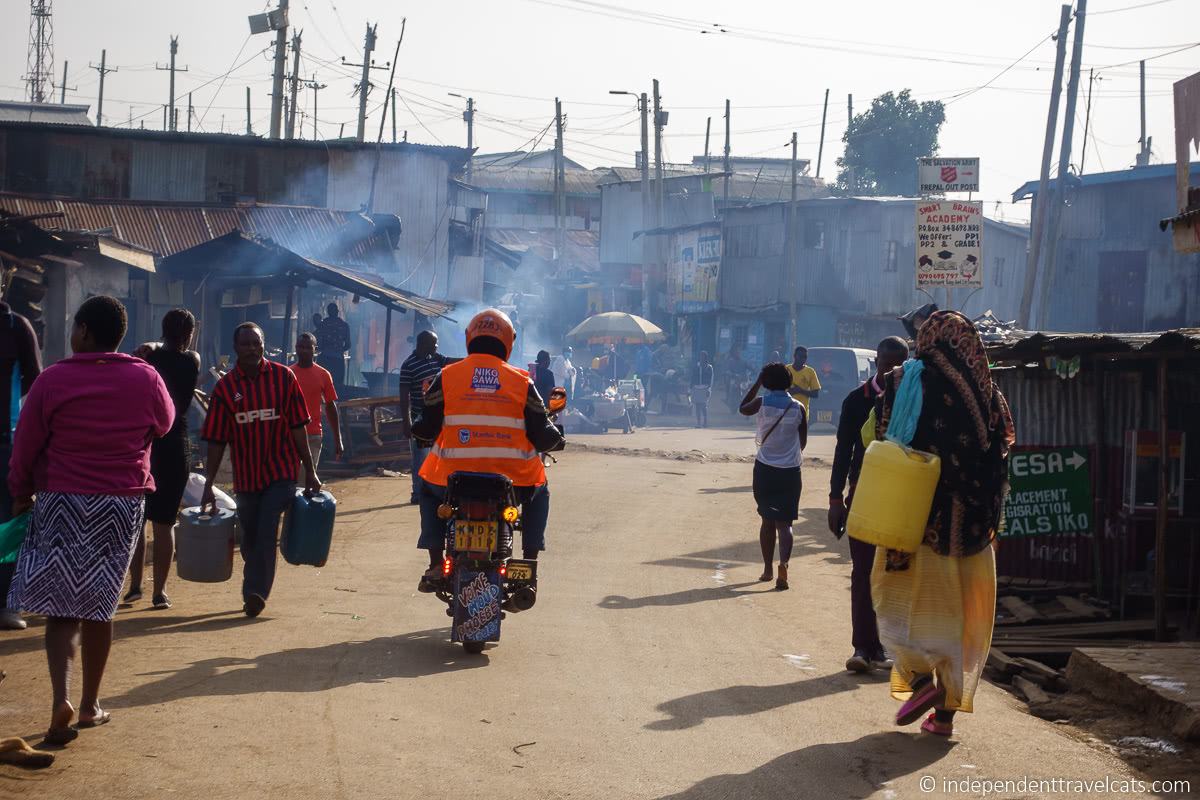
Government Buildings & Landmarks
If you do a city walking or driving tour of central Nairobi, you are likely to see a number of Nairobi’s government buildings as many of these serve as city landmarks. Many of these are important for architectural, historical, and/or cultural reasons. Many of these buildings can also be seen from the KICC rooftop (see section on the KICC), which is a good place to get a good view over the city.
Most of these landmarks are not open to tourist visits (without prior arrangement) with the exception of the gallery in the Kenya National Archives. The Archives is the only one that you’ll likely to actually visit, but you are likely to notice a number of these buildings.
Note that photography around many government buildings is prohibited. If in doubt, always check with an attendant or security guard. Some locations have signs posted but this is not always the case.
Here are a few of them, all located in the city center of Nairobi:
Parliament Buildings
The Parliament of Kenya is where the national legislative body of the government meets. Kenya has a bicameral legislature with two houses: the Senate (upper house) and The National Assembly (lower house). The buildings were constructed in 1954 and were designed in a similar style to the UK Parliament with a clock tower similar to the Elizabeth Tower (Big Ben) in London.
It is possible to get permission to visit the Parliament, but your visit must be arranged in advance. You can find out more here .
Mzee Jomo Kenyatta Mausoleum
The mausoleum, located next to the Parliament, is where the body of Kenya’s first president Mzee Jomo Kenyatta lies. He died on August 22, 1978 of a heart attack and his body was preserved and laid to rest here. There is a commemoration ceremony here at the mausoleum on August 22 each year.
The mausoleum is rarely open to the public without prior permission and is generally only open to local and foreign dignitaries. It is surrounded by fences and heavily guarded. We were walking outside and stopped outside the gate to look at it from afar and a guard came over to ask us to move on.
Kenya National Archives
The Kenya National Archives was established in 1965 and is located in the city center of Nairobi. In addition to holding the national archives (which require permission to visit), it also has a public gallery exhibiting African art and artifacts.
The gallery features an eclectic exhibition of art and objects from across Africa. Most of the objects were part of the large art and book collection owned by Joseph and Sheila Murumbi (part of their collection is also on display at the National Gallery).
The National Archives are definitely worth a quick visit to see the collection. I’d allow about 1 hour to visit. However, if you are trying to choose just one museum to visit while in Nairobi, I’d recommend the Nairobi National Museum over this one.
The Kenya National Archives gallery is open to the public and there is a small fee to visit the exhibition. It is normally open to the public from 8:00am to 5:00pm Monday to Saturday. The Archives are closed on Sundays.
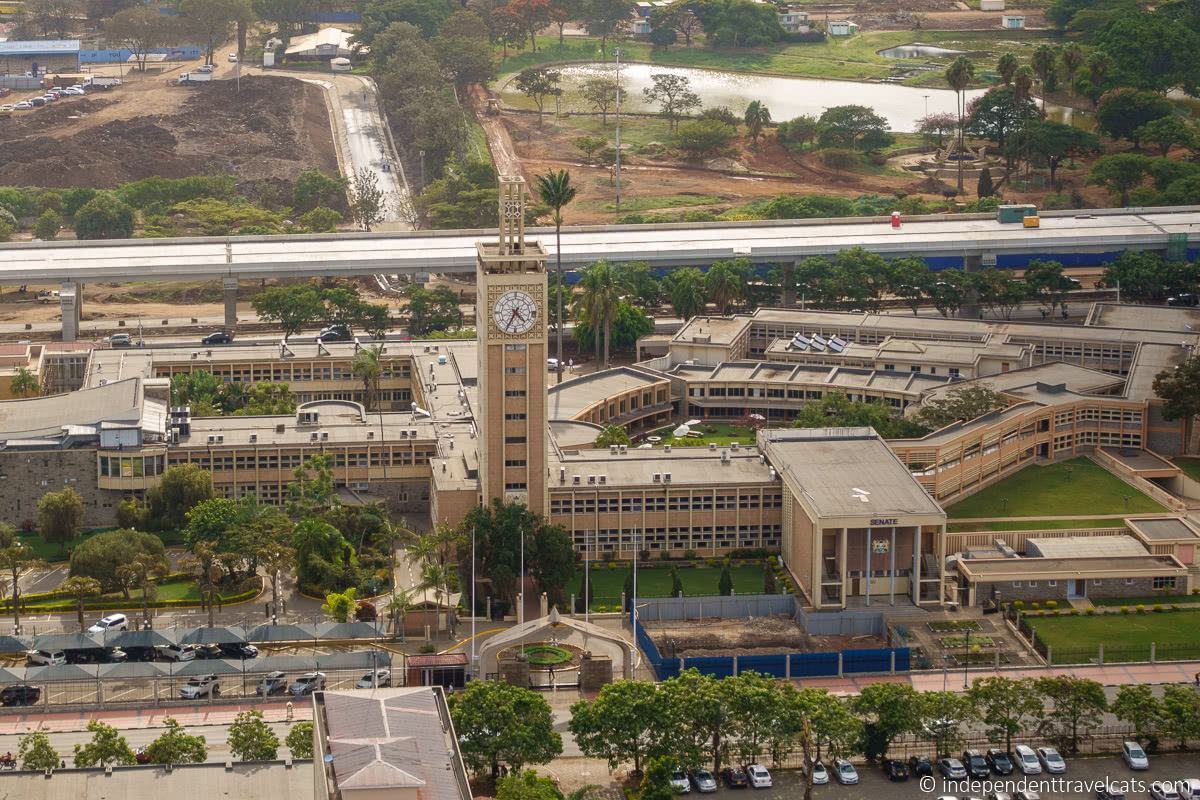
Religious Buildings
The majority of Kenyans identify as Christians with Islam being the second-largest religion in the country. In Nairobi, you’ll find many of the country’s important religious buildings for a number of faiths.
Note that some of the religious buildings in Nairobi are not open to public visits, but do welcome members of the faith who would like to pray or join religious services. So I would check ahead if you are interested in visiting or attending services at any of them.
Most religious buildings also have dress codes for visitors and worshippers. Many require modest clothing and some require head coverings.
Here are just a few of the more important religious buildings in Nairobi:
Holy Family Basilica
This Roman Catholic cathedral and basilica is dedicated to the Holy Family and is located in the CBD. The building dates back to 1904 and was the first stone building in Nairobi. It has expanded in size over the years. The interior was re-designed in the 1960s by architect Dorothy Hughes and features modernist styling and beautiful abstract stained glass windows.
The Holy Family Basilica is currently the seat of the Archdiocese of Nairobi and the largest church in Kenya.
All Saints’ Cathedral
The All Saints’ Cathedral is an Anglican cathedral located next to Uhuru Park in central Nairobi. Although the first Anglican service in Nairobi dates back to 1900, the current church building was only finished in the 1950s. It is the current home of the Archbishop of the Anglican Church of Kenya.
Jamia Mosque
The Jamia Mosque was completed in 1906 and was founded by Syed Maulana Abdullah Shah. It is the most known and important mosque in Kenya, and is often busy and full or worshippers. There is also an Islamic Centre and book shop located here.
Another important mosque is the Khoja Mosque which dates back to 1922. Both mosques are located in central Nairobi.
The Jamia Mosque normally welcomes visitors (subject to security screening) during regular hours. However, entry is sometimes restricted due to security or health (e.g., COVID-19 pandemic) issues.
East Africa Swaminarayan Satsang Temple
This Hindu temple was built in Nairobi in 1954 and is located in the Parklands area of Nairobi (north of the CBD). It was the first Swaminarayan temple to be built outside the Indian subcontinent.
Located nearby is another important Hindu temple in Nairobi, the BAPS Shri Swaminarayan Mandir. This impressive building was built in 1999 and was the first traditional stone and marble Hindu temple to be constructed in Africa.
Hindu temples are typically open to visitors during posted daily visitor hours. Be sure to check visitor hours and guidelines before visiting.
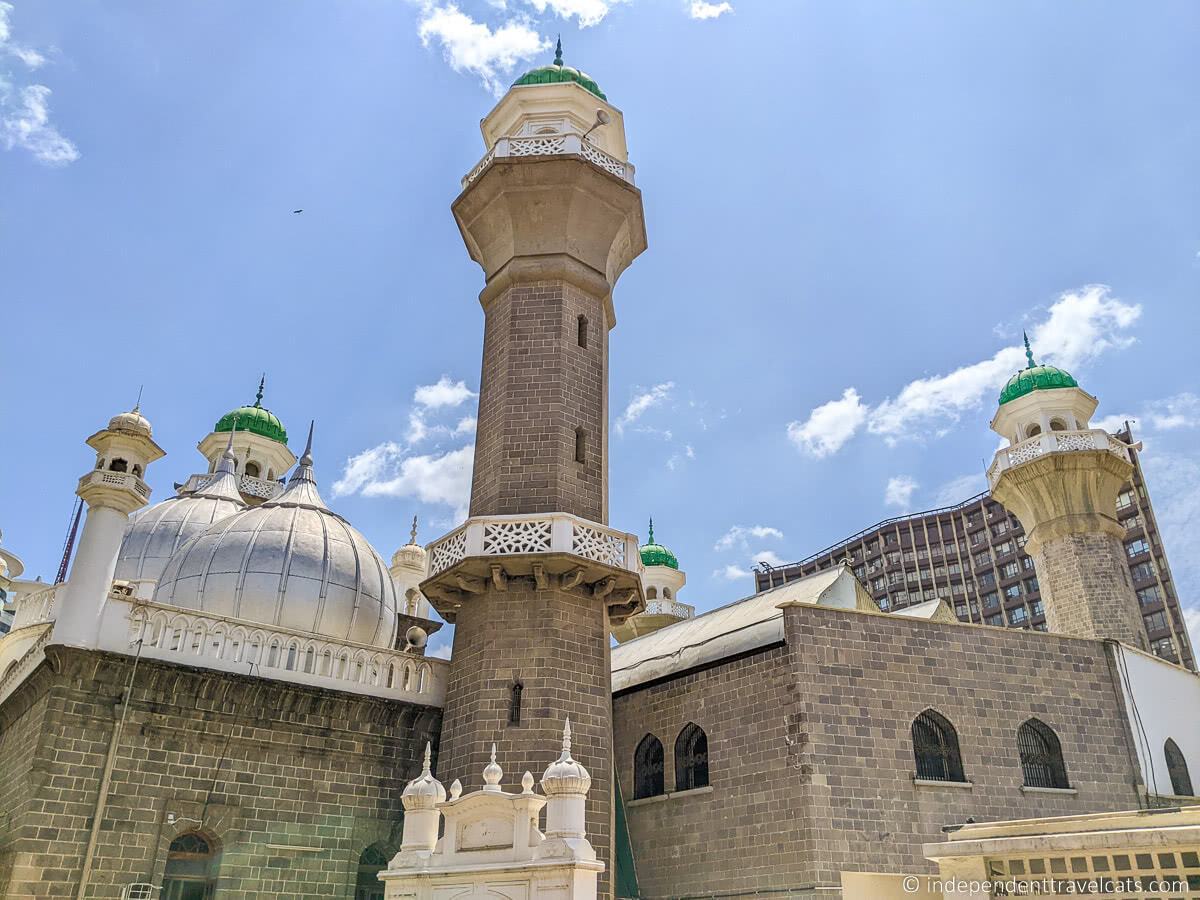
City Market
The City Market is an indoor market located in the center of Nairobi. So a great market to visit if looking for a market located within the CBD.
The City Market caters to both tourists and locals. On one side the City Market houses a number of vendors selling crafts, art, clothing, carvings, curios, souvenirs, etc. from individual stalls. You will want to bargain on prices here.
On the other side is an area where vendors are selling fresh meat, seafood, and other food and grocery offerings. The market is also a popular place to buy fresh flowers. There are also stalls selling cooked food, such as nyama choma (grilled meats).
The building itself is worth checking out for its architecture. It is one of the older buildings in Nairobi, built in the 1930’s in the Art Deco style, and has an interesting exterior and ceiling.
We enjoyed our visit here but you do need to be prepared for vendors coming up to you to try to lead you to their stalls and for haggling over prices. But you can find many of the same things offered at the Maasai Markets and craft markets here. Prices were low here when we visited as we were the only foreign visitors in the market at the time.
The market is located on Muindi Mbingu Street in downtown Nairobi. Since most of the stalls are covered and located inside the building, the City Market is a good market to visit no matter what the weather. The market’s main hours are usually 9:00am to 5pm Monday to Friday with an early noon closure on Saturdays. Most of the market is closed on Sundays.
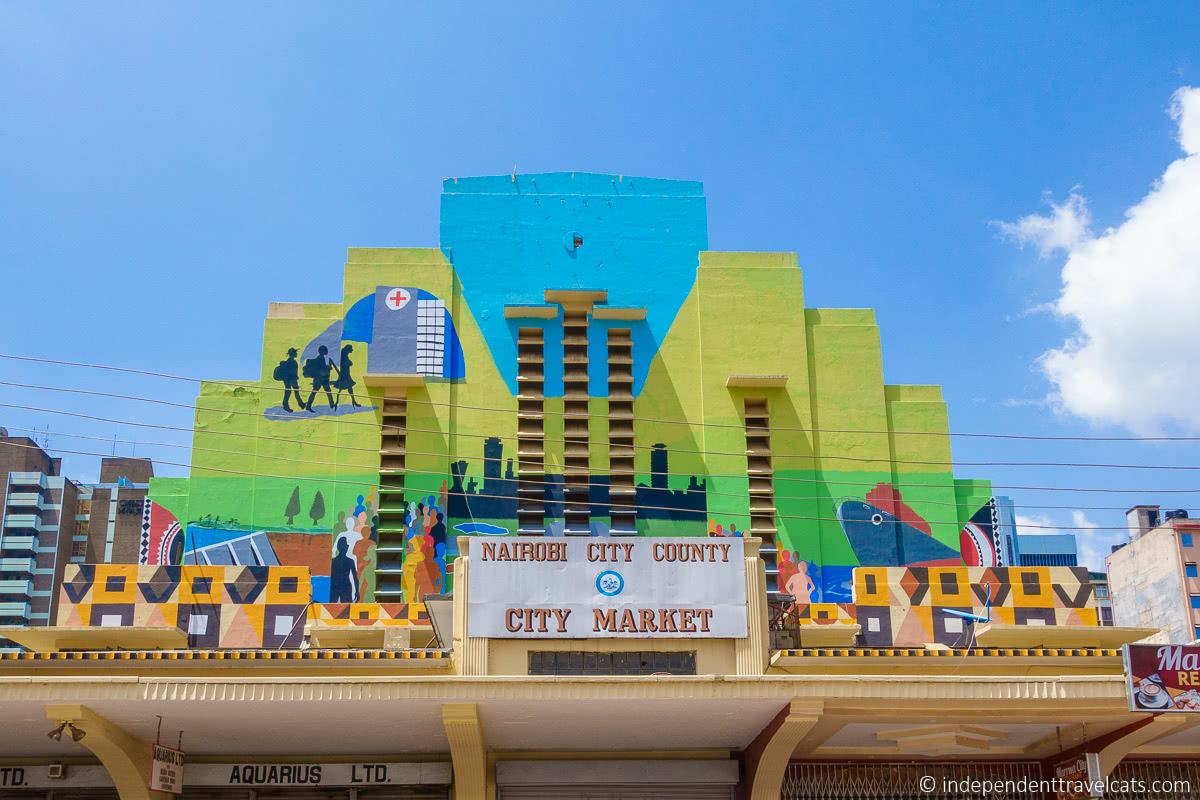
Thorn Tree Cafe
Located at the historic Stanley Hotel in central downtown Nairobi, this bistro-style café was the first “pavement café” in Nairobi. It is most famous for the large Naivasha thorn tree ( Acacia xanthophloea ) that once stood here that was used as a post office and message board. Travelers used to leave messages to others on the tree’s thorns.
You can still leave “tree mail” here but you need to pin it to a message board rather than the tree itself. The current tree, planted in 1997, is the third one that has been placed here. Not that there is not always paper, pins, and pens here, so you may want to come prepared with your note and a push pin if you really keen to leave a message.
The famous message tree served as the namesake for Lonely Planet’s online forum which was a popular place for travelers to ask questions, get information, and find travel companions since it was started in 1996. It was the longest-running and most popular online travel forum. Sadly, the Thorn Tree forums and travel community shut down in 2021.
Although the Thorn Tree Cafe is not a must-see place to visit in Nairobi, I wanted to include it in this article because of its historical significance among travelers. The cafe serves breakfast, lunch, and dinner. We particularly recommend it for lunch or as an afternoon coffee stop for those in the Central Business District. We last visited in 2022 and although service was a bit slow, our pizza and drinks were very good.
If you are looking for a nice hotel in the city center, we’d also recommend considering staying at The Stanley Hotel (currently the Sarova Stanley). It is the oldest hotel in Nairobi, dating back to 1902, and has a significant place in the history of Nairobi. Notable guests have included Ernest Hemingway, Winston Churchill, Clark Gable, Gregory Peck, Grace Kelly, and Sean Connery.
The hotel bar, The Exchange Bar, is also worth a visit if you are looking for a drink or cigar. This bar (originally known as the Long Bar) has had many famous patrons and was the first place that Tusker beer was served. Interestingly, it also served as the location for the first Nairobi Stock Exchange and stocks were traded here for many years.

Karen Blixen Museum
The Karen Blixen Museum is housed in the farmhouse where Danish author and coffee farmer Karen Blixen (pen name Isak Dinesen) lived from 1917 to 1931. The 19th-century bungalow-style house was built in 1912 by Swedish civil engineer Åke Sjögren. It was purchased in 1917 by Karen and her husband Baron Bror von Blixen Fincke. They bought a total of 4,500 acres of land for their farm and coffee plantation.
Neither Karen Blixen’s marriage nor her coffee plantation were successful. She was forced to declare bankruptcy and leave Kenya in 1931. She returned to Denmark and wrote several books, including Out of Africa in 1937 where she writes about her time spent in Kenya. The suburb around her former estate, Karen, is still named after her.
Her house eventually became the property of the Kenyan government after independence and was opened as a state museum in 1986, following the success of the film Out of Africa (1985), starring Robert Redford and Meryl Streep. The popularity of this film not only increased interest in Karen Blixen, but increased tourism to Kenya as a whole. Guided house tours are offered daily that detail the history of Blixen’s time here.
The tour includes a tour of the interior of the house, the detached kitchen, and a small portion of the grounds including some 20th century coffee farming equipment. The house includes some of the original furniture and other objects that belonged to Blixen, including her famous cuckoo clock. Although the house was not used in the filming of Out of Africa , some of the costumes and movie props are on display here.
The house has a lovely location and Blixen referred to the house as Bogani or Mbogani, meaning a house in the woods. If you are familiar with the first lines of Blixen’s novel “I had a farm in Africa, at the foot of the Ngong Hills”, you’ll be pleased to note that there are still some good views of the Ngong Hills from here.
The tour lasts about 40 to 45 minutes and then visitors are allowed to explore the grounds and the small gift shop on their own. Photography is not allowed inside the house.
I’ve visited the Karen Blixen house museum twice and both times the guides were very good at presenting information and answering questions. The house is interesting to see, especially if you have read the book as so many of the experiences Blixen wrote about happened inside this house or just outside of it. However, if you haven’t read the book or you are not a fan of Blixen, this is probably a place to skip.
The Karen Blixen Museum is generally open daily from 9:30am to 6:00pm. You want to allow at least an hour for the visit as the tours take about 45 minutes. But I’d say 1.5 hours is a good amount of time to allow for the guided tour and unhurried exploration of the grounds and gift shop.
A nearby spot to eat is the Karen Blixen Coffee Garden , which offers both indoor and outdoor dining. Also located here are two historic buildings, one is the Swedo House (the original farmhouse built on the coffee estate) and the Grogan MacMillan Manor House, which was owned by Karen’s friend Lady MacMillian. The outdoor seating area is great place for lunch.
A number of tours include a stop at the Karen Blixen Museum, such as this full day tour that also visits the Giraffe Centre, Elephant Orphanage, Kazuri Beads, and Karen Blixen Coffee Gardens. You can see some options here and here .
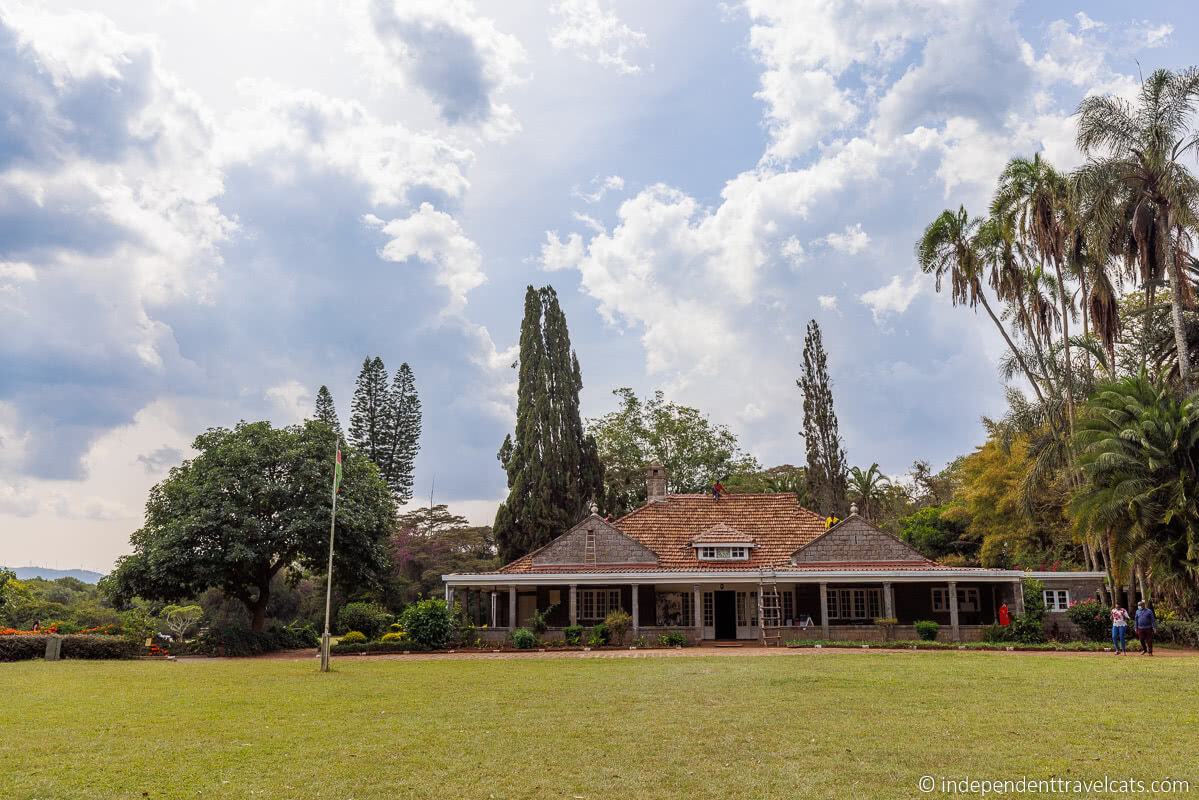
Kazuri Beads Factory & Shop
Kazuri Beads is a business that makes colorful handmade ceramic beads used for jewelry. It started in 1975 when Lady Susan Wood employed two local single mothers and taught them how to make ceramic beads. The word kazuri means “small and beautiful” in Swahili.
The ceramic bead business was successful and expanded, allowing for the employment of a larger number of single mothers and other disadvantaged workers. Today, over 300 women, many of them single mothers, work at Kazuri. The company sells wholesale handmade beads, bead jewelry, and handpainted pottery. The factory has been Fair Trade certified.
At Kazuri Beads you can do a free guided factory tour and visit their factory store. The factory tour takes you through the whole process of how the ceramic beads and pottery are made, from sourcing the clay to molding, drying, firing, hand painting, glazing, etc. You get to see the various workshops, meet some of the workers, and see the process of making some of the beads and pottery pieces. The tour takes about 30 minutes or so. Definitely worth doing if you have the time.
After the tour, you are then invited to visit the shop where you are left to browse and shop on your own. The shop offers a range of handmade ceramic items, mainly necklaces, bracelets, tableware, drinkware, and ornaments.
I have purchased Kazuri Beads jewelry for both myself and as gifts at the factory store. They had a huge selection of jewelry with beads in just about every size, shape, and color so it was easy to find something that appealed. On my last visit, I was specifically looking for a necklace with flat red beads to replace one that broke and was able to find a very good match. It is now one of my favorite necklaces.
Kazuri Beads was hit hard by COVID-19 as it closed down and many of the workers were laid off during the closure and then was slow to rebound due to a huge dip in tourism. But luckily Kazuri has survived and has rebuilt and reopened in a new location. So if you visit, be sure to show your support.
Note that your guide or driver may give you a choice of which factory or shop you want to visit in the area (a few are now in the area), but if you want to go to Kazuri be sure to specifically note you want to go here. It is now in a new location and is not the same as KobeTough (a new business). The previous location used for its factory and shop was sold to Sandstorm Kenya (luxury leather company) and another similar company KobeTough (beads and leather) opened in the area in 2020 and makes similar products with former employees. But luckily Kazuri has survived and has rebuilt and reopened in a new location.
Kazuri Beads factory and shop is located on Laganta Road. There is also a small restaurant/cafe here where you can get coffee, tea, drinks, and lunch.
Kazuri Beads factory is located in the Karen area of Nairobi and is about a 10 minute drive from the Karen Blixen Museum and estate. You can also buy Kazuri Beads jewelry at other retail locations (mostly at Nairobi shopping malls) and other gift and souvenir shops in Nairobi (including at Utamaduni Shops).
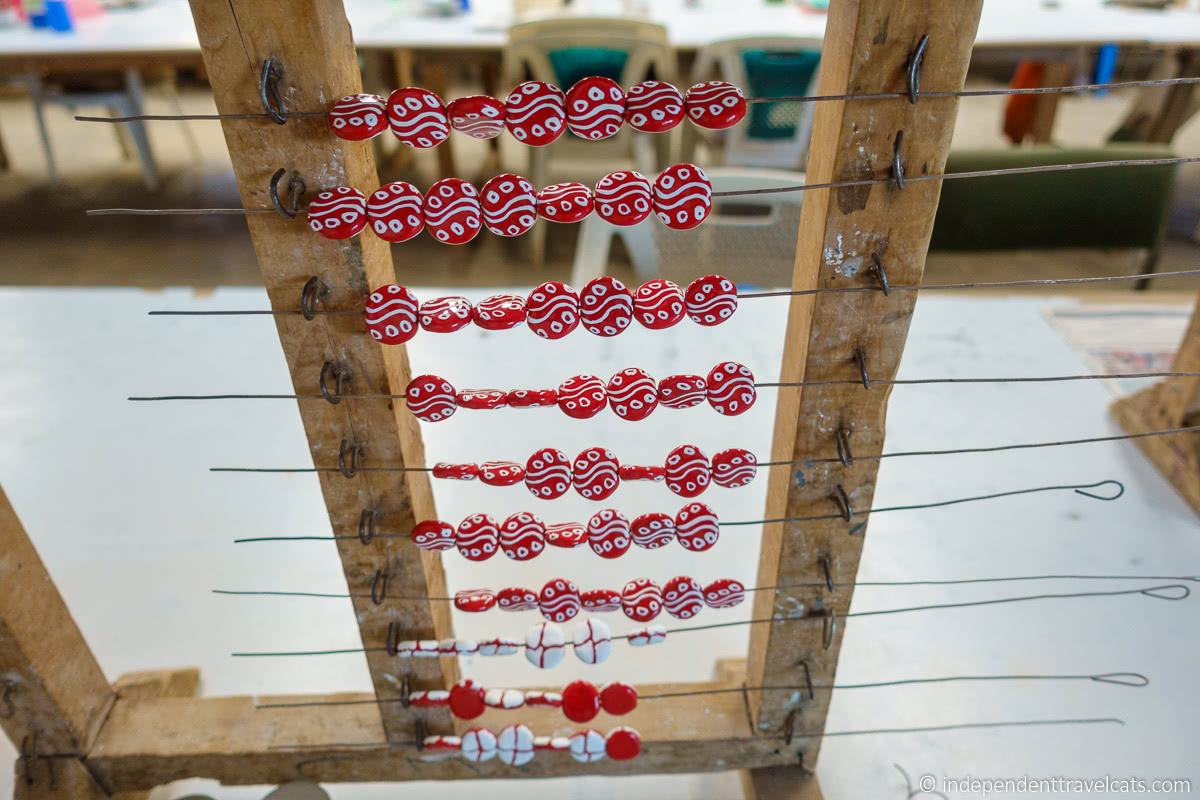
Bomas of Kenya
The Bomas of Kenya is a great place to visit if you are interested in cultural performances and seeing traditional homes from around Kenya. The Bomas of Kenya was established in 1971 by the Kenyan government to both preserve traditional cultural practices and increase tourism. Here you’ll find examples of traditional bomas from around 40 different cultural groups, daily cultural performances, a conference center, a restaurant, and a gift shop.
The first main attraction here is the bomas themselves. Boma in Kiswahili means “homestead” and there are bomas representing around 40 different ethnic/cultural groups from around Kenya.
Different tribes and groups from all over the country were invited to build replicas of traditional “mini villages” here so visitors could learn more about their traditional homes, building methods, and culture.
The bomas are in an open-air setting and you can walk around and explore them with a guide or on your own. Some of the many tribes and cultural groups represented here are the Kisii, Kikuyu, Meru, Somali, Turkana, Maasai, and Luo.
The Luo village may be of particular interest to some Americans as it was the tribe of former President Obama’s Kenyan father. A guide can be helpful in pointing out the differences as it can be difficult to spot some of the differences as some of the bomas are pretty similar.
The second main attraction for visitors are the cultural performances that take place at the large indoor circular theater here. Since 1973, the Bomas has been the home of Kenya’s national professional dance company, the Bomas Harambee Dancers.
The performances vary, as they have a repertoire of about 50 different acts, but the show includes several different acts representing different cultural groups. Each group is introduced and a little history is given about the dance, music, or instruments. Many of the dances are done as part of a tribal ceremony such as celebrating a circumcision, harvest, or birthday.
When we visited there were a variety of dance, music, percussion, and acrobatic acts. There were 9 acts in all and these represented the Borana, Agikuyu, Embu, Nubi, Luo, Maasai, and Bukusu groups and there was also a percussion performance and an acrobatic show. We enjoyed the variety and one of the groups also involved audience participants.
The performances are normally daily in the afternoons from 2:30pm to 4:00pm on weekdays and 3:30pm to 5:15pm on weekends and holidays; however, we recommend checking the performance dates and times online before you head here. The attraction is normally open each day from 10:00am to 6:00pm. You can buy tickets on-site in person.
Note that the Bomas are often the site used for the national elections tallying and announcements so are often closed to the public for a few months during presidential election years for security reasons as they did in 2022. So do be sure to check if visiting on an election year.
Of all the main tourist attractions in Kenya, this is one that seems to draw more Kenyans than foreign tourists. If you visit on a weekend, like we did, you’ll likely find the auditorium pretty full of local school groups, university students, conferencegoers, and other groups from around Kenya. There was also a smattering of fellow tourists and some local families.
The Utamaduni Restaurant located here is a great place to try traditional Kenyan food. It offers dishes from around Kenya’s different regions at reasonable prices. You can find foods here that are difficult to find at hotels and tourist restaurants.
We’d recommend allowing about 3 hours for your visit here. The performances take about 1.5 hours and you’ll want at least an hour for exploring the bomas. If you want to eat at the restaurant as well, I’d add a little extra time. You can easily spend the full afternoon here.
If you need transport, you can arrange for a private tour like this one that includes transport and a guide.
The Bomas of Kenya is located in the Langata suburb of Nairobi, making it easy to combine a visit with other nearby attractions. There are a number of tours that include a visit to the Bomas of Kenya, such as this tour which includes visits to the Giraffe Centre, Elephant Orphanage, and Bomas. You can see more tour options here and here which include a visit to the Bomas.
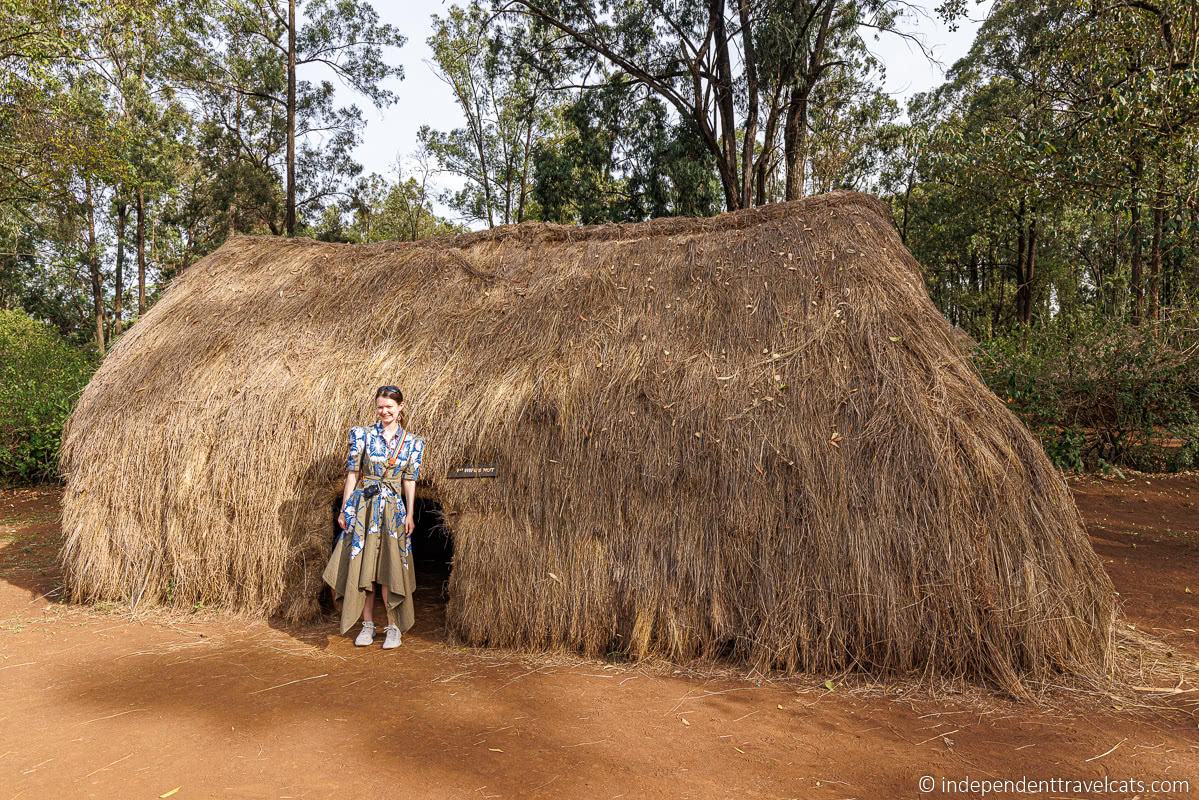
Try Local Foods
We highly recommend trying some of the local dishes while in Kenya. As the capital city, Nairobi is a great place to try different dishes from around Kenya and the wider East African region.
Here are just a handful of the foods you might want to try while in Kenya: ugali (maize flour porridge, a staple food across East Africa), chapati (flat bread), nyama choma (grilled meats), githeri (beans and corn), mahragwe (beans and rice), kachumbari (fresh tomato & onion salad), nduma (stewed arrowroot), matoke (green plantain stew), pilau (spiced rice), kuku choma (BBQ chicken), supu (soup), mtuzi wa samaki (tilapia fish in coconut curry sauce), mandazi (fried bread, doughnuts), tsiswa (roasted termites), viazi karai (potato nuggets), vibibi (coconut and rice pancakes), and mukimo (mashed potatoes, corn, and pumpkin leaves).
Note that the names and spelling vary in different regions as do the recipes. Some of these foods are typical across East Africa whereas others are more regional. What is on offer on local menus will also change by season and the region of the country. For example, along the coast such as in Mombasa, you’ll get a lot more fish and seafood as well as more Indian influenced dishes.
If you are looking to try popular drinks in Kenya, we’d recommend trying Kenyan tea (chai) and Tusker beer. Another popular Kenyan beer, and the favorite of one of our guides, is White Cap and it is produced by the same company that makes Tusker.
It can be difficult to try a lot of local dishes as many hotels and safari lodges in Kenya tend to primarily serve Western dishes. Many restaurants serve a number of European, American, or Indian dishes, but traditional Kenyan food can sometimes be tricky to find for tourists.
One thing we found is that a lot of common Kenyan meals don’t include any meat or fish but have a lot of vegetables, legumes, and grains. For example, a common everday meal is githeri, which is a stew of beans and corn. Most Kenyans cannot afford to eat meat everyday.
If your hotel doesn’t offer local dishes, I’d ask hotel staff, guides, or drivers for suggestions for places that serve good Kenyan food that they would recommend. They should be able to point you to places with safe cooking practices. It is fun to be adventurous, but you want to keep water and food safety in mind when choosing where to eat and what to eat so you don’t regret it the next day.
If you are not sure where to go and aren’t getting any good suggestions, a few restaurants that you may want to consider which focus on Kenyan food are Amaica in the Westlands, Utamaduni Restaraunt in L’angata, and the budget-friendly Hot Dishes which has a few locations in the Central Business District of Nairobi.
Utamaduni Restaurant is located at the Bomas of Kenya and serves Kenyan dishes from the many different regions of the country. If you are already planning to visit the Bomas, this is a very convenient option for lunch or dinner before or after your visit.
A second suggestion is to ask at your hotel if they are able to make local dishes on request. Normally, this requires asking a day or so in advance. For instance, we stayed at Nyati Hill Cottages and here they allow you to choose if you would like evening meals cooked for you or not. We chose to have our evening meals there and the local cook made us a typical Kenyan meal on our first night based on our request.
Finally, another fun option is to join a local food tour, such as this one . This not only allows you to try a number of Kenyan dishes with the help of a local, but it is also an interactive experience where you will learn a bit about Kenya’s food history. Just be sure to go hungry as you will eat a ton on the tour!
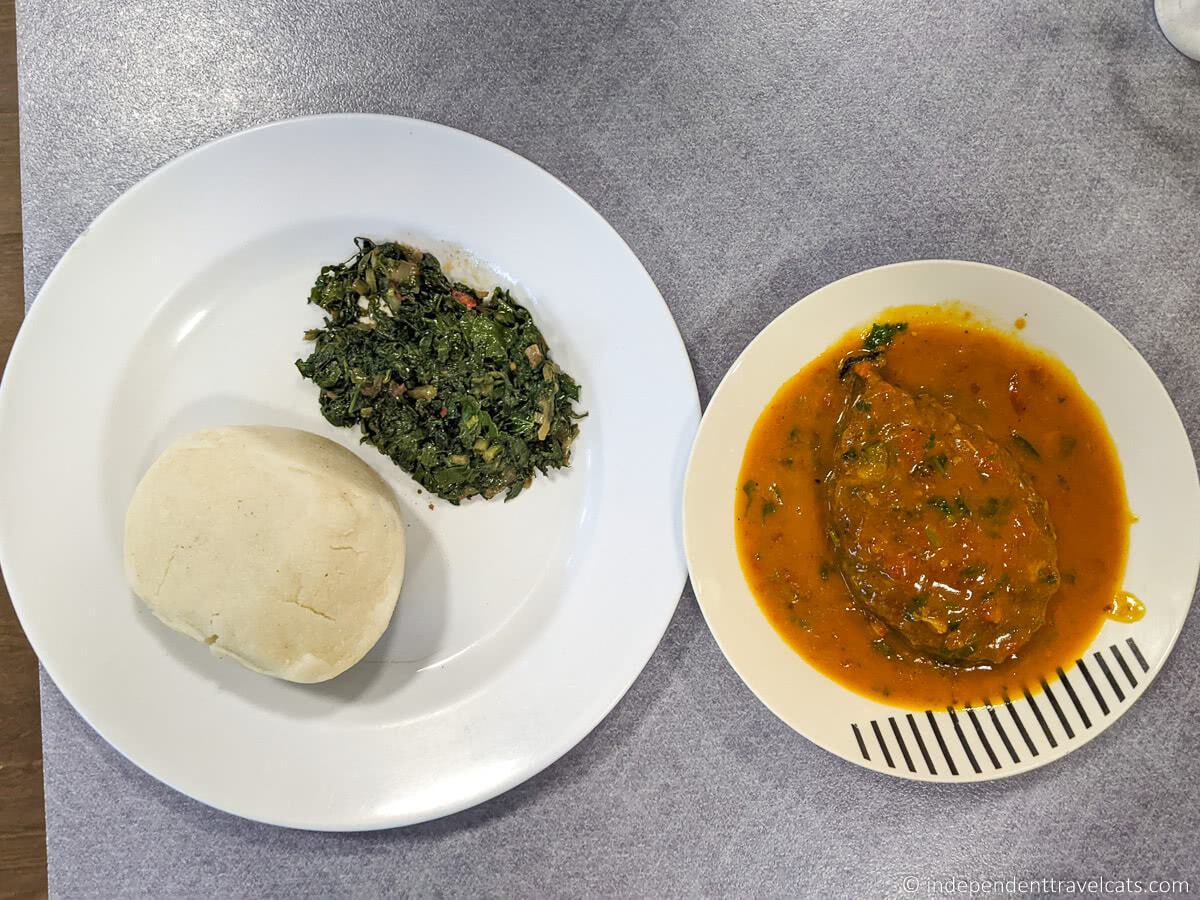
Karura Forest
Karura Forest is a wonderful green space located in northern Nairobi. It is a popular place for hikers, joggers, and cyclists with a number of walking trails and a 12 km long biking trail. It is also a popular place for family picnics, sports, school group visits, birdwatching, and dog walking. There is even a horse path for those on horseback.
We loved hiking here in the morning while staying in Nairobi. There are several different trails you can take, depending on how far you want to walk. The trails were fairly well-marked and you can buy a map at the gate if you wish. It really feels like you have escaped the city once you get out on the trails.
Some of the landmarks in the forest include Karura waterfalls, Mau Mau caves (where Mau Mau fighters hid out), Amani Gardens (which includes a memorial to those who died at the 2013 Westgate shopping mall attack ), and Lily Pond Lake.
Karura Forest is also a good place to spot local wildlife, especially birds. One of our safari guides told us that he comes here in the mornings sometimes for birdwatching. We spotted antelopes, monkeys, and several birds during our visit.
We visited on a weekend and while quiet in the morning it was very busy by the afternoon. Most were enjoying picnics in the picnic areas or playing sports. There is a football pitch, basketball court, and tennis courts. You can also rent bikes and head off on the bike trail.
You can enjoy a picnic in one of several designated picnic areas within the forest. There is a small fee for picnics and picnic spots are first-come first-serve (booking recommended on weekends). Note that alcohol and single-use plastics are not allowed in the forest.
There is also a restaurant, The River Cafe , located within the forest which is normally open whenever the forest is open. There are several free toilet facilities within the forest.
Karura Forest is normally open daily from 6:00am to 6:00pm. There is a fee to visit the forest and also a parking fee is you are driving yourself. There are also additional fees for certain services such as bike rentals, nature tours, using the sports grounds, or using the event space facilities. Some activities need to be booked in advance. You can check opening hours and fees here .
Some locals recommended that we don’t visit the forest on our own as there have been robberies on the trails. We felt safe but if you are traveling solo or would like a guide, there are tours you can join at the forest led by Karura Forest Eco-Tours, you can read more here .
If you are looking for transport and a local guide, you can also join a tour such as this guided tour and this guided tour . These tours normally include transport from your accommodation, a guide, forest entrance fees, and bike rentals (optional).
Although Karura Forest is the largest, it isn’t the only forest you can visit in Nairobi. The others are Ngong Forest and Oloolua Forest (the 5km Oloolua Nature Trail is here). Another option is the Nairobi Arboretum (described in another section) which is smaller but the most accessible for those in central Nairobi.
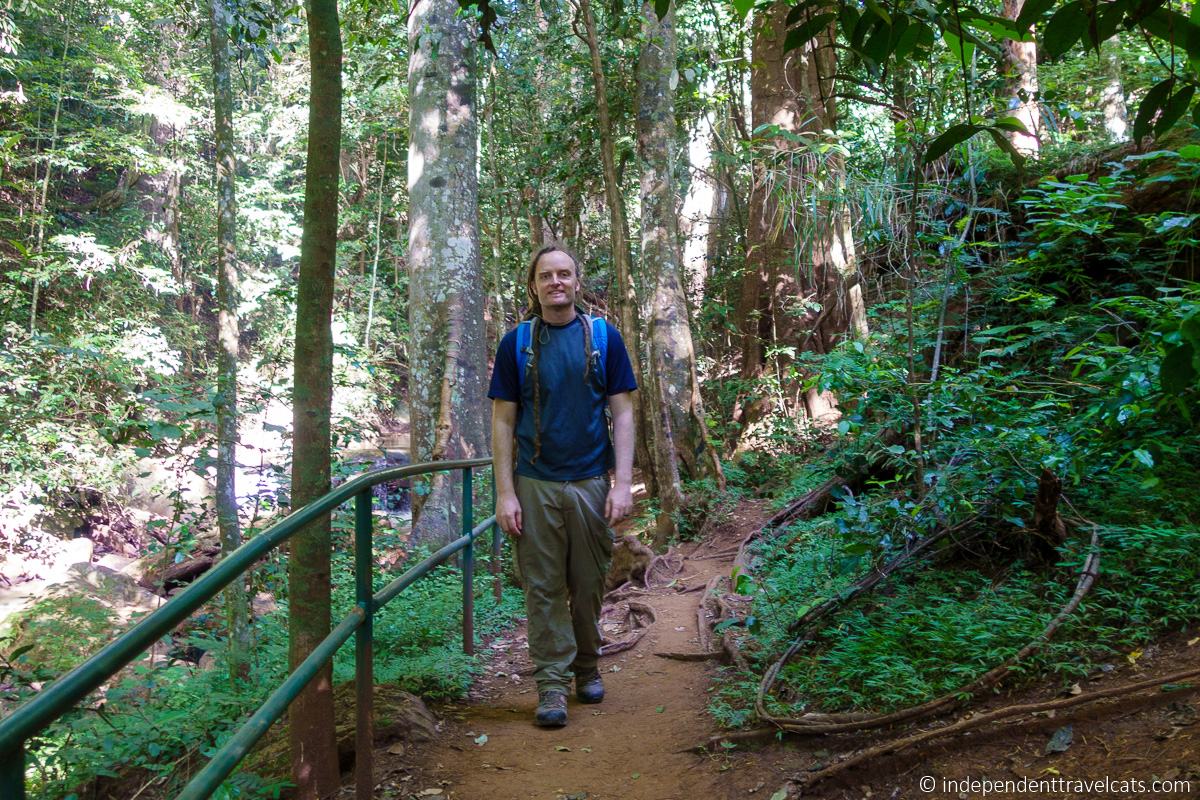
Nairobi Arboretum
The Nairobi Arboretum is a 30-hectare forest in the Kilimani area of Nairobi. It offers forest trails, lawns, picnic areas, and jogging trails. It is a great place to see lots of local and exotic tree species and is also home to a number of bird species as well as Sykes and Vervet monkeys. It is a popular place for locals to jog, meet, hang out, hold events, and have picnics.
The Nairobi Arboretum was established in 1907 as a place to plant new species of exotic fast-growing trees to use as firewood for fueling the newly constructed railway. It was designated as a national reserve in 1932 and in 1996 it became a public owned reserve.
We visited on our last trip to Nairobi as it was a short walk from where we were staying in the Kilimani area of Nairobi. It has a lot of shady paths you can follow as well as lots of places to sit and relax. The only negative was that a large family group were littering and feeding the monkeys without staff intervention when we visited.
There is a small fee to enter the arboretum and a parking fee. The Nairobi Arboretum is open daily from 6:00am to 6:00pm each day. There are toilet facilities on site. You can check fees and events here.
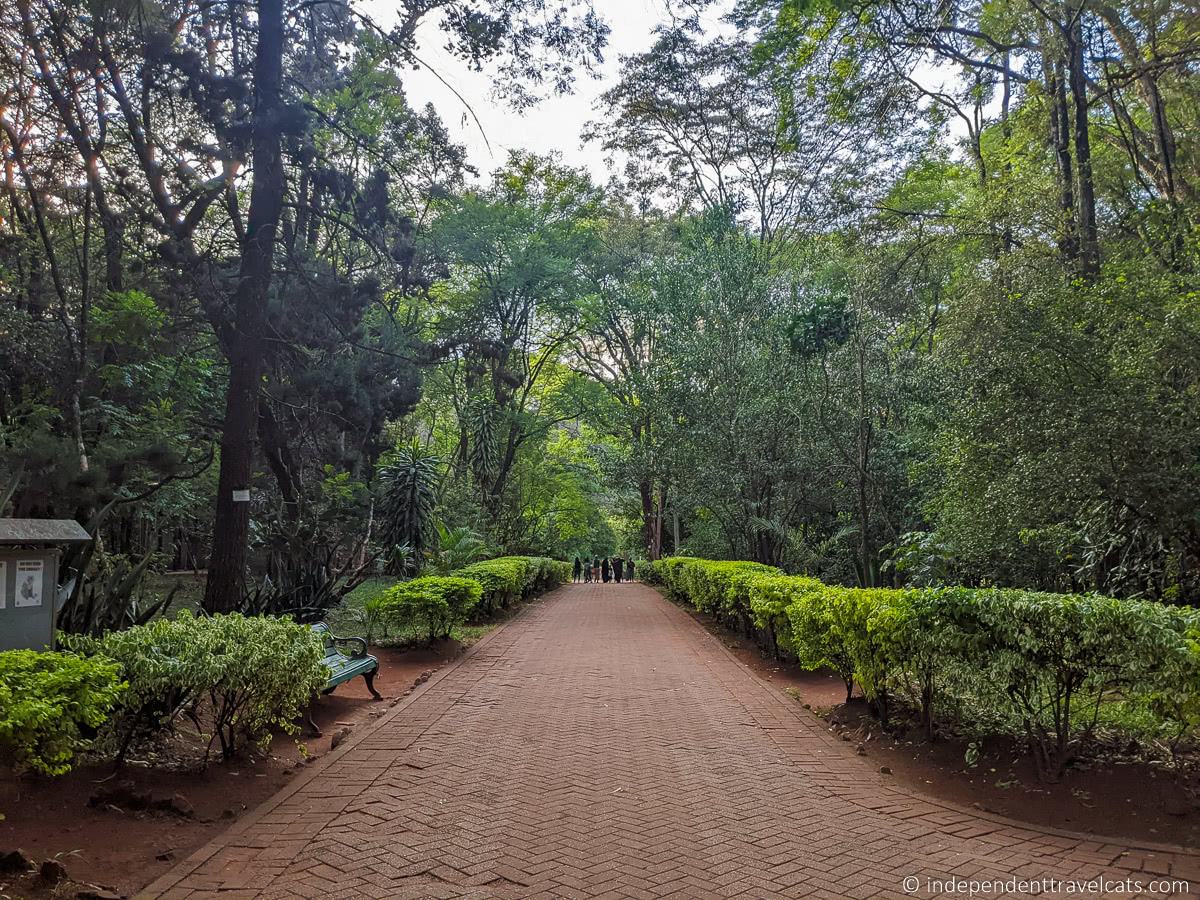
And that is our guide to visiting Nairobi and a list of the top things to do in Nairobi! We hope that if you are planning a trip to Nairobi that this guide has been helpful to you. If you have any questions about your trip to Kenya, just ask us and we are happy to try to help.
Want to remember this article, PIN it on Pinterest to read it again later:
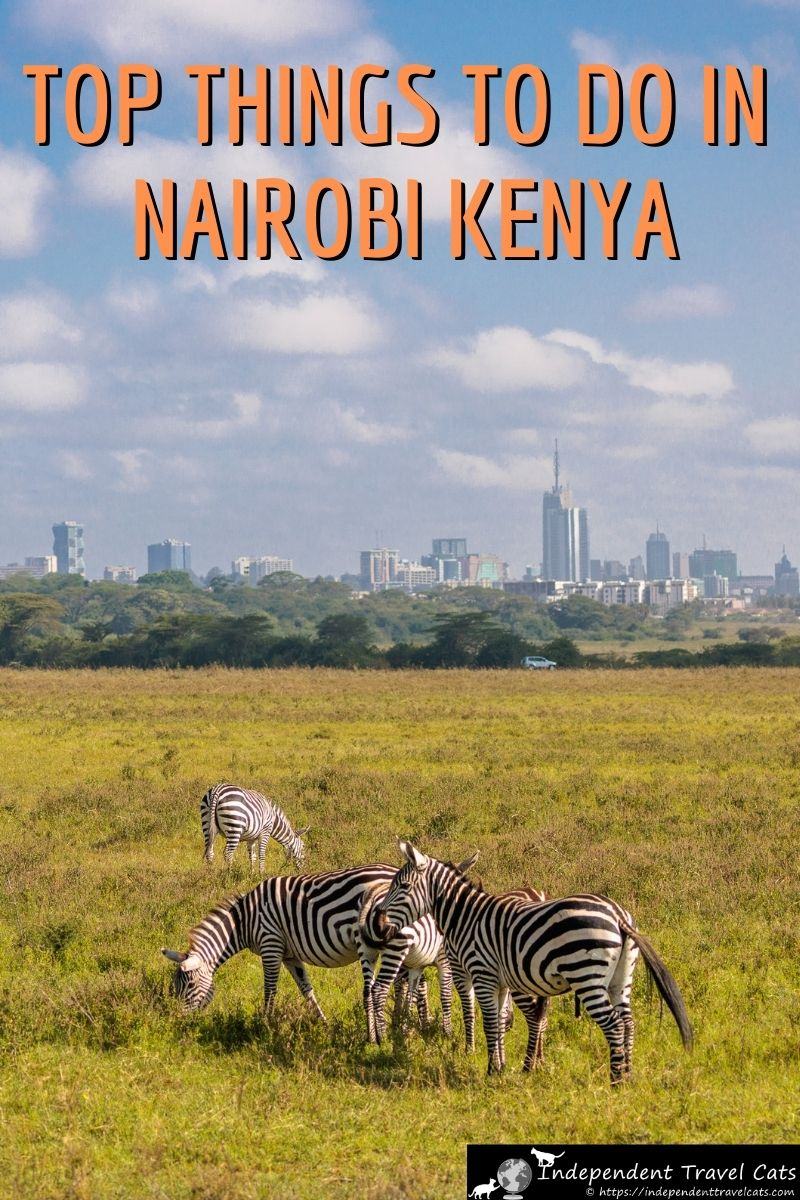
Are you planning a visit to Nairobi? Which of these sites are on your travel wish list? If you have visited any of these places, we’d love to hear your personal experiences and tips.
If you are planning a trip to Nairobi (or elsewhere in Kenya) feel free to ask us any questions about any aspect of your trip below and as always we’ll do our best to answer your questions!
Share this Post!
There are 34 comments on this post.
Please scroll to the end to leave a comment
Rob Post author
November 16, 2023 at 2:23 am
Your article is really thorough and I enjoyed it. The only thing I can add is that in Nairobi you can also get genuine Somali, Ethiopian, and Indiana cuisine. There are also a couple of events you can plan your trip around like their annual jazz festival, and monthly concert called blankets and wine where you can listen to Afro-jazz, soul, and RnB. Also safari rally for motorheads.
Jessica & Laurence Norah Post author
November 16, 2023 at 3:01 pm
So glad you enjoyed our Nairobi guide, and thanks for adding some more things to do in Nairobi!
The Blankets and Wine event sounds really nice! I just looked it up and looks like it is a quarterly event in both Nairobi (currently in the Kasarani neighborhood) and in Kampala, Uganda. Definitely something we’ll see if we can catch if timing works out next time we are in Kenya!
Best, Jessica
Peter Cheps Post author
September 20, 2023 at 4:39 am
This is one of the the most detailed piece about Nairobi. As i am commenting today, Nairobi is preparing for EL-Nino Rains. that might disrupt traveling in and out of Nairobi City soon. Travelers should be cautious particularly in the Western Sector of the country when the rainy season start anytime from now
September 20, 2023 at 3:39 pm
Thanks for taking the time to comment and let us know that you found our Nairobi post helpful and detailed, we alawys love to hear when our articles have been helpful to readers.
Thanks for sharing that info about the current rains and weather warnings, and I hope you stay safe if you are currently traveling in Nairobi or elsewhere in western Kenya.
Henna Post author
August 26, 2023 at 6:17 am
Hi! I stumbled upon your blog while looking if Nairobi is worth including in to our itinerary. It was highly informative, yet still with personal touches so I really enjoyed reading this! As you said, many use Nairobi as a gateway to safaris, and it was my original plan too but I founded tons of things I wanted to see/visit if I manage to squeeze in more than one night in there! David Sheldrick Wildlife Trust, City Markets and Thorn Tree Cafe at the top of my lists! Thank you for sharing your trip/trips and Happy Travels! Henna
August 26, 2023 at 9:43 am
So glad that our article convinced you to stay and see some of the sights in Nairobi!
Sounds like based on some of the places you want to see, if you have just one full day, I’d split your time between the Central Business District (downtown) to see places like the City Market and Thorn Tree Cafe (best for lunch, coffee, or drinks in our opinion) and then Karen/Langata for places like David Sheldrick Wildlife Trust elephant orphanage and you could maybe add a place or two in that area such as the Giraffe Center, Bomas (check performance schedule if interested), Kazuri Beads, Karen Blixen Museum, and/or Utamaduni Shops. Just be sure to check operating dates and times or if joining a tour, then they’ll time it for you. For the elephants, you’ll want to be there by around 10:30am to check-in so that is the one place that has a very definite time constraint and I’d plan your day around that stop.
If you have one full day and part of a second day, you could easily spend a full day in Karen/Langata and then the next partial day visit the City Markets and then have lunch at Thorn Tree Cafe before heading off to safari.
Hope that helps and just let us know if you have any more questions as you plan your visit to Kenya!
August 26, 2023 at 10:00 am
Hi Jessica!
Of course best would be to have atleast one full day, but the flights I am currently looking are landing during the night so I don’t know. Will have to think about it! Currently I am looking in of safaris so if you have any good safari operators in mind it would be greatly appreciated! And any uptodate COVID restrictions, I am seeing some very mixed informations on the internet…
August 26, 2023 at 5:40 pm
Yes, never enough time. If you arrive at night and want to see some of the city, then I’d recommend trying to stay two nights in Nairobi. The first one just to sleep, and then you can take a tour the second day around Nairobi to at least see a few attractions. This will also give you some time to relax and get ready if you start your safari the next morning.
Happy to give you some thoughts on safari but it depends on a lot of things! When are you thinking of going on safari, for how long, what is your budget, do you want a private driver or join a small group safari (or either), are there any specific things you want to see, etc. Are you just planning to just stay in Kenya for your safari?
I think Kenya has recently lifted all its main COVID restrictions for travel to and within the country (although it says if any traveler has any signs of illness they will be asked for proof of vaccination and tested). But some Kenyan authority websites do say that proof of COVID vaccination is required (I suspect they just haven’t been updated…) so I would just be safe and make sure to always carry your proof of vaccination on you (also a good idea just in case the requirements change while in the country as they can sometimes do). But you should definitely doublecheck the latest requirements for your home country, airline, Kenya, and any other destinations before your actual departure.
I am sure you are already aware, but there are a number of vaccinations recommended for travel to Kenya, and you can see the latest CDC guidelines here . I’d make an appt with your doctor or a travel nurse a few weeks in advance and see what is recommended for you and where you plan to go. Depending if you plan to travel to or through any other countries in East Africa, a yellow fever vaccination may be required. If you need or decide to get the yellow fever vaccine, I’d recommend taking it at least 2 weeks before you depart.
August 26, 2023 at 5:53 pm
I have already started to get my vaccinations, still few appointments left and planning to eat Malaria pills during our trip. Our trip will be early November, and I am travelling with my spouse.
2 nights in Nairobi sounds about perfect, just hope I am not overly positive about the time we have… 🙂
For safari the idea is to see the flamingos in Nakuru. Maybe include Maasai Mara to the itinerary. Maybe 4 days, 5 tops. And from Nakuru continue our journey to Uganda where we are going to stay rest of our trip and flying home from. I think private tour would suit best for us, since we like to have our own timetable. Budget is midrange, not overly expensive but I am not fan of sleeping in the tent either. 🙂
August 27, 2023 at 9:48 am
So the company we used is Tanzania based (Amani Afrika) and normally only does Kenya as part of a longer itinerary that includes Tanzania, but for such a short trip you will have a lot of options to get a private safari from Nairobi as Nakuru and the Mara are two typical places to visit together. Lake Nakuru is only about a 3.5 hour drive north of Nairobi so sometimes people even do it as a one night trip. I imagine most companies will have a 3-5 day itinerary for those two parks. I’d recommend checking out TourRadar as you can compare tours by length, price, rating, etc. You can see November private tours to Lake Nakuru and the Maasai Mara here . I’d say for a private tour for 4 days with mid-range accommodation, private guide, transport, meals, park fees, etc. – you are looking at around $1000-$1500 per person. If you want a cheaper one, you can get much lower rates by camping or joining a group. Just make sure the itinerary you choose has what you want in it and know what all is covered in tour price (and what you would need to pay for extra).
Also a note on the flamingoes, there are not as many of them in Lake Nakuru as there once was and for several years, there were almost none due to rising water there but they have been returning in the past couple of years and it looks like they are there now. But when I was in Kenya last year, there was almost none there, but we did get to see some in Amboseli. So just something to keep in mind. But regardless, Nakuru and the Maasai Mara are very much taking the time to see.
So for getting to Uganda, I would recommend flying from Nairobi to Entebbe/Kampala. There are daily flights with Kenya Airways and others to Entebbe and they are only about 1.5 hours. If you go overland from Kenya it will be 10+ hours of driving and you’ll need to pay for your driver/car/fuel/accommodation for an extra night. Also best to get a new Uganda guide for your time in Uganda rather than have a Kenyan guide in most cases due to local knowledge and language. Of course if you want to save money, you can get a bus from Nairobi to Kampala for about $25. But I’d recommend flying if you want to avoid the discomfort of a long bus or car ride.
Where are you planning to go in Uganda? We have been a couple times, and spent about a month in Uganda earlier this year. I haven’t had a chance to write too much about our time in Uganda but Laurence has written guides on visiting Entebbe , chimp trekking , and gorilla trekking . But we have also been to all the national parks and most of the cities there as well as several museums and cultural attractions. So happy to try to help if you have any questions about planning your time there as well.
August 27, 2023 at 1:16 pm
Hi Jessica,
You are really going above and beyond answering my questions, thank you!!
(There wasn’t Reply link on your response below so I used this one..)
Yes, I read about decreased flamingo population in Nakuru, but I think it would still be worth visiting, and it is on our way so why not stop there for a day or two, right? 🙂 And with animals nothing is ever 100% sure anyway!
The prices you mentioned 1000-1500 per person is what I expected. I have became a bit comfort-seeking on my old age of 30, (hah!), so I am sure it won’t be worth of saving couple hundreds if it means sleeping in a tent. I wouldn’t mind being a part of bigger group, it is nice to meet new people, but since we are not coming back to Nairobi it would just be a hassle for the rest of the group if we were to be dropped off somewhere else.
Ah, flying. It is such a long flight even to get in Africa in the first place so even if it means sitting in the car for several hours I would much prefer it. It enables to see the scenery on the way! Bus is option I am thinking on. The border crossing just intimidates me a little. But, it would be a experience in it self.
In Uganda we are going to stay in Kampala. I will have to check Laurence’s guides for Uganda, thanks! I would love to see the gorillas but it think our budget is too slim for that. Well, something for next time..But if you have any tips for Kampala, I would appreciate them! 🙂
August 28, 2023 at 4:10 pm
You’re very welcome!
I think that you’ll probably find it easier and less expensive to return to Nairobi after your safari regardless and then head to Uganda from there. You’ll have the most bus options there as well, if you do the bus I would just book the nicest seat you can. The bus can be interesting as you can get to see how most Kenyans travel back and forth in East Africa. Either way, just be prepared for a very long day of sitting!
In Kampala itself, its a busy and chaotic (traffic wise) place but there is definitely 2-3 days worth of things you can do, depending on what you like to do and see. The main cultural attractions we’d recommend would be Kabaka’s Palace, Uganda Museum, and Kasubi Royal Tombs. There are also a number of important religious sites, again depending if those are of interest – the Uganda National Mosque (also nice view from minaret, we could only see outside of actual mosque as non-Muslim when we visited), Catholic churches (Saint Mary’s Cathedral Rubaga, Basilica of the Uganda Martyrs, etc.), Anglican (Saint Paul’s Cathedral Namirembe), and the Baha’i Temple.
For a general sense of Kampala and learn more, we’d highly recommend doing some kind of walking tour with a local guide. We’ve personally done this walking tour of the downtown with mosque visit (with guide Arthur), a great way to see and learn more about Kampala and go to some places that you may not feel comfortable walking without a guide. We’d also recommend doing one of the nighttime cultural events or shows at the Ndere Cultural Centre , the shows are fun, the people were super friendly, and meals are optional to add at many of the shows. If you are more adventurous, you might also enjoy a food tour to try a lot of local food items, Laurence did this tour and loved it. If you’re into social change, the slum awareness walk with AFFCAD is amazing (usually led by Jaffar), but you’d need to contact them in advance if they are still leading them.
From Kampala, both Entebbe and Jinja are within easy day tripping distance. Entebbe is where the airport is located and has a lovely botanical garden (see Laurence’s posts with all the info about Entebbe). You could also do a day trip over to Jinja, the source of the Nile and also some nice forest and waterfalls over in that area. If you want to see more wildlife/nature and have a few days to do a short tour, then the nearest parks are either Murchinson Falls or Lake Mburo. Or you could go do chimp trekking as well.
Yes, unfortunately the permit costs for the gorilla treks are a set price and are expensive so you can save that for another time! It is much less expensive to do the chimp trekking (or golden monkey trekking) so you could look into those if you are interested. I think the Kibale forest permits are now $200/person but less at other sites ($50-$120/person I think) although Kibale in our experience is the easiest place to see them.
Oh, yes for the comment replies, I think we may have exceeded the maximum number of comments allowed on a single thread. So if you want to reply or ask another question related to Kenya you can just start with making a new comment. Or if you have any follow up comments about Uganda, you can leave them over on one of Laurence’s relevant posts on those topics.
Hope that helps! Jessica
Adam Post author
August 19, 2023 at 2:36 pm
your nairobi guide is so very helpful to us – we are an older couple from u.s. planning a trip. we were here 30+ years ago but never got to really see much of the city as we went off to do some volunteer work and a bit of safari elsewhere. the city seems to have changed a lot since our last visit and this time we want to spend a day or two seeing it. then going on to visit some old friends on the coast and do some safari time
so if you don’t mind a couple of questions for you: 1) do we need to worry about tetse files while in nairobi? or what colors we were? (I see laurence in bright blue in one photo so thinking not) and 2) we love the idea at staying at a historic hotel but not sure if stanley would suit in downtown (feel a bit worried about that area at night), do you have other ideas. we like something that has old-world feel, comfortable and a place where we could get transport & join tour to see city. don’t mind being outside very center, but don’t want to be outside the city either
August 20, 2023 at 8:20 pm
So first, so glad to hear that you are find our Naribi travle guide and tips helpful in planning your own Nairobi itinerary. How wonderful that you and your partner have the chance to return to Kenya again after 30 years! And I definitely agree that Nairobi is worth a full day or two to explore. I understand that you may feel a bit uncomfortable visiting here, especially independently, but with a tour guide or driver on a booked tour you should be fine.
1. No, you don’t need to worry about the tsetse fly in Nairobi. Now, I won’t 100% guarantee you that there aren’t any as they are attracted by wildlife and livestock, but I don’t think you need to worry about them in any places you are likely to go. We never experienced any in Nairobi National Park for instance. We did get bitten by mosquitoes one night (we left our window open and didn’t use our mosquito netting one night) in Nairobi last year so they do exist at least in some areas of the city and good to take precautions against them, especially in the evening. So you can wear whatever colors you want but if doing safari later, there are tsetse flies in many of the game parks in Kenya, including the Maasai Mara and Tsavo. So best to stick to the “safari colors” for your time on safari. Although efforts to minimize tsetse flies in Kenya have been effective it seems in recent years, our guide said last year that he was shocked by how few tsetse flies he saw in Tsavo West compared to prior years.
2) So really any hotel in the central part of Nairobi is fine for most tour companies and with private guides in particular they are generally pretty flextible in terms of pickup and dropoff locations. Same with taxis. You just need to give them the address at the time of booking normally so they can then set a pickup time. So I would focus on the hotel first and then you can book your tour.
Here are a few options in Nairobi, not sure of your budget, but these are all nicer ones:
So The Stanley is definitely one of the oldest hotels and a classic, but you are right in that it is located in the center of the CBD and is right next to busy streets. So you can read reviews from other travelers on that.
Another good option is The Norfolk , so this is a 5-star historical hotel (the original part dating to 1904) and is also located in the CBD, but in the northern part up in the university area. It is surrounded more by gardens and feels less in the middle of the city so this might be a good alternative. Still central but doesn’t necessary feel like it is so and has good security.
If you prefer to be outside of the central business district of Nairobi, you might consider a place over in either Karen or Langata (depending on what you plan to do with your day in Nairobi) such as Giraffe Manor (former home of the Leslie-Melvilles and built in 1932) or Karen Gables (Cape Dutch style former home) which is a nice B&B.
Another place would be Villa Rosa Kempinski , this is not a historical hotel (built in 2009 or so I think) but it has an Old World sort of decor. It is located in the Westlands area.
Anyway, hope that helps you get started. And do let me know if you have any further questions as you plan your trip!
August 21, 2023 at 6:18 pm
Hi Jessica! Wow, thanks for taking the time to answer so quickly and provide such a thoughtful response. good to know no flies to worry about, at least for this part of our trip but we did know they would possibly appear in the mara etc. And I think the norfolk hotel you recommended looks perfect, so I think we will likely book that as it looks like a nice place to stay after such a long journey, central in the city, and a bit of an indulgence before we head onward. thanks again for your time and knowledge very grateful!
August 21, 2023 at 6:41 pm
You’re very welcome. Wishing you a safe & wonderful trip to Kenya!
tanay sharma Post author
June 22, 2023 at 2:37 am
I love exploring different places and Nairobi is one of the places I would love to explore. Thanks for sharing insights about different factors like water safety, travel options within Nairobi and health concerns. I have been at the ethiopian airlines flights to Nairobi from different parts of the world. Looking forward to more such informative posts!
June 22, 2023 at 10:34 am
Thanks, glad you are considering a visit to Nairobi. So in Kenya, Nairobi’s Teknik Post author June 6, 2023 at 3:29 am Are zebras native to the habitat there? June 14, 2023 at 7:15 am I believe that zebra are native to Nairobi, or at least that general area before the city built up there. Writings by early settlers and the books by Isak Dinesen (aka Karen Blixen) talk about there being lots of local wildlife outside of the city such as gazelle, zebra, and lions. Now almost all the larger wildlife is contained within Nairobi National Park which was created in 1946. I think all (or at least most) of the animals and birds found there are native to Kenya. I don’t know for certain but I think that the range for zebra would have been very widespread across Kenya in the past with plains zebra liking habitats such as treeless grasslands and savanna woodlands. In terms of zebra species, there are both Grévy’s zebra and common plains zebra in Kenya, but in Nairobi National Park you’ll only find the plains zebra. But you can find the endangered Grevy’s zebra in some of the parks/reservers in northern Kenya. Hope that helps! If you have any other questions about visiting Nairobi National Park, just let us know – it is a great park to visit if you are staying in the city. Alison Post author May 20, 2023 at 11:39 am Lovely article! I’m currently in Nairobi myself and just wanted to say that your tips have made this trip much easier, and have also made me more confident being here (I’m by myself, as a woman and infrequent traveller), so thank you for that! Also, to any tourists who might be reading this, I just want to say that 1 day most definitely is not enough. This city is amazing and has so much to offer. Added benefit of having more time is you get to take a break in one of the really beautiful parks and just watch all of the exotic birds that hang out in the centre of the town. And if you’re concerned about safety, which I know a lot of people are – I’ve walked everywhere, totally submerged in the crowds of Kenyans from walks of life who get around on foot, and have not for a second felt uncomfortable or unsafe. Hope that helps! May 21, 2023 at 9:34 am I am so happy to hear that you had such a lovely visit to Nairobi and that our tips and information was helpful and make you more comfortable visiting the city. Yes, as a single woman, it can definitely be intimidating. And yes, we can certainly agree that the city has enough attractions to fill a few days as we have certainly done on prior visits – we are hoping to get back here next year again! One thing I would note for other readers reading this is that although we also feel comfortable walking in many parts of Nairobi, especially during the day, there are certainly some areas of Nairobi I would not recommend tourists wander around alone on foot, especially after dark. So I think it is just about being cautious, sensible, and also following local advice. Many residents would also not recommend walking in certain areas alone after dark as there are just certain places where crimes like robbery are unfortunately still common. Thanks for taking the time to comment, and I am very happy you had such a great time in Nairobi!! Erin Post author August 30, 2022 at 2:05 am I’ve been to Nairobi! It’s just as cool as the pictures show, any one reading this should consider going! August 30, 2022 at 3:06 am Thanks for taking the time to comment, and so happy that you enjoyed your trip to Nairobi! Seana Turner Post author August 29, 2022 at 3:26 am Our neighbors across the street just returned from safari. Too bad they didn’t read this post before going! We also have a mission partner who lives in Kenya. She came to the US for seminary, and then went back to her home in Nambale to start a school. It’s been amazing to watch what she (with God’s help) has accomplished. Because she comes back every year, I get to hear lots about Kenya, and her time passing back and forth through Nairobi. Once again, you provide all the little details everyone needs to know. On another note, my husband and I are hoping to take a trip to Scotland next summer, so I’ll be combing this site for ideas on what we should do while we are there. Keep the great info coming. 🙂 August 29, 2022 at 6:50 am That sounds wonderful about your friend and her work. I hope you get a chance to perhaps visit her in Nambale some day and do some sightseeing in Kenya 😉 And of course, happy to help you with your trip to Scotland once you start planning it. We have a lot of articles across our two travel blogs, and you can also of course leave us Comments or email me with any questions. Emily Post author August 2, 2022 at 12:01 am Great post and photos, gave us lots of info about Nairobi and also travelling to Kenya in general. We just have an afternoon in Nairobi and most of the tours start well before we could be able to do so. Thoughts on what to do if we just have 5-6 hours in afternoon and evening. We fly out the next morning pretty early. Staying in a hotel in the Lavington area I think. August 3, 2022 at 12:58 pm So some options not too far from you if in the Lavington area of Nairobi would be the Giraffe Center, Kazuri Beads, Karen Blixen Museum, Bomas of Kenya (if reopened by your travel date), Uhuru Gardens Memorial Park (if reopened), and the Carnivore restaurant (it is normally open late for dinner). If you wanted to just do one thing, you could also book an afternoon game drive at Nairobi National Park. However, I would note that we’d generally recommend visiting there in the mornings. But I think it is open until early evening. You could also instead spend your time in the Central area of Nairobi and there you could visit one of the city’s museums such as the Nairobi Museum, go up the KICC (need a passport on you), do a walking tour, visit the City Market, etc. But you’d definitely want to check opening hours and days to make sure any places would be open when you are there. So I think there are a number of options, I would just see what will fit with your specific date and time you’ll be in the city, and what is of most interest to you. It also depends on what kind of transport you have, and with such a short amount of time I’d recommend hiring a private driver, joining a tour, or taking taxis/Uber. Hope that helps, and wishing you a wonderful time in Kenya! Lawrence K Post author June 7, 2022 at 3:09 pm A lovely and detailed account of my city. You are most welcome to visit again and again. June 7, 2022 at 3:52 pm Hi Lawrence, Thanks so much for taking the time to leave a comment. It is really wonderful to hear that you enjoyed our article about your home city of Nairobi – if you have any other tips or advice we might have missed, feel free to add! We’d love to hear them. And yes, we hope to visit Nairobi again soon. We know we are going to be back in Uganda in 2023 and will hope to also be able to get over to Kenya as well 😉 May 31, 2022 at 1:49 pm I have to say that the very idea of traveling to Kenya feels a little overwhelming to me. I am not the most intrepid traveler, and it feels a world away. I do have a friend who lives in Kenya and has established and runs a school there (she’s amazing!). I also am friends with a couple who travels to Kenya each year to support missions and children. So I know it is possible! I would say it would not have occurred to me to that there was so much to do in Nairobi. I have learned from my friends that the pace in Kenya is slower, so I guess if you have made that very long trip, might as well see as much as possible. As always, so full of helpful information. You guys are the best! June 1, 2022 at 4:11 am Yes, Kenya is not the easiest place to travel but you can definitely do so with some planning. And having a friend in Kenya would definitely make it easier as I am sure she would love to have you visit her 😉 Safety is obviously a concern for most travelers so visitors do need to take precautions. Right now the USA (and other countries) has increased its security warnings for Kenya as the elections are coming up in August 2022 and can bring increased unrest to the country. But hopefully this will calm down again following the election period. Yes, there is plenty to do in and around Nairobi. I’ve been to Nairobi three times and there are still things I would love to go back and do and see if we have the chance to return. Even if you aren’t really interested in the downtown city attractions, you can stay on the southside of the Nairobi National Park and it feels like you are out on safari. Seeing wild animals like giraffes, zebras, and lions with a city skyline in the background is really unique. If you decide to visit, just let me know 😉 eleanor graves Post author May 30, 2022 at 6:07 pm wow, what an in-depth article! really enjoyed reading all this about nairobi as we are *hoping* to visit Kenya for the first time next year!! so will be bookmarking this. A few quick questions: -how easy is it to get a taxi from NBO airport? -if we just have a day, what tour would you recommend taking? -not really related to nairobi, but what do you advise wearing for kenya, like for the game drive parts? thanks in advance, i am sure I will have more questions in the future! May 31, 2022 at 6:37 am Hi Eleanor, So glad you enjoyed reading our post about things to do in Nairobi and excited to hear you are planning to visit Kenya next year. I hope you are able to do so. 1. Yes, it is pretty easy to get a taxi from the airport. There are taxi desks in the airport and ones waiting outside in the taxi/cab designated areas there you can take (just be sure to take one from the designated areas and set a price with the driver before you get in). You can also call an Uber, arrange a transfer in advance to be waiting for you, or your hotel and/or tour company may be able to do it for you. The airport recommends having an airport taxi or private transfer arranged in advance to avoid needing to negotiate. The taxis at the airport are regulated and licensed but there are no set fees so they will sometimes overcharge foreign visitors. 2. I think you have since found our detailed 1 day Nairobi itinerary post. That should give you lots of ideas. But in terms of specific tours, this is a full day tour that covers all the places I went on my first visit to Nairobi. But it, of course, just depends on what you are most interested in seeing/doing. 3. You want clothing that is comfortable, breathable, will protect you from the sun and insects, and is easy to wash (good if can be both handwashed and machine washed). Avoid dark colors, particularly black and blue (which attract tetse flies), and bright clothes. Good colors are khaki, tan, light green, gray, light brown, olive green, and other such “earthy” colors. For shirts and pants/trousers, most of our safari clothing (for both Laurence and myself) is by Craghoppers . We like their Insect Pro line (called NosiLife Pro in some countries) in particular. You’ll also want a brimmed hat, sunglasses, and comfortable shoes that you don’t mind getting a bit dirty (we wore hiking boots, but you could also probably do with sneakers/trainers if not hiking on your trip). But in Nairobi as we noted, we recommend just wearing normal comfortable clothing and shoes. Colors don’t really matter as much. You want to still be careful with prepared for the sun as many of the sites like the elephants orphanage are uncovered. Also important to always have water with you (if part of a tour they will normally provide filtered or bottled water to guests). Hope that helps, and yes feel free to ask more questions as you plan your trip to Nairobi. Your email address will not be published. Required fields are marked * Notify me of replies to my comment (just replies to your comment, no other e-mails, we promise!) Subscribe to our monthly Newsletter where we share our latest travel news and tips We only ask for your e-mail so we can verify you are human and if requested notify you of a reply. To do this, we store the data as outlined in our privacy policy . Your e-mail will not be published or used for any other reason other than those outlined above.Leave a Reply Cancel reply

12 Top-Rated Tourist Attractions in Nairobi
Written by Karen Hastings Updated Dec 26, 2023 We may earn a commission from affiliate links ( )
Nairobi, Kenya's capital and largest city, has long been the gateway to some of Africa's best adventures. But this vibrant metropolis has plenty of exciting things to do before you head out on safari.
Nairobi's rich history and tribal culture is brought to life in its excellent museums. The Karen Blixen Museum is a big hit — especially with fans of the Out of Africa book and film, who come to see where the namesake Danish author toiled on her coffee farm in the beautiful Ngong Hills.
Even in such a bustling city, wildlife is a huge draw. Nairobi is one of the only cities in the world with a safari park in its borders. A mere 15-minute drive from the skyscrapers of the city center, you can enjoy a classic African wildlife experience at Nairobi National Park . Lion, cheetah, zebra, wildebeest, giraffe, rhinoceros, and buffalo roam the sun-soaked savanna here, and animal lovers can cuddle baby elephants and connect with giraffes at the excellent animal sanctuaries nearby.
Nairobi is also the gateway to the world-famous safari parks , which have captivated adventure seekers for more than a century. Discover the top places to visit in this cosmopolitan capital with our list of the top attractions in Nairobi.
See also: Where to Stay in Nairobi
1. Nairobi National Park
2. david sheldrick wildlife trust, 3. giraffe centre, 4. karura forest reserve, 5. karen blixen museum, 6. nairobi national museum, 7. bomas of kenya, 8. kazuri beads factory tour, 9. kenyatta international conference centre, 10. ngong hills, 11. railway museum, 12. national archives, where to stay in nairobi for sightseeing, tips and tours: how to make the most of your visit to nairobi, nairobi, kenya - climate chart.
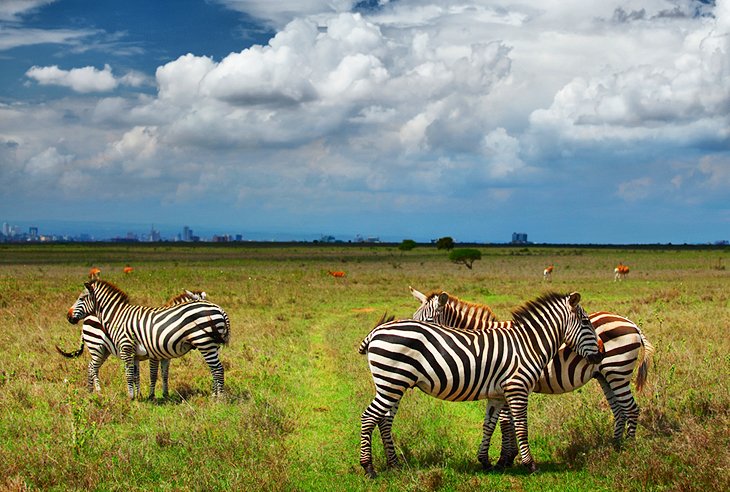
Kenya's first national park, Nairobi National Park lies only seven kilometers from the skyscrapers of Nairobi's city center. A haven for wildlife, the park is also a rhino sanctuary, which protects more than 50 of these critically endangered creatures.
In addition to the rhinos, you can see lions, gazelles, buffaloes, warthogs, cheetahs, zebras, giraffes, and ostriches, and more than 400 species of birds have been recorded in the wetlands.
Nairobi National Park is also a famous ivory burning site. In 1989, President Moi ignited 12 tons of elephant tusks and rhino horns here, boosting the country's conservation image on the world stage. Today, a monument marks this historic site.
The Nairobi Safari Walk is a popular attraction, offering animal lovers the chance to spot wildlife on foot, and walking trails weave around the area known as Hippo Pools .
At the park's main gate, you can bond with orphaned baby elephants and rhinos at the David Sheldrick Wildlife Trust .
Address: Langata Road, Nairobi
Official site: http://www.kws.go.ke/parks/nairobi-national-park
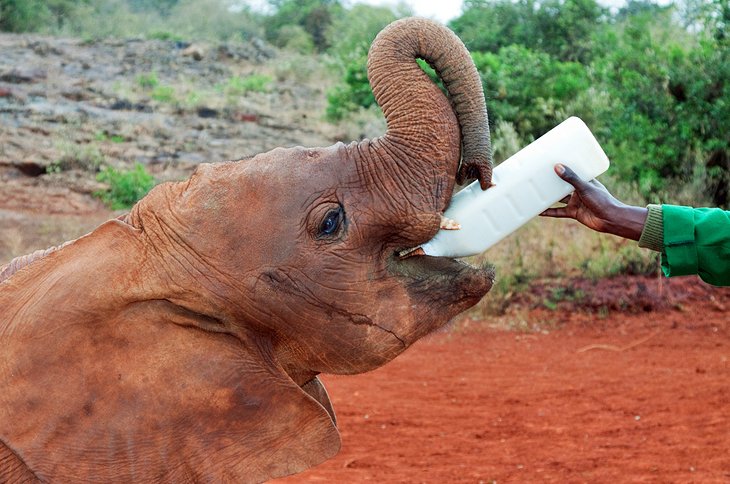
At the main gates of Nairobi National Park , this orphan-elephant rescue and rehabilitation program is a must-see for animal lovers. Daphne Sheldrick founded the project in 1977 in memory of her late husband David, a former warden at Tsavo East National Park.
The center cares for young abandoned elephants and rhinos and works to release the animals back into the wild. You can watch these lovable creatures up close as they frolic in the mud and drink from giant baby bottles. Best of all, your entrance fee helps support the project's conservation efforts.
If you want to help even more, consider adopting an orphaned elephant, rhino, or giraffe - you'll receive regular updates on their progress long after you leave.
Address: Mbagathi Road, Nairobi
Official site: http://www.sheldrickwildlifetrust.org/
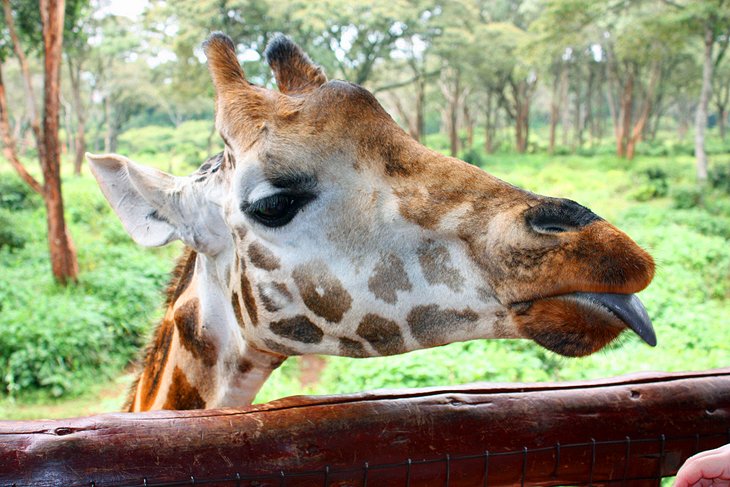
At the Giraffe Centre, on the edge of Nairobi National Park , visitors can come face to face with endangered Rothschild's giraffes. This non-profit center lies on the grounds of the plush guesthouse, Giraffe Manor , and its main mission is to provide conservation education for children.
The visitor center displays information about these graceful creatures, and a raised platform allows you to feed them at eye level with specially prepared pellets.
This is one of the most unusual things to do around Nairobi, especially with children - photo ops with wet, gray giraffe tongues slurping little faces are priceless.
After communing with these long-lashed beauties, you can enjoy a 1.5-kilometer self-guided forest walk in the adjacent nature reserve.
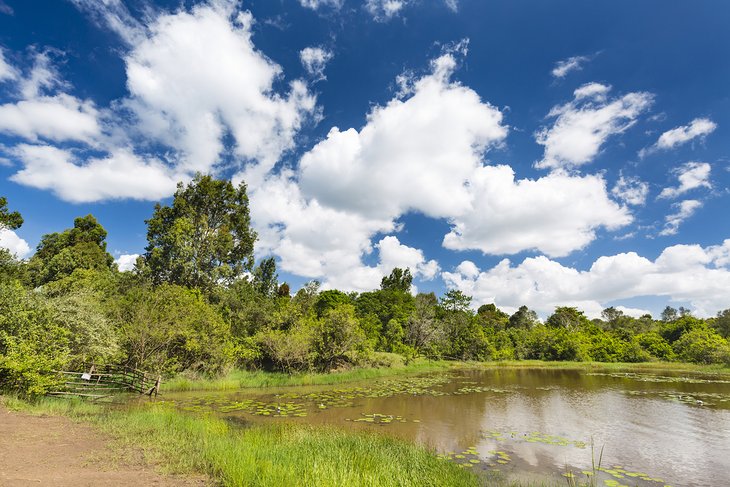
Are you craving some solitude near the city? You're in luck. The beautiful Karura Forest is a cool, shady oasis just a few kilometers from the city center.
This lush green space is actually one of the largest urban forests in the world , and you'll discover all kinds of things to see and do here. Hike to a multi-tiered 15-meter waterfall. Enjoy a picnic in the gardens. Watch monkeys clamber through the trees, or just sit quietly by Lily Lake and soak up the tranquility. Bike riding is also popular along the well-marked red-clay trails.
Wildlife also thrives here. Besides monkeys, you might also see duiker (small antelope), butterflies, and many species of birds. After all your forest adventures, sit back and relax with a snack and a drink at the open-sided river café.
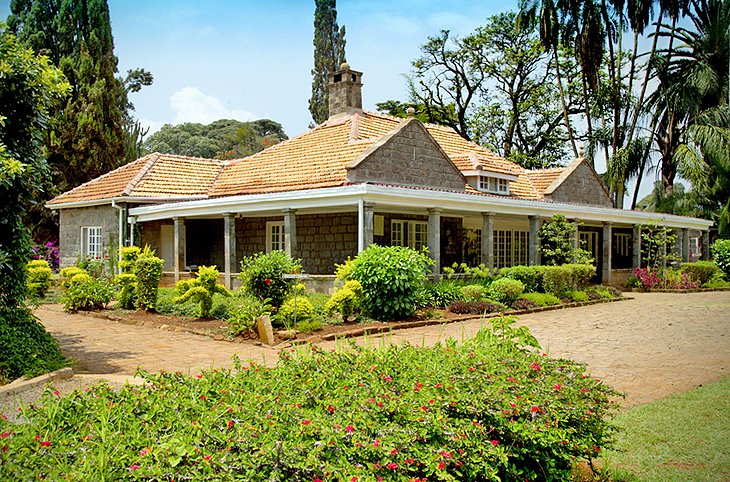
One of Nairobi's top tourist attractions, the Karen Blixen Museum, at the foot of the Ngong Hills, is the former home of the famous namesake Out of Africa author. Karen Blixen, also known by her pen name, Isak Dinesen, lived in the house from 1917 to 1931, where she ran a coffee plantation.
Today, you can tour the well-preserved colonial farmhouse, a kitchen in a separate building, a coffee-drying plant in the woodland, and an agricultural college on the grounds.
Furniture that belonged to Karen Blixen and her husband is on display, as well as photographs and books owned by Karen and her lover, Denys Finch Hatton. Enthusiastic guides bring the story of Karen Blixen and colonial Kenya to life.
Address: Karen Road, Nairobi
Official site: http://www.museums.or.ke/karen-blixen/
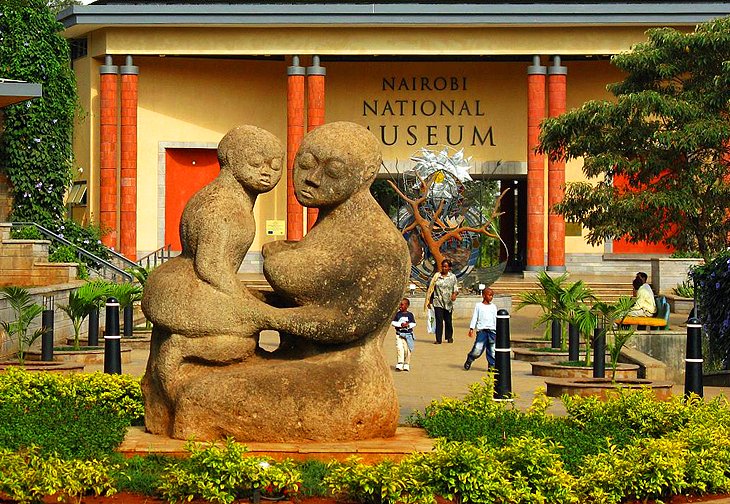
The National Museum in Nairobi is an educational way to spend a few hours on a city stopover. The museum displays diverse cultural and natural history exhibits including more than 900 stuffed birds and mammals, fossils from Lake Turkana, ethnic displays from various Kenyan tribal groups, and exhibits of local art.
In the Geology Gallery, you can explore an impressive collection of rocks and minerals and learn about tectonic plates and the life cycle of a volcano. The Hominid Vault contains a collection of prehistoric bones and fossils, including the preserved fossil of an elephant.
At the museum, visitors can purchase combination tickets, which include entrance to the adjacent Snake Park with live specimens of Kenya's most common reptiles.
If you're looking for a dose of nature on your Nairobi trip, save time to stroll around the tranquil botanical gardens here after your visit.
Address: Museum Hill Road, Nairobi
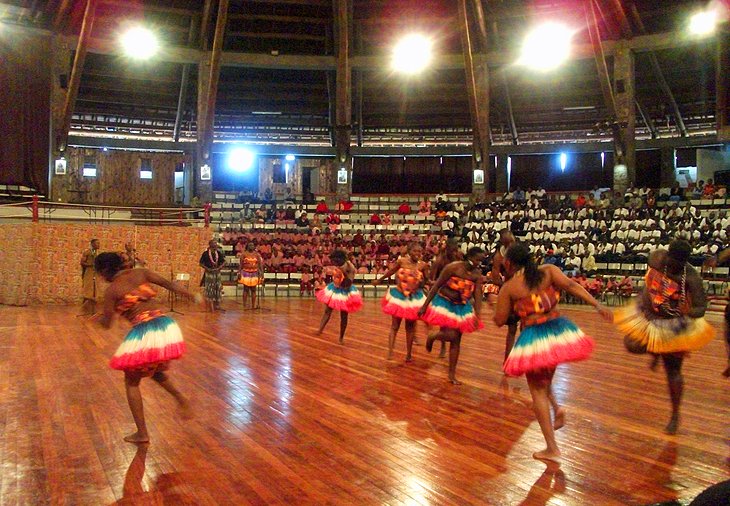
About 10 kilometers from Nairobi, Bomas of Kenya is a living museum celebrating the colorful tribes of Kenya. This is a great place to learn about the lifestyle, art, music, crafts, and culture of each tribe.
The complex encompasses a recreated traditional village with homesteads or bomas, each one reflecting the culture of a major ethnic group. Every afternoon, a team performs traditional dances and songs in the large theater. Audience participation makes the performances even more enjoyable.
Location: Forest Edge Road, off Langata Road, Mageso Chember
Official site: http://www.bomasofkenya.co.ke/

Looking for some unique souvenirs and gifts for family and friends? The Kazuri Beads Factory is a great place to shop. Best of all, you're helping disadvantaged local women at the same time.
Kazuri means "small and beautiful" in Swahili, and these shiny, brightly colored beads surely fit the bill.
Join a free factory tour and see how local women, including many single mothers, make the beads and other pottery items from scratch. After the tour, you can purchase some to take with you, knowing you are purchasing from a World Fair Trade Organization member. Prices are relatively reasonable.
This is a great tour to combine with a visit to the Karen Blixen Museum , as the factory lies right nearby. It's also one of the top free things to do in Nairobi, although it's hard to leave here without buying some of these beautiful beads.
Address: Mbagathi Ridge, Karen, Nairobi
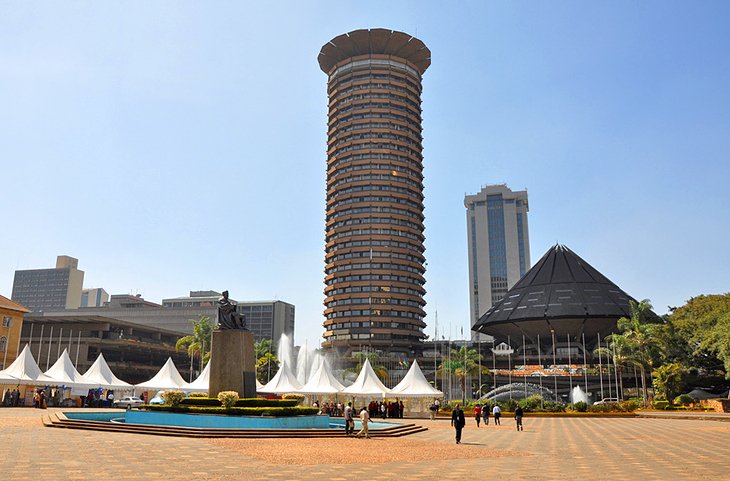
Named for the Republic's First President, Jomo Kenyatta, the distinctive cylindrical Kenya International Conference Centre (KICC) offers breathtaking 360-degree views from its rooftop viewing deck.
The building is an internationally acclaimed venue for conferences, meetings, and exhibitions, and it's an eye-catching landmark in the city. Though not the tallest building in Kenya, it dominates the skyline with a 28-story tower overlooking a large amphitheater. Its pale terra-cotta façade recalls the color of traditional African huts, and the central plenary hall resembles the ancient Roman Senate.
Zoom up to the rooftop viewing platform to take photos of the sprawling city below, and you can also enjoy a meal at one of the restaurants.
Address: Harambee Avenue, Nairobi
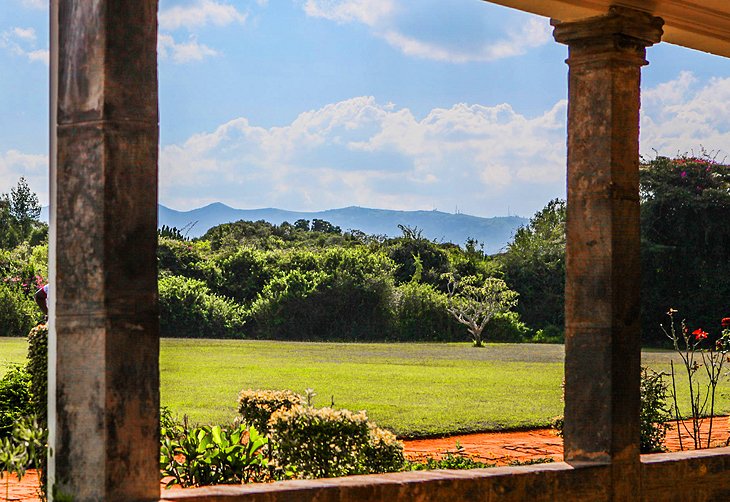
"Ngong" means "knuckles" in Maasai, a fitting name since these beautiful pointed green hills resemble the back of a fist facing the sky. They are a popular place to visit close to Nairobi and provide a welcome respite from the city heat.
The Ngong Hills are the peaks of a ridge overlooking the Great Rift Valley, and many white settlers established their farms here in the early colonial days. Half-timbered houses and flowering gardens remain, but seem more suited to southern England than Africa.
Several walking trails traverse the hills, offering beautiful views of the valleys below. Wildlife is also visible in the area. Buffalo, gazelles, giraffes, bushbuck, the occasional klipspringer, and troupes of baboons are often glimpsed grazing along the roadside.
If you're an Out of Africa fan and you're looking for other places to visit in the Ngong Hills, stop by the grave of Denys Finch Hatton, the lover of famous Danish author, Karen Blixen. It lies on the eastern slopes, graced by an obelisk and garden.
Address: Great Rift Valley, Mageso Chember, Nairobi
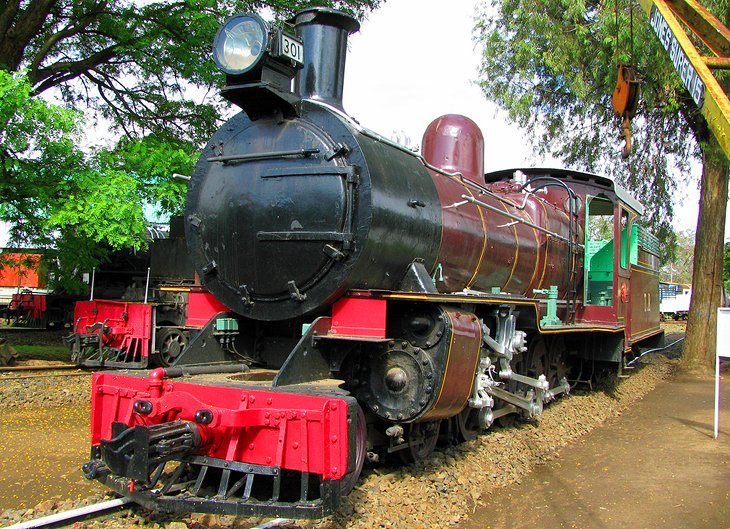
The Railway Museum in Nairobi celebrates the rich history of the railroad in Kenya and its impact on the nation's development. Among the museum's fascinating collections are train and ship models, photographs from the original construction of the Uganda Railway, railway magazines, maps and drawings, and a silver service set used on overnight trains to Mombasa.
A collection of steam locomotives and rolling stock are also on display, including a model of the MV Liemba, built by the Germans and still in use along Lake Tanganyika.
A favorite exhibit is the carriage used during the hunt for the Maneater of Kima in 1900. Captain Charles Ryall, a colonial officer, positioned himself in the carriage to shoot a man-eating lion; unfortunately he fell asleep and was dragged out the window by the lion.
Address: Uhuru Road, Nairobi
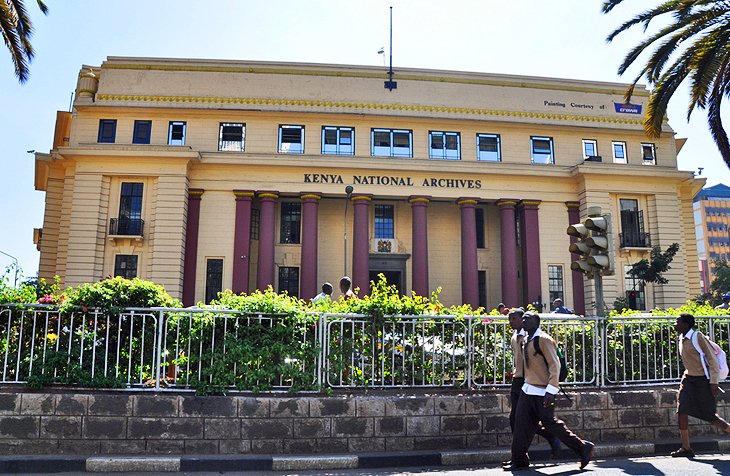
You'll find a little bit of everything about Kenya at this museum. Housed in the old Bank of India building, the National Archives spotlights Kenyan tribal culture, as well as the country's art, history, and politics.
Paintings and artifacts from the collection of Joseph Murumbi, one of Africa's most famous collectors, dominate the exhibits. The main floor gallery displays historical documents and a collection of photographs.
The second floor houses more art, a display of postage stamps, and the National Archives reading room, which is used for personal and professional projects.
Along with the Nairobi National Museum, this is one of the top places to visit in Nairobi on a budget, and it will broaden your understanding of Kenya's rich history and culture.
Address: Moi Avenue, Nairobi
Travelers visiting Nairobi for the first time have two main areas where they can base themselves for prime sightseeing opportunities: To feel the pulse of this vibrant city and have easy access to its restaurants, shops, and museums, the city center makes a great base.
Those who prefer a more peaceful experience in the countryside should consider staying in the affluent suburb of Karen, home to some of Nairobi's most luxurious hotels, as well as the Karen Blixen Museum. Here are some highly rated hotels in these areas:
- Luxury Hotels: Overlooking the Ngong Hills in the suburb of Karen, the plantation-style Hemingways Nairobi exudes colonial elegance, with four-poster beds, personal butler service, and a pampering day spa. In the heart of the city, Fairmont The Norfolk is a more affordable luxury option that feels like an elegant oasis, with lush gardens, a heated pool, and day spa. It lies within walking distance of the National Museums of Kenya, as well as many restaurants and shops. Behind well-guarded gates, 10 minutes by car to Wilson Airport and 16 minutes to the international airport, The Boma Nairobi makes a fine pre- or post-safari base. It's close to the city center and offers a spa and health club.
- Mid-Range Hotels: Within walking distance of the National Museum of Kenya, the elegant Villa Rosa Kempinski Nairobi is at the high end of the mid-range options, and the Sarova Stanley , in the heart of the city, is Nairobi's oldest luxury hotel, with relatively affordable rates. Also in the city center, the InterContinental Nairobi is a popular base for those who prefer a large chain hotel.
- Budget Hotels: A little farther out from the city center but within walking distance to popular shopping malls, Progressive Park Hotel offers great value for longer stays, with its studio rooms and apartments. The Kenya Comfort Hotel has basic budget rooms in a convenient location close to city center sights.
- Wildlife Day Trip Adventures: Feed giraffes and get up close with baby elephants on the full-day David Sheldrick Elephant Orphanage and Giraffe Center Tour . Animal lovers can learn more about these lovable creatures and the center's valiant efforts to protect this vulnerable species. The tour also includes a visit to the Karen Blixen Museum and the Kazuri Beads factory.
- Safari Adventure and Wildlife Tour : If you want to add a safari experience to the wildlife sanctuary visits, the Giraffe Center, Elephant Orphanage, and Nairobi National Park Day Tour adds a three-hour game drive through Nairobi National Park, where you can spot animals such as lions, rhinos, zebras, and buffalo. Both tours include transport, guides, hotel pickup and drop-off, and admission to all the parks.
- Hell's Gate and Lake Naivasha Trip : If you prefer a more active wildlife experience, the Hells Gate and Lake Naivasha Day Trip is a great choice. This full-day excursion includes a two-hour bike tour through the park to spot wildlife such as zebras, elands, and gazelles and a one-hour hike through the park's rugged gorges, with a stop at a Maasai village . For an additional fee, you can enjoy a cruise on Lake Naivasha to spot hippos and birdlife.
- Three-Day Safari: Explore one of the world's most famous game reserves and the site of the Great Migration on the three-day Maasai Mara Guided Safari from Nairobi . Expert guides take you on game drives to see some of the park's diverse wildlife, including lion, leopard, cheetah, and buffalo. At night, you will sleep in semi-luxury tents in the wilderness. An optional add-on to Lake Nakuru National Park is also available.
More Related Articles on PlanetWare.com
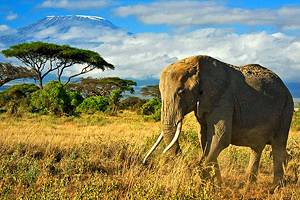
Places to Visit in Kenya : Besides the wildlife adventures and colonial history of Nairobi, other things to do in Kenya including basking on beautiful beaches and snorkeling along coral reefs. Southeast of Nairobi, you'll find plenty of things to do in Mombasa as well. Stroll around its atmospheric Old Town, visit wildlife sanctuaries, or dive a wreck in Mombasa Marine National Park.
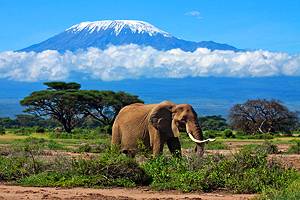
Places to Visit in Tanzania : South of Kenya, Dar es Salaam is Tanzania's largest city and lies a short boat ride from the beautiful tropical islands of Bongoyo and Mbudya. And if taking the safari of a lifetime is your mission, Tanzania is home to some of the most magnificent game reserves in the world, including Serengeti National Park and Ngorongoro Conservation Area.

More on Kenya
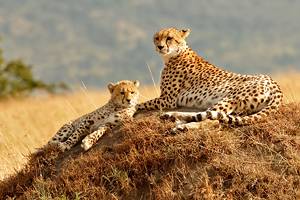
Must-see attractions in Nairobi

David Sheldrick Wildlife Trust
Occupying a plot within Nairobi National Park, this nonprofit trust was established in 1977, shortly after the death of David Sheldrick, who served as the…
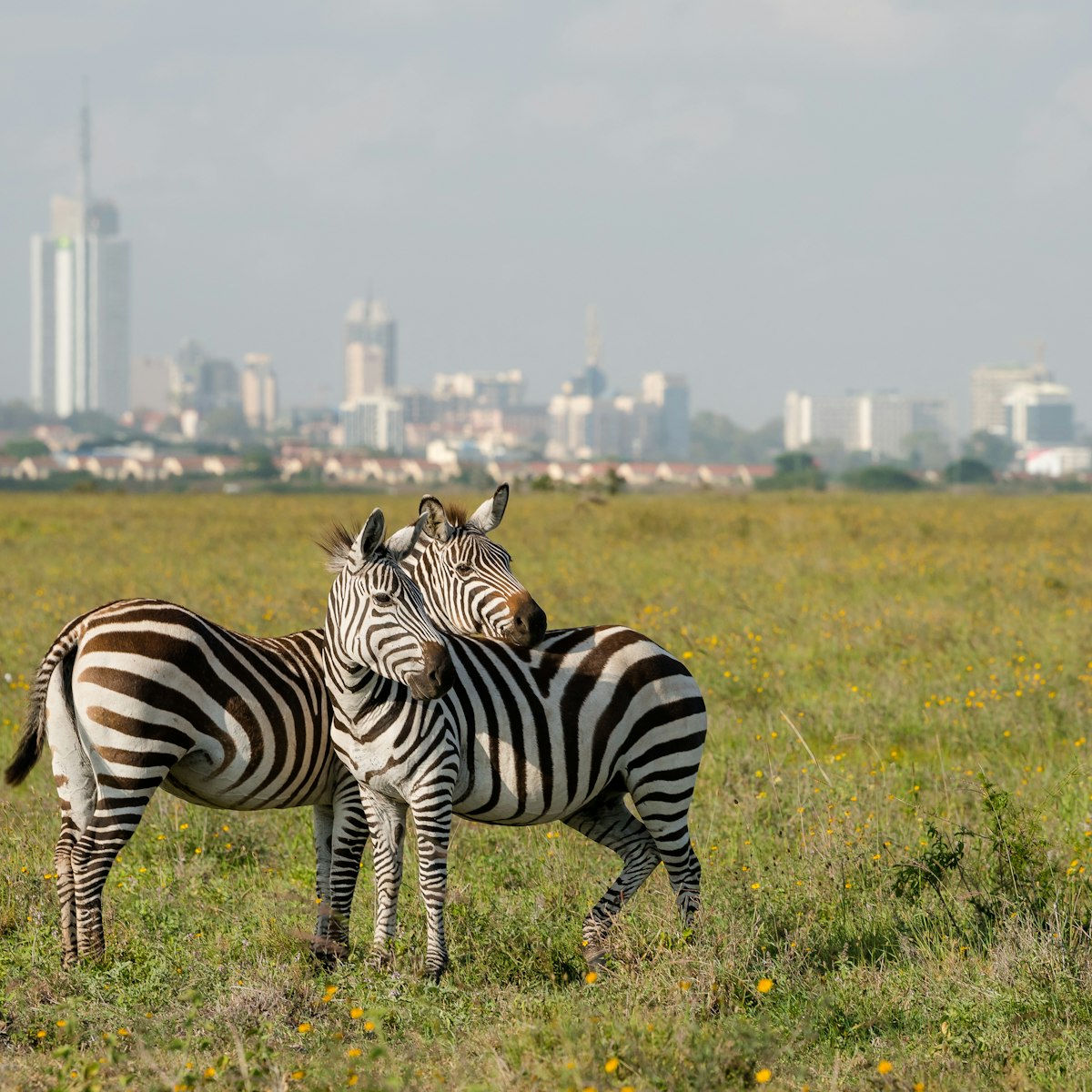
Nairobi National Park
Welcome to Kenya’s most accessible yet incongruous safari experience. Set on the city’s southern outskirts, Nairobi National Park (at 117 sq km, one of…
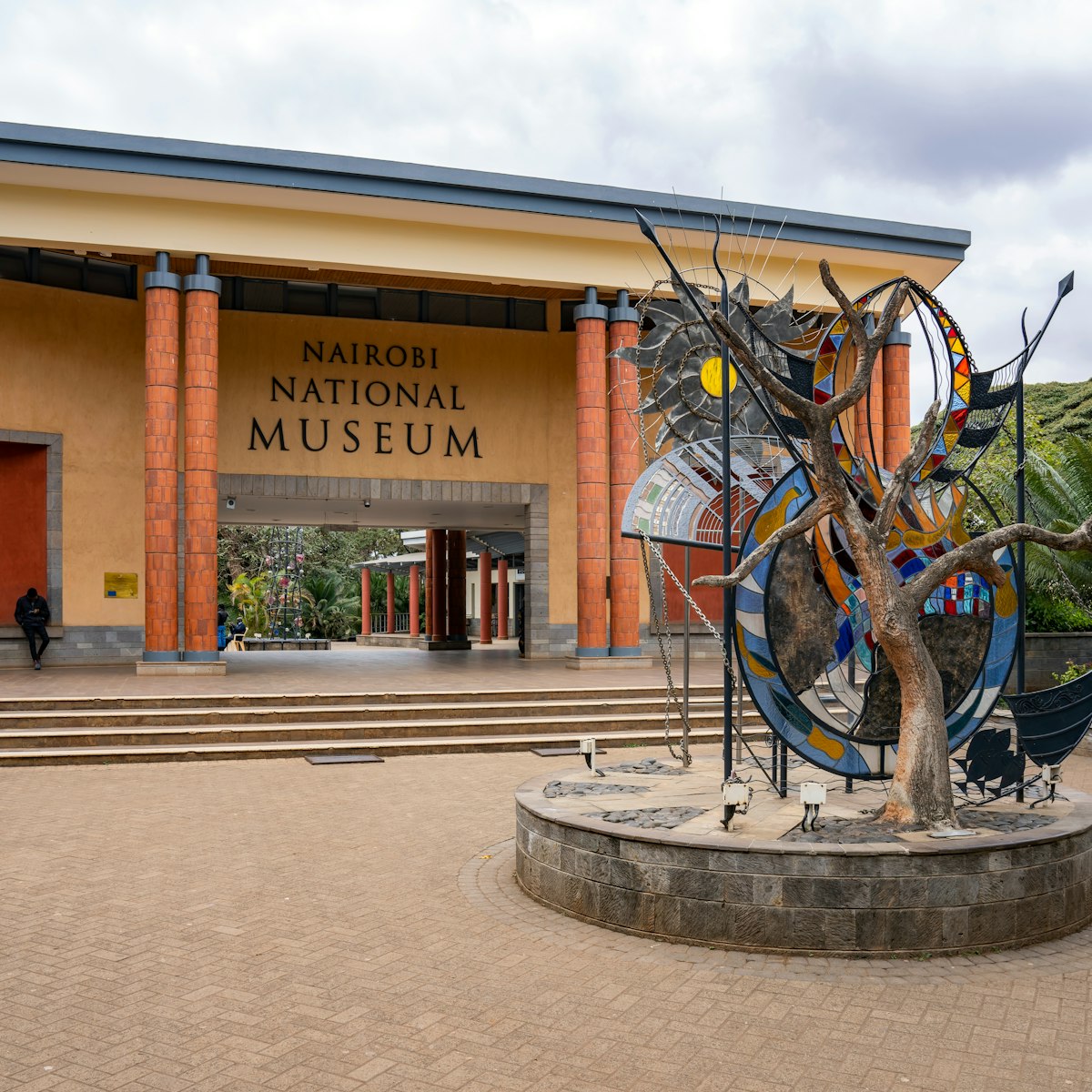
National Museum
Kenya’s wonderful National Museum, housed in an imposing building amid lush, leafy grounds just outside the centre, has a good range of cultural and…
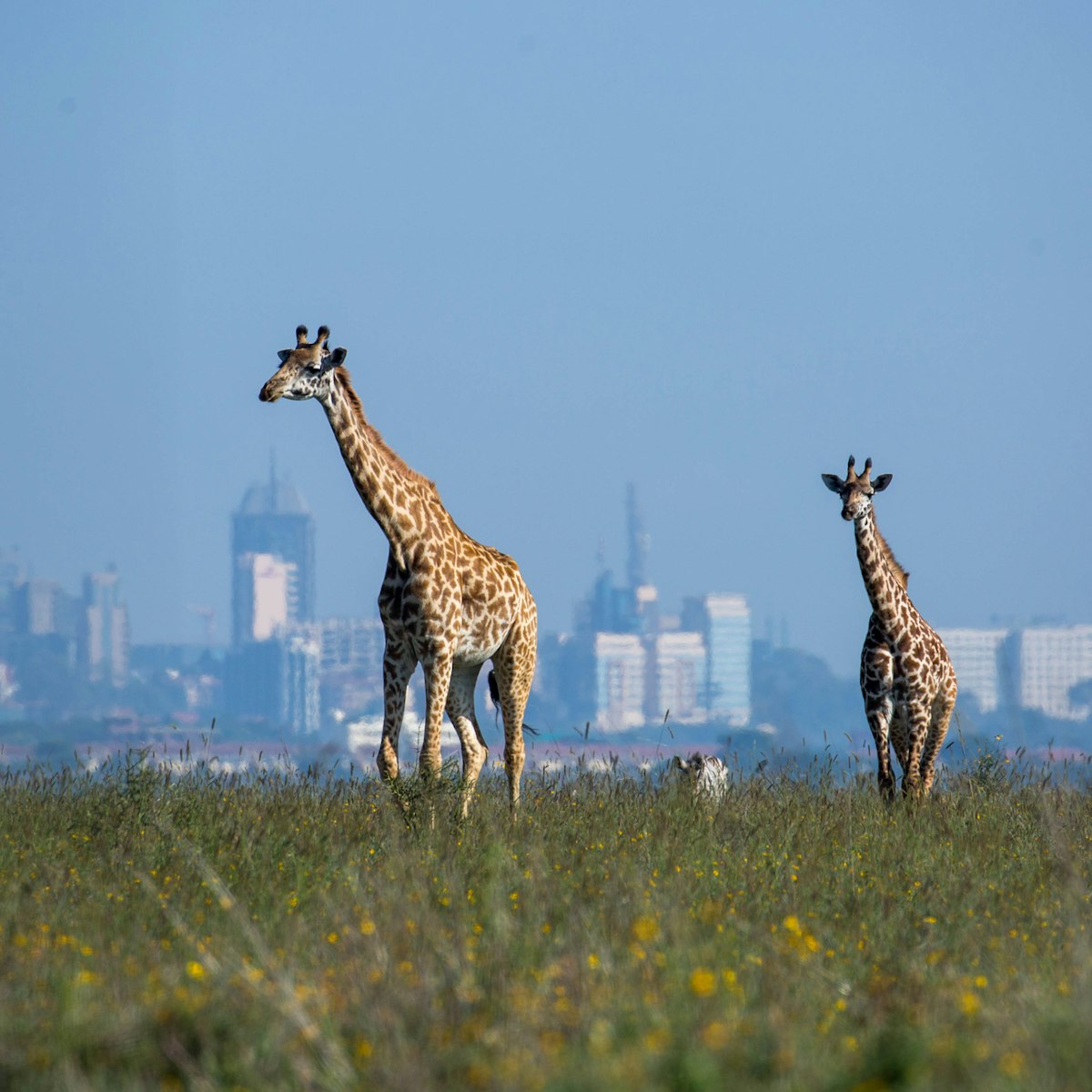
Giraffe Centre
This centre, which protects the highly endangered Rothschild’s giraffe, combines serious conservation with enjoyable activities. You can observe, hand…
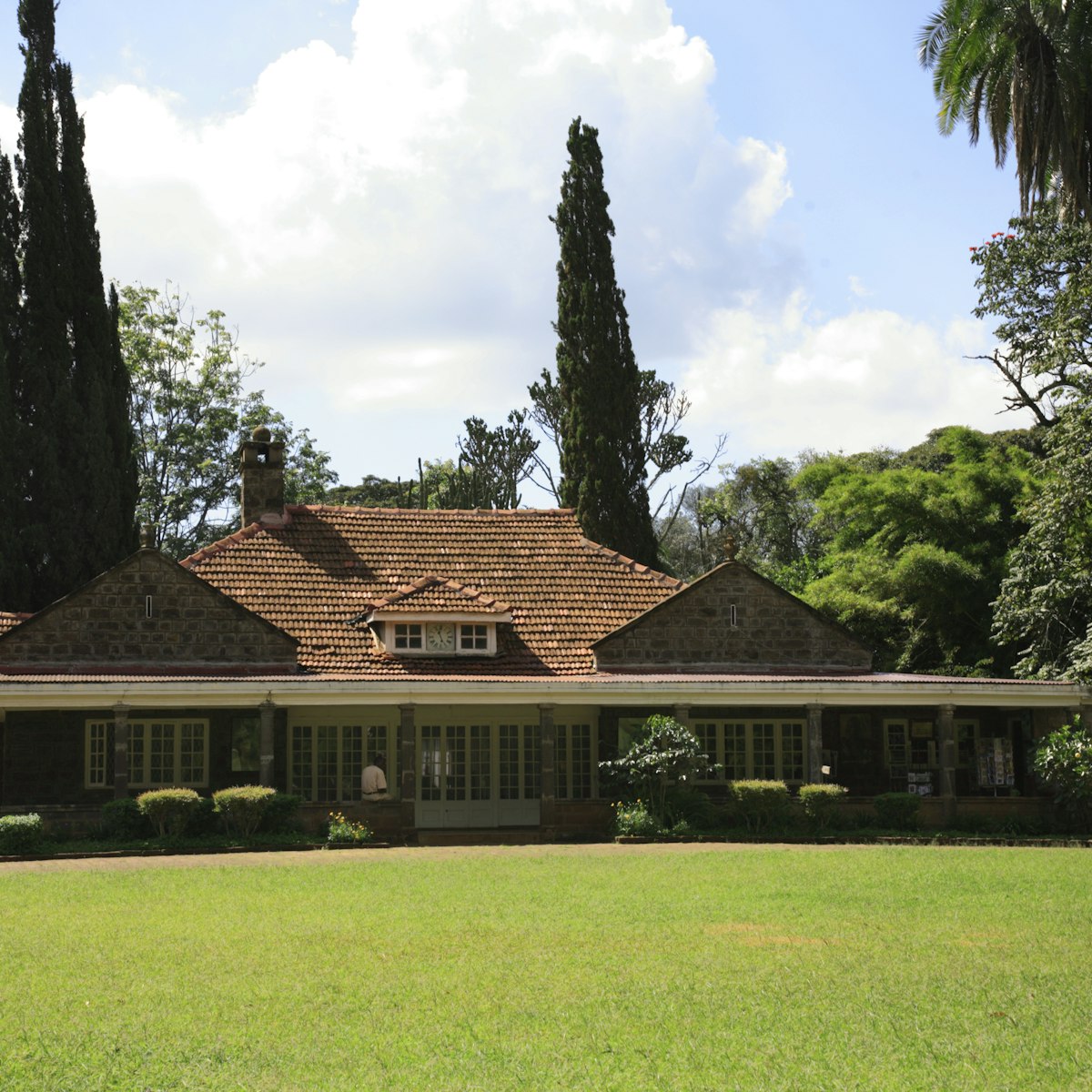
Karen Blixen's House & Museum
If you loved Out of Africa, you'll love this museum in the farmhouse where author Karen Blixen lived between 1914 and 1931. She left after a series of…
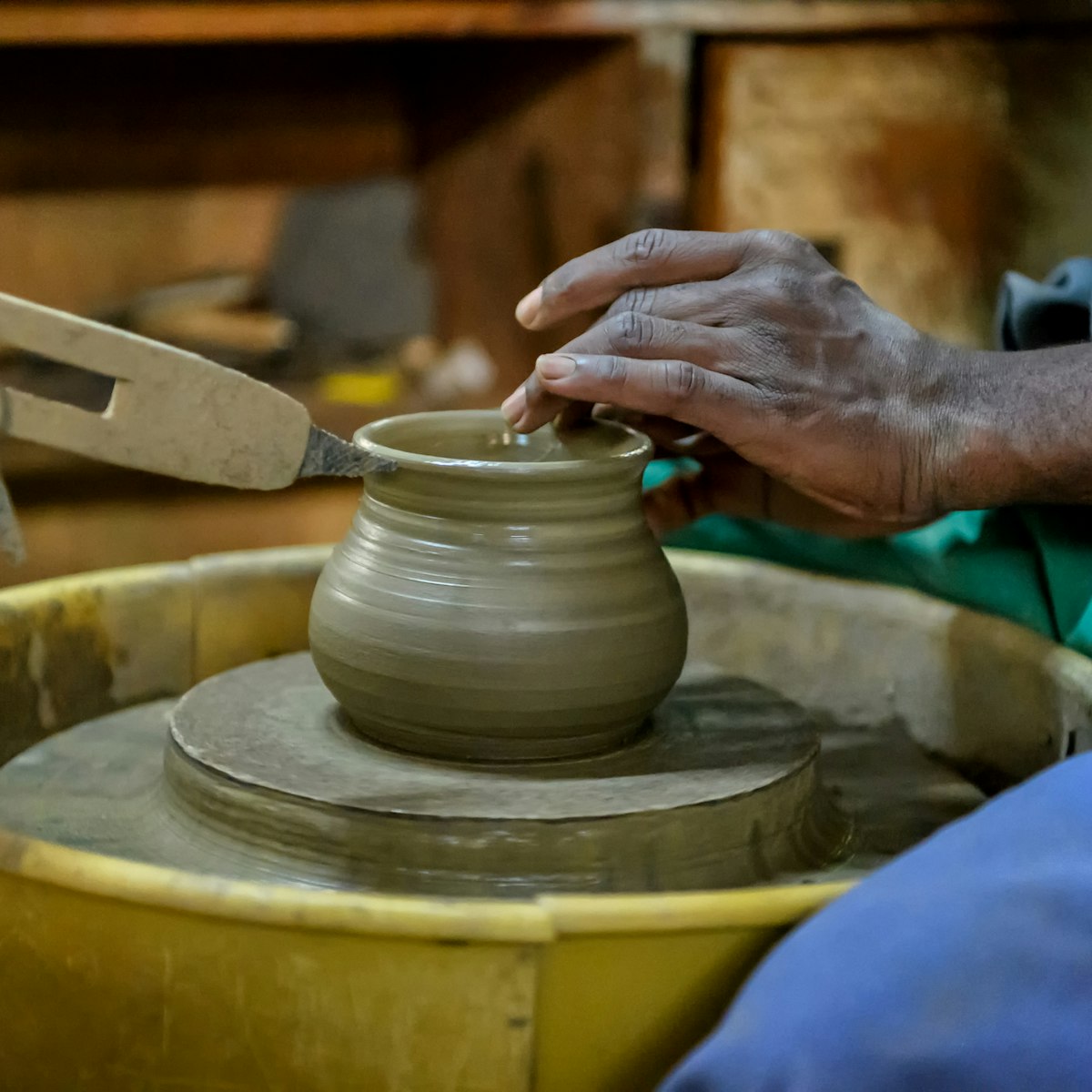
Kazuri Beads & Pottery Centre
An interesting diversion in Karen, this craft centre was started by an English expat in 1975 as a place where single mothers could learn a marketable…

Go-Down Arts Centre
The Go-Down Arts Centre, a converted warehouse in Industrial Area, contains 10 separate studios and is a hub for Nairobi's burgeoning arts scene, bringing…
Bomas of Kenya
The talented resident artists at this cultural centre perform traditional dances and songs taken from the country’s various tribal groups, including…
Railway Museum
The main collection here is housed in an old railway building and consists of relics from the East African Railway. There are train and ship models,…
Kenyatta International Conference Centre
Nairobi’s signature building was designed as a fusion of modern and traditional African styles, though the distinctive saucer tower looks a little dated…
African Heritage House
Designed by Alan Donovan, an African-heritage expert and gallery owner, this stunning exhibition house overlooking Nairobi National Park can be visited by…
Ivory-burning Site
This is one the most important landmarks in the annals of conservation: it was here that Kenyan president Daniel arap Moi made a dramatic statement to…
Nairobi Safari Walk
Just outside the main entrance to Nairobi National Park, off Langata Rd, this safari walk is a sort of zoo-meets-nature-boardwalk, with lots of birds as…
Kitengela Hot Glass
Brave the suspension bridge and enjoy a stroll around the quirky, colourful grounds of Kitengela Hot Glass. There are regular glass blowing demonstrations…
Red Hill Art Gallery
The Red Hill Art Gallery is tucked away in the lush green hills of Limuru, just outside Nairobi. The space is devoted to African Art with a focus on…
Circle Art Gallery
One of Nairobi's better exhibition spaces for contemporary art, Circle Art Gallery is, unlike some other Nairobi galleries, more a gallery aimed at…
Hippo Point Lookout
One of the best places in Nairobi National Park to see hippos.
Nairobi National Park's main concentration of hippos.
An expanse of manicured green on the fringe of the central city, this attractive park is a popular respite from the downtown noise and bustle. It owes its…
In the grounds of the National Museum, the Snake Park has some impressive snake species, including the puff adder, black mamba, Egyptian cobra, African…
Animal Orphanage
Just inside the main gate to Nairobi National Park, this animal orphanage houses formerly wild animals that have been recovered by park rangers. Although…
Parliament House
If you fancy a look at how democracy works in Kenya, it’s possible to obtain a free permit for the public gallery at Parliament House when parliament is…
Karura Forest
Karura Forest is a firm favourite among locals for walking, cycling, running and horse riding under its shady green canopy. The Sigiria entrance now has a…
Jamia Mosque
Amid the clutter of downtown, Nairobi’s main mosque is a lovely building in typical Arab-Muslim style, with all the domes, marble and Quranic inscriptions…
National Archives
Right in the bustling heart of Nairobi is the distinctive National Archives, the ‘Memory of the Nation’, a vast collection of documents and reference…
American Embassy Memorial Garden
This well-tended walled garden occupies the former site of the American embassy, which was destroyed by terrorist bombings on 7 August 1998. It’s a lovely…
Khoja Mosque
Looking for all the world like a colonial-era post office, this stone mosque for the city's Ismaili community was built in the 1920s and is one of…
Kuona Trust Centre for the Visual Arts
As much a studio for artists as a place for visitors to see art, this dynamic space hosts temporary exhibitions, artist workshops and seminars.
Python Pool
It's always worth checking what's going on at this watering hole in the park's south.
Tazama Art Gallery
Tazama displays works by Kenyan artists in a modern shopping-centre venue.
All Saints' Cathedral
An important landmark overlooking Uhuru Park, All Saints Cathedral is the city's premier Anglican house of worship.
Holy Family Cathedral
The main Catholic church in the city, this is a key downtown landmark and one of Nairobi's most important churches.
Ngong Road Forest
This forest parkland just north of Karen has walking trails, but walking here alone is not recommended.
Jomo Kenyatta Mausoleum
The last resting place of Kenya's independence president.
More destinations you need to see
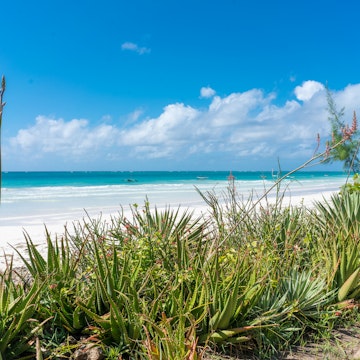
Nairobi Travel Guide: Things to Do, Itinerary, Tips, & Accommodations
- Post author By Smart Nomad Kenya Editorial
- Post date January 21, 2024
- No Comments on Nairobi Travel Guide: Things to Do, Itinerary, Tips, & Accommodations

Nairobi has positioned itself on the world map as an ideal travel destination. Started as a railway depot in 1899, the city has grown in leaps and bounds and is now home to over four million people. Famous for its unique attraction sites, diverse cultures, thrilling events, and buzzing nightlife, you’re in for a fun-filled adventure in the city.
Being Kenya’s capital, it’s a tourist, administrative, and commercial hub. Tourists in the destination visit attraction sites such as Nairobi National Park, The Maasai Market, Bomas of Kenya, and Karen Blixen Museum. For more tips and tricks about this buzzing city, continue reading this informative travel guide to Nairobi, Kenya.
Page Contents
Things to Do in Nairobi
Nairobi, being one of the liveliest cities in East Africa, has plenty of things to indulge in. Some adventures are only experienced in the capital and not anywhere else in the world. Below are the top enjoyable things to do while visiting the city.
– See wild animals at Nairobi National Park

Nairobi National Park is a unique park as it’s located in the capital city. Since its founding in 1946, the park has been home to wild animals and birds, such as cheetahs, gazelles, African leopards, and ostriches. To add to the park’s charm, it’s only minutes away from the city center and Jomo Kenyatta International Airport (JKIA). You also see Nairobi’s skyscrapers from the national park.
– Feed giraffes at Giraffe Center
Giraffe Center is a conservation park tucked in a quiet location. It’s home to some of the world’s endangered rare, giraffe species. Get up close with the giraffes and feed them with pellets that they enjoy chewing. Pass by the facility’s gift shop for lovely souvenirs as well.
– Buy handmade artifacts and souvenirs at Maasai Market
Many tourists pass by this market to buy authentic artifacts made in Kenya by creative Kenyans. These art pieces range from jewelry to carvings. Visit the market and buy something that will remind you of your tour to Nairobi.
– Take a nature walk at Nairobi Safari Walk
Nairobi Safari Walk has a raised walkway that’s used by visitors strolling around the establishment. Go for a leisure walk around the facility, seeing wild animals such as monkeys, giraffes, antelopes, and hyenas in their natural habitat. Guided tours here let you learn about the establishment and its inhabitants.
– Visit the Kenya Museum Society
A tour around the museum is fun and informative at the same time. You learn about local history and see unique pieces of art. Well-preserved guns, bows, and arrows used during Kenya’s colonial period are displayed. To top it all off, pass by the museum’s snake park and see caged snakes found in Kenya and beyond.
– Learn local history at Kenya National Archives and Documentation Service
If you’re in search of a place with pictures, publications, and paintings portraying Kenyan history, then the Kenya National Archives and Documentation Service will not disappoint. Apart from being an important landmark in Nairobi, it’s used to store historical scripts. As it’s in the heart of the capital, the establishment is easily accessible.
– Enjoy a bird’s view of Nairobi from the Kenyatta International Conference Center (KICC) rooftop

See Nairobi and its environment atop one of the tallest skyscrapers in the city — Kenyatta International Conference Center (KICC). At the rooftop, you see some of the city’s places of interest, such as Uhuru Park and City Park. Carry your camera with you to capture stunning views.
- 14 Best Places to Visit in Nairobi
What and where to eat
Food in Nairobi, Kenya is as diverse as the city’s residents. Local and international cuisines are served in eateries across the beautiful city. Read on for details about local foods to try out in some of the city’s food joints.
– Nyama choma at Njuguna’s Place

Grilled meat, also known as nyama choma , is a common delicacy in Nairobi and other parts of Kenya. The nyama choma is best eaten with Ugali. To sample finger-licking nyama choma in Nairobi, visit Njuguna’s Place. Njuguna’s Place is along Waiyaki Way and is open daily. Besides charcoal-grilled meat, the eatery serves beers and other alcoholic beverages.
– Chicken wings at CJ’s
Eat deliciously cooked chicken wings at CJ’s, a fully-fledged restaurant with an array of tasty menu items. It has branches in various parts of the city, including Village Market and Kilimani. Chicken wings at CJ’s are delicious and served in large portions. Aside from the delicious cuisine, the carefully selected theme and customer service add to the eatery’s charm.
– Fish at Mama Oliech Restaurant

Mama Oliech Restaurant is famous for its fried fish. It’s an open-air eatery serving authentic Kenyan food. Fish lovers who visit the joint choose how they’d like their fish prepared, either deep fry, boiled, or wet fry.
Here, fish is served with kachumbari , traditional vegetables, ugali, or rice. To wash it down nicely, order a soft drink or milk. In 2016, Mark Zuckerberg , Facebook’s CEO, visited this fish joint and was served fish and ugali.
– French fries at Azuri Restaurant and Café
Located in Nairobi’s central business district (CBD), Azuri Restaurant and Café prides itself on serving tasty meals at pocket-friendly prices. One common meal in this eatery is French fries or chips, as commonly referred to by locals. The meal is prepared using locally sourced ingredients and by skilled personnel. While visiting the food joint, sit on the outdoor veranda and have a view of the busy street with people going about their businesses.
– Chapatis at Hot Dishes Restaurant

With three branches in Nairobi; Kimathi Street, Kaunda Street, and Gaborone Road, Hot Dishes Restaurants have positioned themselves as premier eateries for delicious African cuisines. Enjoy unleavened flatbread (chapati) that’s prepared with customers in mind. In the yesteryears, chapatis were mostly eaten during the festive season. Nowadays, they’re a common meal among locals.
– Samosas at Talisman Restaurant
Talisman Restaurant is a classic food joint that never disappoints. It’s popular for serving tasty meals and drinks worth trying out. Visit the restaurant and enjoy finger-licking Feta and Coriander samosas. The samosas go well with any other meal of choice. Apart from the food, Talisman Restaurant has a welcoming ambiance and nice outdoor seating.
It’s worth noting that the eateries above serve a variety of meals. So, if you’re looking to sample more than one meal in the city, the food joints are good for you.
- Fine Dining: Top 14 Restaurants in Nairobi, Kenya
Things to buy
When visiting a tourist destination, it’s always good to buy items that remind you of the place. That said, Nairobi has many things for you to buy as gifts or souvenirs. Here are some fantastic items for you.

– Maasai jewelry
The Maasai community of Kenya is known to make creative pieces of art such as bangles, necklaces, and earrings. Shop for these products and carry home something that reminds you of Nairobi.
– Hand-carved wooden sculptures
Sculptures are some perfect items for decorating your home. The good thing is you have a chance to customize some Kenyan sculptures. As they vary in size, shape, and color, it’s easy to get a pocket-friendly one.
– Kenyan t-shirts
Most Kenyan branded t-shirts on sale have something Kenyan on them. Some t-shirts have a Kenyan flag, a native message such as ‘Jambo’, or a picture of a celebrity or prominent person placed on the front or back part.
– Khangas and kikois

These cotton fabrics are worn around the waist by both men and women. You’ll have various khangas and kikois to choose from, as they come in different prints, sizes, and textures. The fabrics are also used to make clothes such as skirts, shirts, and shorts.
– Kiondos

A kiondo is a handwoven handbag that’s locally used by women to carry their personal effects. The handbags are made from sisal fibers and come in different sizes. Instead of carrying your leather handbag to work daily, try out the kiondo that works perfectly well and is long-lasting, too.
Where do you buy the above items?
Buying these items in Nairobi shouldn’t be a hassle. Visit establishments such as The Maasai Market, Utamaduni Craft Centre, Village Market, and City Market for the above items, and more. While at these markets, enquire if the price is negotiable. By doing so, you might pay less for a quality product.
- A Shopper’s Paradise: The Top 10 Malls in Nairobi
Where to stay
Nairobi, Kenya is awash with accommodation facilities . Holiday homes, cottages, hotels, and serviced apartments are some accommodations available. So, whether you’re looking for a luxurious or budget-friendly boarding facility, the city has got you covered.
Websites such as Booking.com , Agoda, Expedia, and, Airbnb are perfect for finding an accommodation facility. Go for an establishment that is in a safe and convenient location. You can check out the boarding facilities below.
– Giraffe Manor
Giraffe Manor is in Lang’ata, one of Nairobi’s leafy suburbs. The 5-star hotel sits on 12 acres (4.9 hectares) of private land with Rothschild giraffes. For a restful forest stay within Nairobi, make your way to this establishment. One exciting activity in the hotel is feeding the giraffes that frequent the hotel’s premises. There are also game drives around the extensive land. Rooms have a private balcony and seating area for you to spend time outdoors.
– ibis Styles Nairobi Westlands
For whatever reason you’re in Nairobi, ibis Styles Nairobi Westlands is out to make your stay pleasant. As it’s in the Westlands neighborhood, many entertainment joints, shopping centers, and international organizations are nearby. Furthermore, Nairobi’s central business district is 5 kilometers (3.1 miles) away. Rooms in this 3-star hotel come equipped with a walk-in shower, desk, air-conditioning, and flat-screen TV, among other amenities. What’s more, you enjoy magnificent city views from the rooftop.
– Boma Inn Nairobi
If you’re in search of a hotel that’s far away from the hustle and bustle of Nairobi city yet minutes away from Jomo Kenyatta International Airport (JKIA), then consider choosing Boma Inn Nairobi . You enjoy amenities such as high-speed Wi-Fi, free parking, and complimentary breakfast while staying in the facility. On top of that, airport transfers are offered, so you don’t have to go looking for a taxi elsewhere.
– Kenya Comfort Hotel
Are you looking for a budget hotel in Nairobi’s central business district (CBD)? If yes, make Kenya Comfort Hotel a priority. This 2-star hotel is ideal for people looking to explore the capital’s nightlife as it’s minutes away from popular entertainment joints. It’s also great for people wanting to run errands in the CBD during the day. Aside from the hotel’s central location, it has friendly staff, clean rooms, and tasty meals.
– Kahama Hotel
This budget-friendly hotel is in Ngara, near Globe Roundabout. As it’s located a short distance away from the Thika superhighway, the hotel is perfect for people looking to visit towns such as Nyeri, Meru, and Thika. From the facility, it’s easy to explore beautiful destinations such as Mt. Kenya National Park, Aberdare Range, and Ol Pejeta Conservancy found outside the city.
Additionally, access to taxi services such as Uber, Bolt, and Little Cab Kenya is easy as the hotel is along a busy road. You are treated to a sumptuous breakfast in the morning and served by helpful staff throughout your stay as well.
How to get there
Nairobi is endowed with different modes of transport, ensuring the easy movement of people and goods. These modes of transport include road, rail, and air. Consider going with the options below if you’re planning on visiting the city.

– Fly to Nairobi
There are direct flights to Nairobi from different destinations around the world. From these destinations, you alight at Jomo Kenyatta International Airport (JKIA), the biggest airport in Kenya. Besides Kenya Airways, many airlines fly to Nairobi. American Airlines, Air France, British Airways, Etihad Airways, and Emirates are some examples. Upon arrival at the airport, you can travel to other parts of the city with ease. There are airport taxis and rental cars for you to use.
– Via Wilson Airport
You can access Nairobi through Wilson Airport. Unlike Jomo Kenyatta International Airport, which serves both international and local flights, Wilson Airport caters to domestic flights. You can fly to Nairobi from destinations such as Diani, Lamu, Eldoret, and Mombasa. The small airport is 4 kilometers (2.5 miles) from Nairobi’s central business district and is good for budget-friendly airlines such as Safarilink Aviation , AirKenya Express , and Skyward Express .
– Travel by car
Kenya takes pride in having a developing road network. For that reason, it’s possible to access Nairobi by road. What’s good about traveling by car is that you’re treated to magnificent landscape views along the way.
– Travel by train

Rail transport is fast improving in Kenya. The country now has a working Standard Gauge Railway (SGR) from Mombasa to Nairobi. You can travel by train to Nairobi from Mombasa in the morning, afternoon, and night. By using the train, you’re treated to scenic landscape views as the rail route cuts across magnificent Kenyan terrain.
You’ll alight at Nairobi SGR Terminus in Syokimau then proceed to other destinations using public transport such as bus, motorcycle, taxi, or the old train. Plus, you’re also directed on where to go to access the various means of transport at the terrain station. Book a seat online using this link.
Getting around Nairobi , Kenya
On arrival in Nairobi, you’ll also need to move around. There are various ways to move around to your destination of choice. Below are a few options at your disposal.
– Taxis and hailing apps
With technological advancement and the ever-changing Kenyan innovation scene, you can now hail a taxi at your convenience in Nairobi. Taxi-hailing apps such as Uber, Bolt, and Jimcab Services Ltd. are popular with both locals and tourists. The best thing is to compare prices before starting your journey by checking out different apps.
Some taxi companies, such as Delight Cabs Limited and Absolute Cabs , don’t require booking before your trip as their services are easily acquired within the city. If you want to enjoy your ride and avoid rowdy matatu/bus interactions, then opt for taxis. It’s good to use a taxi that’s fairly priced and well-kept. Prices are likely to change depending on the company of choice and distance traveled.
– Rent a car
You can also move around Nairobi using a rental car. Luckily, many car rental companies and agencies in the city, such as Hertz Car Rental and AVIS, offer car hire services. These companies have different types of cars, ranging from vans to buses. Other than visiting physical offices to hire a car, you can use online platforms such as Kayak. Pricing depends on the car type, duration of hire, time of the year, and age of the car.
If you’re driving around Nairobi for the first time, it is advisable to use the Global Positioning System (GPS) for directions. You don’t want to get lost in unfamiliar territory.
Hire a driver
Other than driving yourself around Nairobi, you can hire a driver. Where do you get professional drivers? Most companies offering car hire services have skilled private drivers that can drive you around the city. Additionally, check out sites, such as Viator for chauffeur services by top Nairobi private drivers.
– Matatu

A matatu is a mini-bus (most privately owned) ferrying people to different locations in Nairobi. You can use a matatu to travel to various parts of the city, such as Lang’ata, Westlands, and South B. The fares charged depend on the distance traveled, time, and the type of matatu. During on-peak, most matatus in the capital hike their fares. Cash is the most common method of payment.
Be vigilant
Be extra cautious while boarding matatus as some are prone to theft, such as pickpocketers and phone snatchers. Carry a few variables while traveling in matatus if necessary. Although they’re pocket-friendly and fast means of transport, the matatus have their challenges.
Travel tips
Currency : Kenyan shilling (KES)
Official language : English, Swahili
Greetings: ‘Jambo’ / ‘Mambo’ means hello. ‘Ahsante’ is Swahili for thank you.
Calling code: +254
Driving side: Left
Carry warm clothes
June and July are the coldest, so remember to carry warm clothes. Bedcovers and heaters come in handy during those chilly nights.
Like any other buzzing metropolis, Nairobi has its fair share of shortcomings. Areas in the city, including downtown Nairobi, are prone to crime. Avoid such areas whenever necessary, especially if you’re alone. Walking in groups and being vigilant are always advisable. Avoid wearing flashy items or expensive electronics while visiting crowded places.
Nairobi’s traffic is sometimes a mess. You might be stuck on the road for some time before reaching your destination. Most roads in the city experience rush hour in the morning, from 7 a.m. to 9 a.m., and in the evening, from 5 p.m. to 8 p.m.
- Tags best of Nairobi , Guide , hotels in Nairobi , Kenya , Kenya tourism , Nairobi , Nairobi Kenya travel guide , Nairobi travel , Nairobi travel guide , things to do in Kenya , things to do in nairobi
Leave a Reply Cancel reply
Your email address will not be published. Required fields are marked *
Save my name, email, and website in this browser for the next time I comment.
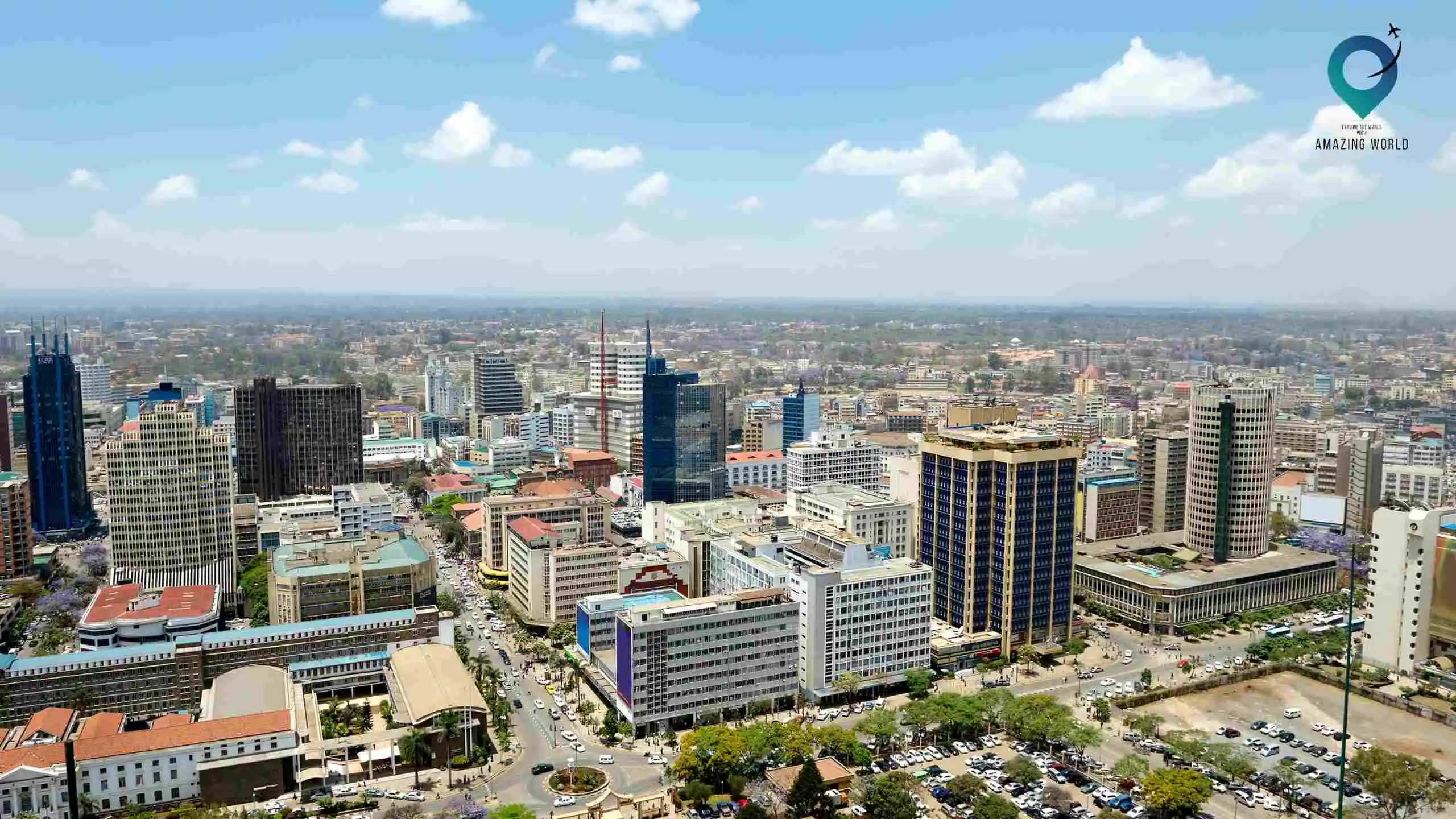
Nairobi Travel Guide: 25 Fun Things to Do and Top-Rated Tourist Attractions in 2024
- 27 minute read
- September 21, 2023
Nairobi Travel Guide: 25 Top Things to Do in Nairobi Kenya
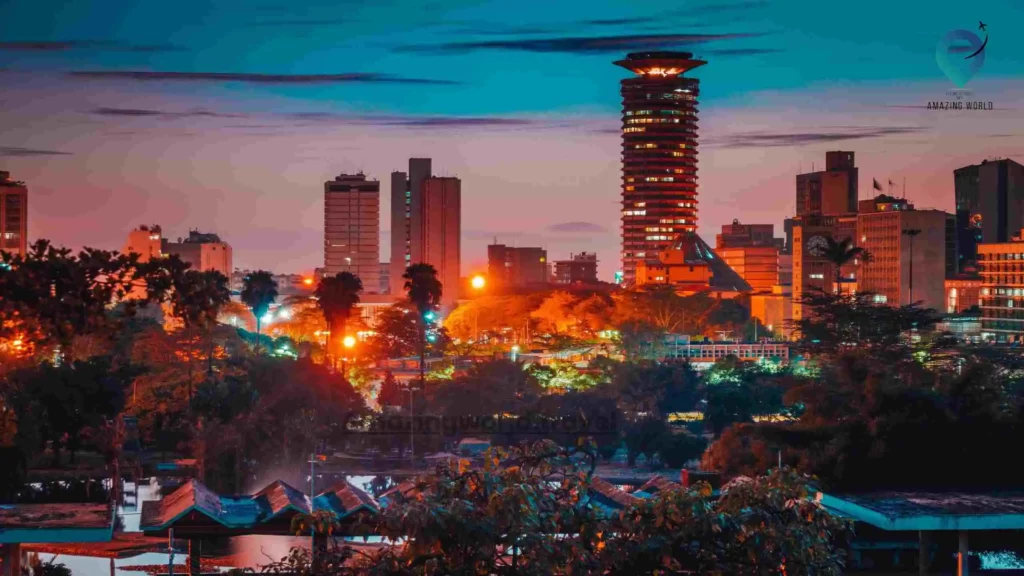
Are you planning an exciting adventure to Nairobi, Kenya, and wondering about the top attractions and activities to experience? Nairobi, often referred to as the “Green City in the Sun,” is a vibrant and diverse metropolis that offers a unique blend of wildlife encounters, cultural immersion, and natural beauty.

In this guide, we’ll dive into the must-visit places in Nairobi, such as the Karen Blixen Museum, Nairobi National Park, Giraffe Centre, and much more. Whether you’re a wildlife enthusiast, a culture buff, or a nature lover, Nairobi has something extraordinary to offer. Join us as we explore the enchanting sights and sounds of this East African gem, making your trip an unforgettable journey.
1. Nairobi National Park
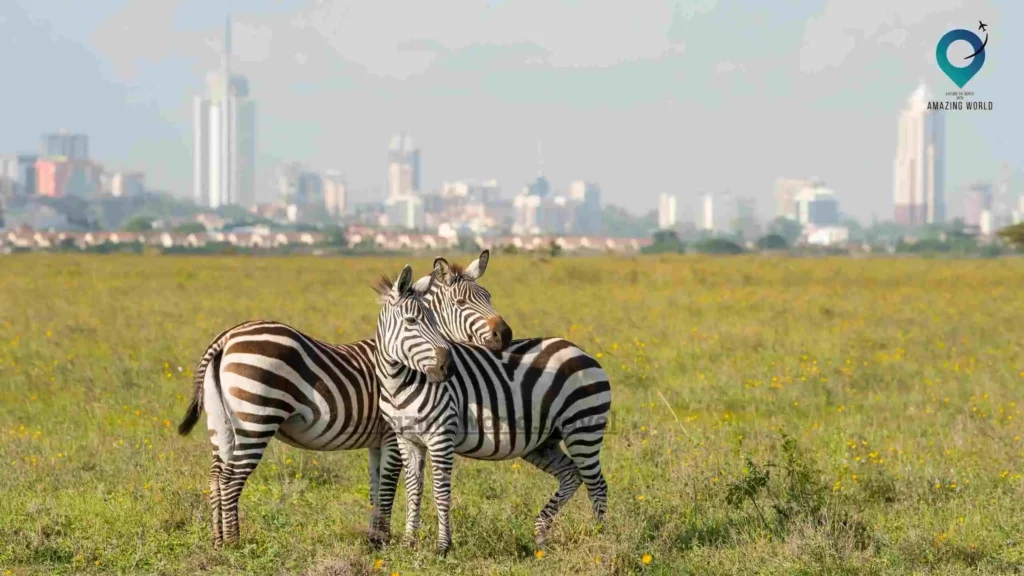
Nairobi National Park is a unique and remarkable attraction located just 8 kilometers from Nairobi’s city center. It holds a special place in the hearts of wildlife enthusiasts and nature lovers, as it’s one of the few national parks globally situated in such close proximity to a bustling capital city. Covering approximately 117 square kilometers, the park offers an incredible opportunity to witness Kenya’s diverse wildlife and pristine natural beauty.
How to Reach Nairobi National Park:
- By Car: The most convenient way to reach Nairobi National Park is by car. Visitors can hire a taxi or use ridesharing services, which are readily available in Nairobi. The park entrance is easily accessible by road.
- Public Transportation: For those looking for a more budget-friendly option, public buses also serve the route to Nairobi National Park. These buses can be found at various points in the city center.
Best Things to Do:
- Wildlife Safari: Nairobi National Park is renowned for its captivating wildlife safaris. Visitors have the opportunity to witness iconic African animals such as lions, cheetahs, black rhinos, hippos, giraffes, zebras, and numerous bird species.
- Bird Watching: The park is a haven for birdwatchers, boasting over 400 bird species. Bring your binoculars to spot various avian species, including ostriches, secretary birds, and marabou storks.
- Photography: With its diverse landscapes and incredible wildlife, the park offers exceptional photography opportunities. Capture stunning shots of animals against the backdrop of Nairobi’s skyline.
Top Attractions at Nairobi National Park:
- The Big Five: Nairobi National Park is famous for being home to the Big Five game animals: lions, elephants, buffaloes, leopards, and rhinoceroses. Observing these magnificent creatures in their natural habitat is a highlight for many visitors.
- David Sheldrick Wildlife Trust: Within the park, you can visit the David Sheldrick Wildlife Trust, a renowned sanctuary for orphaned baby elephants. Here, you can witness the caretakers’ incredible work as they rehabilitate and prepare these young elephants for their return to the wild. It’s a heartwarming experience that allows you to get up close to these gentle giants.
- Ivory Burning Site Monument: This historic site commemorates the burning of confiscated elephant ivory by Kenyan authorities in 1989, signaling Kenya’s commitment to conservation. The monument serves as a poignant reminder of the ongoing fight against poaching and the importance of protecting endangered wildlife.
Also, if you are looking best hotels and Homestay deals then we recommend booking your hotels and homestay with priceline.com
2. Karen Blixen Museum
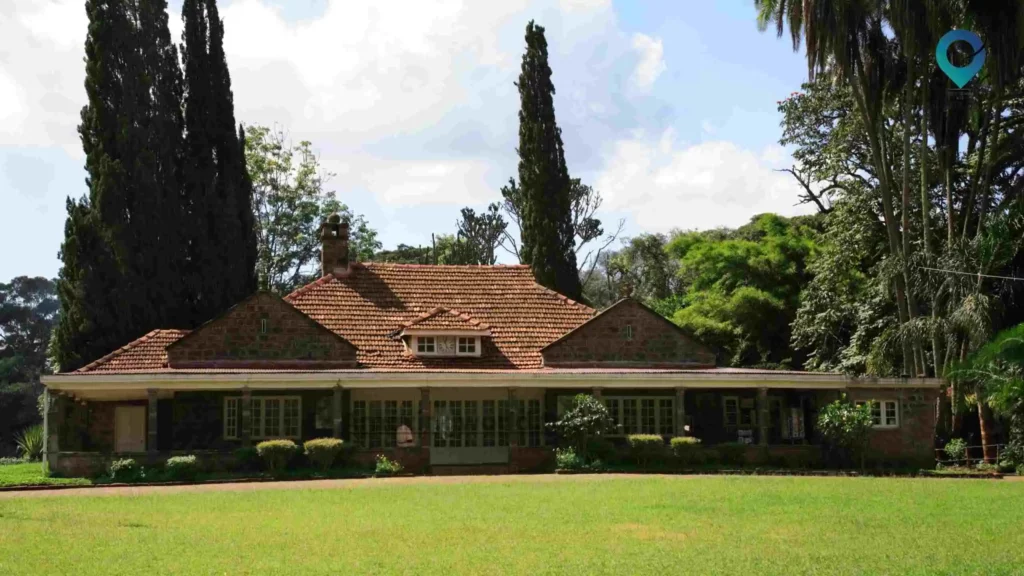
The Karen Blixen Museum is a historic landmark situated in the tranquil Karen suburb of Nairobi. It was the former home of Karen Blixen, a Danish author famous for her book “Out of Africa,” which depicts her life in Kenya. The museum provides a glimpse into the colonial past of Kenya and the life of this renowned writer.
How to Reach Karen Blixen Museum:
- Taxi or Ride-Sharing Apps: The most convenient way to reach the Karen Blixen Museum is by taking a taxi or using ride-sharing apps like Uber or Bolt. Simply enter “Karen Blixen Museum” as your destination, and a driver will take you there.
- Matatu or Bus: Matatus (shared minivans) and city buses are commonly used for public transportation in Nairobi. While there might not be a direct bus route to the museum, you can inquire with locals or at bus stops for routes that pass by or are close to Karen Blixen Museum. From the nearest bus stop, you can walk to the museum.
- Explore the Historic House: Visitors can explore Karen Blixen’s beautifully preserved home, which is furnished with period pieces. It offers an authentic glimpse into the colonial era in Kenya.
- Gardens and Scenery: The museum is set amidst lush gardens with scenic views. Take a leisurely stroll through the grounds and enjoy the serene surroundings.
- Learn About Karen Blixen: The museum provides valuable insights into the life and works of Karen Blixen, allowing visitors to better understand the author’s connection to Kenya.
Top Attractions at Karen Blixen Museum:
- Karen Blixen’s Study: One of the highlights is the study where Karen Blixen wrote her famous book “Out of Africa.” It’s a must-visit spot for literature enthusiasts.
- Film Location: The museum’s location was used for filming scenes from the Academy Award-winning movie “Out of Africa,” adding to its historical significance.
3. David Sheldrick Wildlife Trust (Elephant Orphanage)

The David Sheldrick Wildlife Trust, also known as the Elephant Orphanage, is a renowned conservation organization dedicated to rescuing and rehabilitating orphaned elephants and rhinos. It’s a heartwarming and educational place to visit, especially for those interested in wildlife conservation.
How to Reach David Sheldrick Wildlife Trust:
- By Car: The trust is located on Mbagathi Road in Karen, Nairobi. It’s easily accessible by car, taxi, or ridesharing services.
- Adopt an Elephant: Visitors have the opportunity to “adopt” an orphaned elephant and contribute to its care and rehabilitation.
- Meet the Baby Elephants: The highlight of the visit is the chance to see and interact with adorable baby elephants during their feeding time.
- Learn About Conservation: The trust provides valuable information about the conservation efforts to protect elephants and rhinos, making it a great educational experience.
Top Attractions at David Sheldrick Wildlife Trust:
- Elephant Feeding: Watching the baby elephants being fed with milk is a heartwarming experience. Visitors can observe them up close and learn about their stories.
- Nursery Area: The trust has a nursery where you can see the youngest orphaned elephants and hear about their rescue and rehabilitation journeys.
4. Nairobi National Museum

The Nairobi National Museum is a cultural and historical treasure trove, located on Museum Hill. It’s a hub for art, history, and natural history exhibitions, showcasing Kenya’s diverse heritage.
How to Reach Nairobi National Museum:
- By Car: The museum is situated on Kipande Road, easily accessible by car, taxi, or ridesharing services from the city center.
- Art and Culture Exhibits: Explore a rich collection of African art, contemporary art, and cultural artifacts that offer insights into Kenya’s heritage.
- Natural History: The museum features exhibits on paleontology, archaeology, and geology, including fossil discoveries from East Africa.
- Botanical Gardens: Stroll through the museum’s botanical gardens, which feature indigenous plant species, sculptures, and outdoor exhibits.
Top Attractions at Nairobi National Museum:
- Pride of Kenya: This iconic sculpture at the museum’s entrance represents Kenya’s cultural diversity, and it’s a popular spot for photos.
- Prehistoric Gallery: Discover the fascinating history of human evolution and prehistoric discoveries in East Africa through interactive displays.
5. Giraffe Centre

The Giraffe Centre, located on Duma Road in Karen, Nairobi, is dedicated to the conservation of the endangered Rothschild’s giraffe. It offers visitors a unique opportunity to get up close and personal with these gentle giants.
How to Reach Giraffe Centre:
- By Car: The Giraffe Centre is a short drive from the city center and is easily accessible by car, taxi, or ridesharing services.
- Feeding the Giraffes: One of the main attractions is the chance to feed and interact with the giraffes on a raised platform. It’s an unforgettable experience.
- Nature Walks: Explore the sanctuary’s nature trails, which lead to a small wetland area and provide opportunities for birdwatching.
- Learn About Conservation: The Giraffe Centre focuses on giraffe conservation and education. Visitors can learn about the efforts to protect these majestic creatures.
Top Attractions at Giraffe Centre:
- Rothschild’s Giraffes: The sanctuary is home to Rothschild’s giraffes, which are one of the most endangered giraffe subspecies. Witnessing them up close is a highlight.
- Nature Trails: Take a walk along the nature trails to enjoy the serene surroundings and learn about the local ecosystem.
6. Bomas of Kenya
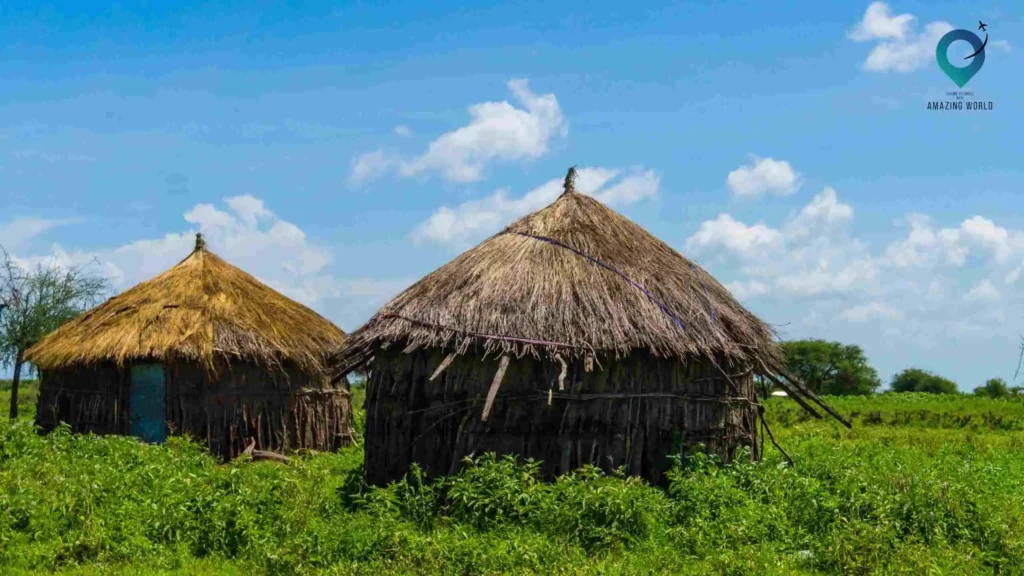
Bomas of Kenya is a living museum located on Langata South Road in Nairobi. It offers visitors a unique opportunity to experience Kenya’s diverse cultures and traditions through dance, music, and arts. “Boma” means homestead in Swahili, and this cultural center is a collection of traditional homesteads representing various Kenyan ethnic groups.
How to Reach Bomas of Kenya:
Taxi or Ride-Sharing Apps: Taking a taxi or using ride-sharing apps like Uber or Bolt is one of the most convenient and hassle-free ways to reach Bomas of Kenya. Simply enter “Bomas of Kenya” as your destination, and a driver will take you there.
Matatu or Bus: Matatus (shared minivans) and city buses are commonly used for public transportation in Nairobi. While there might not be a direct bus route to Bomas of Kenya, you can inquire with locals or at bus stops for routes that pass by or are close to the cultural center. From the nearest bus stop, you can walk to Bomas of Kenya.
- Cultural Performances: Watch captivating cultural performances showcasing traditional music, dance, and costumes from different Kenyan tribes.
- Explore Traditional Homesteads: Visit the various homesteads within the center to learn about the lifestyles, artifacts, and architecture of Kenya’s diverse communities.
- Craft Market: Explore the craft market within Bomas where you can purchase traditional Kenyan handicrafts and souvenirs.
Top Attractions at Bomas of Kenya:
- Cultural Diversity: The main attraction is experiencing the rich cultural diversity of Kenya in one place, making it a unique and educational experience.
- Cultural Shows: Don’t miss the daily cultural shows featuring traditional dances and music from various ethnic groups.
7. Railway Museum
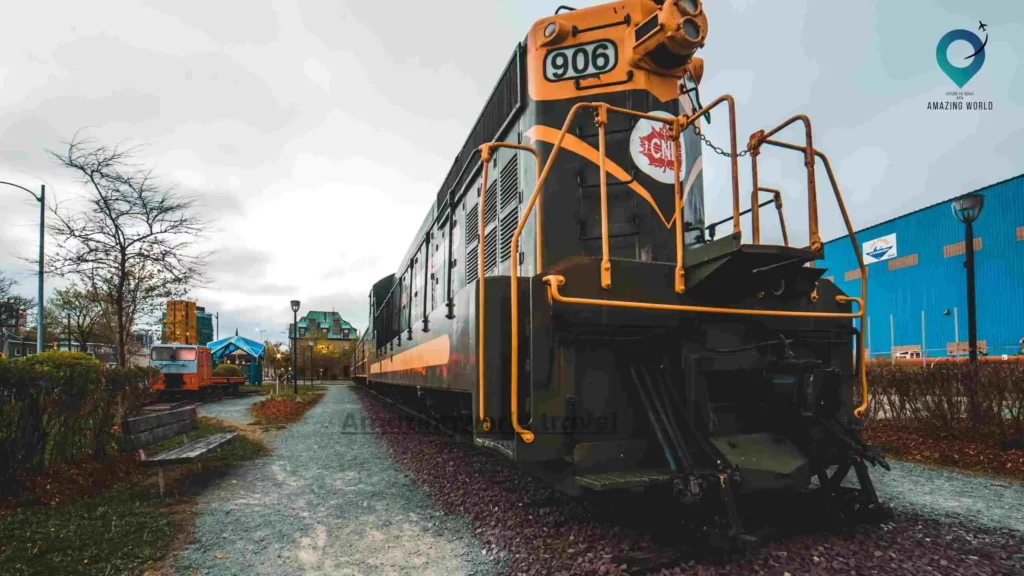
The Nairobi Railway Museum, located on Station Road, Nairobi, is a fascinating destination for history and train enthusiasts. It showcases Kenya’s railway history, with an impressive collection of vintage locomotives, carriages, and historical artifacts.
How to Reach Railway Museum:
Taxi or Ride-Sharing Apps: Taking a taxi or using ride-sharing apps like Uber or Bolt is one of the most convenient ways to reach the Nairobi Railway Museum. Simply input “Nairobi Railway Museum” as your destination, and a driver will take you there.
Matatu or Bus: Matatus (shared minivans) and city buses are commonly used for public transportation in Nairobi. While there might not be a direct bus route to the museum, you can inquire with locals or at bus stops for routes that pass by or are close to the museum. From the nearest bus stop, you can walk to the museum.
- Explore Vintage Trains: The museum houses a diverse collection of vintage trains, including the famous Lunatic Express, which played a significant role in Kenya’s history.
- Learn About Rail History: Visitors can delve into Kenya’s railway history and its impact on the country’s development.
- Train Rides: On special occasions, the museum offers train rides, providing a unique experience for visitors.
Top Attractions at Railway Museum:
- Lunatic Express: The centerpiece of the museum is the British-built Lunatic Express locomotive, which was a part of the historic Uganda Railway.
- Historical Artifacts: The museum also features historical artifacts, photographs, and documents related to Kenya’s railway history.
8. Kazuri Beads Factory
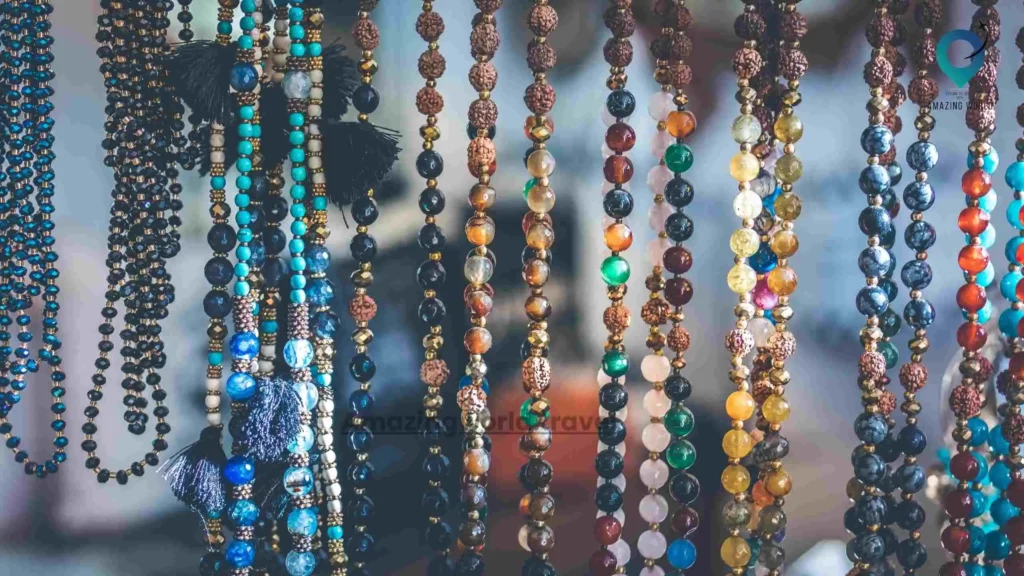
Kazuri Beads Factory, located on Mbagathi Ridge, Nairobi, is a unique and socially responsible enterprise that produces beautifully handcrafted ceramic beads and pottery. It’s an excellent place to explore Kenyan craftsmanship and support local artisans.
How to Reach Kazuri Beads Factory:
- Taxi or Ride-Sharing Apps: The most convenient way to reach Kazuri Beads Factory is by taking a taxi or using ride-sharing apps like Uber or Bolt. These services are readily available in Nairobi, and you can simply input “Kazuri Beads Factory” as your destination.
- Matatu or Bus: Matatus (shared minivans) and city buses are common modes of public transportation in Nairobi. While Kazuri Beads Factory may not have a direct bus stop, you can inquire with locals or at bus stops for routes that pass by or are close to the factory. From the nearest bus stop, it may be a short walk to the factory.
- Guided Tour: Take a guided tour of the factory to see the intricate process of bead-making and pottery production.
- Shopping: The factory has a shop where you can purchase exquisite ceramic beads, pottery, and other handmade crafts, making it an ideal place for souvenir shopping.
- Learn About Empowerment: Kazuri Beads is known for its social impact, providing employment opportunities for disadvantaged women. Learn about their empowering initiatives.
Top Attractions at Kazuri Beads Factory:
- Handcrafted Beads: The colorful and unique ceramic beads are the highlight of the factory. They are perfect for creating jewelry and accessories.
- Empowerment Story: Discover the inspiring story behind Kazuri Beads and how it has positively impacted the lives of local women.
9. Kenyatta International Conference Centre (KICC)

The Kenyatta International Conference Centre is an iconic skyscraper and conference center situated on Harambee Avenue in Nairobi. It is one of Nairobi’s most recognizable landmarks and offers stunning panoramic views of the city from its rooftop.
How to Reach Kenyatta International Conference Centre:
- Taxi or Ride-Sharing Apps: The easiest way to reach KICC is by taking a taxi or using ride-sharing apps like Uber or Bolt. Simply input “Kenyatta International Conference Centre” as your destination, and the driver will know the way. This option is comfortable and efficient.
- Matatu or Bus: Matatus, which are shared minivans, and city buses are a common means of public transportation in Nairobi. You can inquire with locals or at a bus stop for a matatu or bus route that goes to KICC or the city center. Most public transportation options will have stops near KICC.
- Rooftop Views: Visit the rooftop for breathtaking panoramic views of Nairobi. It’s a popular spot for photography.
- Explore Exhibitions: KICC hosts various exhibitions, conferences, and events. Check the schedule for any interesting events during your visit.
- Historical Significance: Learn about the historical significance of KICC as a symbol of Kenya’s independence and growth.
Top Attractions at Kenyatta International Conference Centre:
- Helipad: The helipad on the rooftop is a notable feature. Even if you don’t arrive by helicopter, it’s worth visiting for the views.
- Swahili Architecture: KICC’s architecture reflects Swahili design elements, and the building itself is an architectural marvel.
10. Ngong Hills
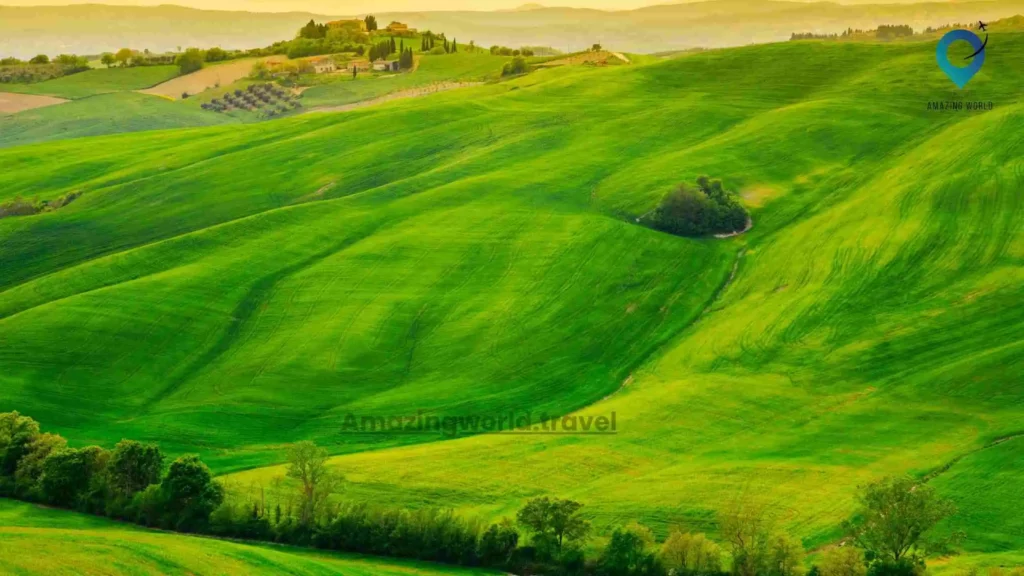
Ngong Hills, located in Kona Baridi, Ngong, just outside Nairobi, is a series of rolling hills with lush greenery and scenic viewpoints. They offer a perfect escape from the city into nature’s tranquility.
How to Reach Ngong Hills:
- By Car: Ngong Hills are about a 30-minute drive from Nairobi’s city center. You can take a taxi or use ridesharing services to reach the hills.
- Hiking: Ngong Hills is a popular hiking destination. You can explore various trails and enjoy the stunning vistas along the way.
- Picnicking: The hills are an excellent spot for picnics. Bring some snacks and enjoy a meal amidst the beautiful natural surroundings.
- Photography: Ngong Hills offers fantastic photo opportunities, especially during sunrise and sunset.
Top Attractions at Ngong Hills:
- Viewpoints: The hills provide stunning panoramic views of Nairobi and the Great Rift Valley. “Out of Africa” scenes were also filmed here.
- Birdwatching: Bird enthusiasts can spot various bird species while hiking.
11. National Archives
View this post on Instagram A post shared by Kenya National Archives (@kenyanationalarchives)
The National Archives of Kenya, located on Moi Avenue in Nairobi, is a repository of historical and cultural records. It’s a valuable institution that preserves Kenya’s history, including documents, photographs, and artifacts.
How to Reach National Archives:
- Matatus are shared minivans and a popular mode of transportation in Nairobi. You can take a matatu that goes to the city center or along Moi Avenue, where the National Archives is located. Ask the conductor or locals for the nearest stop.
- Alternatively, you can take a city bus that passes through the city center, and then it’s a short walk to the National Archives.
- You can hire a taxi or use ride-sharing apps like Uber or Bolt. Simply input “National Archives, Moi Avenue” as your destination, and the driver will take you there directly. This is a convenient option if you prefer a more private and comfortable ride.
- Historical Research: The National Archives is an excellent place for researchers and history enthusiasts to delve into Kenya’s rich past through its extensive collection of documents.
- Exhibitions: Check for any exhibitions or displays featuring historical artifacts, photographs, and records.
- Architectural Beauty: The building itself is a piece of architectural history and worth admiring.
Top Attractions at National Archives:
- Historical Documents: The collection includes historical documents dating back to Kenya’s pre-independence period, providing insight into the nation’s journey.
- Photograph Archive: The photograph archive showcases images capturing Kenya’s history, from colonial times to independence and beyond.
12. Kibera Slum
View this post on Instagram A post shared by alison (@alisonfromashes)
Kibera is one of Africa’s largest slums and is located in Nairobi. While it may not be a typical tourist attraction, it’s an important place to understand the challenges faced by marginalized communities in the city.
How to Reach Kibera Slum:
- By Car: Kibera is accessible by car or taxi. However, it’s advisable to visit with a local guide or as part of an organized tour for safety and to gain a better understanding of the community.
- Guided Tour: Join a guided tour of Kibera to learn about the daily lives, challenges, and community initiatives of its residents.
- Community Engagement: Some tours offer opportunities to interact with local residents and support community projects.
- Educational Experience: While visiting a slum may not be typical tourism, it can be an eye-opening and educational experience to better understand urban poverty and grassroots efforts for change.
Top Attractions at Kibera Slum:
- Community Resilience: Witness the resilience and resourcefulness of Kibera’s residents who have created vibrant communities despite challenging conditions.
- Local Initiatives: Learn about local initiatives and NGOs working to improve living conditions and provide educational opportunities within the slum.
13. Karura Forest
View this post on Instagram A post shared by Friends of Karura Forest (@karurafriends)
About Karura Forest: Karura Forest, situated on Kiambu Road in Nairobi, is a lush urban forest reserve. It provides a serene escape from the hustle and bustle of the city, with walking trails, waterfalls, and diverse flora and fauna.
How to Reach Karura Forest:
- By Car: Karura Forest is a short drive from Nairobi’s city center and easily accessible by car or taxi.
- Nature Walks: Explore the forest through its well-maintained walking trails. You can choose from short walks to longer hikes.
- Waterfalls: Discover the beautiful waterfalls within the forest. Karura Falls is a popular spot for relaxation and photography.
- Birdwatching: Karura Forest is home to numerous bird species, making it a haven for birdwatchers and nature enthusiasts.
Top Attractions at Karura Forest:
- Caves and Crevices: The forest features caves and crevices that add an element of adventure to your visit.
- Environmental Conservation: Karura Forest is actively involved in environmental conservation efforts, making it an ideal place to learn about local sustainability initiatives.
14. Ruaka Falls
View this post on Instagram A post shared by Runda Falls garden in RUAKA. (@rundafallsgardenin)
About Ruaka Falls: Ruaka Falls is a picturesque waterfall located within Karura Forest, Nairobi. It’s a tranquil spot where visitors can enjoy the beauty of nature and the soothing sound of flowing water.
How to Reach Ruaka Falls:
- By Car: The most convenient way to get to Ruaka Falls is by car, especially if you’re starting from Nairobi city center. Here are the step-by-step directions:
1. Begin by heading north from Nairobi’s city center on Uhuru Highway.
2. Take the Thika Road (A2) towards Thika Town.
3. Continue on Thika Road until you reach the Northern Bypass Road (A104).
4. Take the Northern Bypass westbound towards Runda and Village Market.
5. Exit the Northern Bypass onto Limuru Road (B49).
6. Continue on Limuru Road for several kilometers, passing through the neighborhoods of Gigiri and Muthaiga.
7. After passing Karura Forest on your left, watch for signs indicating Ruaka Falls. There should be a parking area nearby.
- Taxi or Ride-Sharing: You can also use taxi services or ride-sharing apps like Uber or Bolt to reach Ruaka Falls. Simply enter “Ruaka Falls” as your destination, and the driver will follow the best route.
- Scenic Spot: Enjoy the scenic beauty of the waterfall, surrounded by lush greenery.
- Photography: Capture the natural beauty of Ruaka Falls, especially during the rainy season when the falls are at their fullest.
Top Attractions at Ruaka Falls:
- Nature’s Retreat: Ruaka Falls provides a peaceful retreat within the heart of the city, making it a perfect place to unwind and connect with nature.
- Biodiversity: While at Ruaka Falls, take note of the diverse plant and animal life that thrives in the forest.
15. Nairobi Animal Orphanage
View this post on Instagram A post shared by mariko (@pole_pole03)
About Nairobi Animal Orphanage: The Nairobi Animal Orphanage is located within the Nairobi National Park and serves as a sanctuary for orphaned and injured animals. It’s a unique opportunity to get up close to Kenya’s wildlife and contribute to conservation efforts.
How to Reach Nairobi Animal Orphanage:
- Start from the city center and head southeast on Langata Road.
- Nairobi National Park, where the orphanage is located, is well-signposted along the way.
- Follow the signs to Nairobi National Park, and you’ll eventually reach the entrance gate.
- Pay the park entrance fee, and you’ll be directed to the orphanage, which is within the park.
- Taxi or Ride-Sharing: You can also hire a taxi or use ride-sharing apps like Uber or Bolt to get to Nairobi Animal Orphanage. Simply enter the orphanage’s name as your destination, and a driver will take you there.
- Wildlife Viewing: Explore the orphanage and witness various species of animals, including lions, cheetahs, giraffes, and more. The animals here are being rehabilitated for possible release back into the wild.
- Educational Experience: Learn about the conservation work being done to protect Kenya’s wildlife. The orphanage often hosts educational programs for visitors.
Top Attractions at Nairobi Animal Orphanage:
- Big Cats: The orphanage is known for its big cat conservation efforts, and you can see young lions and cheetahs up close.
- Giraffe Center: Adjacent to the orphanage is the Giraffe Center, where you can learn about and feed giraffes.
16. Uhuru Gardens
Uhuru Gardens, located on Langata Road, is a historical park in Nairobi. It’s home to the “Uhuru Monument,” which marks Kenya’s independence from British colonial rule in 1963.
How to Reach Uhuru Gardens:
- By Car: The most convenient way to reach Uhuru Gardens is by car. If you’re in Nairobi’s city center, head southwest on Langata Road. Continue on this road for approximately 6 kilometers. You’ll find clear signposts directing you to Uhuru Gardens. The park has a dedicated parking area for visitors.
- Taxi or Ride-Sharing: Taxi services like regular cabs or ride-sharing apps such as Uber and Bolt are readily available in Nairobi. Simply enter “Uhuru Gardens” as your destination in the app, and a driver will take you there. This option is convenient if you prefer not to drive yourself.
- Historical Visit: Explore the park and the Uhuru Monument, which is an important symbol of Kenya’s independence.
- Picnic and Relaxation: Uhuru Gardens offers a serene environment for picnics and relaxation with its well-maintained lawns and shade-providing trees.
Top Attractions at Uhuru Gardens:
- Uhuru Monument: The monument itself is the main attraction, and it holds great historical significance for Kenya.
17. Oloolua Nature Trail
Oloolua Nature Trail, located in Karen, Nairobi, offers a natural escape for those looking to connect with Kenya’s diverse flora and fauna. It’s a peaceful oasis within the city.
How to Reach Oloolua Nature Trail:
- By Car: The most convenient way to reach Oloolua Nature Trail is by car. If you’re in Nairobi city center, drive southeast on Langata Road. After passing the Bomas of Kenya, continue for approximately 5 kilometers. Look for signposts indicating the Oloolua Nature Trail, which will direct you to the entrance.
- Taxi or Ride-Sharing: You can also use taxi services or ride-sharing apps like Uber or Bolt to reach Oloolua Nature Trail. Simply input the destination as “Oloolua Nature Trail” or provide the address, and the driver will take you there.
- Nature Walks: Explore the trail on foot, meandering through the lush forested area and enjoying the tranquil surroundings.
- Birdwatching: The trail is a paradise for birdwatchers, with various bird species to spot and identify.
Top Attractions at Oloolua Nature Trail:
- Scenic Beauty: Oloolua Nature Trail is known for its natural beauty, including a small river and waterfalls.
- Botanical Interest: The trail is home to a variety of indigenous plant species, making it an excellent place for botanical enthusiasts.
18. Nairobi Arboretum
View this post on Instagram A post shared by Michele Lanzoni (@rainforest_project)
The Nairobi Arboretum, located on State House Road in Kilimani, Nairobi, is a botanical garden that showcases a diverse collection of trees and plants. It’s a green oasis in the city.
How to Reach Nairobi Arboretum:
- By Car: Nairobi Arboretum is easily accessible by car or taxi.
- Botanical Exploration: Take a leisurely stroll through the arboretum and explore the different tree and plant species, some of which are labeled for educational purposes.
- Picnicking: The arboretum provides picnic spots, making it a great place for a relaxing outdoor meal.
Top Attractions at Nairobi Arboretum:
- Tree Diversity: The arboretum boasts an impressive variety of tree species, both indigenous and exotic, making it a valuable resource for botanical enthusiasts and researchers.
- Birdwatching: Nairobi Arboretum is also home to a diverse bird population, offering birdwatchers an opportunity to spot and identify different species.
19. Uhuru Park
Uhuru Park, situated along Uhuru Highway in Nairobi, is a public park that provides a peaceful oasis in the bustling city. The park is known for its beautiful green spaces and a man-made lake.
How to Reach Uhuru Park:
- By Car: You can easily reach Uhuru Park by car or taxi. It’s centrally located in Nairobi.
- Boat Rides: Enjoy paddle boating on the park’s lake for a serene experience surrounded by lush greenery.
- Picnicking: Uhuru Park is a great spot for picnics and relaxation. Many locals and visitors come here to unwind.
Top Attractions at Uhuru Park:
- Freedom Corner: This corner of the park has historical significance as it was a site for political rallies and demonstrations during Kenya’s struggle for independence.
20. Lake Naivasha
Lake Naivasha, located in Nakuru County, is one of Kenya’s Great Rift Valley lakes. It’s known for its stunning scenery, diverse birdlife, and opportunities for boat safaris.
How to Reach Lake Naivasha:
- By Car: Lake Naivasha is about a 90-minute drive from Nairobi.
- Boat Safaris: Explore the lake by taking a boat safari. You can spot hippos, waterbirds, and even giraffes on Crescent Island, which is accessible from the lake.
- Hiking: There are various hiking trails around the lake and nearby Hell’s Gate National Park for adventure enthusiasts.
Top Attractions at Lake Naivasha:
- Birdwatching: Lake Naivasha is a haven for birdwatchers, with over 400 bird species, including African fish eagles and pelicans.
- Crescent Island: Visit Crescent Island Game Park, located in the middle of the lake, for a unique walking safari experience.
21. Ol Donyo Sabuk National Park
Located in Machakos County, Ol Donyo Sabuk National Park is a protected area known for its diverse wildlife and the prominent Ol Donyo Sabuk Mountain, which offers panoramic views of the surrounding plains.
How to Reach Ol Donyo Sabuk National Park:
- By Car: You can drive to the park from Nairobi, which is approximately a 1.5-hour journey.
- Hiking: Climb Ol Donyo Sabuk Mountain for breathtaking views and a chance to spot wildlife such as baboons and bushbucks.
- Picnicking: The park provides picnic facilities, allowing visitors to enjoy a meal in the midst of nature.
Top Attractions at Ol Donyo Sabuk National Park:
- Fourteen Falls: Nearby Thika town, you can visit the scenic Fourteen Falls, a series of cascading waterfalls on the Athi River.
- Buffalo Viewing: Ol Donyo Sabuk is known for its resident buffalo population, and you might spot these majestic creatures during your visit.
22. Tana River
The Tana River is Kenya’s longest river, flowing from the Aberdare Mountains to the Indian Ocean. It offers diverse landscapes, including riverine forests and arid plains.
How to Reach Tana River:
- By Car: You can access various points along the Tana River by car, depending on your chosen route.
- River Adventures: Explore the river through activities like white-water rafting, kayaking, and boat safaris, offering an adrenaline rush in a stunning natural setting.
- Birdwatching: The river and its surrounding areas are home to a variety of bird species, making it a birdwatcher’s paradise.
Top Attractions along Tana River:
- Hiking: The Tana River area offers opportunities for hiking, with picturesque landscapes and chances to discover local flora and fauna.
- Cultural Experiences: Interact with local communities along the riverbanks to learn about their traditions and way of life.
23. Nairobi Gallery
Nairobi Gallery, situated on Kenyatta Avenue in Nairobi, is a historic building that houses a collection of contemporary and traditional African art. The gallery is housed in the former Old PC’s office and is a fine example of colonial architecture.
How to Reach Nairobi Gallery:
- By Car: You can easily reach the Nairobi Gallery by car or taxi as it’s centrally located in Nairobi.
- Art Appreciation: Explore the diverse art collection, which includes paintings, sculptures, and artifacts, providing insights into Kenya’s rich cultural heritage.
- Architecture: Appreciate the stunning colonial-era architecture of the building itself, which is a work of art.
Top Attractions at Nairobi Gallery:
- Temporary Exhibitions: Check out any temporary exhibitions or art events that may be happening during your visit, as the gallery frequently hosts such events.
24. Jamia Mosque Nairobi
Jamia Mosque Nairobi, located at the intersection of Banda Street and Kigali Street in Nairobi, is one of the most prominent and historic mosques in Kenya. It serves as a place of worship for the Muslim community and is an architectural gem.
How to Reach Jamia Mosque Nairobi:
- By Car: The mosque is centrally located in Nairobi and can be reached easily by car or taxi.
- Architectural Appreciation: The mosque’s architecture is a blend of traditional Islamic and modern designs, making it a captivating sight for visitors.
- Cultural Experience: Visitors can explore the mosque’s inner courtyard and, if respectful of Islamic customs, observe the prayer sessions.
Top Attractions at Jamia Mosque Nairobi:
- Historical Significance: Learn about the history of the mosque, which has been an essential center for Nairobi’s Muslim community for many decades.
25. Fedha Valley Arcade Shopping Mall
Fedha Valley Arcade Shopping Mall, located on Gitanga Road in Nairobi, is a contemporary shopping complex that offers a wide range of retail stores, dining options, and entertainment facilities.
How to Reach Fedha Valley Arcade Shopping Mall:
- By Car: The mall is easily accessible by car or taxi and is situated in the Kilimani area of Nairobi.
- Shopping: Explore the various stores within the mall, offering clothing, accessories, electronics, and more, making it a great place for shopping.
- Dining: Enjoy a meal at one of the mall’s restaurants or cafes, offering a variety of cuisines to suit different tastes.
Top Attractions at Fedha Valley Arcade Shopping Mall:
- Entertainment: Some malls host events and entertainment activities, so check if any events are happening during your visit.
26. The Hub Karen
The Hub Karen is a popular shopping and entertainment complex located in the Karen suburb of Nairobi. It’s a vibrant destination for both locals and tourists, offering a wide range of shopping, dining, and leisure options.
How to Reach the Hub Karen:
- By Car: The Hub Karen is easily accessible by car or taxi, situated in the Karen suburb of Nairobi.
- Shopping: Explore the various retail stores offering fashion, electronics, home decor, and more.
- Dining: Enjoy a meal at one of the many restaurants and cafes, serving diverse cuisines.
- Entertainment: The complex often hosts events, movie screenings, and live performances, so check the schedule for any ongoing activities.
Top Attractions at The Hub Karen:
- Open-Air Setting: The Hub Karen features an open-air design, allowing visitors to enjoy the pleasant Nairobi weather while shopping and dining.
27. Two Rivers Mall
Two Rivers Mall, located on Limuru Road in the Ruaka area of Nairobi, is one of the largest shopping malls in East Africa. It offers a vast selection of shops, restaurants, and entertainment options.
How to Reach Two Rivers Mall:
- By Car: Two Rivers Mall is easily accessible by car or taxi and is situated on Limuru Road.
- Shopping: Explore the mall’s extensive retail outlets, including international brands and local stores.
- Dining: Enjoy a meal or snack at one of the numerous dining options within the mall, catering to various tastes.
- Entertainment: Two Rivers Mall provides entertainment options like a cinema and a gaming zone, making it a great destination for families.
Top Attractions at Two Rivers Mall:
- Waterfront: The mall features a beautiful waterfront area where visitors can relax and enjoy the scenery.
28. Samburu National Reserve
Samburu National Reserve is a pristine wildlife conservation area located along the Ewaso Ng’iro River in northern Kenya. It’s renowned for its unique and diverse wildlife, including rare species not found in other Kenyan parks.
How to Reach Samburu National Reserve:
- By Air: The reserve is accessible by air through several airstrips. Flights can be taken from Nairobi to reach the nearest airstrip.
- By Road: If traveling by road, it’s about a 5 to 6-hour drive from Nairobi and a 40-minute drive from Isiolo.
- Wildlife Safaris: Embark on thrilling game drives to witness the abundant wildlife, including elephants, lions, leopards, and reticulated giraffes.
- Birdwatching: Samburu is a haven for bird enthusiasts, with numerous bird species to spot along the riverbanks.
- Cultural Encounters: Explore the Samburu culture by visiting local villages and interacting with the indigenous Samburu people.
Top Attractions at Samburu National Reserve:
- Special Five: Samburu is known for the “Special Five,” which includes the reticulated giraffe, Grevy’s zebra, Beisa oryx, Somali ostrich, and gerenuk.
- Scenic Landscapes: The reserve offers stunning landscapes, with the Ewaso Ng’iro River cutting through the arid wilderness, providing a unique backdrop for wildlife photography.
29. African Heritage House
The African Heritage House is a remarkable architectural gem and cultural institution situated in front of Nairobi National Park in Mlolongo, Kenya. Designed by renowned architect Alan Donovan, this house is a testament to African heritage and craftsmanship. It’s a must-visit destination for those interested in African art, culture, and history.
How to Reach African Heritage House:
- By Car: The African Heritage House can be reached by car, and it’s approximately a 30–40-minute drive from Nairobi’s city center.
- Tour the House: Explore the stunning architecture and interior of the African Heritage House. The house itself is a work of art, showcasing various African design elements and artifacts.
- African Art Collection: Discover an extensive collection of African art and artifacts, including sculptures, textiles, jewelry, and more. It’s a treasure trove for art enthusiasts.
- Cultural Experiences: The house often hosts cultural events, exhibitions, and workshops, providing visitors with opportunities to engage with African culture.
Top Attractions at African Heritage House:
- Architecture: The house itself is a masterpiece of African design, blending elements from across the continent to create a unique and visually stunning structure.
- Art and Artifacts: The collection of African art and artifacts housed here is among the most comprehensive in Kenya, making it a valuable resource for those interested in African heritage.
- Scenic Location: Located in front of Nairobi National Park, the house offers picturesque views of the park and the surrounding landscape.
A visit to the African Heritage House is a journey through Africa’s rich cultural heritage and artistic traditions. It’s an opportunity to appreciate the continent’s diversity and creativity while enjoying the serene surroundings of Nairobi National Park.
30. Nairobi Mamba Village
Nairobi Mamba Village is a unique and entertaining attraction located on Mamba Village Road in Nairobi, Kenya. It’s a haven for crocodile enthusiasts and offers a delightful experience for families and wildlife enthusiasts alike.
How to Reach Nairobi Mamba Village:
- By Car: Nairobi Mamba Village is accessible by car and is approximately a 20-30 minute drive from Nairobi’s city center.
- Crocodile Feeding: Witness thrilling crocodile feeding sessions where you can see these impressive reptiles up close. It’s both educational and exciting.
- Nature Walks: Explore the beautifully landscaped gardens and take a leisurely walk to enjoy the lush greenery and serene environment.
- Botanical Garden: Nairobi Mamba Village is also home to a lovely botanical garden where you can admire a variety of plant species.
- Dining: Enjoy a meal at the on-site restaurant that serves a selection of delicious dishes. It’s a great place to relax after your wildlife adventure.
Top Attractions at Nairobi Mamba Village:
- Crocodile Pools: The main attraction here is the crocodile pools, where you can observe these ancient reptiles in their natural habitat.
- Botanical Garden: The garden is a peaceful oasis with diverse plant life, making it an excellent spot for a stroll.
- Amphitheater: Nairobi Mamba Village occasionally hosts cultural events and performances in its amphitheater, providing entertainment beyond the wildlife experience.
Nairobi Mamba Village is a fascinating destination for those interested in wildlife, especially crocodiles. It offers a mix of education and entertainment and is a great place to spend a few hours in a tranquil natural setting just outside the bustling city of Nairobi.
Conclusion .
Nairobi, Kenya, boasts a rich tapestry of attractions that cater to diverse interests. The Karen Blixen Museum, nestled in the serene Karen suburb, offers insights into the life of the famed Danish author. The David Sheldrick Wildlife Trust, on Mbagathi Road, is a heartwarming destination where visitors can connect with orphaned elephants and learn about wildlife conservation.
Nairobi National Museum, at Museum Hill, is a cultural treasure trove showcasing Kenya’s history, art, and paleontology. The Giraffe Centre, situated on Duma Rd, lets you get up close to Rothschild’s giraffes. And Bomas of Kenya, on Langata South Road, immerses you in Kenyan culture through traditional dance and music performances. These are just a few highlights of the vibrant Nairobi experience.
How much did you like Our detailed Nairobi Travel Guide: 25 Top Things to Do in Nairobi Kenya ? Review Also, please share these Blogs with your friends on social media.
Recommended
- 35 Best Places to Visit In Kenya
Kenya Travel Guide: Best Time to Visit Kenya.
Nairobi travel guide most asked questions (faqs), what are the must-visit attractions in nairobi.
Nairobi offers a range of attractions, including the Karen Blixen Museum, David Sheldrick Wildlife Trust, Nairobi National Museum, Giraffe Centre, Bomas of Kenya, and more. Each offers a unique experience, from cultural insights to wildlife encounters.
How do I get to Nairobi National Park from the city center?
Nairobi National Park is conveniently located just a short drive from the city center. You can reach it by taxi, public transport, or tour operators often include it in their itineraries.
Is it safe to visit Nairobi's slums like Kibera?
While some tourists visit slums in Nairobi, it's important to do so responsibly and with a guided tour. These tours often focus on community development initiatives and offer valuable insights into the challenges faced by residents.
What's the best way to interact with giraffes in Nairobi?
The Giraffe Centre in Karen provides a fantastic opportunity to get up close to Rothschild's giraffes. You can hand-feed these gentle giants and learn about conservation efforts.
How can I learn about Kenyan culture and traditions?
Bomas of Kenya, located on Langata South Road, is a cultural center that offers traditional dance and music performances. It's a great place to immerse yourself in Kenyan culture.
What's the best time to visit Nairobi?
Nairobi enjoys a pleasant climate throughout the year, but the best time to visit for wildlife viewing is during the dry seasons, from June to September and January to February.
How can I support wildlife conservation in Nairobi?
The David Sheldrick Wildlife Trust allows visitors to foster orphaned elephants and supports their rehabilitation and release into the wild. Donations and visits help fund these efforts.
Are there any shopping opportunities in Nairobi?
Yes , places like Kazuri Beads Factory offer unique handmade pottery and jewelry. Additionally, malls like The Hub Karen and Two Rivers Mall provide shopping and dining experiences.
What's the significance of the Kenyatta International Conference Centre (KICC)?
The KICC, located on Harambee Avenue, is an iconic landmark in Nairobi and hosts conferences, exhibitions, and cultural events. It also offers panoramic views from its rooftop.
How can I explore Nairobi's natural beauty?
- Karura Forest, Ngong Hills, Ruaka Falls, and Nairobi Arboretum are great places for nature enthusiasts, offering hiking trails and lush greenery.

Meet David Hoper, a passionate travel Blog writer with 7+ years of experience in travel content. Through his exemplary storytelling and engaging narratives, he shares his experiences and brings destinations to life. With a keen eye for detail and a love for exploration, he has cultivated a diverse portfolio of travel blogs that inspire and inform readers worldwide.
In this article:

Post written by: David Hoper
Leave a reply.
Your email address will not be published. Required fields are marked *
Save my name, email, and website in this browser for the next time I comment.

- September 20, 2023
United states Cahoon Hollow Beach: Guide to Parking & Directions in Wellfleet, MA
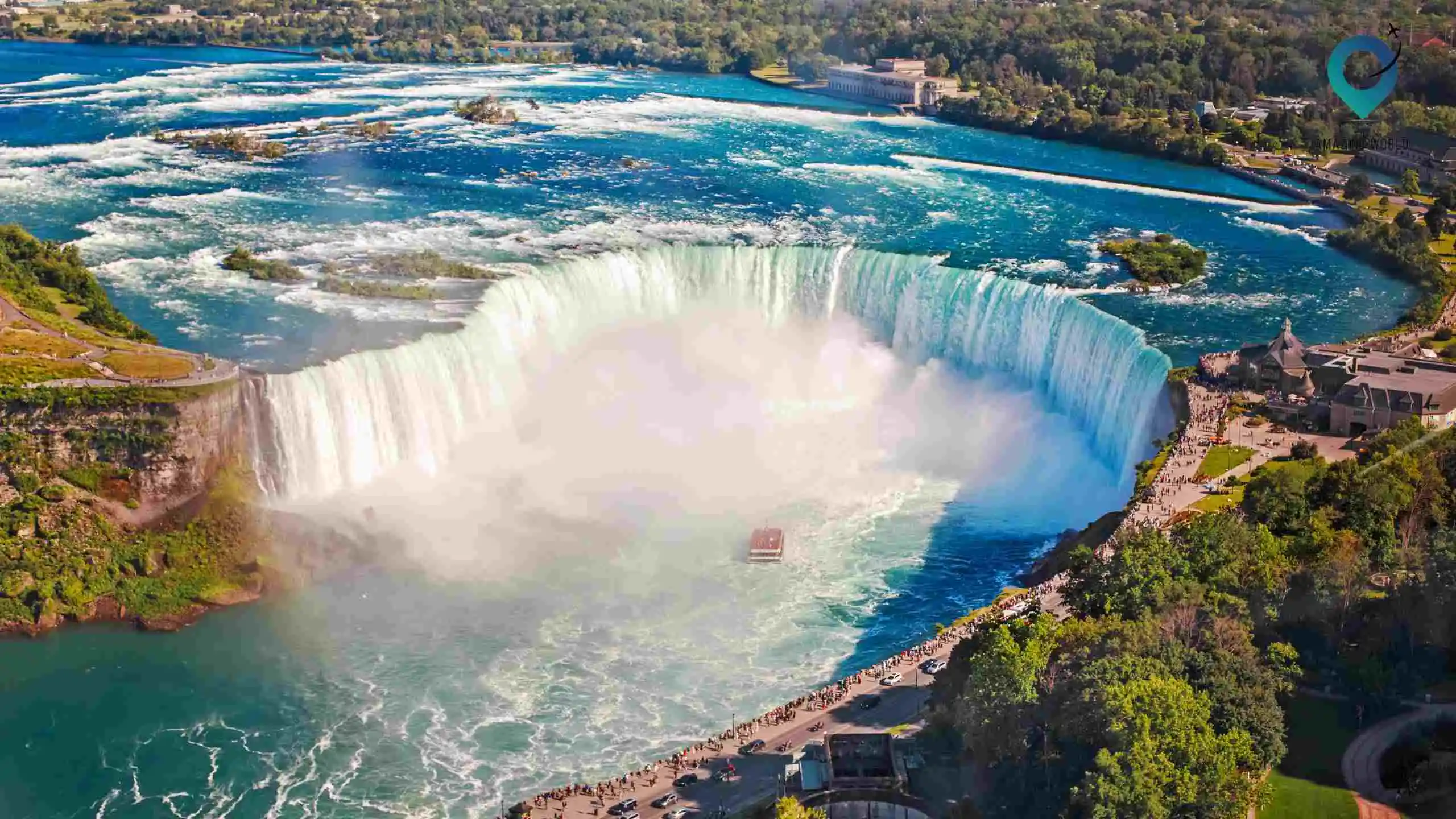
Travel Guide 28 Underrated Summer Destinations You Must Visit in 2024
You may also like.
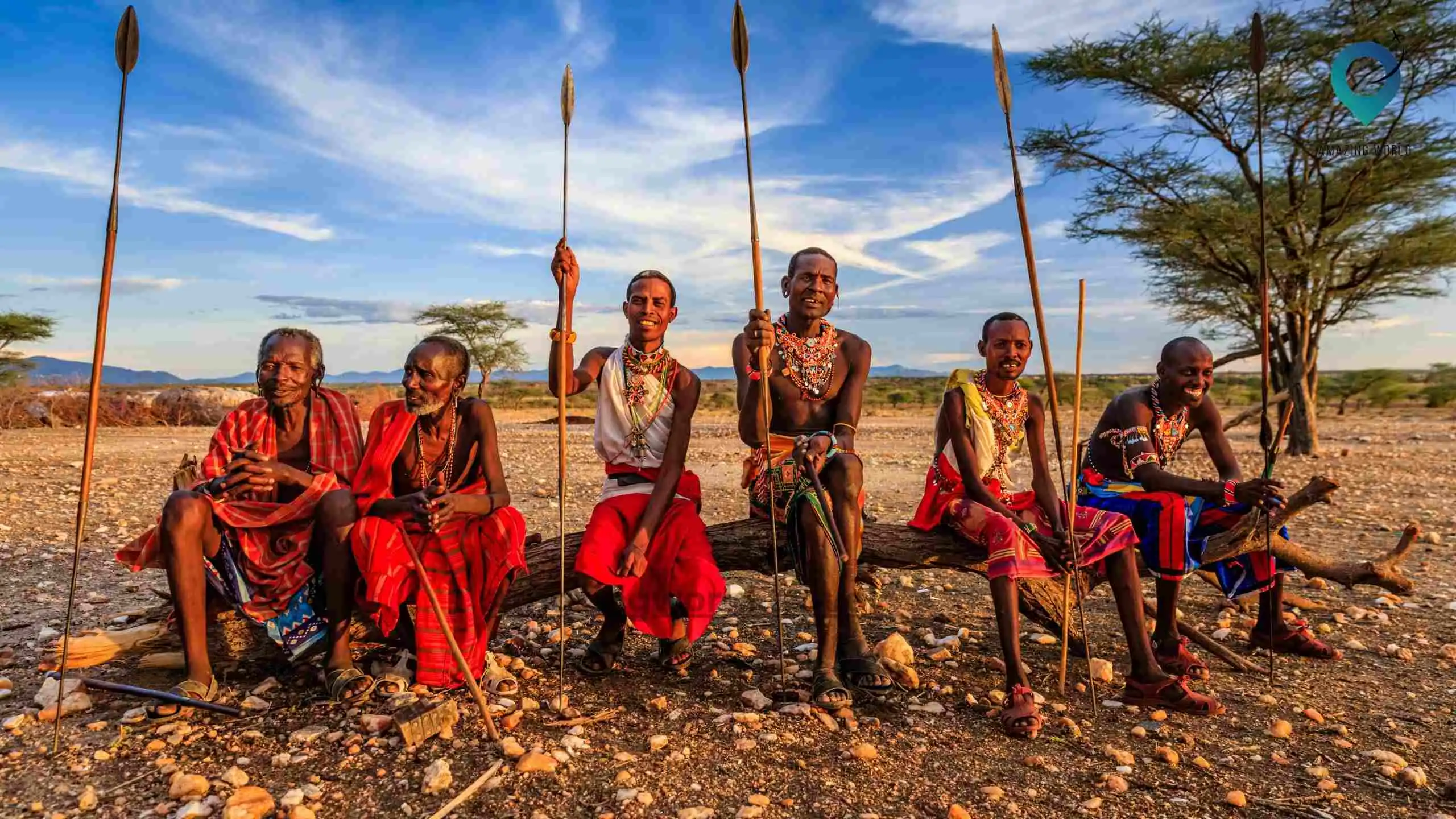
Discover Kenya: 35 Best Tourist Places To Visit in Kenya 2024
- 26 minute read
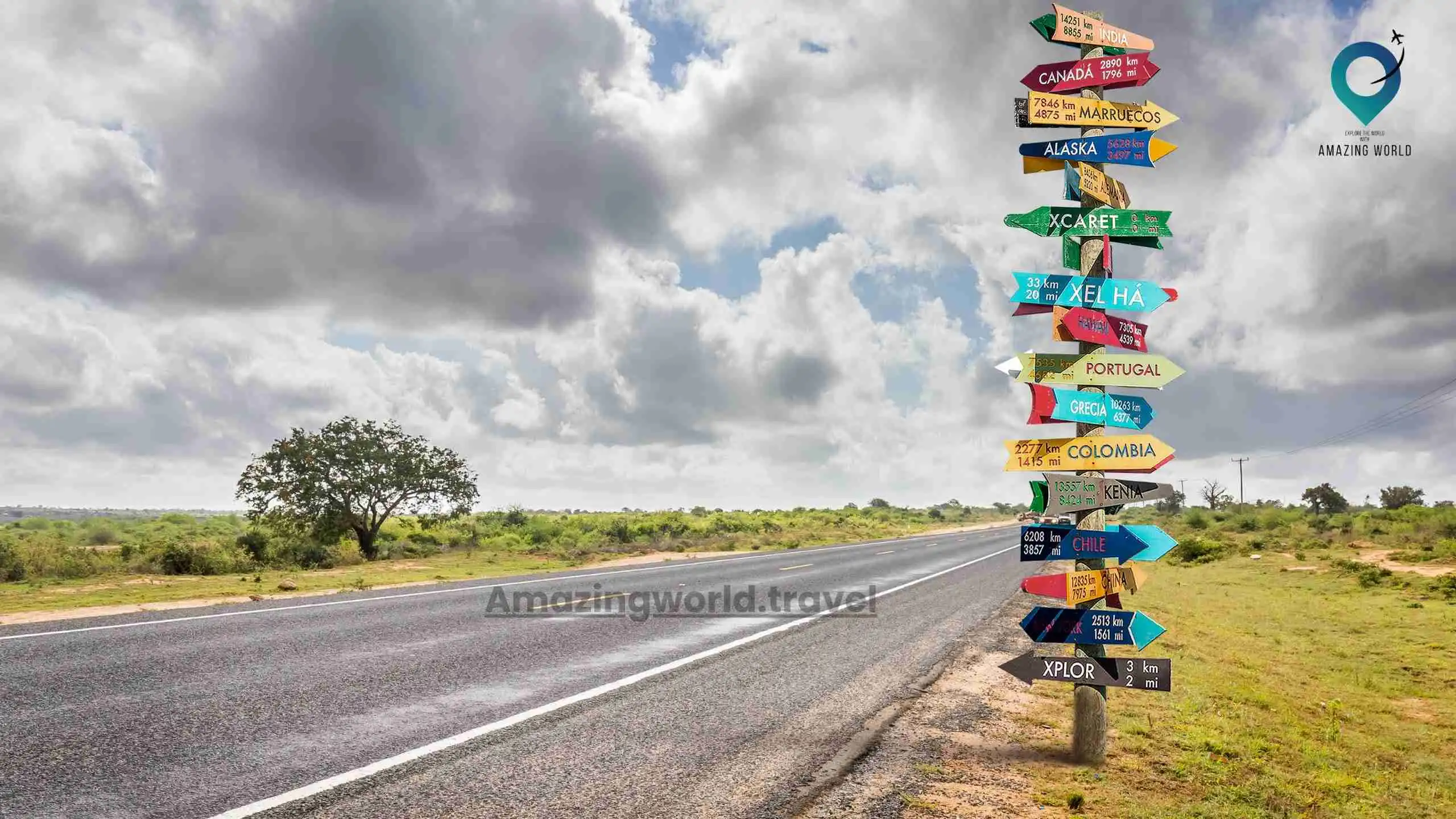
- 8 minute read

Masai Mara – Nature’s epic safari destination in Kenya
- 6 minute read
Our Latest Instagram Posts
@amazingworld.travel8.
- Africa & Middle East

Nairobi, Kenya | A Two-Day Travel Guide

It’s the spaghetti streets and highways that hit you first. Only born and bred Nairobians, not simply Kenyans, but Nairobians know where you’re going. Thank God for the Chap Chaps and Boda Bodas. Only they can navigate, as Kenyans lovingly call it, the organized mess.
But within this organized mess is organized peace. I’m talking about the green spaces of Nairobi, like Karura Forest, and of course, Nairobi National Park.
Where is Nairobi?
Nairobi is the capital and largest city of Kenya, located in the country’s south-central part, close to the eastern edge of the Great Rift Valley. It’s also the effective terminus of the Uganda Railway (also known as the “Lunatic Express”) that stretches to Mombasa.
How to get to Nairobi
The main primary airport in Nairobi is Jomo Kenyatta International Airport (JKIA). It’s the largest and busiest airport in Kenya and serves as a major gateway to the rest of Kenya and East Africa. From here, you can get domestic flights to other destinations in Kenya and Africa.
You’ve also got three primary railway stations in Nairobi:
- Nairobi Central Railway Station : This historic station has been the traditional hub for long-distance passenger and freight rail services within Kenya, connecting Nairobi with other major towns and cities, including Mombasa, Kisumu, and Nanyuki.
- Syokimau Railway Station : Opened in 2012, Syokimau Station marked the beginning of the modernization of Kenya’s rail transport. It serves as a terminus for commuter services between it and the Nairobi Central Station, easing congestion heading towards the city.
- Nairobi Terminus (SGR) : Located on the outskirts of Nairobi, near Syokimau, this is the main station for the Standard Gauge Railway (SGR) services between Nairobi and Mombasa (high-speed rail).
Jomo Kenyatta International Airport and Nairobi Terminus are very close to each other in case for any reason you need to pair a train trip with a flight. For example, we booked an extra night in Nairobi coming out of Tsavo National Park, thinking we would need it to realistically catch a domestic flight to Eldoret without worrying about things being on time. As it turns out, the train ran flawlessly on time and we didn’t realize the terminus was right next to the airport until our driver zoomed passed it en route to the hotel. Had we known this in advance, we probably would’ve just booked a flight that same day to Eldoret to get an extra day at the running camp in Iten. Oh, well. At least you know!
Best time of year to visit Nairobi
The good news is that most of the year is a pretty good time to visit Nairobi, at least as far as the weather is concerned. The dry seasons run from July to October and from January to February. During these months, the weather is generally sunny and dry, making it ideal for wildlife viewing in nearby national parks and reserves, as well as for exploring other outdoor attractions in Nairobi and throughout Kenya. July to October, for example, coincides with the Great Migration in the Maasai Mara, and is a common addition for anyone planning a trip to Nairobi. You’ve got cooler temperatures and minimal rainfall during these periods, meaning comfortable conditions for travelers.
Things to do in Nairobi
Nairobi is a city of nearly five million people. Suffice it to say, there’s plenty to do in the city. Most international visitors will stay and hang out around the Westlands neighborhood. Popular hangout spots include The Alchemist, an entertainment cultural venue that features an outdoor bar, food trucks offering a variety of cuisines, and a market space where local artisans and entrepreneurs sell their crafts and products. The venue also hosts a range of events, including live music performances, DJ sets, film screenings, and art exhibitions, making it a dynamic space for creative expression and cultural exchange. (Full disclosure: We didn’t get to take full advantage of the space, stopping by merely for a happy hour beer before heading to dinner.)
Another popular spot to end the night at is the Havana Club, also in the Westlands. Here you’ll find a mix of Kenyans and international travelers or residents sharing a late-night drink.
Karura Forest

Karura Forest is the world’s largest gazetted urban park. We can thank the likes of Nobel Peace Prize Laureate, Wangari Maathai and her Green Belt Movement for protecting this land from development.
Now visitors, an overwhelming majority of whom are Kenyans, can enjoy the collective 50 kilometers of trails and historic natural sites, like Karura Waterfall and the Mau Mau caves where Kenyan rebels against colonial rule hid their men, weapons, and provisions. Grossly overgeneralizing, they were the ones who told the Brits to take their stupid fucking crown and shove it up their ass.
Nairobi National Park

The green continues on the southern-edge of the city at Nairobi National Park –– dubbed the world’s only wildlife capital thanks to famous shots of giraffes with sky rises in the background. Here you can find just about any animal you’d hope to spot on an African safari. Zebras, giraffes, rhinos, lions –– you name it. Of course, nothing is guaranteed. This is, after all, their territory.
The best way to see the park is to have a friend who lives in Nairobi with a park pass and is willing to take you out for a drive. In lieu of that, you’ll have to book with a company. We booked with Kenya Bush Expeditions. They’ll pick you up at your hotel bright and early (6 a.m. for us) along with other guests joining your drive. Our vehicle had six people plus our driver, Lawrence.
The vehicle itself was a little on the raggedy side. But it got the job done. On our roughly four-hour drive, we saw giraffes, zebras, ostriches, hippos, wildebeest, oryx, rhinos, and just as we were heading out, we spotted a lioness. Honestly, I was surprised by the density of animal sightings. I foolishly thought that, because a city is so nearby that you can easily see the skyline behind the animals, we wouldn’t see much. To the contrary, we saw quite a bit.
Sheldrick Trust Nairobi Elephant Nursery + Giraffe Centre

Almost every guide and tourist package for Nairobi National Park will tell you to pair a trip to the park with stops at the Sheldrick Trust elephant nursery and giraffe centre. At the elephant nursery, you listen to an hour-long presentation while the hosts tell you about the elephants, you watch them drink some milk, and eat before trotting back away from the guests. Then it’s another short drive to the Giraffe Centre where you walk up a platform that puts you at eye-level with the giraffes and you can feed them small pellets.

Now here’s what no tourist package or guidebook will tell you… Unless you are absolutely enthralled with these animals, you can skip these stops. It’s a long, tiring day to get up at the ass-crack of dawn, do the game drive, and then add two more stops. I was perfectly content with our game drive in Nairobi National Park and the knowledge our driver had of the animals. If I were to do it again, I’d do the game drive, get lunch in Nairobi, rest at the hotel, and head back out into town in the late afternoon.
That’s not meant to be a negative comment on the tremendous work the elephant orphanage and giraffe centre are doing. It’s merely a comment on my level of energy.
National Museum of Kenya
It’s a small museum, but one worthy of your visit if you’re not too zapped from Nairobi National Park. Of course, you get some facts and stories about animals. But what I found most fascinating was the exhibition on human evolution, showing visitors what we used to look like and how we got to who we are today –– and how long that took.
Spinners Web
Spinners Web in Nairobi is a treasure trove of Kenya’s rich craft heritage. Located in the leafy suburbs of Nairobi, this expansive shop and café offers a wide selection of handcrafted items, ranging from intricate textiles, beautiful beadwork, and unique wood carvings to contemporary art pieces. It serves as a collective showcase for hundreds of artisans, designers, and craftspeople from across Kenya, making it a vital platform for local talent.
Nairobi Market Tour + Cooking Class
I’m recommending this even though I didn’t do it. It’s my biggest regret about my time in Nairobi. But it sounds right up my alley. Frankly, I feel like a fool for not signing up for one of these. I saw a couple of highly rated options on Airbnb Experiences. As much as I don’t care for Airbnb, the experiences usually do check out. So have a look and consider including it in your Nairobi plans!
Restaurants in Nairobi
I’ll admit that I did not know what to expect of Nairobi’s culinary scene. But suffice it to say, it did not disappoint.
One thing I will say before sharing some of the restaurants we visited is that you will have to get familiar with hiring taxis to get to these restaurants. Nairobi is not a walking city, for the most part. And most every hotel and restaurants are hidden behind a gate. Nairobian drivers know the drill and they know where they’re going, so it’s easiest to just trust them. And the easiest way we found to order a taxi (or ‘chap chap’) is using Uber, as instructed by a friend living in Nairobi.
bamba is situated around the leafy edges of Nairobi and the restaurant embraces its natural surroundings. You’ll feel like you’re dining out on an elaborate campground with a diverse menu ranging from the Levant (eggplant with pomegranate) to good-old-fashion pizza.
We paired a stop at ạtė with our hike around Karura Forest. Like bamba, ạtė is on a quiet, leafy suburban street. We tried a little bit of everything on the menu and nothing disappointed. The memory of their mushroom dumplings, eggplant tataki, arancini, and their eggplant/tofu in sticky bean sauce with cape malay curry still sits on my palate.
Our visit to CJ’s came after our stop at the National Museum. We had a hard time making sense of Nairobi’s urban layout. But this area on Google Maps appeared to be a familiar collection of grid-like streets. So we thought we’d pop over and have a look. Fortunatley, CJ’s was worth the visit. There’s a bright French brasserie vibe inside with mostly Kenyans stopping by for lunch. Come here if you want an excuse to visit the central business district and walk around afterwards.
beit é selam – ቤተ ሰላም
This Ethiopian restaurant seems to have a bit of a Swahili flair alongside the national favorites. But as much as I enjoyed the Ethiopian eats, I’m here to tell you about the corn ribs. This was probably my favorite dish of my entire trip to Kenya. They do make the effort to cut the corn into the shape of ribs, making it easy to pick up and nosh away. But it’s the spices and garlic aioli they put on it that did it for me. Just absolutely phenomenal.
Hotels in Nairobi
Skynest residences by cityblue.
We picked this place purely for the convenience of staying near our friend at the Mövenpick. But I’d happily stay there again on my next visit to Nairobi. The staff were wonderful and welcoming. And it was here that we learned about the extensive security measures throughout the city. Your driver will pull up to the gate, someone will check for bombs underneath the car, they’ll open all of the car doors, maybe ask you a question or two, and then let you in. From there, there’s a scanner for your luggage before walking up to reception.
It sounds intense, but it’s all done in remarkably chill fashion. Our driver suggested that the increased security throughout the city (you’ll find it entering the airport and train station as well) was a result of the Westgate Mall terrorist attack in 2013.
The rooms are apartment-style, so you can get a sense of what it might be like to live in the Westlans of Nairobi. There’s also a wonderful rooftop pool with a great view of the city skyline. We happily took advantage of the nearby gym before jumping in.
The only con I’ll note is the breakfast. Breakfast gets delivered to your room in the morning in several plastic containers. The vegetarian sandwiches were soggy, but the samosas were actually pretty delicious. Also, if you pay for breakfast, note that you’ll end up missing it if you sign up for a safari to Nairobi National Park. I’d suggest booking without breakfast and finding something else around town.
Last point worth mentioning… There’s a convenience store attached to the hotel, so it’s easy to pick up water and any snacks you might want to keep on you during your busy days in Nairobi.
Mövenpick Residences Nairobi
A friend who’s been living in Nairobi for about the past year is still here. So that to me is a good enough recommendation in and of itself.
The Boma Nairobi
We stayed here on our return from Tsavo National Park, thinking it’d be a good spot to get to the airport quickly. In reality, it’s moot these days thanks to the massive Nairobi Expressway (opened in 2022) that cuts through Nairobi traffic and gets you to the Westlands in 20 minutes. (Our drivers said it used to take as long as two hours.)
That said, The Boma might still be a good pick if you want to stay closer to Nairobi National Park. I’d give the nod to Skynest myself, but this place is definitely worth considering.
You Might Also Like

Top 8 Off the Tourist Trek Destinations for 2017

Kenya Running Camp | A Complete Guide to Iten

Tsavo National Park | A Three-Day Travel Guide
© 2015 - Joe Baur. All Rights Reserved. Designed & Developed by SoloPine.com

27 Peak Tourist Attractions in Nairobi unveiled.
Tourist attractions in nairobi..
There are lots of Tourist attractions in Nairobi Kenya. Being one of the most visited cities in Africa. It prides itself on leading and having the only National park in Natural habitat within a city that needs little or no introduction, Nairobi National Park . One of the few cities which still have naturally grown trees all over the city.
Nairobi started in a humble beginning as a Camping site in 1800 and grew to be the Capital Centre for British colonial in East Africa.
Some of this information can be found right in Nairobi Railway Museum and other museums I will be listing in a few.
Without Much ado, here is my list of Tourist Attractions in Nairobi.
Nairobi Tourist Attractions (Karen/Langata)
1.) nairobi national park..

Yes, Nairobi National Park Had to be the one to start us off since according to me nothing more intriguing than this place.
Location: 15 Minutes drive from CBD, Along Langata Road.
What to See: All the big five except the Elephant which can be found in our next tourist attraction in Nairobi.
Park Fees: Citizen Kes400 Child Kes200 Non-Residents: Adult $35 Child $20
2.) David Sheldrick Wildlife Trust.
It is like an itinerary kind of a thing, after your game drive at Nairobi National Park. This should be your next destination. While at it Read Facts about Elephants.
Location: 17 Kilometers from CBD, OFF Magadi Road.
What to see : What you missed at Nairobi National Park, the Elephants. Adopt and feed young rescued Elephants.
3.) Karen Blixen Museum.
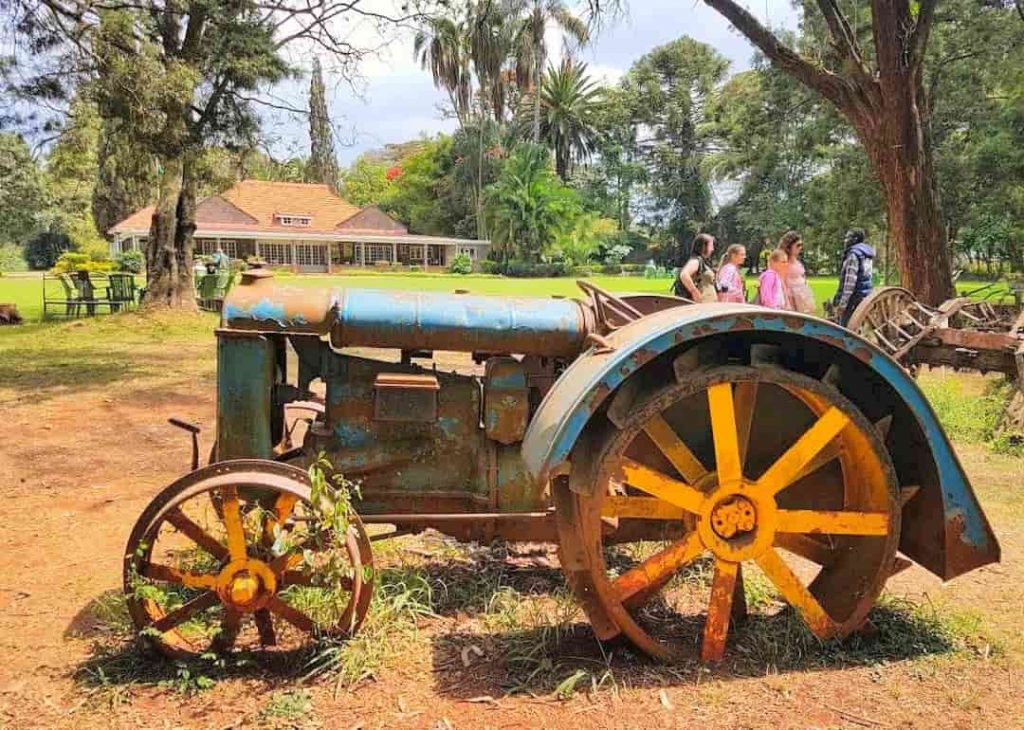
Location: 18 Kilometers from CBD, Along Karen Road.
What to See: Ever seen the movie out of Africa? It is now on Netflix go watch it you will be glued to the edge of your seat till the end, then the crave to visit Karen Blixen will be inevitable.
4.) Kazuri Beads.
Location: 18 Kilometers from CBD, Along Forest Lane neighbouring Karen Blixen.
What to see: Souvenirs to take back home. Get those coveted African beads with you, they are quite affordable and mark a lifetime experience.
5.) Giraffe Centre.

Location: 17 Kilometers from CBD, Along Duma Road.
What to See: I call them giants since they are too tall, I never seem to comprehend it. Feed and kiss the giraffes. Come close and Personal. Tip: Of all the Tourist Attractions in Nairobi. You should never miss the Giraffe centre.
6.) Silole Sanctuary.
Location: Adjoining Nairobi National Park.
What to see/do: Apart from the wildlife animals, there’s rock climbing, walking with or without a guide, swimming at Masai Lodge and Camping.
7.) Oloolua Nature Trails.
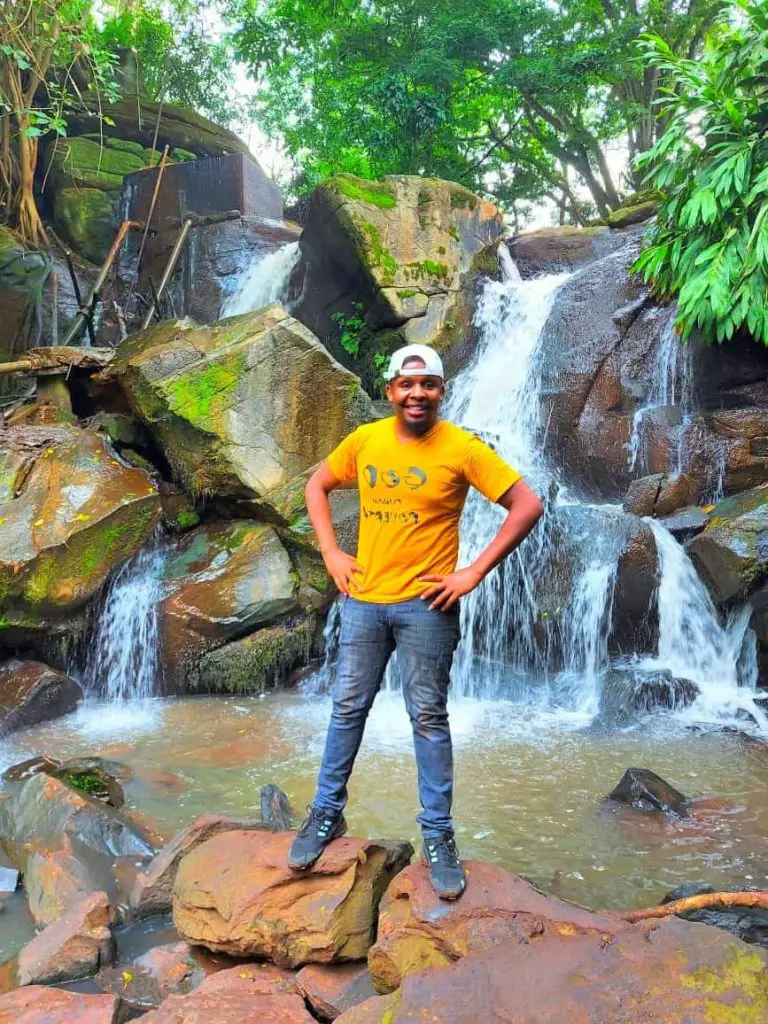
What to see: Waterfalls, 39 Meters long Mau Mau Caves, Bamboo place, Camping, Photography and Nature walk. Read more About Oloolua Nature Trails.
8.) Kitengela Hot Glass.
Location: Just next to Silole Sanctuary and 27 Kilometers from CBD.
What to see: The Scary and precarious bridge walk, swimming, tour to the Studio, the glass art, horse and camel riding. Read More About Kitengela Hot Glass . Find out their Prices.
9.) Bomas of Kenya.
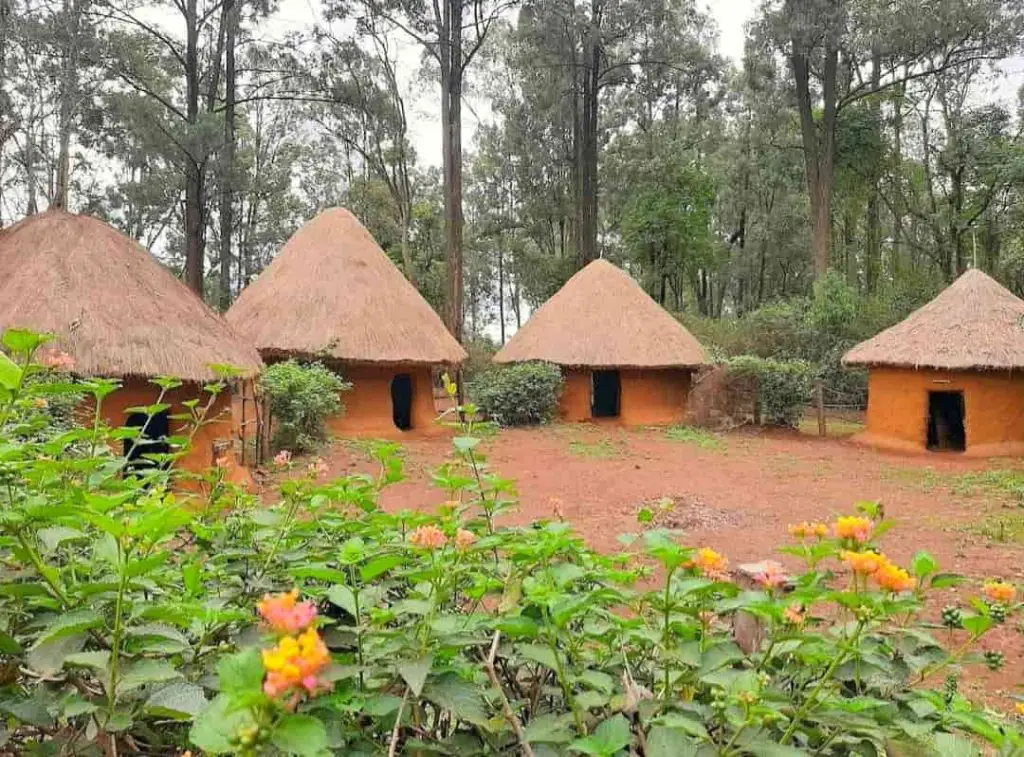
Location: 12 Kilometers from CBD, Along Langata Road.
What to see: There are daily shows, Harambee dancers, Cultural Artifacts, Research Library and Cultural homemade.
10.) Kibera Slums
Location: 7 Kilometers from CBD, Along the Kabarnet close.
What to see: Kibera is the largest slum in Nairobi at the same time the largest urban slum in Africa.
It is estimated to have a population of about 1 million people within the tin-roofed, mud-caked structures.
11.) Nairobi Mamba Village.

Location: 13 Kilometers from CBD, Along Karen Road.
What to see: As the name suggests, you will come across these reptiles in a close and personal view. You will get to hold the young ones and have a chance to see the hungry thirsty crocs feed on their meal which happens every Sunday at 3:00 PM.
12.) Gp Karting Nairobi.
Location: 8 Kilometer from CBD, Along Langata Road.
What to see: A world-class Gp Karting track built by professionals. Come have the fun, ride and compete with your friends on these tracks. Read more, how much they Charge and more About Gp Karting Nairobi.
13.) African Heritage House.
Location: Next to AIC Kasina Church, Mlolongo, Mombasa Road, Kenya.
What to see: This is a powerhouse of the showpiece of African Culture and Heritage. If African Art is a piece of your cake. Then this is to go place for you.
Nairobi Tourist Attractions in CBD.
These attractions are right in the MIDDLE of Nairobi`s CBD.
14.) Nairobi Railway Museum.

Location: NRR is along Station Road, next to the railway station.
What to see: If you want to learn how Nairobi started from scratch to a kick-ass city this is your to-go place. Have you watched the out of Africa Movie? The train featured in that movie is right inside the museum. Remember man-eaters of Tsavo? There are some of the lion claws at the Museum. For this and many more Here is a dedicated post about Nairobi National Museum.
15.) Kenyatta International Conference Centre (KICC).
What to see: It used to be the tallest building in Nairobi though not any more it has the best location if you want to have a 360 Nairobi View.
16.) Nairobi National Museum.
Location: Museum Hill
What to see: This is the flagship of all museums in Kenya. It is built to showcase Kenya`s Heritage in four segments, which are the Cultural side of the story, the Natural, History and Contemporary Art.
17.) National Archive.
Location: The landmark for many Nairobi newcomers, tucked along Moi Avenue.
What to see: Incredibly affordable for such information you will gather, i.e. the historic photographs, Kenyan crafts and Magical paintings.
18.) Snake Park.
Location: Tucked right inside the Nairobi Museum.
What to see: Almost all the snake species found in Kenya. Since am an Ophidiophobia (fear of snake) I have never laid my foot and don’t think if I will ever.
But if you`re good to go, then all the best. Snake Park is one of the most sought tourist Attractions in Nairobi.
19.) Nairobi Gallery.
Location: Tucked at the intersection of Kenyatta Avenue/Uhuru Highway.
What to see: Built-in 1913, it used to be PC`s office. You will be able to see Mumbi Collections
20.) Kenya National Theatre.
Location: 2 Kilometers from CBD, Along Harry Thuku Road.
What to see: Do you want to see Art? In terms of acting in a well set up theatre? Then this is your to-go place.
21.) Jamia Mosque .
Location: Tucked right in the middle of the city, Along Banda Street.
What to see: It was built in 1903 and it is the biggest mosque in Kenya. Not really a must-visit site but it is worth passing by.
22.) Central Park.
Location : Kenyatta Avenue.
What to see: A monument, this is an ideal place to rest with your friends, it is free and some of the other time in Nairobi is worth a visit.
23.) August 7th Memorial Park.
Location: Tucked in the middle of the City, Moi Avenue/Hail Selassie Junction.
What to see: It is a memorial park for the bomb blast that happened on 7 th August 1998. You will see what transpired on that fateful day.
Nairobi tourist attractions (Kiambu).
24.) paradise lost..
Location: Tucked in Kiambu, 13 Kilometers from CBD, Nairobi Kenya.
What to See: The most intriguing is the Mau Mau Caves, Nature trails, fishing, boat ride, horse riding and kids will be well taken care of with numerous games.
25.) Karura Forest.
Location: Tucked in Kiambu,6.5 Kilometers from CBD, Along Limuru Road.
What to see: One of the largest urban forests in the world. Birding and animal sighting, Plants and vegetation tours, History and culture, Bike riding, Nature walk, Dog Walking on Leash, planting trees among other activities.
26.) Fairview Coffee Estate.
Location: Tucked off Kiambu road, 15 Kilometers from CBD.
What to see: Get to enjoy their premium Coffee, Engaging coffee farm tours, Beautiful landscapes, Expert production procedures and get to buy their affordable premium coffee.
27.) Shopping Malls.
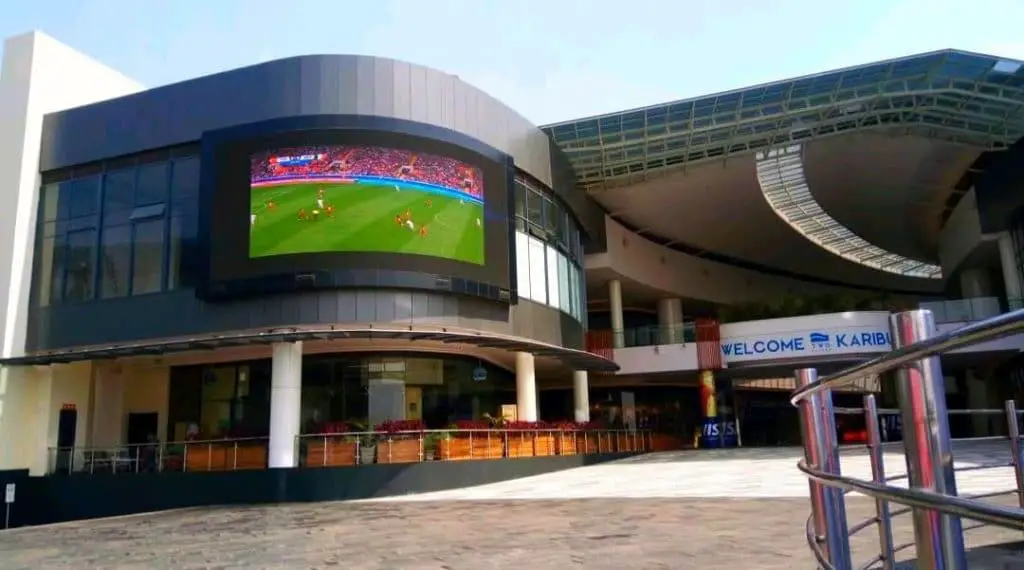
Nairobi Real Estate is on another level, Malls are popping out every other day and tell you what? You have a wide range of malls to choose from for your Shopping. They come in handy after exploring Tourist Attractions in Nairobi.
Just to mention a few new some of the Nairobi Tourist Attractions.
- Sarit Centre
- West Gate Mall
- Yaya Centre
- Rosslyn Riviera
- Galleria Mall
- The Hub Karen
- Two Rivers Mall.
NB// To book some of the Nairobi Tourist Attractions, reach out to My designated tour Company Incredible Kenya Adventures .
Also Read:-
- 14 Furnished Affordable Apartments with a Pool in Nairobi.
- Day Trips you can do from Nairobi.
- 13 National Parks and Reserves you never knew existed in Kenya.

Where is the Maasai Market Location in Nairobi?
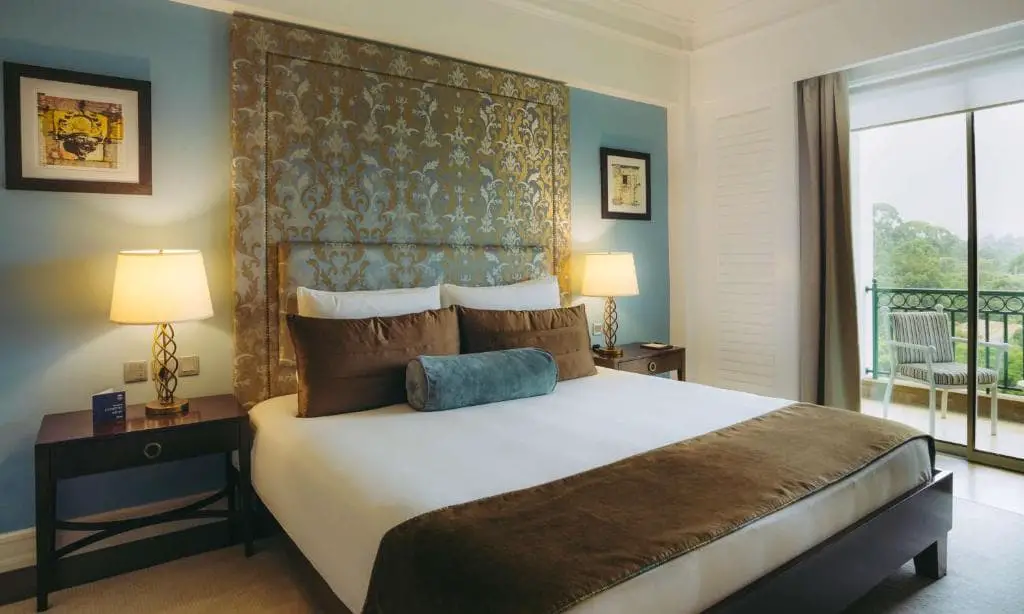
14 Hotels in Nairobi Westlands rating from luxury to Budget
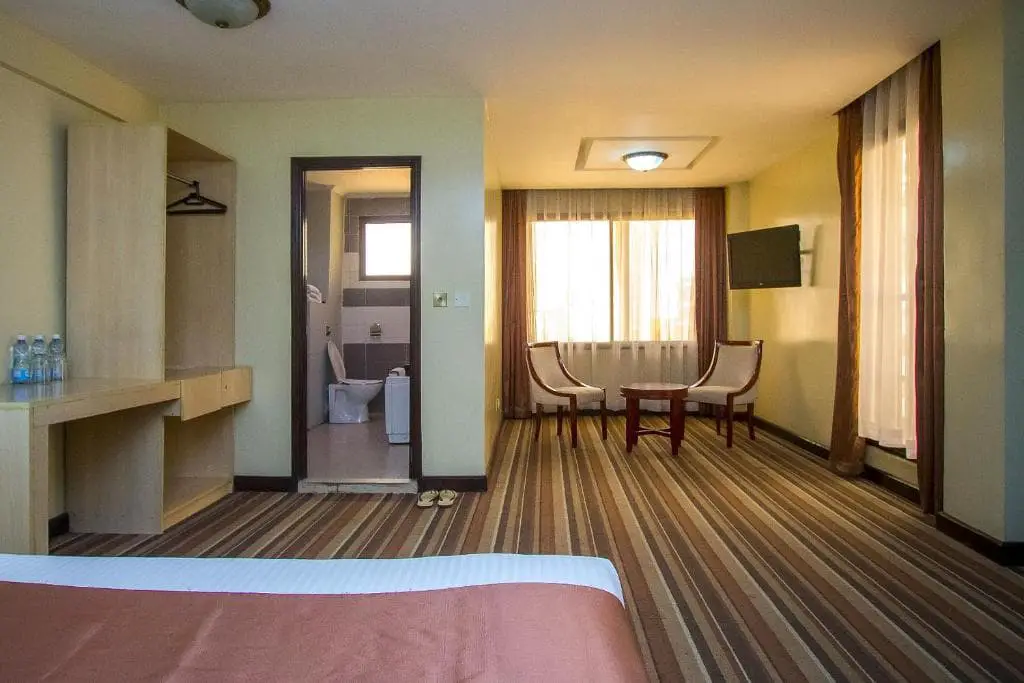
13 Budget Hotels in Nairobi CBD for only $50 B&B

How to use 48 Laws of Power when Travelling
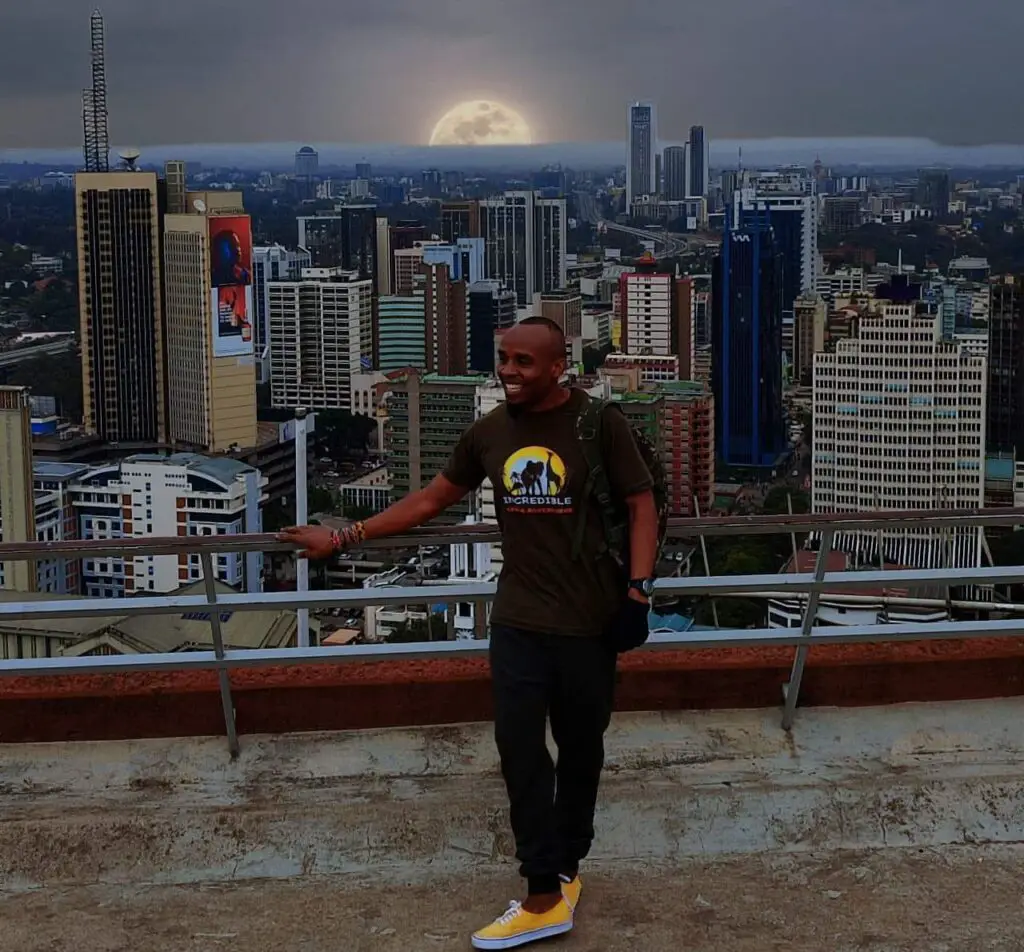
Nairobi City walk Tour with a certified Expert

How to lose weight fast naturally and permanently
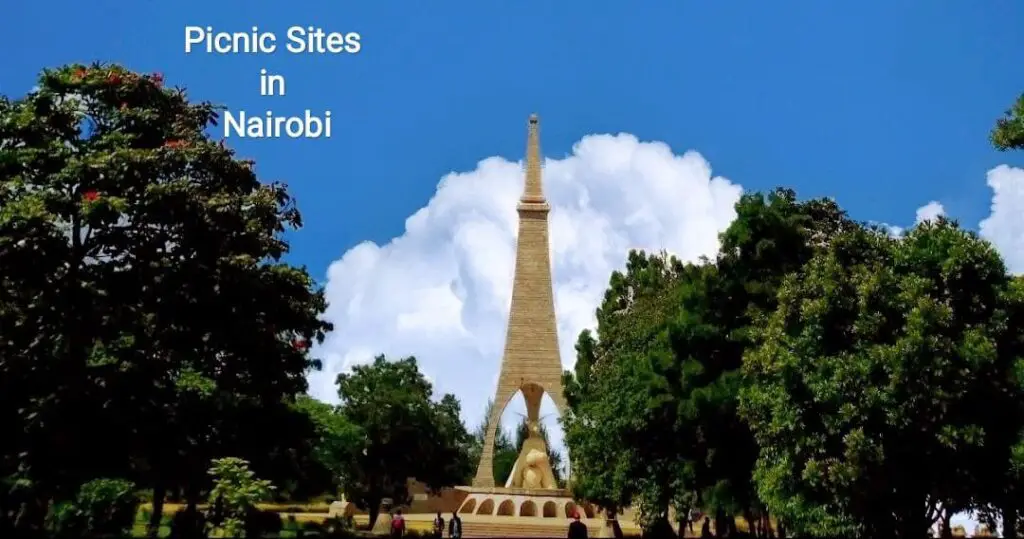
13 Epic Picnic sites in Nairobi you should visit
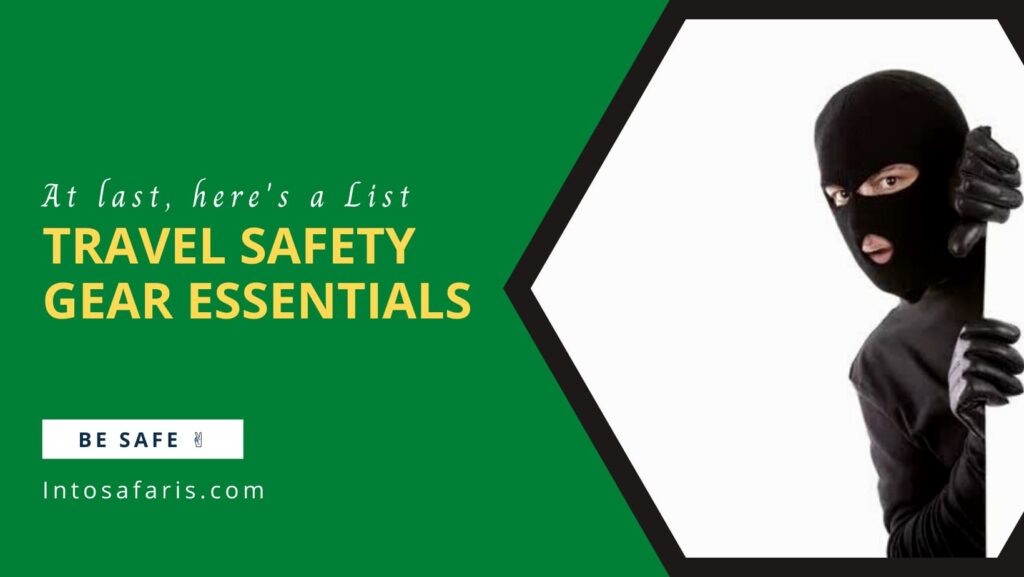
Travel safety gear Essentials that you need
Leave a comment cancel reply.
Your email address will not be published. Required fields are marked *
Save my name, email, and website in this browser for the next time I comment.
Travel Itineraries | Luxury Travel | Travel Tips
The 7 Day Nairobi Travel Itinerary and Guide

The Best of Nairobi in One Week – A Travel Itinerary
This 7 Day Nairobi and Surrounding travel itinerary is designed keeping the following factors in mind:
- Fly in and Fly Out from Nairobi Jomo Kenyatta Airport
- Hire a car or book a car and driver (Nairobi roads can be hazardous)
- Have 8 days in your hand
Nairobi is the capital city of Kenya. It is a buzzing, hustling, vibrant, gritty and chaotic place. It sits in the Kenyan highlands on top of the Great Rift Valley. Populated by colonists in the 18th for its cooler climate, the rains and fertile highlands made it a prime spot for European settlers who suffered under the scorching African sun.
Nowadays Nairobi is no longer a sleepy village, it is the third-largest economy in Africa and the city is expanding at a huge rate. Everywhere you will see tower blocks emerging, restaurants and bars being opened, and swarms of tourists heading to world-famous sights. But Nairobi isn’t a city of ancient architecture and pristine plazas. Nairobi is famous for its animals. And it is the only city in the world with a National Park in the city bounds. Nairobi is also one of the destinations that is perfect for both – a family vacation as there are lots of things to do with kids in Nairobi , most of which are mentioned in this Nairobi Travel Guide as well ; or a budget backpacking holiday ! For some really amazing budget travel hacks for Nairobi and Kenya, do check out this Kenya Budget Travel Guide !
Nairobi National Park is 100 sq km right in the city where wild animals are free to roam and to come and go as they please. 4 of the big 5 (lion, leopard, rhino and buffalo) are in the park, elephants had to be relocated due to human-wildlife conflict. In Nairobi, animals aren’t just confined to the park, you see giraffes on the way to work, warthogs on the school playing fields and monkeys in your garden.
Animals and humans coexist in a way that is special and unique to this vibrant African city.

Day 1 – Nairobi
Day 2 – david sheldrick wildlife trust and giraffe manor, day 3 – safari at nairobi national park , day 4 – drive to naivasha & visit crescent island , day 5 – naivasha – hells gate, day 6 – naivasha – take a boat tour and visit crater lake , day 7 – return to nairobi & visit spinners web, where to stay in nairobi, when to visit nairobi , things to shop in nairobi to remind you of your trip to kenya, summary of the 7 day nairobi travel itinerary, share this:.
Land at Jomo Kenyatta International airport , make your way to your accommodation in the leafy suburb of Karen. Karen is on the outskirts of Nairobi, close to the wildlife points and filled with many fabulous shops and restaurants.
Relax by the pool, take a walk in Ololua Forest and have dinner at the unbeatable Talisman restaurants. If it’s a Friday you’ll find locals dancing to the local DJ until the early hours of the morning. The best way to kick off your epic trip to Kenya and Nairobi.

Start the Day 2 of your epic 7 day trip to Nairobi, by visiting the David Sheldrick Wildlife Trust . This charitable organisation rescues orphaned elephants from all over Kenya and Tanzania and rehabilitates them before returning them to the wild. Visit DSWT to meet the most adorable baby elephants, spend time getting to know them and meet their keepers and trust owners who will happily share information on the work that the trust does.
Stop for lunch at craft centre Utamaduni.
Visit the Giraffe Centre and Sanctuary. This charity rescues the endangered Rothschild Giraffe and provides them with a place of safety in the sanctuary. Visit the Giraffe Centre, meet the giraffe and feed them by hand. Get up close and personal to these gentle giants on raised platforms. Although these are wild giraffes they are used to visitors.

The third day of this 7 day Nairobi Travel Itinerary is reserved for a full day safari at Nairobi National Park .
The park may be small but it packs a punch; lion, leopard, hyena, cheetah, rhino, hippo, crocodiles, jackals and many more live in the park. As traditional corridors are open and animals are free to come and go, you have the opportunity to see most Kenyan wildlife here, except for elephants . There are various habitats across the park, from savannah to marsh, rivers and lakes to dense woodland. Stop for lunch at the KWS clubhouse and stay in the park for the full day.

Naivasha is a thrilling 90-minute drive from Nairobi. The view as you drive down the Great Rift Valley is awe-inspiring; volcanoes rise from the bottom of the rift and eagles soar across its expanse.
Spend the afternoon on a walking safari at Crescent Island. This crescent-shaped peninsula sticks out into Lake Naivasha. The lake hosts vast numbers of hippos, which frequently come onshore at Crescent Island. The sanctuary allows animals free access and you will get the opportunity to walk alongside giraffe, zebra, oryx, kudu, eland, Thompson gazelle, wildebeest, impala as well as buffalo and possibly hyena. Be wary of the hippos, hyena and buffalo.

Hells Gate National Park is the park on which the Lion King movie was based. A dramatic volcanic landscape of peaks and valleys, caves, rivers and its infamous gorge. Essentially a wildlife sanctuary – the park is largely filled with Kenya’s more friendly animals; Zebra, Hartebeest Thomson’s Gazelle, Klipspringer, Antelope and Reedbuck, although there are buffalo too and the odd Leopard and Lion may haunt the mountains. Hell’s Gate is named for its geothermal activity ; hot springs and plumes of scalding steam are a common site and huffing, puffing, belching park that is an experience not to be missed.

Spend the day on the lake. Take a boat tour and get up close and personal with the hippos. You can tour the entire lake where experienced guides will navigate your stomach clenchingly close to huge hippo families. The lake has amazing birdlife, eagles and herons in huge numbers as well as the fiercely ugly marabou stork.
In the afternoon visit the dormant crater lake volcano. A jade-green lake fills the pit on the extinct volcano. Visit the sanctuary with its many trails up and around the volcano, the park is filled with game and has views all over the rift and Naivasha surrounds.
Return to the top of the rift and back to Nairobi.
Spend your last afternoon shopping for souvenirs at the wonderful Spinners Web . A huge house filled with treasures from all over Africa. Pick up Maasai beads, wooden carvings, woven rugs, reed bowls and vibrant clothing and jewellery. Enjoy lunch in the greenhouse before returning to your hotel.
Tourists may prefer to stay in the outer suburbs of Karen and Langata where the Elephant Orphanage and Giraffe Centre are situated and there is easy access to Nairobi National Park.
Karen Gables
This Cape Dutch-inspired boutique hotel is situated down a quiet lane at one of the most prestigious addresses in Nairobi. Once inside you are spirited away from city life into a world of tinkling streams and nature-filled gardens.
Hemmingways Nairobi
Part of a collection of elite hotels it’s hard to imagine that this grand plantation hotel has only 45 rooms. Its elegance and serenity are unmatched in Nairobi. It houses an excellent restaurant, a sundowner bar with views over the Ngong Hills and an onsite spa and pool.
Nairobi is in the highlands and the weather is considerably cooler than the rest of Kenya. In the long rains – April to June it can become quite cold and the rains can be long and frequent. In the short rains- October to November the rains are more sporadic, often sunny days with rainy evenings and nights. For the rest of the year, the weather is mostly hot and sunny. It can get very warm during the summer months of Dec-March.

# Maasai beaded products- animals, bags and jewellery
# Maasai Shukas
# Kanga clothing
# Kikoy wraps
# Aberdares tea
# Carved wooden animals
Day 1 – Land in Nairobi
Day 2 – Explore David Sheldrick Wildlife Trust and Giraffe Centre
Day 3 – Safari at Nairobi National park
Day 4 – Naivasha and Crescent Island
Day 5 – Visit Hell’s Gate Park , Gorge and Hot springs
Day 6 – Boat tour on Lake Naivasha and trip to Crater Lake
Day 7 – Return to Nairobi + Visit Spinners Web
Day 8 – Departure from Nairobi
We hope you found this 7 Day Nairobi and surrounding Travel Itinerary , to be of help to you, as a reliable Travel Resource for planning your Trip to Nairobi and Kenya. Don’t forget to Pin these images , and save this One Week Nairobi Travel Itinerary, for future travel planning.

If you enjoyed reading this 7 Day Nairobi Itinerary and Travel Guide , you might want to check out some other 7 Day Travel Guides and Itineraries , as well.
- One Week in Scotland | Travel Itinerary and Travel Guide
- Best of South Africa in 7 Days
- The 7 Day Myanmar Road Trip Itinerary
- One Week in Crete | Greece – Travel Itinerary and Travel Guide
- 7 Days in Israel – A Detailed Travel Itinerary
- 7 Day Road Trip to Bhutan – The Last Shangri La
- One Week in Kerala – God’s Own Country
- The Epic 7 Day Leh Ladakh Road Trip Itinerary
- Best of Netherlands in 7 Days
And if you like reading the content I create and curate, I will be really thankful if you could
LIKE | COMMENT | SHARE and SUBSCRIBE
Also, if you’re on Facebook, I would love to have you as a part of
the Eat Travel Live Repeat Travel Community
Subscribe via Email
Enter your email address to subscribe to this blog and receive notifications of new posts by email.
Email Address
- Kale by LyraThemes.com.
Privacy Overview

- Destinations
Nairobi Travel Guide
Nairobi is a modern and bustling city, rich in culture and history, but with fantastic nature and wildlife viewing opportunities only a short distance away. Once nicknamed “Nairobbery,” the city is quickly leaving that outdated image behind and emerging as one of Africa’s hippest destinations. —Helen Davies
- Terms of Use
- Privacy Policy
- Your US State Privacy Rights
- Children's Online Privacy Policy
- Interest-Based Ads
- About Nielsen Measurement
- Do Not Sell or Share My Personal Information
- Nat Geo Home
- Attend a Live Event
- Book a Trip
- Inspire Your Kids
- Shop Nat Geo
- Visit the D.C. Museum
- Learn About Our Impact
- Support Our Mission
- Advertise With Us
- Customer Service
- Renew Subscription
- Manage Your Subscription
- Work at Nat Geo
- Sign Up for Our Newsletters
- Contribute to Protect the Planet
Copyright © 1996-2015 National Geographic Society Copyright © 2015-2024 National Geographic Partners, LLC. All rights reserved
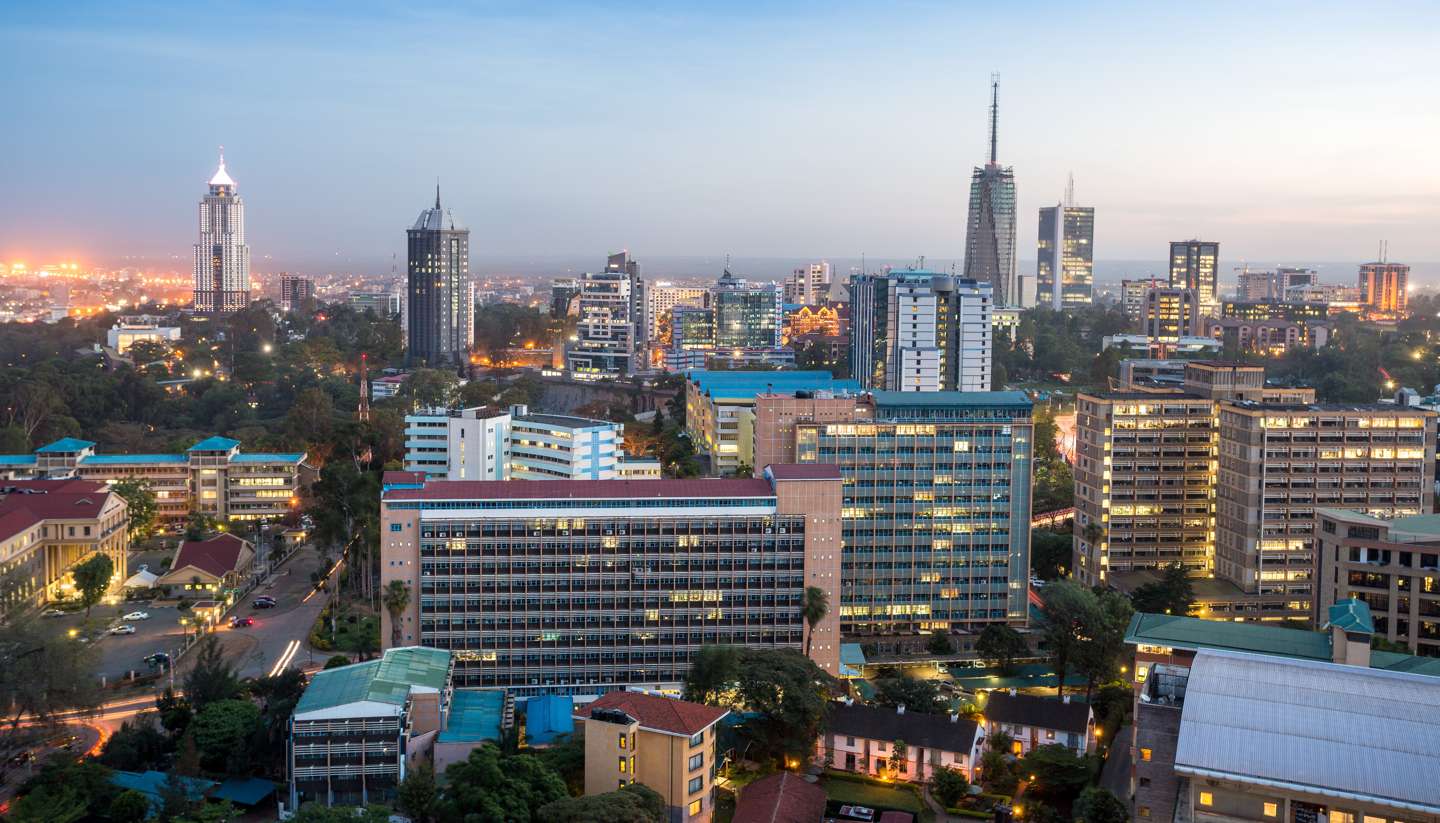
Local time Nairobi
Introducing Nairobi
About nairobi.
- Weather / Best time to visit
- Images of Nairobi
While you’re there
- Getting around
- Attractions, tours and tickets
- Things to see
- Things to do
- Restaurants
Plan your trip
- Travel to Nairobi
Kenya Information
- About Kenya
- Passport & visa
- Public Holidays
- Money & duty free
- Food & drink
Book your flights
- Nairobi Jomo Kenyatta International Airport
Nairobi Travel Guide
Part bustling African metropolis, part explorers' camp, Kenya's capital Nairobi is an intoxicating blend of cosmopolitan culture, gritty, urban slums and thoroughly modern city life.
The gateway to some of the most beautiful stretches of wilderness in the world, Nairobi is never short of tourists, even if most are simply passing through to the Masai Mara in the west or the beaches of Lamu and Malindi in the east.
Founded by the British in 1899, the city began as a dusty railway depot beside a Masai water hole known as Enkare Nyrobi (meaning "cool water"), from which it drew its current name. Today it's one of the largest cities in East Africa and home to scores of international companies and organisations, among them the United Nations Environment Programme (UNEP).
Commercial success has transformed what was once an isolated supply depot into a place of bustling central thoroughfares, 1970s tower blocks, gorgeous public parks and bustling shopping areas crammed with chic boutiques and street traders from all over Kenya.
While there's plenty to see in the city centre, including the imposing parliament building and the city's many galleries, the real excitement is found just outside city limits.
Just seven kilometres (four miles) from the city centre is the Nairobi National Park, where you can get close to lions, impala, wildebeest and elephants, the latter due to the presence of an elephant orphanage within the park, courtesy of the David Sheldrick Wildlife Trust.
Mount Kenya is also a four hour trip from the capital and day trips, although lengthy, are possible. Back in the city, slum tours have become an increasingly popular way to get a glimpse of Nairobi's grittier side, although many aren't as safe as tourists imagine.
Due to the activities of militant groups like Al-Shabaab, safety has become an increasingly pertinent issue when planning a trip to the Kenyan capital. They are primarily active on the land that borders Somalia though, with attacks upon the Capital rare due to tourist hubs being heavily protected.
Nevertheless, provided you take precautions when travelling at night and in poorer suburbs a visit to Nairobi can be an exhilarating experience, and it's well worth spending a few days exploring before heading out on safari.

Book Accommodation
Featured hotels, sarova stanley.
One of the most historic hotels in Nairobi, the Sarova Stanley first opened its doors in 1902, and boasts a rich history of famous former guests, among them Ernest Hemingway. Rooms are well appointed and soundproof, and there's a gym, sauna, rooftop pool and bar. Don't miss out on the legendary Thorn Tree Cafe either, a travellers' haunt since British times.
Nairobi Serena Hotel
One of the more elegant options in Nairobi, this sophisticated place draws on influences from across Africa, and the interiors are full of tribal sculptures, textiles and wooden furniture. The spotless rooms have marble bathrooms and views over the grounds and lush gardens. There is also a swimming pool, health club and shops. Although the hotel itself is very secure, adjacent Central Park and Uhuru Park are not safe to walk around at night.
Central YMCA
This is a well-appointed, central hostel in Nairobi. Good-value rooms, reasonable food, swimming pool, tennis courts and an aerobics studio make this feel more like a small hotel, and you don't have to be male or Christian to stay here.
Sentrim 680 Hotel
This reasonably priced mid-range hotel in Nairobi is in a decent location. It is a bit shabby and not much to look at, but is safe, has clean rooms with en-suite bathrooms, useful facilities, a restaurant and its own bar. Rooms facing the main road can cop a bit of noise, so ask for one at the back.
Upper Hill Campsite
Part campsite for overland groups, part backpacker hostel, this expansive place is a hike from the centre of Nairobi, but it makes up for this with excellent facilities. Staff can organise all sorts of safaris and excursions, and the spacious, secure compound has its own bar, restaurant and games room.
Terminal Hotel
A good-value alternative to the backpacker crash pads, the Terminal Hotel in Nairobi is simple but well located. You get what you pay for in terms of luxuries, but the rooms have bathrooms and you can walk to everything in the centre. Ask for a room at the back, away from the street noise.
© Columbus Travel Media Ltd. All rights reserved 2024
Top Hotel Collections

Near Jomo Kenyatta Intl Airport
Near Wilson Airport
5 Star Hotels
Cheap Hotels
Nairobi Travel Packages
Compare quotes from upto 3 travel agents for free
Kenyan Big Five Safari: Lake Elementaita and Masai Mara in 6 Days
Kenya's 7-day wildlife and lake safari adventure, 9 days best of kenya and tanzania: great migration safari, 10 days ultimate luxury giraffe manor & wildlife safari expedition, wilderness of south africa and kenya: 11 day 10 night package, kenya tour package: from nairobi's bustle to masai mara's majesty, nairobi travel essentials.
Ideal duration: 3 days
Best Time: January to February and June to September Read More
Planning a Trip? Ask Your Question
"Safari Capital of Africa"
Nairobi tourism.
Nairobi, the capital and largest city of Kenya, is a vibrant metropolis located in the southern part of the country. Covering an area of approximately 696 square kilometres (269 square miles), Nairobi serves as the nation's business, financial, and cultural centre. Notably, it is referred to as the "Safari Capital of the World," as many travellers heading to Kenya's famous national parks and reserves spend at least one night in this bustling city.
Nairobi, a modern urban centre, boasts unique attractions like Nairobi National Park, the world's only capital city with a national park. The city offers a blend of modern amenities and wildlife experiences, with rich cultural heritage and historical sites to explore, such as the Nairobi National Museum, Bomas of Kenya, and David Sheldrick Wildlife Trust, providing a dynamic blend of heritage, shopping, and entertainment options.
Must Know Before You Travel to Nairobi
- Safari Gateway: Nairobi is the main gateway and stopover for travellers beginning and moving through their safari adventures across Kenya.
- Taxi Apps: Popular taxi apps like Bolt, Little, Uber, and Nopea Ride offer convenient transportation options in Nairobi.
- Cash & ATMs: Cash transactions are common, and ATMs are available in major shopping areas and the airport. Ecobank ATMs have no withdrawal fee for overseas ATM cards in Kenya.
- Mobile Banking: Mobile banking is widespread in Kenya, so expect that people may prefer to send money digitally instead of using cash. M-Pesa, Airtel Money, and Equitel Money are major options. Sign up at authorized agents citywide, including supermarkets, banks, and cell phone stores. All you need is a Kenyan SIM card and some form of identification.
- Choosing Your Base in Nairobi: Nairobi's neighbourhoods are divided by a slope, with wealthier areas typically found in the west. However, accommodation options are available throughout the city. Opt for luxury in Karen, Lang'ata, Muthaiga, or Runda. For a vibrant central location, consider Westlands. Business travellers may prefer Upper Hill or Hurlingham, while those prioritizing proximity to the airport can stay near Mombasa Road. For a quiet residential experience, Lavington or Kileleshwa are good choices.
- Vaccinations: Tourists are recommended to get vaccinated well in advance (6 weeks) before their trip to Nairobi. Common recommended vaccines for travellers to Africa include Tetanus, Diphtheria, Polio, Typhoid, Hepatitis A, Hepatitis B, Yellow Fever, Rabies, and Meningitis.
- Dietary Considerations: Vegetarians may find it challenging, so inform hosts about dietary requirements in advance. While some restaurants cater to vegetarians, meat dishes are prevalent on most menus.
Things To Do In Nairobi

Nairobi National Park

Giraffe Centre

Nairobi National Museum

Karen Blixen Museum

Sheldrick Wildlife Trust

Giraffe Manor
Top Hotels In Nairobi
₽ 1,381 onwards
₽ 1,197 onwards
₽ 9,212 onwards
₽ 552 onwards
₽ 3,777 onwards
More on Nairobi Travel
Travel tips for nairobi.
- Traffic: Nairobi is notorious for heavy traffic, especially during rush hours (07:00 – 09:00 AM, 04.30 - 06.30 PM), which can cause significant delays.
- Driving: Use common sense and local guidance to navigate the city, as driving habits can be challenging, particularly among matatus and buses.
- Self-driving and GPS: If self-driving, GPS is essential due to the lack of road signs.
- Walking Safety: Avoid walking in many parts of Nairobi, especially at night, as it may not be considered safe for foreigners.
- Currency Exchange: Major banks such as ECO Bank, Kenya Commercial Bank, and Equity Bank offer better exchange rates than FOREX bureaus.
- Pickpockets: Beware of pickpockets, especially around ATMs. Carry cash in a hidden pouch rather than a wallet. Men should avoid carrying wallets in their back pockets, and women should avoid carrying purses on their side or behind them, especially in busy areas.
- Supermarkets: The four primary supermarkets in Nairobi are Quick Mart, Naivas, Carrefour, and Chandarana Foodplus.
- Drinking Water: Tap water is not safe to drink or use for brushing teeth. Stick to bottled or canned drinks, especially popular brands.
- Smoking: Smoking is prohibited in the city centre, with designated smoking zones available. Be mindful of not smoking near pedestrians and vehicles.
- Language: The widely spoken languages in Nairobi are Bantu Swahili and English, with locals using Sheng slang.
History of Nairobi
Nightlife in nairobi, shopping in nairobi, best time to visit nairobi, top stories about nairobi tourism.

Sightseeing
Places to Visit in Nairobi

Travel Tips
Safety in Nairobi - How Safe is Nairobi for Travel?

Food & Drink
10 Indian Restaurants in Nairobi For a Delicious Meal

Nightlife in Nairobi - 15 Fun Things to Do at Night
Museums in Nairobi

Luxury Trip
14 Best Spas in Nairobi
Nearby Places

How to Reach Nairobi
How to reach overview, how to reach nairobi by flight, how to reach nairobi by road, how to reach nairobi by train, how to reach nairobi by bus, local transport in nairobi, browse package collections, nearby destinations for packages.
Aberdare National Park
Lake Naivasha National Park
Hell's Gate National Park
Mount Longonot National Park
Mount Kenya National Park
Amboseli National Park
Lake Nakuru National Park
Ol Pejeta Conservancy
Tsavo East National Park
Top Listed Packages
Kenya and Tanzania: 7 Nights 8 Days Tour Package
Best Kenya Safari Tour - White Rhinos Adventure
Nairobi Photos

+ 48 photos
How To Reach Nairobi
Faqs on nairobi, what is the best time to visit nairobi, what is the local food in nairobi, how much does a package cost for nairobi, what are the top hotels in nairobi, what are the things to do in nairobi, what are the places near nairobi, have a question on nairobi .

Nairobi Reviews
Similar places.

Get the best offers on Travel Packages
Compare package quotes from top travel agents
Compare upto 3 quotes for free
- India (+91)
*Final prices will be shared by our partner agents based on your requirements.
Log in to your account
Welcome to holidify.
Forget Password?
Share this page
- 17 Things They Don T...
Things They Don’t Tell You About Visiting Nairobi

Nairobi is a great place to visit, but like anywhere, there are a few things to know before you go. From navigating traffic to social taboos, here’s our guide to the Green City in the Sun of Kenya .
Planning a trip to Kenya and want all the details taken care of? Book yourself onto Culture Trip’s seven-day Kenyan adventure , where you’ll venture into national parks on game drives, visit an extinct volcano and have the chance to explore the best of Nairobi.
Traffic lights are simply a suggestion in Nairobi
While you may have heard about the notorious Nairobi traffic, you might not know about the lights. In general, traffic lights and signs are decorative. Don’t be surprised if pedestrians cross or cars keep moving while lights are red – just don’t get too frustrated. This means that you should always be on the lookout when driving or walking and don’t rely on the lights all the time.

Don’t cross the street while talking on your phone in Nairobi
While this may seem like basic common sense, it’s important to realise that to do so is against the law here – and can get you in trouble if you’re caught. Given that the streets are so busy, you may not even see police officers coming, so just put your phone down while you cross the road.

Not all Kenyans run
Please, for the sake of all that is good, don’t go around asking every Kenyan if they run. A very specific tribe in Kenya, the Kalenjin, is famous for running – and they make up about eight percent of the population. The rest of Kenyan society are equally impressed at their athleticism. If this was your go-to joke, you may need to change it before arrival.
Don’t worry about the time in Nairobi
While this may seem rude to those of European persuasion, the reality is that events don’t start on time. In order to avoid scrolling on your phone aimlessly as you wait, give events a few minutes before arriving. Of course, you shouldn’t show up an hour late for a two-hour event, though.
You should always accept food in Nairobi
Most Kenyans feel insulted when you don’t eat something they’ve offered you. So even if you have to politely nibble, do it. Most times, your host went out of their way to offer you something to eat – so it’s disappointing to them when you don’t accept it. You might also find something you like – it’s a fantastic way to try new foods.

Become a Culture Tripper!
Sign up to our newsletter to save up to $1,656 on our unique trips..
See privacy policy .

Don’t go around asking people about their tribe in Nairobi
This is a tricky one. Kenyans are not overly sensitive about this question, but it does get a bit old – so try not to bring this up at every conversation. Many visitors are fascinated by this concept and tend to ask. While it’s not entirely offensive, it is weird. Especially refrain from doing this in a large group of Kenyans. Save it for friends, or people you meet one-on-one.

No one says “Jambo” in Nairobi
You may have read it in a travel guide or seen it in a film, but no one here uses “Jambo” as a greeting. You might as well walk around with a sticker on your forehead that reads, “Tourist”.
Mobile money
Mobile banking is huge in Kenya, so don’t be surprised if people don’t always have cash and want to send you money this way instead. It’s also very convenient and safe for you to have some of your money stored this way, so register as soon as you land. It’s quick and simple – not to mention free to do so.

Learn a bit of the lingo in Nairobi
Most people in Nairobi speak English. However, some local words are so fundamental to the fabric of every day that Nairobians assume that you know them. To avoid miscommunication, learn some basic words like sawa (okay), kesho (tomorrow) and sasa (hello). They’re usually thrown around casually in conversations so don’t panic.
Not everything is negotiable in Nairobi
It’s true that local merchants tend to overcharge tourists for certain items. While this may make you feel unhappy and drive you to question the price of everything, what you also need to know is that sometimes haggling too much can also be seen as rude. Like any other merchants, those in Nairobi are passionate about their craft and its value so don’t overdo it.

Maasai markets are everywhere in Nairobi
Kenya is famous for local crafts and artefacts and many tourists are excited to get their hands on stone carvings and beaded jewellery. These markets are everywhere, so don’t feel pressured to buy the first thing you see, as you’ll get several other chances. Most people go on a shopping spree at the first market they go to only to realise that the same stuff is everywhere. Don’t be that person.

There are security checks everywhere in Nairobi
Don’t be surprised if you have to go through checks at every building, as security is very important in Nairobi. You must carry a form of ID with you at all times.
Kenyans dress up
Kenyans really care about their appearance – they don’t do sweatpants in public. Keep this in mind so that you don’t always feel like the most underdressed person in the room. Of course, they’re not expecting high fashion – just pack appropriately.
Politics, politics, politics
Kenyans talk politics day and night. Don’t say we didn’t warn you.
Vegetarianism is incomprehensible
Kenyans love their meat. If you’re a vegetarian, you might have some difficulty with this. Always call ahead and let your host know your dietary requirements, as chances are they are serving meat for dinner – and remember what you must do when offered food. Many restaurants are popping up in order to cater to vegetarians, but for the most part, meat still rules the menus here. In response to being offered salad, don’t be surprised to hear a Kenyan say, “I don’t eat rabbit food.” or “I don’t eat grass!”

Don’t call Kenya “Africa”
While in conversation with Nairobians, be careful not to refer to Kenya as “Africa”. They do not appreciate such generalisations. Be more specific about places on the continent that you’ve visited before, as it’s much more interesting – you should do this always, not just when in Nairobi.
You can get most things here in Nairobi
Nairobi is pretty advanced, so don’t panic about your trip. There are major banks, popular fast-food joints and nearly everything you can buy back home. So, don’t overpack – there’s no need to drag an oversized suitcase halfway around the world.

Culture Trips launched in 2011 with a simple yet passionate mission: to inspire people to go beyond their boundaries and experience what makes a place, its people and its culture special and meaningful. We are proud that, for more than a decade, millions like you have trusted our award-winning recommendations by people who deeply understand what makes places and communities so special.
Our immersive trips , led by Local Insiders, are once-in-a-lifetime experiences and an invitation to travel the world with like-minded explorers. Our Travel Experts are on hand to help you make perfect memories. All our Trips are suitable for both solo travelers, couples and friends who want to explore the world together.
All our travel guides are curated by the Culture Trip team working in tandem with local experts. From unique experiences to essential tips on how to make the most of your future travels, we’ve got you covered.

Bars & Cafes
The best coffee shops in nairobi, kenya.

Guides & Tips
Getting a taste of kenya from a short stay in nairobi.

Health & Wellness
The top spas in nairobi, kenya.

See & Do
How to spend 48 hours in nairobi.

A Solo Traveler’s Guide to Nairobi

Places to Stay
The best hotels to book in nairobi, kenya.

Free and Cheap Date Ideas to Try in Nairobi
Culture trip spring sale, save up to $1,656 on our unique small-group trips limited spots..

- Post ID: 428760
- Sponsored? No
- View Payload
- Kenya-Re Towers, 7th Floor, Nairobi
- +254-020 2749000/2711262
- [email protected]

Welcome to Kenya Tourism Board
KTB is a state corporation established and regulated under the Tourism Act 2011. Our mandate is to develop, implement and co-ordinate a National Tourism marketing strategy
- To be the most visited tourism destination in Africa.
- To market Kenya as the home of human origin and as an all-year-round diverse, sustainable and authentic tourism destination
%20(1).jpg)
Latest News & Events
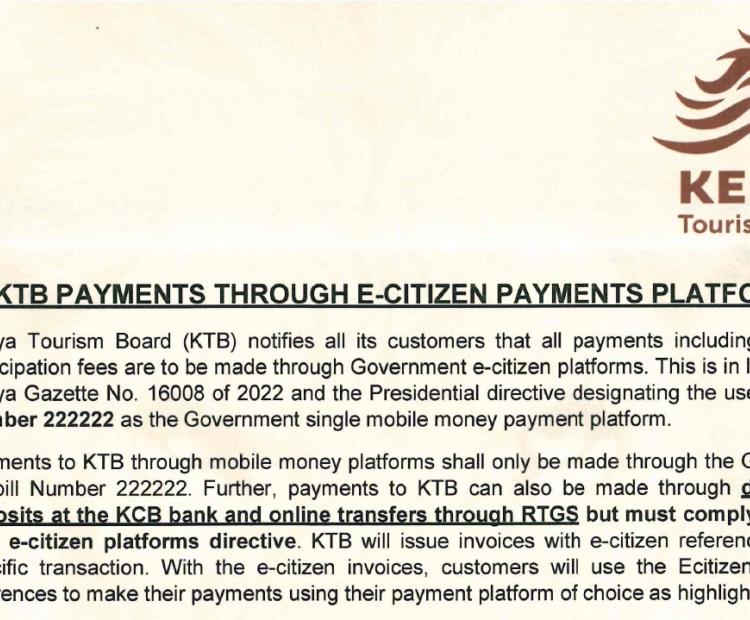
E-Citizen Payments Platform
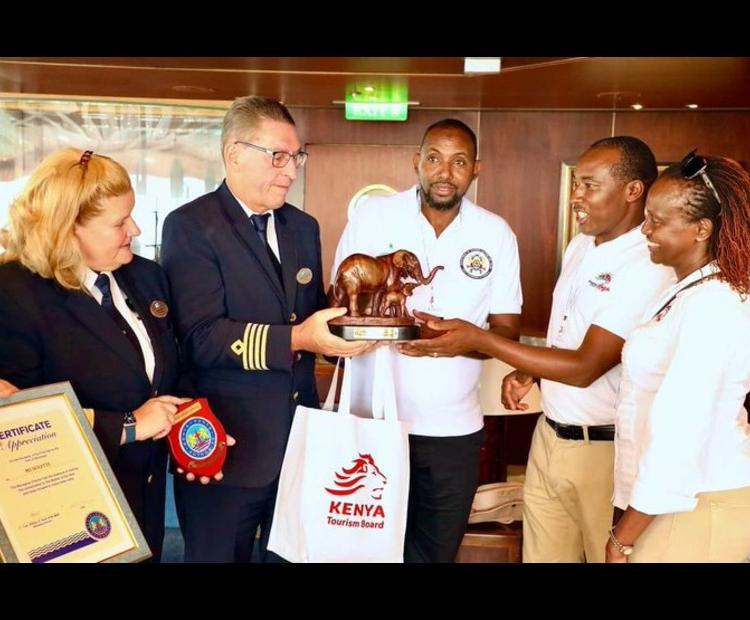
KTB Welcomes MV Bolette Cruise Ship
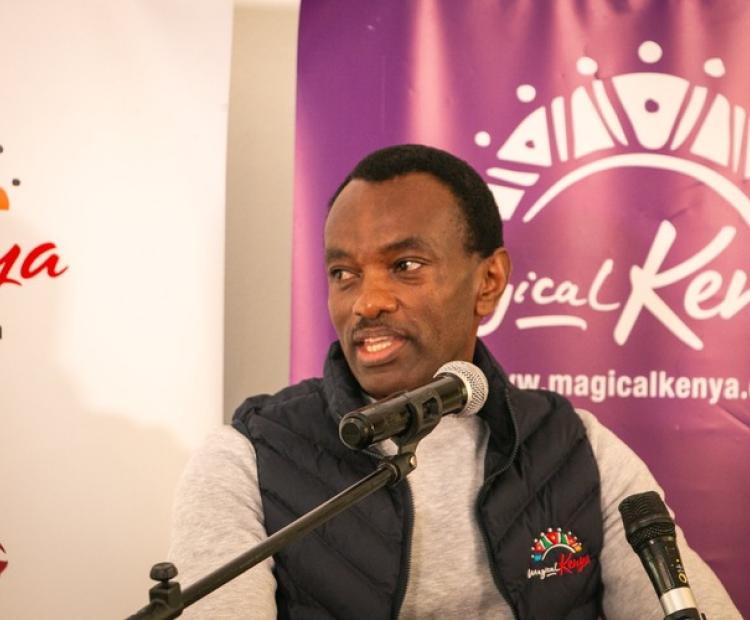
KTB Engages the Future of Tourism

Stakeholders validation workshop on the Draft #KTBStrategy (2023 - 2028)
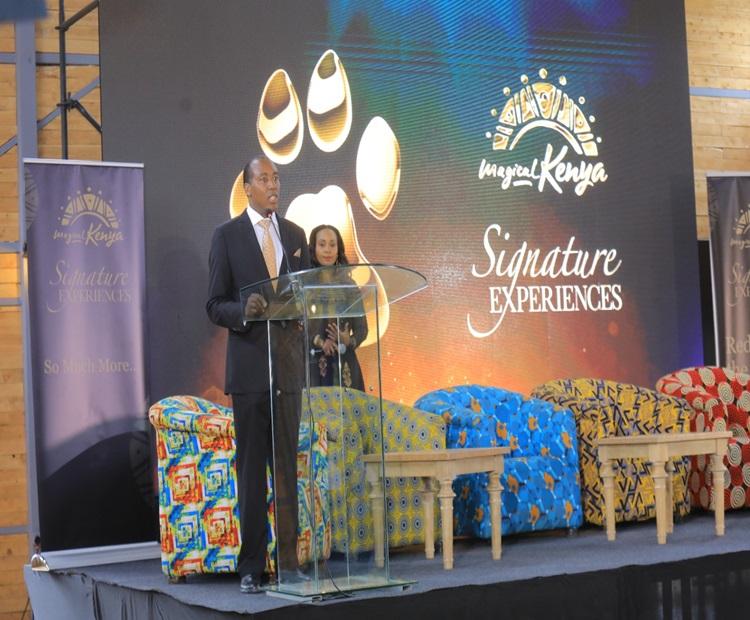
Unveiling of Signature Experiences

- Nairobi Info
- Visa Requirements
- Travel Tips
- Attractions
- Exhibitions
- Restaurants
- Shopping Centres
- City Guides

Nairobi is a charming, cosmopolitan city, blessed with the most wildlife in the world, making it a great safari destination. Known as the 'Green City in the Sun', Nairobi is the largest city as well as the capital of Kenya. Read more...
Nairobi Weather

IMAGES
VIDEO
COMMENTS
Lots of full-day Nairobi tours include a morning game drive of 3 to 4 hours in Nairobi National Park followed by visits to other attractions in the area such as the Giraffe Centre, Sheldrick Wildlife Trust Elephant Orphanage, Karen Blixen Museum, and/or Bomas of Kenya. You can see a list of available tours here.
5. Karen Blixen Museum. One of Nairobi's top tourist attractions, the Karen Blixen Museum, at the foot of the Ngong Hills, is the former home of the famous namesake Out of Africa author. Karen Blixen, also known by her pen name, Isak Dinesen, lived in the house from 1917 to 1931, where she ran a coffee plantation.
In Nairobi, travel remains a pipe dream. Aug 3, 2021 • 8 min read. TV. Netflix's first African series Queen Sono shows off thrilling locations around the continent . Mar 9, 2020 • 1 min read. Sports. Best day trips from Nairobi. Sep 20, 2019 • 3 min read. Food. Best things to do in Nairobi in June.
9. Karen Blixen Coffee Garden. 601. Nature & Wildlife Areas. Karen Blixen Coffee Garden & Cottages is set in what used to be Karen Blixen's old coffee farm estate, in the heart of Karen in beautiful gardens and a peaceful suburb approximately 20 miles from …. See ways to experience (2) 10. Nairobi Railway Museum. 257.
Garden dining amidst historical grounds, featuring a blend of Western and local cuisine with options for vegetarians and meat-lovers, complete with a selection of wines and cocktails. See ways to experience (2) 10. Nairobi Railway Museum. 257.
Kilifi. Discover the best attractions in Nairobi including David Sheldrick Wildlife Trust, Nairobi National Park, and National Museum.
Nairobi has positioned itself on the world map as an ideal travel destination. Started as a railway depot in 1899, the city has grown in leaps and bounds and is now home to over four million people. Famous for its unique attraction sites, diverse cultures, thrilling events, and buzzing nightlife, you're in for a fun-filled adventure in the city.
Uhuru Monument: The monument itself is the main attraction, and it holds great historical significance for Kenya. 17. Oloolua Nature Trail. Oloolua Nature Trail, located in Karen, Nairobi, offers a natural escape for those looking to connect with Kenya's diverse flora and fauna.
The David Sheldrick Elephant Orphanage. Anouk Zijlma. View Map. Address. KWS Central Workshop Gate, Magadi Rd, Nairobi, Kenya. Phone +254 111 044200. Web Visit website. Dame Daphne Sheldrick has been raising elephant orphans since the 1950s, when she lived and worked in Tsavo National Park. In the late 1970s, she established an elephant and ...
Things to do Immerse yourself in Nairobi's dynamic arts Museums and Galleries Step into Nairobi's world-class museums and galleries, where history, art, and heritage blend seamlessly. Explore the Nairobi National Museum, home to an extensive collection of archaeological artifacts, cultural exhibits, and contemporary artworks that provide insights into Kenya's past and present. Performing ...
Try their mbaazi combo that comes with lentil stew, spiced donuts, and tea; this will cost you $3.50. For lunch, visit Mama Oliech Restaurant to get a taste of fish servings that have been sampled ...
Day 2: Evening. Courtesy of The Alchemist Nairobi, Kenya. 6 p.m.: Finish off your weekend in Nairobi by dining at one of the finest choices of Kenyan cuisine in town at Mama Oliech. It is best known for its delicious fish meals, such as fried tilapia freshly caught from Lake Nakuru, typically served alongside traditional ugali, made from ...
Nairobi. With a national park just a handful of kilometers away from the city and a giraffe breeding center where you can feed the long-necked residents, Nairobi is the perfect destination for animal lovers who enjoy big-city amenities. Your Trip to Nairobi: The Complete Guide. Is It Safe to Travel to Nairobi?
The green continues on the southern-edge of the city at Nairobi National Park -- dubbed the world's only wildlife capital thanks to famous shots of giraffes with sky rises in the background. Here you can find just about any animal you'd hope to spot on an African safari. Zebras, giraffes, rhinos, lions -- you name it.
8. Explore Hell's Gate National Park on a bike. The famous gorges of Hell's Gate National Park served as inspiration for the setting of The Lion King. For anyone more on the adventurous side, the Hell's Gate bike tour from Nairobi is an awesome activity you can do at Hell's Gate National Park.
9.) Bomas of Kenya. Another Nairobi Tourist Attractions - Bomas of Kenya. Location: 12 Kilometers from CBD, Along Langata Road. What to see: There are daily shows, Harambee dancers, Cultural Artifacts, Research Library and Cultural homemade. 10.) Kibera Slums. Location: 7 Kilometers from CBD, Along the Kabarnet close.
The Best of Nairobi in One Week - A Travel Itinerary. Day 1 - Nairobi. Day 2 - David Sheldrick Wildlife Trust and Giraffe Manor. Day 3 - Safari at Nairobi National Park. Day 4 - Drive to Naivasha & visit Crescent Island. Day 5 - Naivasha - Hells Gate. Day 6 - Naivasha - take a boat tour and visit Crater Lake.
Nairobi Travel Guide. Photograph by Buena Vista Images, Getty Images. Why It's Worth It. Nairobi is a modern and bustling city, rich in culture and history, but with fantastic nature and wildlife ...
Part bustling African metropolis, part explorers' camp, Kenya's capital Nairobi is an intoxicating blend of cosmopolitan culture, gritty, urban slums and thoroughly modern city life. Due to the impact of COVID-19, you are recommended to check travel restrictions from your government sources and contact local venues to verify any new rules
Traffic: Nairobi is notorious for heavy traffic, especially during rush hours (07:00 - 09:00 AM, 04.30 - 06.30 PM), which can cause significant delays. Driving: Use common sense and local guidance to navigate the city, as driving habits can be challenging, particularly among matatus and buses. Self-driving and GPS: If self-driving, GPS is essential due to the lack of road signs.
Don't call Kenya "Africa". While in conversation with Nairobians, be careful not to refer to Kenya as "Africa". They do not appreciate such generalisations. Be more specific about places on the continent that you've visited before, as it's much more interesting - you should do this always, not just when in Nairobi.
KTB is a state corporation established and regulated under the Tourism Act 2011. Our mandate is to develop, implement and co-ordinate a National Tourism marketing strategy ... P.O Box 30630 - 00100. Nairobi. 020 2749000/020 2711 262; [email protected]; Working Day, Mon - Fri : 8AM - 5 PM; Our Partners. MagicalKenya; Ministry of Tourism, Wildlife ...
Nairobi.com provides a variety of information on available activities and travel services around the Nairobi area. Nairobi Tourist Information and Travel Guide. Travel Reservation, Hotel Accommodation,Flights, Car hire,Cruises, Attractions in Nairobi, Kenya and more. News and analysis on Nairobi and Kenya current events.
Please call 1 (888) 407-4747 (U.S. and Canada) or 1 (202) 501-4444 (overseas) or contact the nearest U.S. embassy or consulate. As a first step in planning any trip abroad, check the Travel Advisories for your intended destination. Our highest priority is to protect the lives and interests of U.S. citizens overseas.